TRIUMPH TR6R

A LUCKY FIND OF AN AMAZINGLY ORIGINAL SINGLE-CARB TWIN
PLUS:




















• RIDING THE 2023 MOTO GIRO D'ITALIA






















• KANEMOTO DRAGON: 1974 KAWASAKI

H2R FLAT TRACKER
• CLASSIC SCENE: 2023 QUAIL






MOTORCYCLE GATHERING

RIDE `EM, DON’T HIDE `EM
$6.99 • Vol. 19 No. 1 • Display Until Oct. 2
September/October 2023
THE EVENT 100 YEARS IN THE MAKING
BMW MOTORRAD DAYS AMERICAS. OCT. 6–8

The first ever Motorrad Days Americas is here. Join us October 6-8 in Birmingham, Alabama at the Barber Vintage Festival. Celebrate 100 years of motorcycle excellence and test ride the latest innovations in BMW Motorrad technology. Don’t miss the three full days of pure #SoulFuel. Visit www.BMWMotorradDaysAmericas2023.com to learn more. #100YearsBMWMotorrad

 ©2023 BMW of North America LLC. The BMW trademarks are registered trademarks.
©2023 BMW of North America LLC. The BMW trademarks are registered trademarks.
DEPARTMENTS
4 SHINY SIDE UP
Attend the John Parham Estate Collection auction at the National Motorcycle Museum in Anamosa, Iowa.

6 READERS AND RIDERS
Readers chime in with feedback on police Indians, the Mystery Ships from the July/August issue of MC, and more.
ROAD MAP
38 NOT STOCK: THE MEDAZA WASP
Hand-crafted in Ireland, Don Cronin’s latest creation looks like the sort of bike that Captain America would ride, not a Royal Danish postman.
44 KANEMOTO DRAGON
Dain Gingerelli looks back at the 1974 Kawasaki H2R Flat Track racer.
52 TWO-STROKE TEMPLATE: 1955 ADLER MB250
The parallel-twin 2-stroke engine has arguably delivered more thrilling performance to more people at an affordable cost than any other twowheeled 20th century engine format.
61 JERRY AND THE JERSEY DEVIL
A half century on a 1966 Honda 305 Scrambler.
8 ON THE RADAR
We look back at three desert sleds, the Norton Nomad, the Matchless G11CS, and the Triumph TR6 Trophy.
66 TEST RIDE
Alan Cathcart tells us all about Ultimate Collector Motorcycles.
ON THE WEB!

Motorcycle Classics Ready To Ride Giveaway

Get on the road with this cool collection of motorcycle gear valued at $2,400. Enter for a chance to win this package at MotorcycleClassics.com/ sweepstakes/ready-to-ride
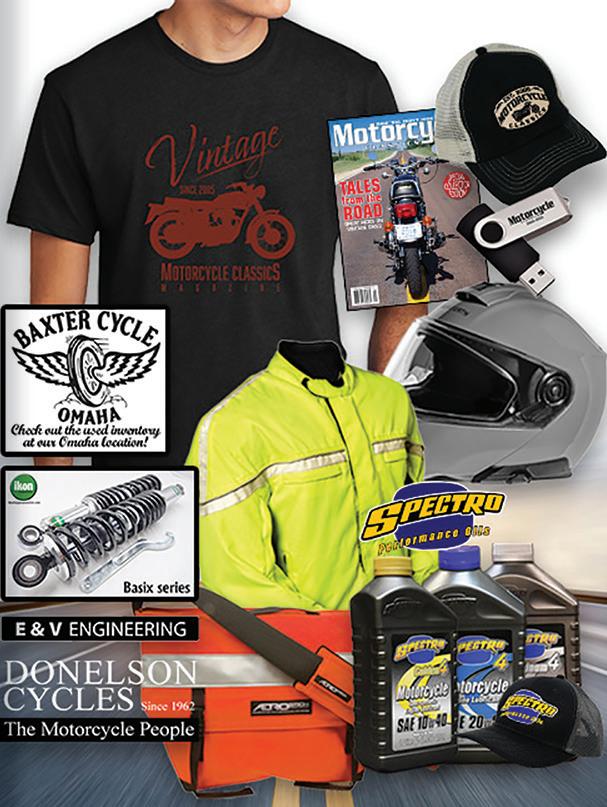
70 CALENDAR
Where to go and what to do this fall.
72 DESTINATIONS


Visit the beautiful New Jersey Pine Barrens.
80 PARTING SHOTS
Remembering the San Jose Mile — THE Mile.
JEFF BARGER
the
being one of the
shows in the country.
lucky find of an amazingly
READY TO RIDE: 1975
S3A
after riding a H1 to
school,
Baugrud decided to find another
triple.
FEATURES
10 CLASSIC SCENE: THE 2023 QUAIL MOTORCYCLE GATHERING This year
Quail continued the tradition of
premier motorcycle-specific
14 THE RESCUE OF THE AVOCADO: 1970 TRIUMPH TR6R A
original Triumph. 22
KAWASAKI
Decades
high
Steve
Kawi
30 THE 2023 MOTO GIRO D’ITALIA
Roaming Tuscan roads on classic motorcycles.
Steve Baugrud goes back in time. See Page 22.
2 MOTORCYCLE CLASSICS September/October 2023

Cars lie to us. MOTORCYCLES TELL US THE truth — WE ARE SMALL, AND EXPOSED, AND PROBABLY MOVING TOO FAST, BUT THAT’S NO REASON NOT TO ENJOY EVERY MINUTE of EVERY RIDE. America’s # 1 MOTORCYCLE INSURER 1-800-PROGRESSIVE | PROGRESSIVE.COM from Season of the Bike
Progressive Casualty Insurance Co. & affiliates. Quote in as little as 3 minutes
by Dave Karlotski
The end of an era

We here at Motorcycle Classics, along with everyone else in the motorcycle community, were saddened a few months back at learning the news: The National Motorcycle Museum in Anamosa, Iowa, will be closing its doors for good in early September.

While the museum has been a non-profit since its beginning in 1989, it has always been the home of many motorcycles from John and Jill Parham, founders of J&P Cycle.
What began with 40 bikes in an old storefront in downtown Anamosa grew to a larger, 500-plus motorcycle collection after the museum's move in 2010 to a repurposed larger building near Highway 151. More space not only allowed for the acquisition and display of more motorcycles, but it also provided room for exhibits and loans from other collections. And while those cycles will be going back to their homes, many bikes from the Parham's personal collection will go up for auction.
Mecum Auctions will be presenting the John Parham Estate Collection at the National Motorcycle Museum, Wednesday, Sept. 6, through Sunday, Sept. 9. The auction begins with the Road Art, some 1,000 lots encompassing more than 6,000 pieces in total. One standout piece of the Road
Art collection is a life-size bronze sculpture by artist Jeffrey Decker. The piece depicts a 1937 Harley-Davidson EL being ridden by Joe Petrali. The piece was created especially for John Parham in 2002 to honor Petrali’s record-setting Daytona run.
Another famed piece of the Road Art collection will be a helmet owned and engraved over a period of some 30 years by artist Von Dutch. He began engraving the helmet in the early 1960s as a sort of history of his motorcycle ownership, and it was one of his most prized possessions.
More than 300 motorcycles from the collection will also be sold, starting on Friday. Highlights include several Brough Superiors and a handful of Vincents, but mostly a vast collection of early American motorcycles. Harley-Davidsons of nearly every decade since the company began are represented, including a 1909 H-D single. A 1915 Flying Merkel, a 1912 Indian single and a 1939 BMW R12 are all sure to draw a great deal of attention.
The entire list of bikes can be viewed at mecum.com/auctions
Cheers,
®
LANDON HALL, EDITOR-IN-CHIEF lhall@motorcycleclassics.com

CHRISTINE STONER, ASSOCIATE EDITOR
RICHARD BACKUS, FOUNDING EDITOR
CONTRIBUTORS




JEFF BARGER • JOE BERK • ALAN CATHCART
NICK CEDAR • KEL EDGE • DAIN GINGERELLI
COREY LEVENSON • MARGIE SIEGAL
ROBERT SMITH • PHILLIP TOOTH
GREG WILLIAMS
ART DIRECTION AND PREPRESS
MATTHEW STALLBAUMER, ART DIRECTOR
ADVERTISING DIRECTOR












BRENDA ESCALANTE; bescalante@ogdenpubs.com
WEB AND DIGITAL CONTENT
TONYA OLSON, WEB CONTENT MANAGER
DISPLAY ADVERTISING (800) 678-5779; adinfo@ogdenpubs.com

NEWSSTAND
BOB CUCCINIELLO, (785) 274-4401
CUSTOMER CARE (800) 880-7567
BILL UHLER, PUBLISHER CHERILYN OLMSTED, CIRCULATION & MARKETING DIRECTOR
BOB CUCCINIELLO, NEWSSTAND & PRODUCTION DIRECTOR
BOB LEGAULT, SALES DIRECTOR RANDY SMITH, MERCHANDISE MANAGER
TIM SWIETEK, INFORMATION TECHNOLOGY DIRECTOR ROSS HAMMOND, FINANCE & ACCOUNTING DIRECTOR
MOTORCYCLE CLASSICS (ISSN 1556-0880)
September/October 2023, Volume 19 Issue 1. MOTORCYCLE CLASSICS is published bimonthly by Ogden Publications, Inc., 1503 SW 42nd St., Topeka, KS 66609-1265.
Periodicals Postage Paid at Topeka, KS and additional mailing offices. POSTMASTER: Send address changes to Ogden Publications, Inc., 1503 SW 42nd St., Topeka, KS 66609-1265.

For subscription inquiries call: (800) 880-7567
Outside the U.S. and Canada:
Phone (785) 274-4360 • Fax (785) 274-4305
Subscribers: If the Post Office alerts us that your magazine is undeliverable, we have no further obligation unless we receive a corrected address within two years.
©2023 Ogden Publications Inc. Printed in the U.S.A.
In accordance with standard industry practice, we may rent, exchange, or sell to third parties mailing address information you provide us when ordering a subscription to our print publication. If you would like to opt out of any data exchange, rental, or sale, you may do so by contacting us via email at customerservice@ ogdenpubs.com. You may also call 800-880-7567 and ask to speak to a customer service operator.
®
SHINY SIDE UP
4 MOTORCYCLE CLASSICS September/October 2023
A 1937 Brough Superior SS80, one of three Broughs in the Parham auction. MECUM AUCTIONS
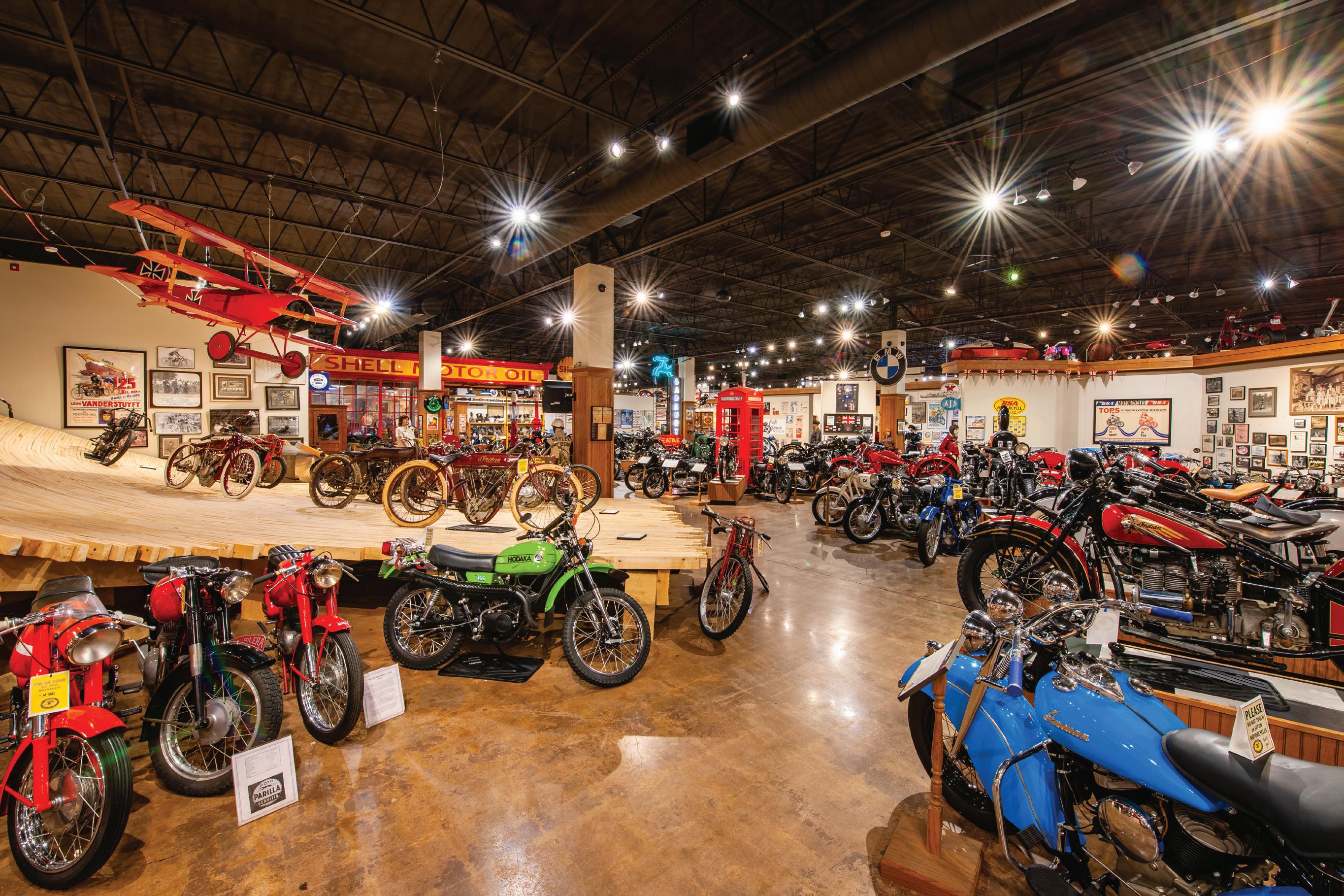
over the next 20 years.”

Love for the Mystery Ship
Kudos for an outstanding cover and story about Craig Vetter and the Mystery Ships (July/August 2023)! As an architect and industrial designer, I have always been fascinated by Craig’s innovative solutions.
I also enjoyed Robert Smith’s very thorough background on the Ariel side hack rig ( Something on the Side ). I had a similar unit when I was living in Denver in the 1980s. I was the campaign manager for the election of Federico Peña for Mayor (he won). I frequently drove him to various civic events in the rig which always got lots of smiles and thumbs up. I think it was a 600 single. I wish I knew where to look for some of those old photos. Yes, as Robert points out, it was dark burgundy!
I was also delighted to read Clement Salvadori’s piece about the early Honda Scrambler. Clement was the first moto journalist I ever took on one of our Lotus Tours, which was to Rajasthan, India, in 1997.
Burt Richmond/Chicago, Illinois
Remembering the CBX
I enjoyed the July/August issue of Motorcycle Classics and the article on the CBX. Like many people, having owned a CBX I have some experience with it. I thought the article
was very fair. Not really a great motorcycle, but it had its features and good points. I enjoyed the time I had with one as the owner. In May 1978 I had just bought a Suzuki GS1000EC. Later that summer I saw the Honda CBX. WOW. I could have had that if I just waited a little. Yes, 1978. The first model year CBX was 1979, but it was available in dealers mid to late summer 1978. There was a story at the time (it may or may not be true) that the release was delayed due to head gasket problems and two additional M6 screws were added. That moved the release from early 1978, so it got a model year of 1979 with early release for a 1979 model. Anyway, the 1979 model was available for about a year and a half until the improved 1980 model was released more or less on time.
I kept the 1978 GS1000 and put 130,000 miles on it over the next 20 years. Probably a good choice versus jumping ship to the CBX. The CBX I owned was an insurance sale bought in the 1990s. So I finally had the CBX I lusted over. It needed some work and was an interesting restoration project. I rode it some but when it became more valuable than I could afford to keep, I sold it. I got about half of what they are currently going for. Thanks for the article.
Ralph Noble/Poulsbo, Washington
Police Indians
Several weeks ago I was admiring a neighbor’s Indian motorcycle. I told him my father rode an Indian motorcycle in the 1930s and 1940s when he was a member of the Pennsylvania State Patrol, which became the Pennsylvania State Police.
My neighbor recently gave me a copy of your July/August 2022 magazine, and on Page 31 you write that Pennsylvania purchased 450 Indian Scouts for various duties. I thought your readers may be interested in the enclosed photo taken at the Pennsylvania State Police Academy in Hershey, Pennsylvania. I cannot date the picture, but it is when they were still Pennsylvania Highway Patrol. My father, Cpl. Thomas Betsko is in the forefront, second from the left.

I believe one of the motorcycles is on display in the museum at the academy in Hershey.
Robert Betsko/Sun Lakes, Arizona
READERS
AND RIDERS
“I kept the GS1000 and put 130,000 miles on it
6 MOTORCYCLE CLASSICS September/October 2023
DISTINCTIVE. HAND-CRAFTED. BEAUTIFUL.
INSPIRED BY THE CLASSIC CUSTOM LOOK, BEAUTIFULLY EXECUTED BY TRIUMPH’S WORLD-CLASS DESIGN AND MANUFACTURING TEAMS.
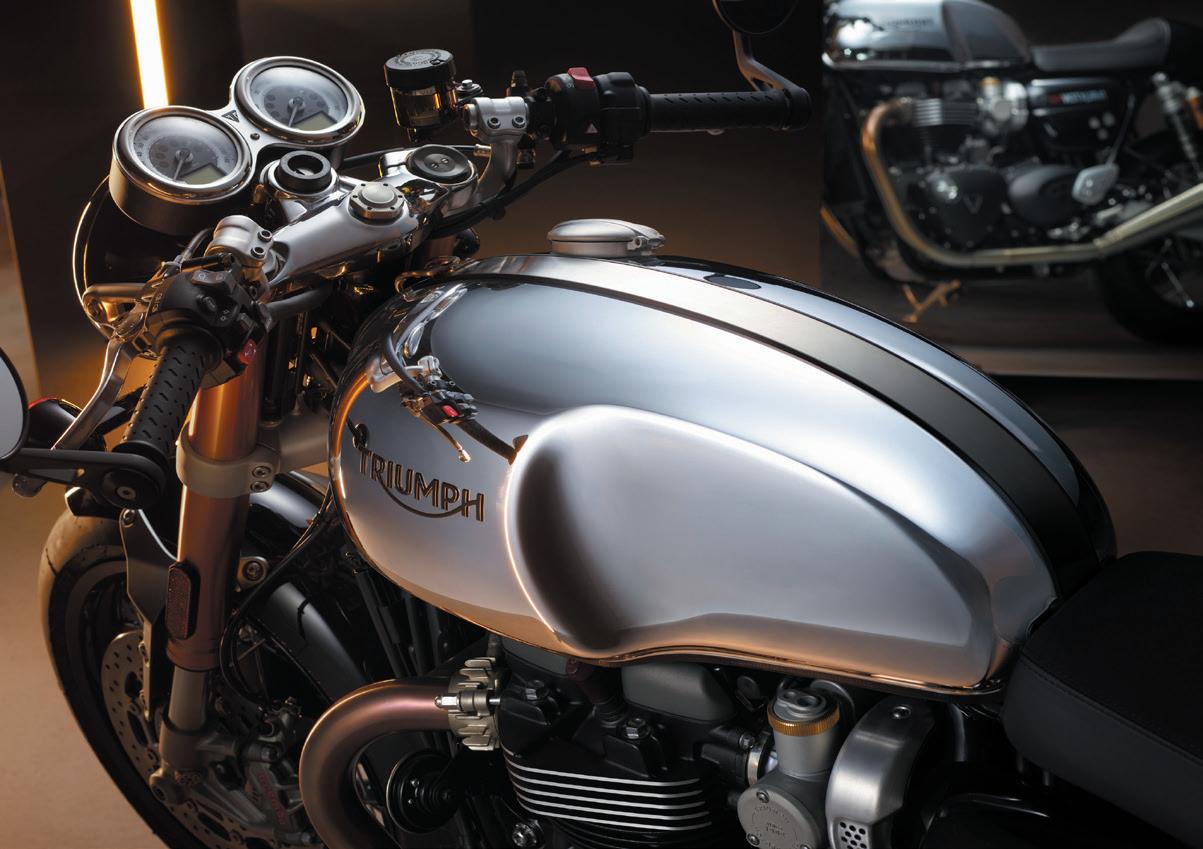
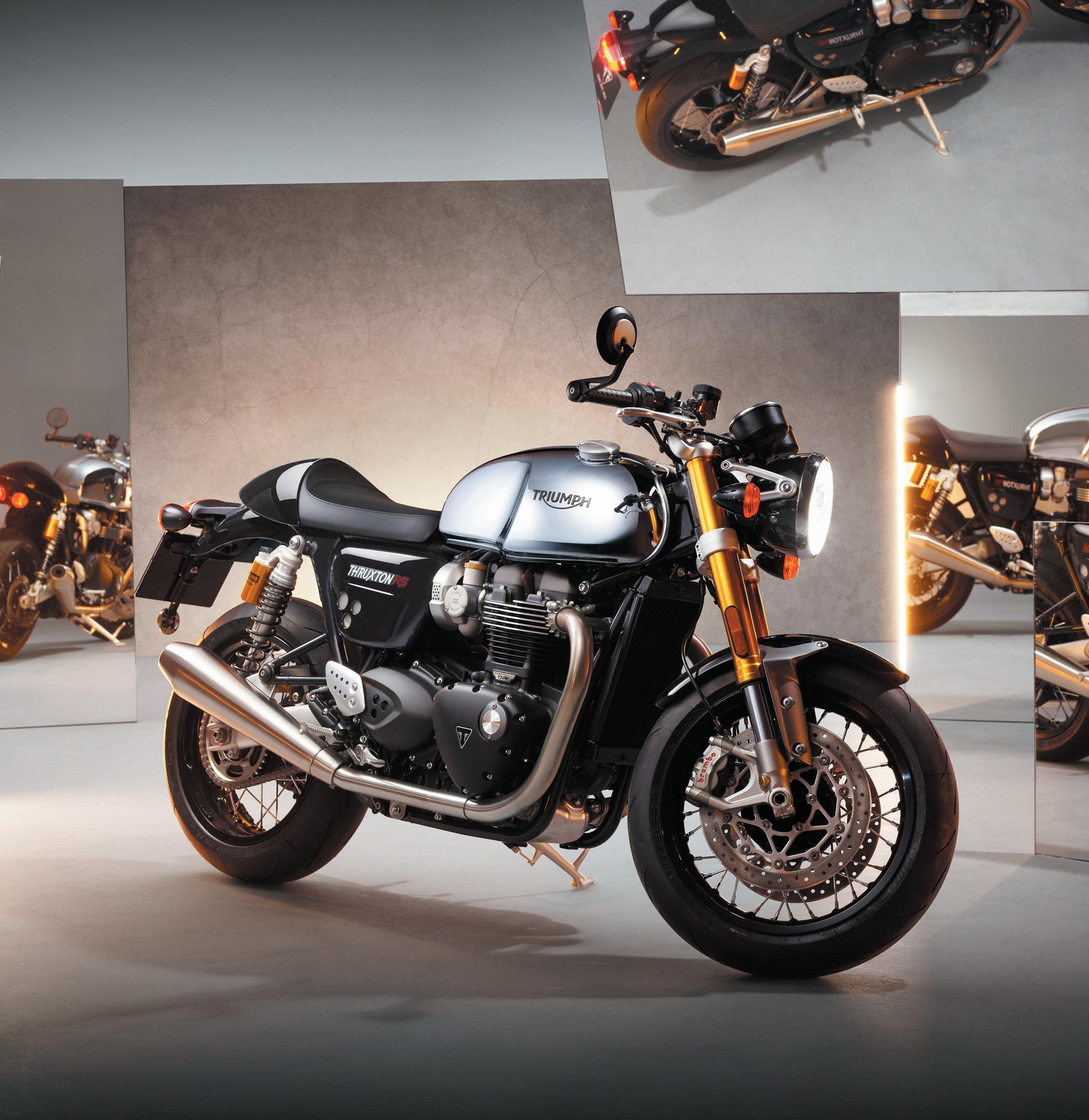
With a unique update and a major engine development for the exciting Thruxton RS, this vibrant new Chrome Edition showcases hand-crafted beauty, with a classic full chrome tank and stylish Jet Black paint scheme. Available for one year only, each Chrome Edition motorcycle perfectly showcases the craft and capability of the dedicated teams that perfected the skill of chrome detailing over many years, complementing the Thruxton RS’s dominating style. Own the new pinnacle in beauty, performance and sophistication from $17,445.00.

Discover the entire Chrome Edition lineup at triumphmotorcycles.com



Special Sled: 1958-1960 Norton Nomad
The term desert sled has now become cemented into the motorcycle lexicon alongside café racer, chopper, bobber, adventure, cruiser and the rest. But the desert sled wasn’t born in a marketing meeting: it was in the Mojave Desert.
America’s western deserts are unforgiving places full of surprises. Rocks, sand dunes, sinkholes, dry rivulets, levees, all with a side of cactus and rattlesnake. But they also lack speed limits and intersections, making them ideal for off-highway racing. Perhaps the highest profile proponent of desert racing in the classic era and one of its fiercest competitors was, of course, Steve McQueen, who espoused the racer’s philosophy in the movie Le Mans: “Racing ... it’s life. Anything that happens before or after, it’s just waiting.”
Perhaps the archetypal desert racer of the era was the 650cc Triumph Trophy. The Trophy started out as a rigid-framed 500cc trials bike using the all alloy, square-barrel “generator” engine that had been installed as an auxiliary power unit in Britain’s World War II bombers. The 500 proved itself in the 1948 International SixDays event, when the British team won the top prize on Triumphs (hence the name “Trophy”).
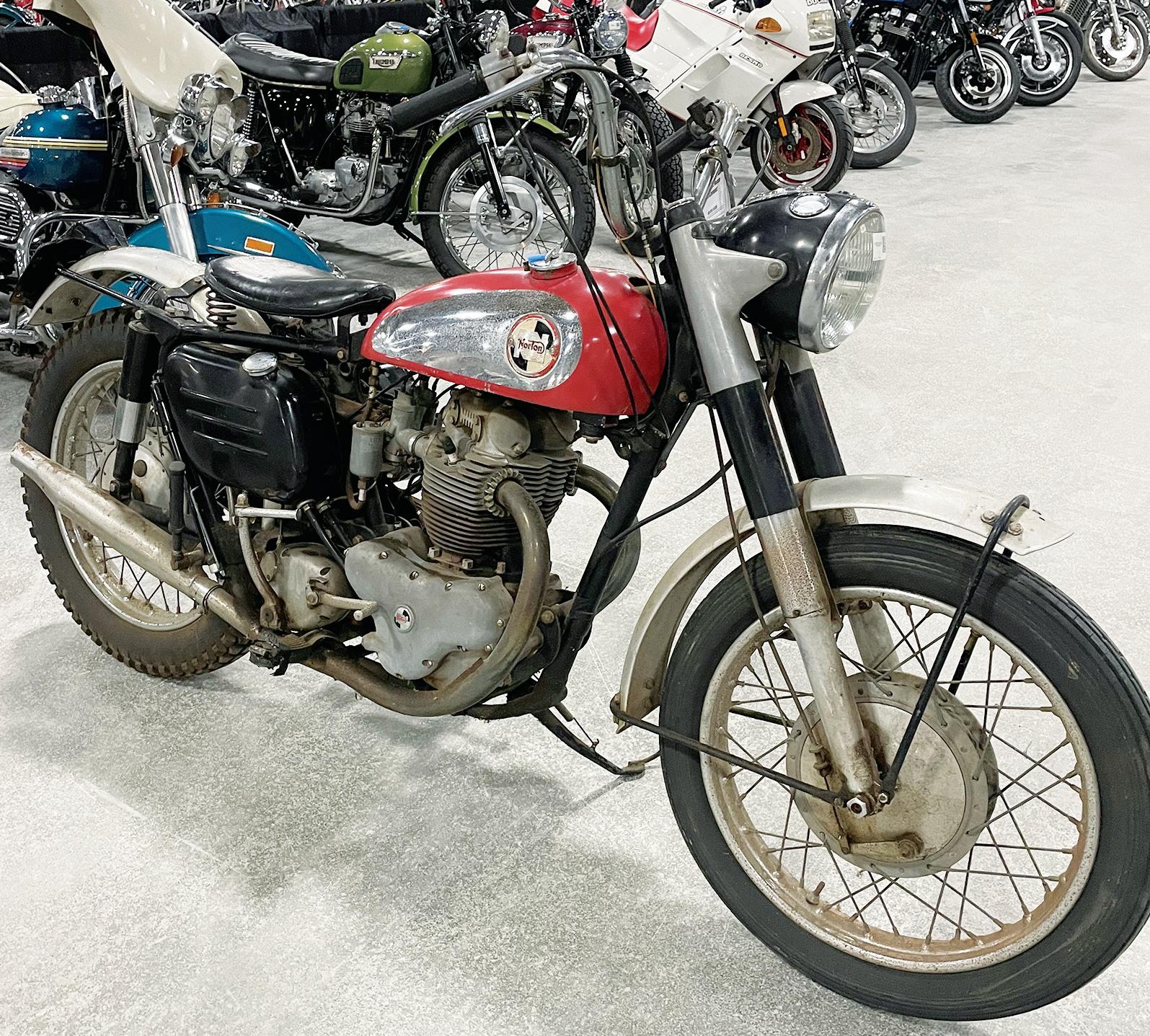
But trials are relatively slow speed events, and more power was needed for desert racing. That arrived with the 650cc Trophy-Bird, using the engine from the Thunderbird. But there was another problem: The Triumph sprung hub frame fitted to their street bikes was unsuitable at speed on the rough. Then in 1954, the Trophy specification solidified around a new swinging arm frame. With appropriate modifications to stock machines by the customer/racer (relaxed steering rake, a longer swingarm, removing mufflers and other extraneous parts and strengthening what was left), the desert sled as it became known was born.
Meanwhile over at Norton, race supremo Joe Craig’s focus was circuit racing and the single-cylinder Manx; but his control over the race department ended with his retirement in 1954, freeing up funds for development of the Dominator twins. This
resulted in the launch of Norton’s own Desert Sled, the 596cc Nomad in 1958. The Nomad’s engine was developed from the Dominator 99, and featured dual Amal 276 Monobloc carbs and an alloy cylinder head with bigger intake valves
NORTON NOMAD
Claimed power 36hp @ 6,000rpm
Top speed 95mph (est.)
Engine 596cc air-cooled, OHV parallel twin, 68mm x 82mm bore and stroke, 9:1 compression
Transmission Chain primary, wet multiplate clutch, 4-speed gearbox, chain final drive
Weight N/A
Price now $5,000-$15,000
and high compression pistons. In this spec, the Nomad made 36 horsepower at 6,000rpm compared with the Domi 99’s 31 horsepower at 5,750rpm. It featured magneto ignition, 6-volt alternator electrics and was topped with a gas tank borrowed from the Matchless G80CS scrambler. (Norton had been part of Associated Motorcycles since 1952.)
The non-unitized drivetrain with Norton/AMC gearbox was housed in a new frame developed for strength and based on that of the sidecar-tug Model 77, but with a tubular engine cradle rather than the 77’s forged item. A new oval-tube swingarm was designed to fit around a wider rear tire. The front fork was a hybrid using Roadholder components (long stanchions, short sliders, external springs and alloy damper rods). Wheels were 19-inch rear and 21-inch front with
Years produced 1958-1960
ON THE RADAR 8 MOTORCYCLE CLASSICS September/October 2023
A Nomad (with non-stock seat) brought $13,200 at the 2023 Vegas Mecum auction.
knobby tires. Alloy fenders, wide handlebars, full-width alloy hubs and siamesed exhaust completed the specification.
In all, around 350 Nomads were produced between 1958 and 1960 almost exclusively for the North American market with a limited number going to Australia. A batch of about 40 were built in 1960 around a tuned version of the 500cc Dominator 88 engine. The 500 differed from the 600 in its frame number prefix
(16 for the 500cc, 15 for the 600). The 500 Nomad also had a black seat with white sides, with this pattern reversed for the 600.
One of the first Nomads to arrive in the U.S. was entered in the challenging Big Bear Run in 1958, finishing eighth out of 822 starters, proving its off-road chops. But the Nomad only lasted three seasons, eventually replaced by the 750cc Atlas Scrambler, N15CS and P11.
The challenge with finding and restoring a Nomad is the small number produced, and its use of many unique parts, some of which are unobtainable and may have to be fabricated. That has limited the appeal of Nomads, and therefore restricted their resale value. But the rising awareness and collectibility of classic desert racers means now may be the time to buy! MC
CONTENDERS More alternatives to the Nomad
1958-1961 Matchless G11CS/G12CS
Matchless also enjoyed early success in the Big Bear Run, finishing first, second and third in 1954 using G80CS singles with Bud Ekins in front. But as a clue to the future, Gene Fox finished fifth on an AJS Model 20 “Spring Twin,” sister to the 500cc Matchless G9 twin.
So for 1958, AMC launched its own Desert Sled, the G11CS with a tuned 600cc twin developed from the G11 of 1956, installed in a motocross-style frame derived from the G80CS scrambler. The CS model featured a siamesed exhaust system, “western” handlebars and knobby tires. There was a choice of small or large gas tanks, and 19-inch or 21-inch front wheels. The G11CS lasted just one year before being replaced by the longer-stroke 650cc G12CS.
• Years produced: 1958 G11CS/ 1959-1961 G12CS
• Claimed power: 37hp @ 6,800rpm/42hp @ 6,600rpm
• Top speed: 100mph/ 106mph (est.)
• Engine: 593cc (72mm x 72.8mm bore and stroke)/646cc (72mm x 79.3mm) air-cooled, OHV parallel twin
• Transmission: Chain primary, wet multiplate clutch, 4-speed AMC gearbox, chain final drive

• Weight (dry): 381lb/390lb
• Price now: $6,000-$12,000
The G12CS came with a 3-gallon alloy gas tank, alloy fenders, 5-pint oil reservoir, modified front fork based on AMC’s Teledraulic units, dual rear shocks and highlevel exhaust. But in spite of running on three main bearings, the crankshaft proved inadequate for the power demands made on it, and future AMC big twins, like the G15/N15 CS and P11 were built around the 750cc Norton Atlas engine.

1956-1962 Triumph TR6 Trophy
The TR6 Trophy was essentially a grown-up version of the 500cc TR5 with a 650cc Tiger 110 engine. However the TR6 featured a new alloy cylinder head for better temperature control, a smaller 3.25 gallon gas tank, a shorter seat quickly dubbed the “ironing board,” a 20-inch front wheel and a waterproof Lucas KF2C competition magneto. The headlight assembly was quickly detachable, and exhaust was handled by siamesed high pipes on the left side.
Three stock “Trophy-Birds” were entered in the 1956 Big Bear Run with Bill Postel, Bud Ekins and Arvin Cox riding. The trio finished 1-2-3. The TR6 quickly became the winning machine for desert racing. Cycle magazine tested a 1956 TR6 over the course of a week and found it to be completely reliable with only an occasional cough from the carburetor.
For Eastern U.S. enduro competitors, Triumph introduced the TR6/A with a 19-inch front wheel, 8-inch front brake with air scoop, low level exhaust and magneto with auto advance. The original TR6 continued in the West as the TR6B until it was replaced by the unit construction TR6SR and T120C from 1963 onward.

• Years produced: 1956-1962 (Pre-unit construction)
• Claimed power: 42hp @ 6,500rpm



• Engine: 649cc air-cooled, OHV parallel twin, 71mm x 82mm bore and stroke
• Transmission: Chain primary, wet multiplate clutch, 4-speed gearbox, chain final drive
• Weight (dry): 370lb (168kg)
• Price now: $5,000-$18,000
www.MotorcycleClassics.com 9
“The challenge with finding and restoring a Nomad is the small number produced.”
THE 2023 QUAIL MOTORCYCLE GATHERING


Two-Wheeled Glamour on the Greens
The 13th annual event was held on Saturday, May 6, 2023, at the Quail Lodge and Golf Club in Carmel, California. According to the event’s organization, more than 3,000 people attended with 250 or so motorcycles on display. There had been a threat of rain in the days leading up to the event, but thankfully the weather cooperated, and it was a perfect day for sightseeing on the lawn. This year, there were 29 awards given in 19 categories. In
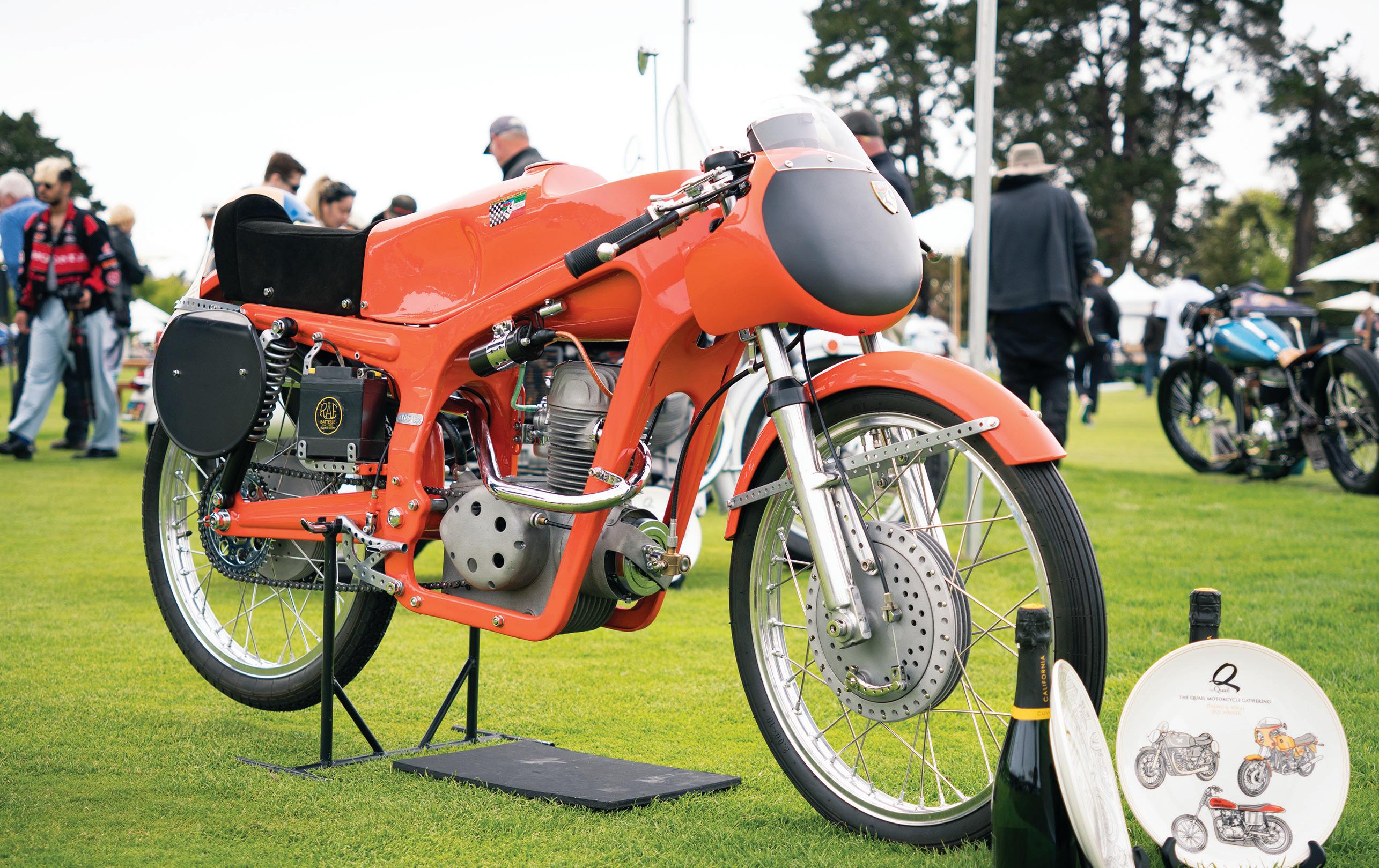
addition to the traditional categories (American, British, Italian, Japanese, other European, competition, custom/modified, choppers and bicycles/scooters), there were three special categories this year: Italian singles, 1970s Vintage Muscle and “Bring on the Baggers.” As in previous years, evaluation of the show bikes was overseen by head judge Somer Hooker and a team of about 40 judges. Awards were presented by Somer and perennial emcee Paul “The Vintagent” d’Orleans.
Best of Show this year was an Italian 1939 Miller-Balsamo 200cc single owned by San Franciso architect John Goldman. Beautifully restored by Zen House in Point Arena, California, it’s one of only a handful left intact in the world. The “Spirit of the Quail” Award went to Robb Talbott for his 1956 AeroCapriolo Corsa 75, which also won the Italian Single class. The AMA
10 MOTORCYCLE CLASSICS September/October 2023
TThe Quail Motorcycle Gathering continues as one of the premier motorcycle-specific shows in the country.
Story and photos by Corey Levenson
Robb Talbott’s class-winning 1956 AeroCapriolo Corsa 75.
Motorcycle Hall of Fame Museum Heritage Award went to Wayne Rainey for his 1971 Yamaha Mini Enduro 60. It was his first competition bike and bristled with go-faster modifications.
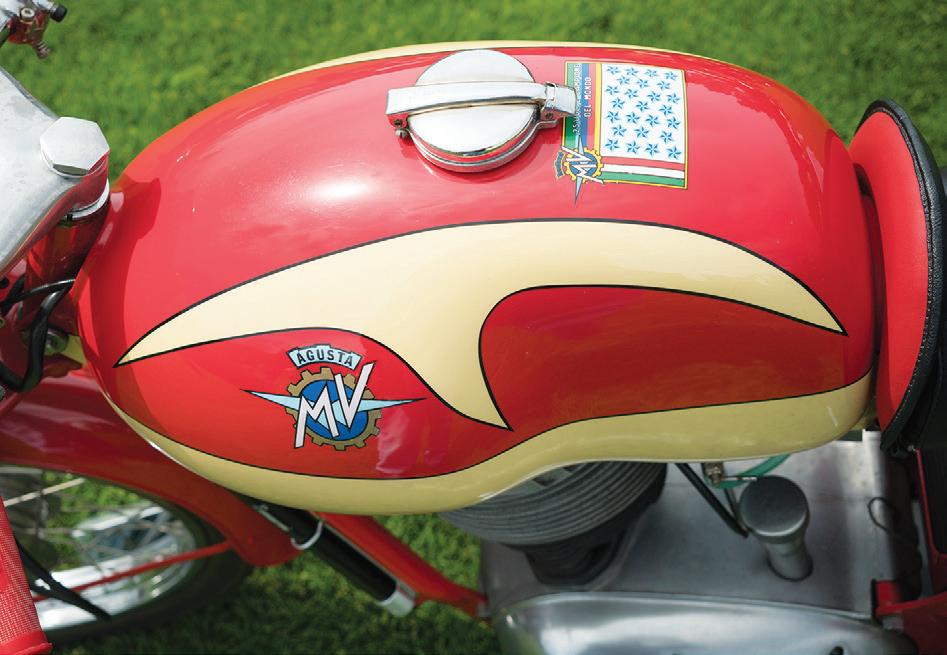

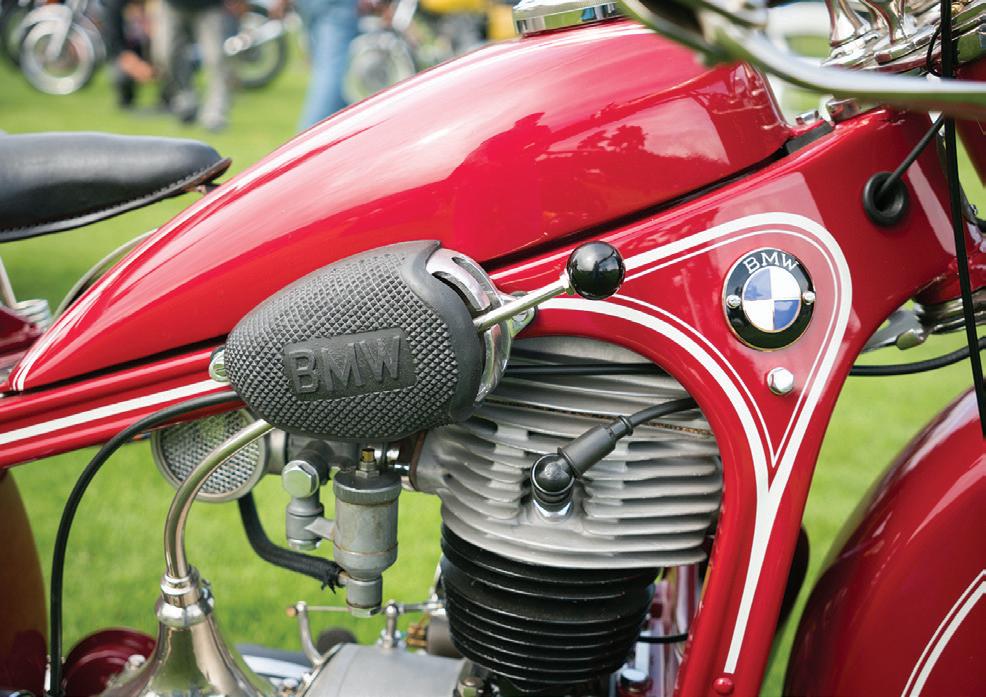
This year’s honoree as “Legend of the Sport” was Wayne “Bubba” Shobert. He’s a three-time AMA Grand National Champion (1985, 1986 and 1987) and the 1988 AMA Superbike Champion, all won while riding Hondas. Chris Carter (owner of Motion-Pro) brought Bubba’s 1987 championship-winning Honda RS750D and fired it up to the delight of Bubba and the crowd.

Wayne Rainey and Eddie Lawson joined Bubba on stage, and they engaged in an entertaining chat, sharing war stories from their days on track in the 1980s with Gordon McCall, the Quail Gathering impresario.
I was on the team judging the Custom/Modified Class which
Clockwise from left: This fellow is the original owner of the BSA. He’s been driving the bike and the truck for 50 years. A Ducati single flat-track racer. A 1948 BMW R35 — a fine example of the highquality bikes at the Quail. This MV Agusta single is curvaceously Italian. A pair of participants prep a Vincent Comet for judging.
was won by a 2020 custom built by Max Hazan. The bike was built around a pair of supercharged 350cc Velocette singles. From conceptualization to fabrication, the machine was spectacular and typical of the extremely high quality of Max’s work. His Vincent Rapide-based special won Best of Show at last year’s Quail Gathering. I wish I could have heard the blown bi-Velo run but, alas, ‘twas not to be …
If you haven’t been before, it’s worth considering a trip to this event. The venue is beautiful, the bikes are extraordinary, and the attendees are an interesting bunch. The Quail Motorcycle Gathering is usually held the first Saturday in May, which would put next year’s edition on Star Wars Day, May 4th, 2024. Keep an eye on the event website for further details: peninsula.com/en/ signature-events/events/motorcycle MC

www.MotorcycleClassics.com 11
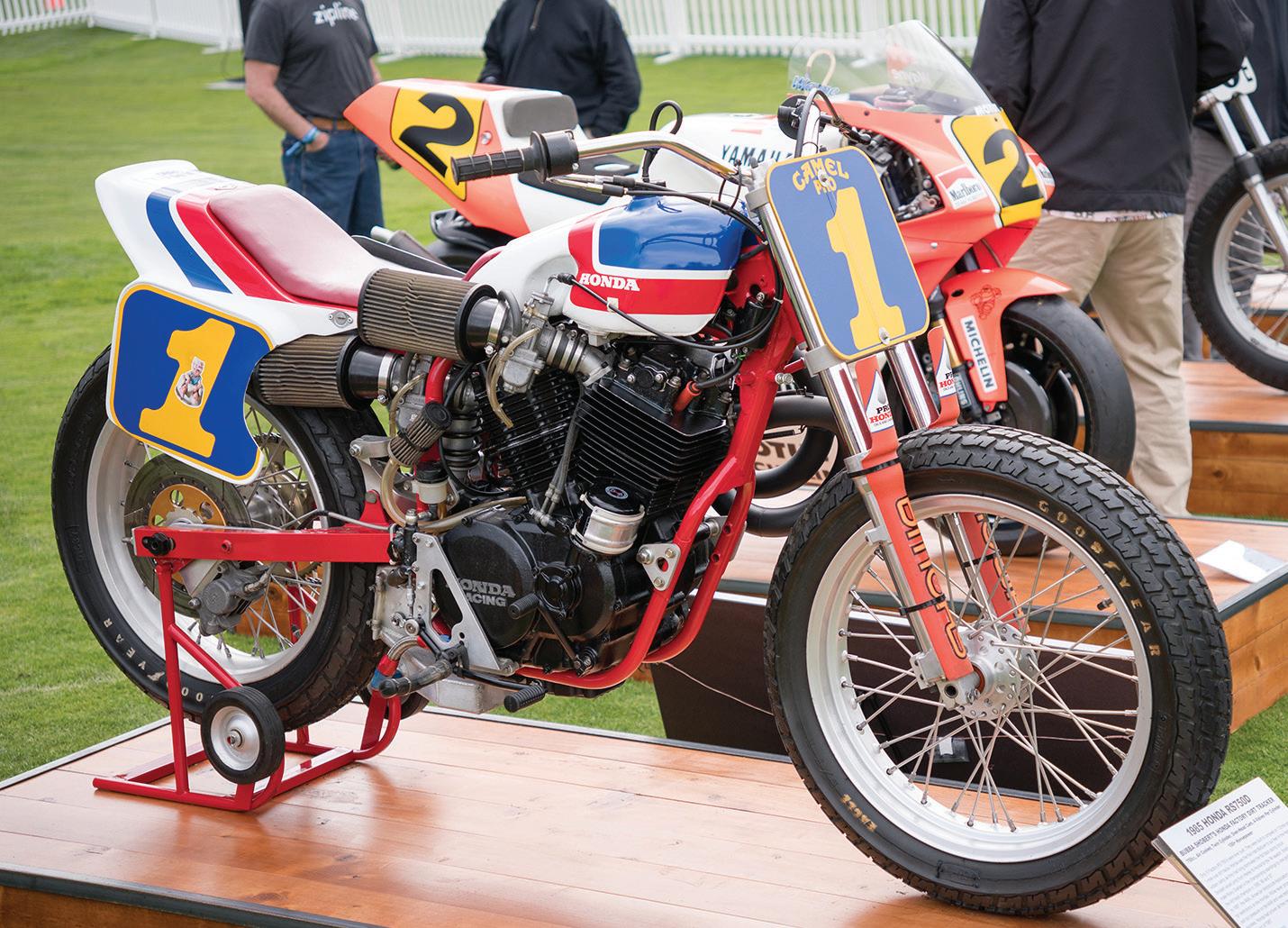
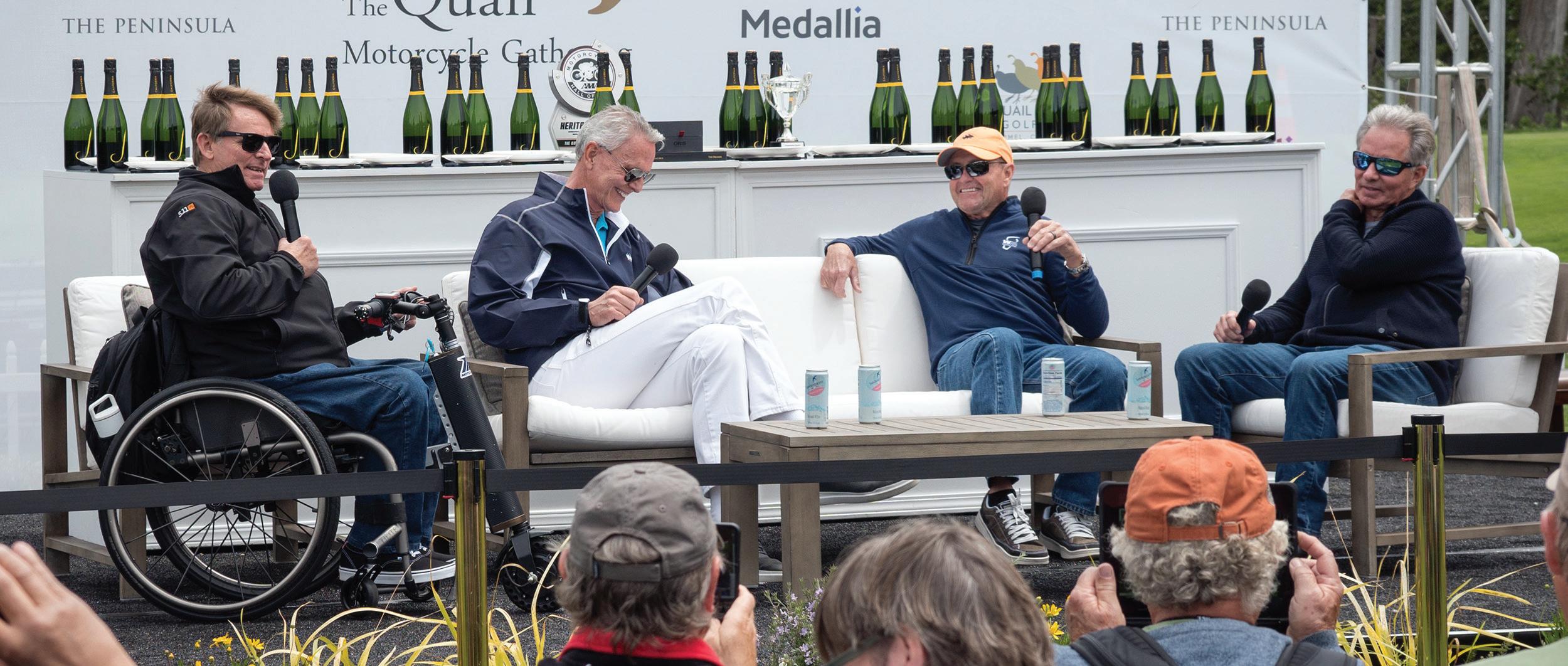

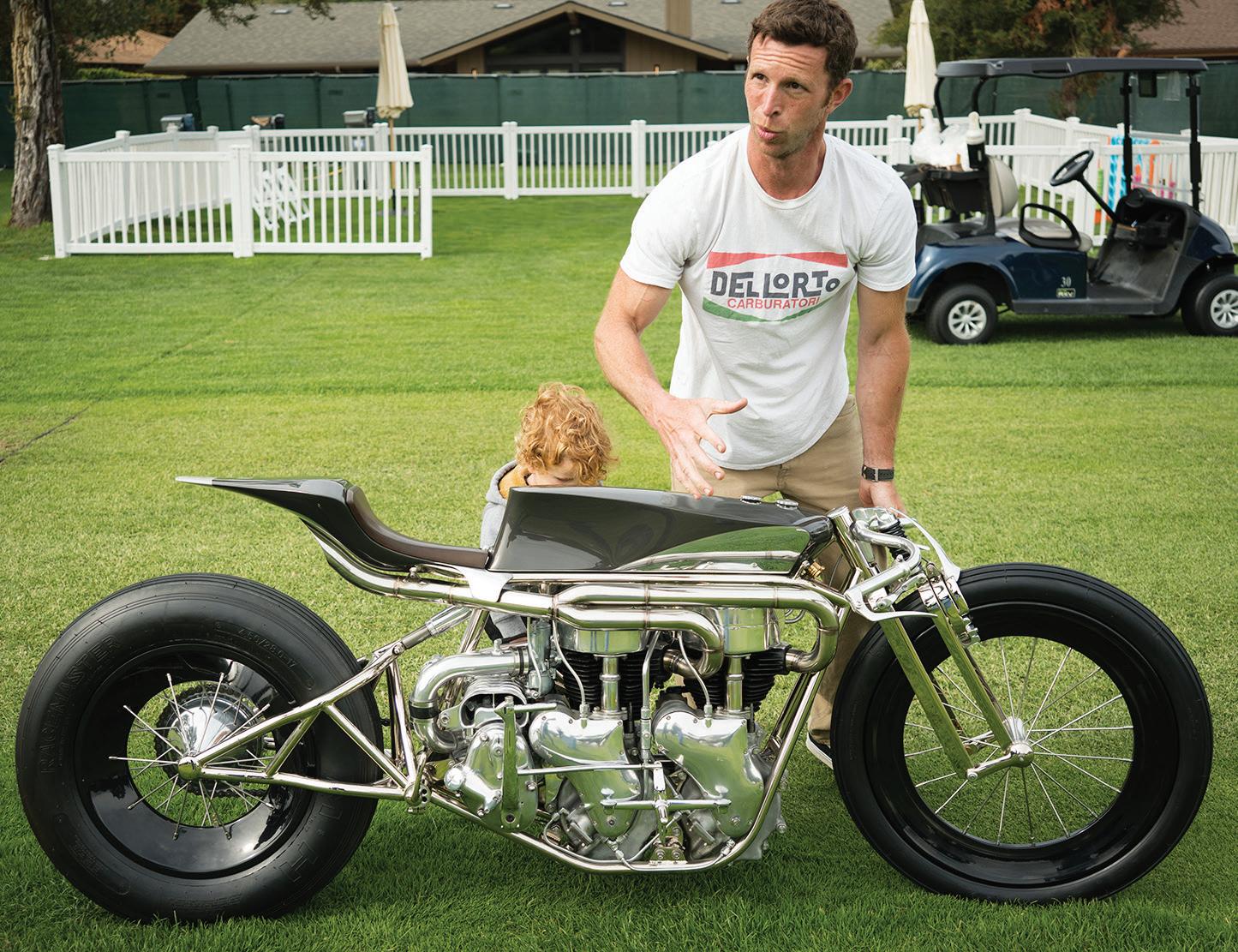
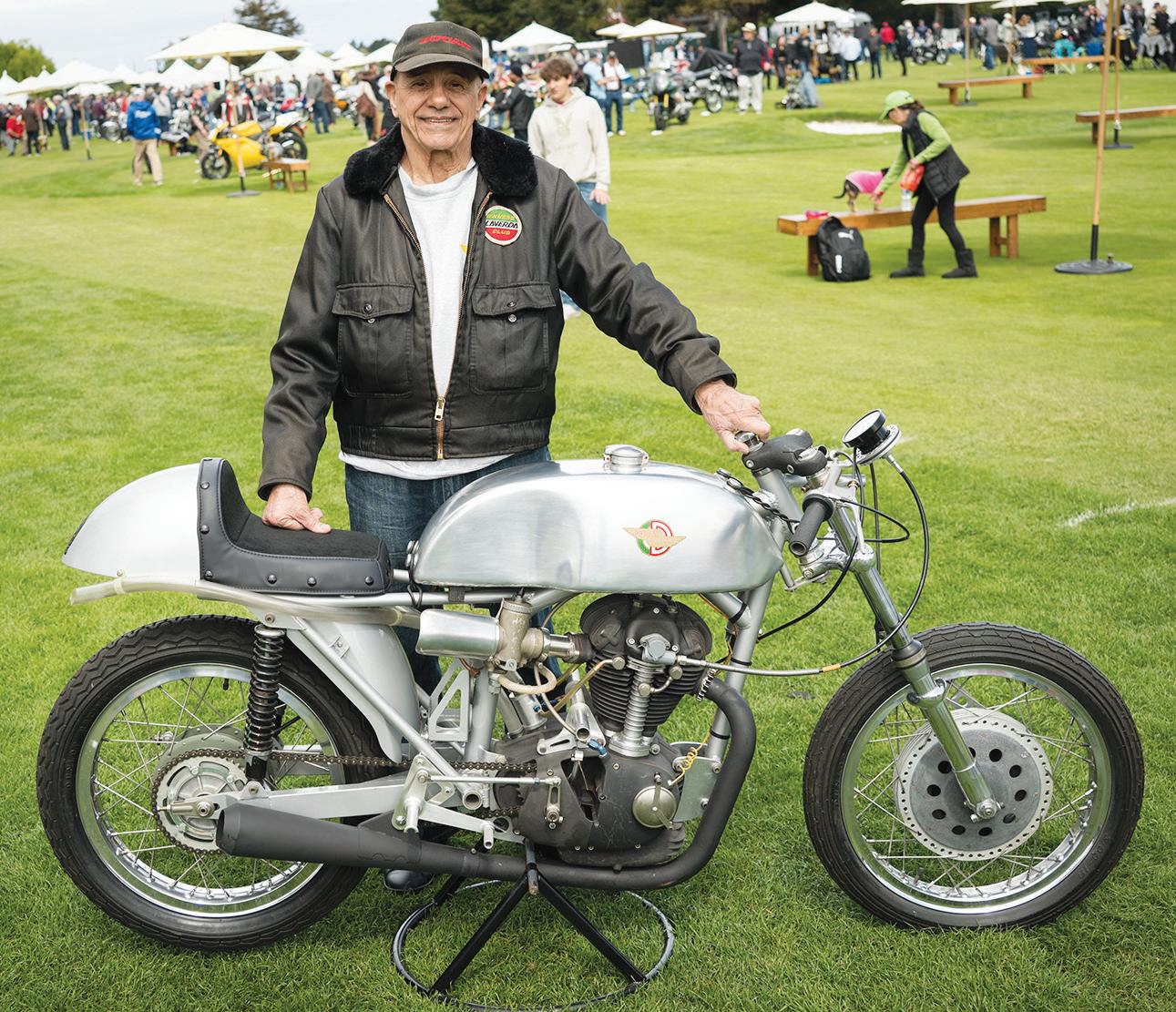
12 MOTORCYCLE CLASSICS September/October 2023
Left: Frank Scurria with his homebuilt 350cc Ducati race bike. Right: Max Hazan and his blown twin 350cc Velocette — the Custom/Modified Class winner.
Left: Admiring a lovely 1940 5T Triumph Speed Twin. Right: Bubba Shobert’s Championship-winning Honda RS750D. Below: Wayne Rainey, Gordon McCall, Bubba Shobert and Eddie Lawson reminiscing.
Clockwise
John Goldman’s 1935 Motoconfort M5C Grand Sport 500 — a French beauty. Former World Roadracing Champions Wayne Rainey and Eddie Lawson. Left

Somer Hooker, Paul d’Orleans and owner John Goldman with the Best-ofShow-winning 1939 MillerBalsamo 200 Carenata. A sharp Norton 750 Commando S heading a nice line-up of classic BMWs, including a R90S.
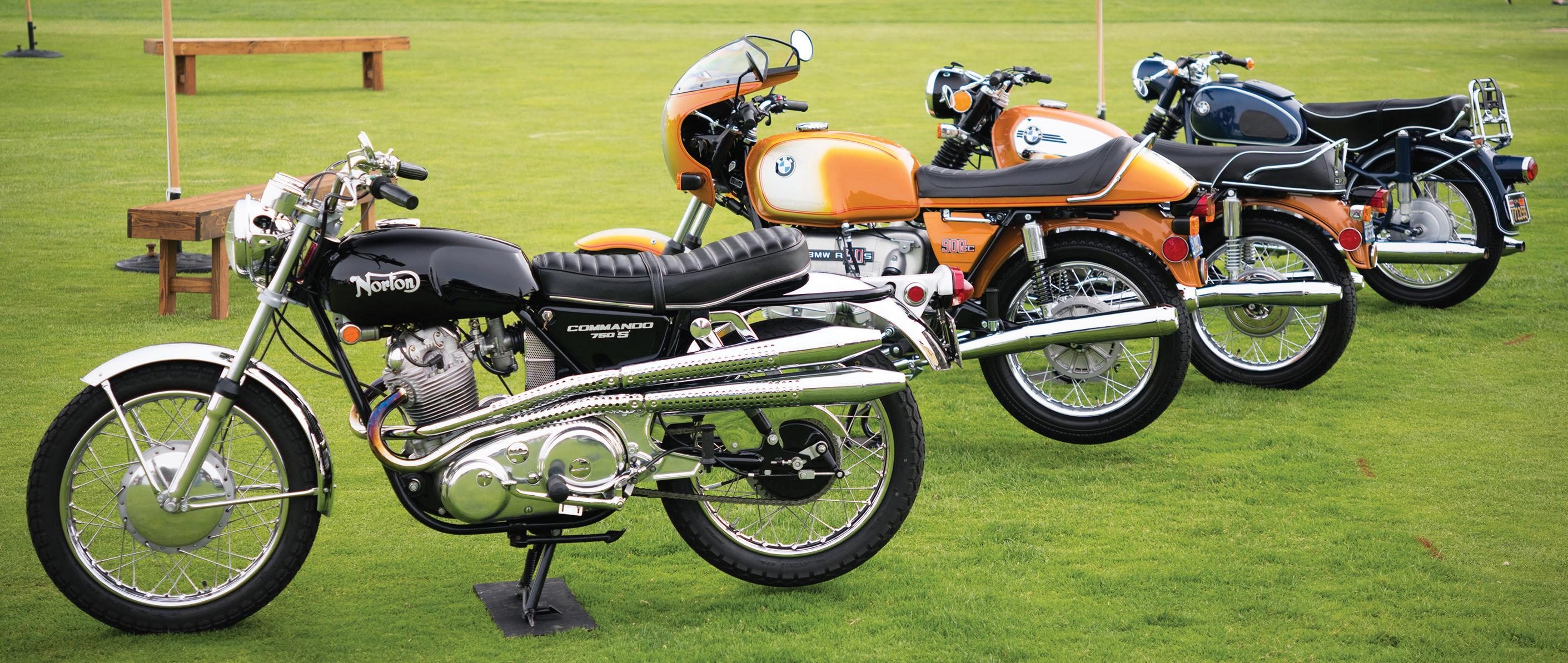


www.MotorcycleClassics.com 13
from left:
to right:
THE RESCUE OF THE AVOCADO
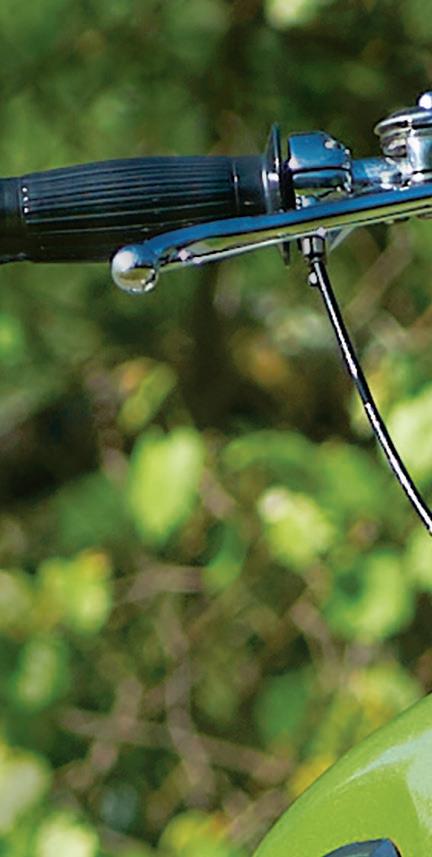


1970 Triumph TR6R
Story by Margie Siegal
Photos by Nick Cedar
TThe knights, resplendent in shining armor (they spend eight hours a week polishing) dismounted and walked to the door of the shabby warehouse. Knocking loudly on the door, they shouted they were there for The Avocado. The door was opened a crack, and a beady eye was seen. “Whaddya want,” a voice snarled. The first knight stuck a mailed foot in the opening. “We are here for the Avocado,” he repeated loudly.
Enough of Dungeons and Dragons. The actual story of how Dennis Etcheverry rescued a green 1970 Triumph TR6R from the clutches of a strange and sketchy individual is entertaining enough.
Dennis is a master welder who is a partner in Norman Racing, a service facility for high-end sports cars. After hours, he collects motorcycles, mostly British. Even if he is not actively interested in buying, Dennis likes to look at the motorcycles for sale advertised in Craigslist. Some five or six years ago, Dennis was idly scanning the Craigslist ads. He saw a green 1970 Triumph that looked promising, and called the number listed in the ad.
A TR6R is a single carburetor version of the Triumph twin. “When I was a kid,” says Dennis, “Everyone wanted a Bonneville, the dual-carb twin with splayed intake ports. But the single-carb machines are much easier to maintain. There’s no carburetor synching. People who bought them used them for transportation, not racing, so when you do find a single-carb Triumph, it is less likely to have a worn out engine.”
Dennis says that the 1970 Triumph twins were “the last of the good ones.” Triumph motorcycles had become popular in the United States after World War II, and the British firm increasingly geared its offerings to the U.S. market, which bought style, chrome and horsepower, unlike the English, who wanted fuel economy and weather protection. Triumphs were sought after for desert racing in the Western states, and getting around and general mayhem everywhere else. In the 1950s, Triumph put out a quality product: warranty claims were low.
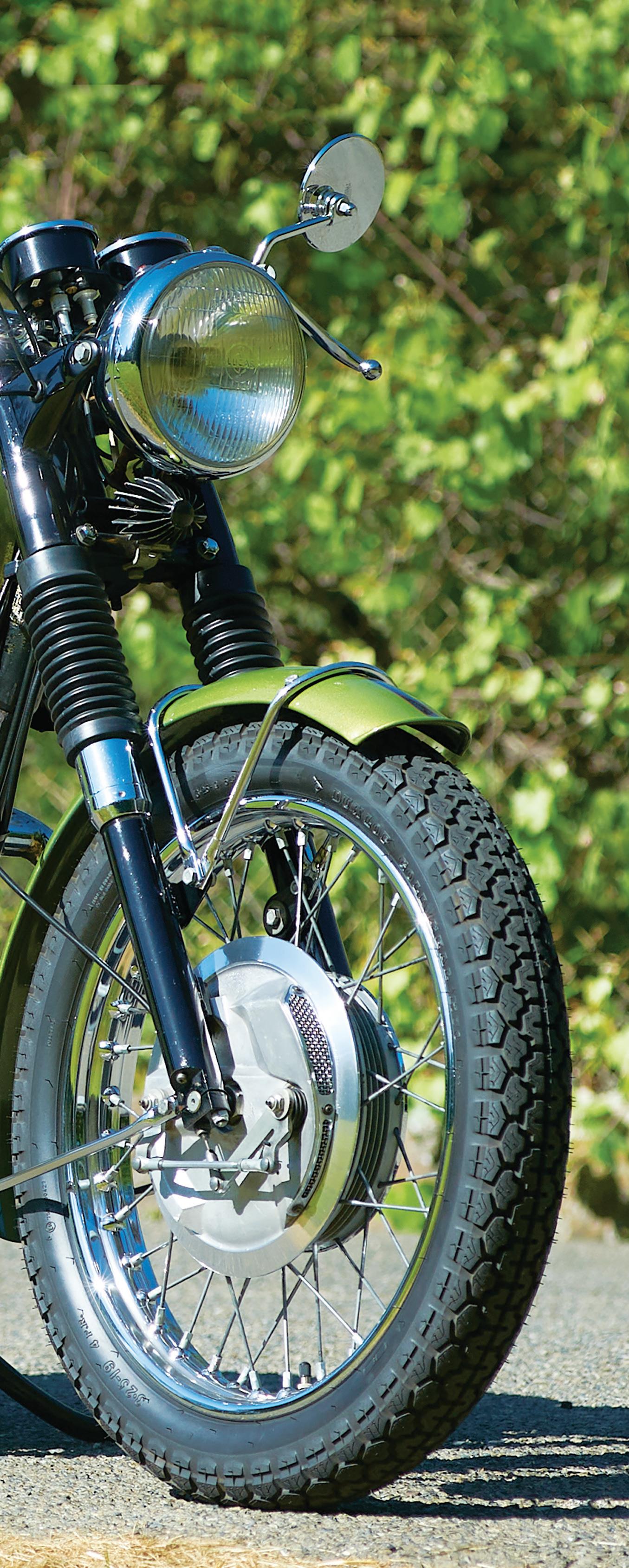
Looking back
The ancestor of the TR6 was the 650cc Tiger 110, introduced in 1954. It had swingarm rear suspension, a beefed up bottom end, a racing camshaft, and could top 100mph. It was followed in 1956 by the first of the TR6s, (sometimes known as the Trophy-Bird), which had an alloy head, a slimmer gas tank, a shorter seat, a wider rear tire and a waterproof Lucas magneto. This bike was aimed squarely at the Western desert campaigner, at a time where if you weren’t riding a Triumph in the hare and hound, you were not serious. Triumph started making East Coast models for enduro competition and wetter conditions and West Coast models for desert racing and drier conditions. As the Fifties progressed, most models got an easier to tune and more reliable Monobloc carburetor. Triumph also introduced tanks with stylish two-tone paint jobs. The TR6 came in two versions: a roadburner with low pipes, and a scrambler
www.MotorcycleClassics.com 15
with high pipes, which were sometimes joined by an offroad competition weapon with no lights and straight pipes.
By 1957, Triumph was selling 13 different models in the U.S. In 1958, Triumph outsold all other motorcycle manufacturers in the U.S. To put this in perspective, nobody was selling a lot of motorcycles — Harley-Davidson only sold 12,676 that year — but Triumph dealers were doing better than most.

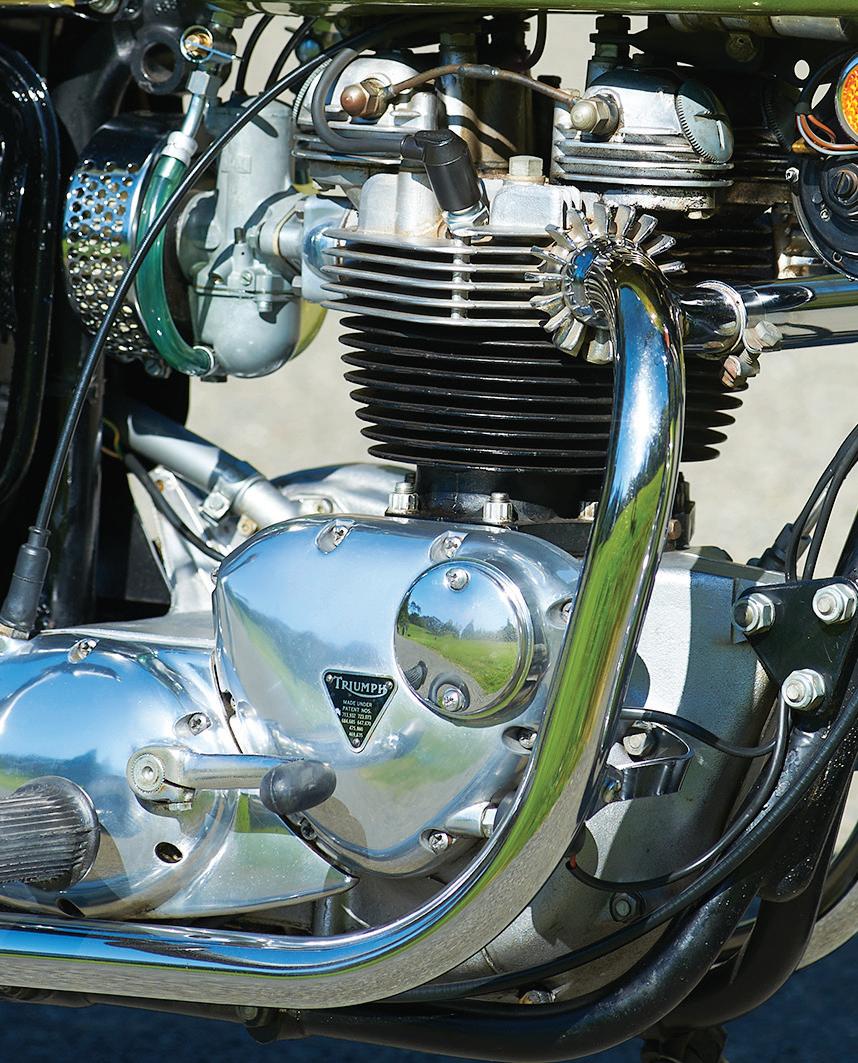
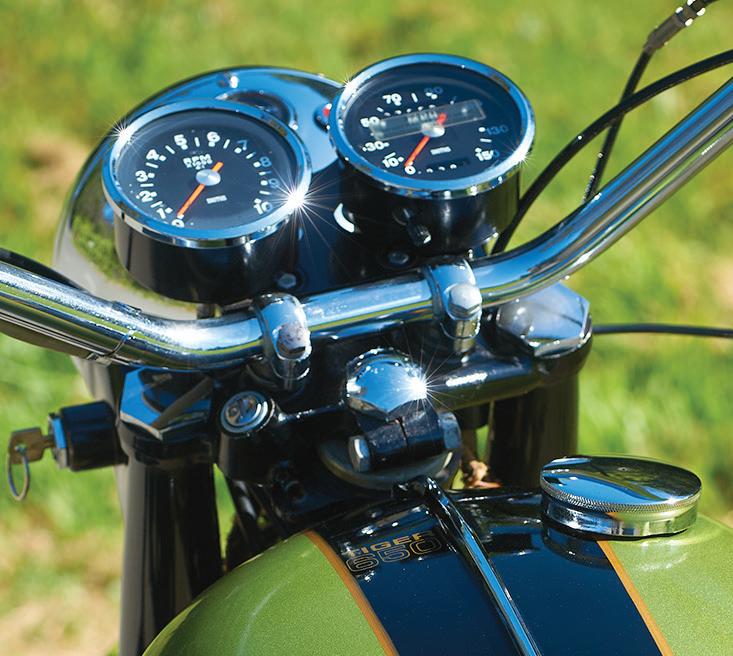

Honda comes to America
1970 TRIUMPH TR6R
Engine: 649cc air-cooled 4-stroke vertical twin, 71mm x 82mm bore and stroke, 9:1 compression ratio, 43hp at 6,500rpm
Top speed: 103mph (period test)
Quarter mile: 14.2 seconds @ 92.1mph (period test)
Carburetion: 30mm (930) Amal Concentric single carburetor
Transmission: 4-speed, right foot shift, chain final drive
Electrics: 12-volt battery and coil
Frame/wheelbase: Single downtube cradle frame, swingarm rear/55.5in (1,410mm)
Suspension: Telescopic forks front, dual Girling gas shocks rear
Brakes: 8in (203mm) TLS drum front, 7in (178mm) SLS drum rear
Tires: 3.25 x 19in front, 4.00 x 18in rear
Seat height: 30.5in (775mm)
Weight (dry): 387lb (176kg)
Fuel capacity: 3.5gal (13.2ltr)
At this point, Honda entered the U.S. market, just as the first Baby Boomers reached driving age. Life completely changed for the U.S. motorcycle retailer. Honda had deep pockets as a result of its sales in Asia, and a number of other
Price then/now: $1,280 (est.)/$5,000-$15,000
advantages. Honda’s company culture was to reinvest profits in the product, instead of distributing them to stockholders, as did Triumph. Honda had a great deal more leverage over its suppliers than Triumph, who was treated as a sort of a stepchild by Lucas and other companies whose largest customers were automobile manufacturers. As a result, Hondas were built on state of the art machinery, and had bright lights, electric starters and no leaks. Honda could build 1,000 lightweights a day, while maintaining quality control standards. Honda also spent a lot of money on general interest advertising.
At first, the appearance of Honda, and then Suzuki, Yamaha, and Kawasaki, improved life for the American
16 MOTORCYCLE CLASSICS September/October 2023
1970 TR6R (left) vs. 1970 Bonneville: simplicity vs. speed.
Triumph dealer. For the first time since the 1920s, motorcycling became socially acceptable. Small Hondas were easier to ride and maintain than the Triumph Cubs that had been the entry level motorcycle sold by Triumph. Many retailers started selling both Hondas and a British make, such as Triumph or BSA. Riders would start on a small Japanese motorcycle and graduate to a larger British twin. Triumph sales boomed. In the 1960s, America’s Triumphs made the grids of flat track races and road races, got their owners to work and school and went cow trailing and touring.
Triumph soldiers on
The situation was different in England, where motorcycles had been used for decades as a cheap car substitute. With the advent of inexpensive small cars and Japanese imports, the get to work rider switched from the home product to either a four-wheeler or a twowheeled import. As the Sixties progressed, Triumph pruned its
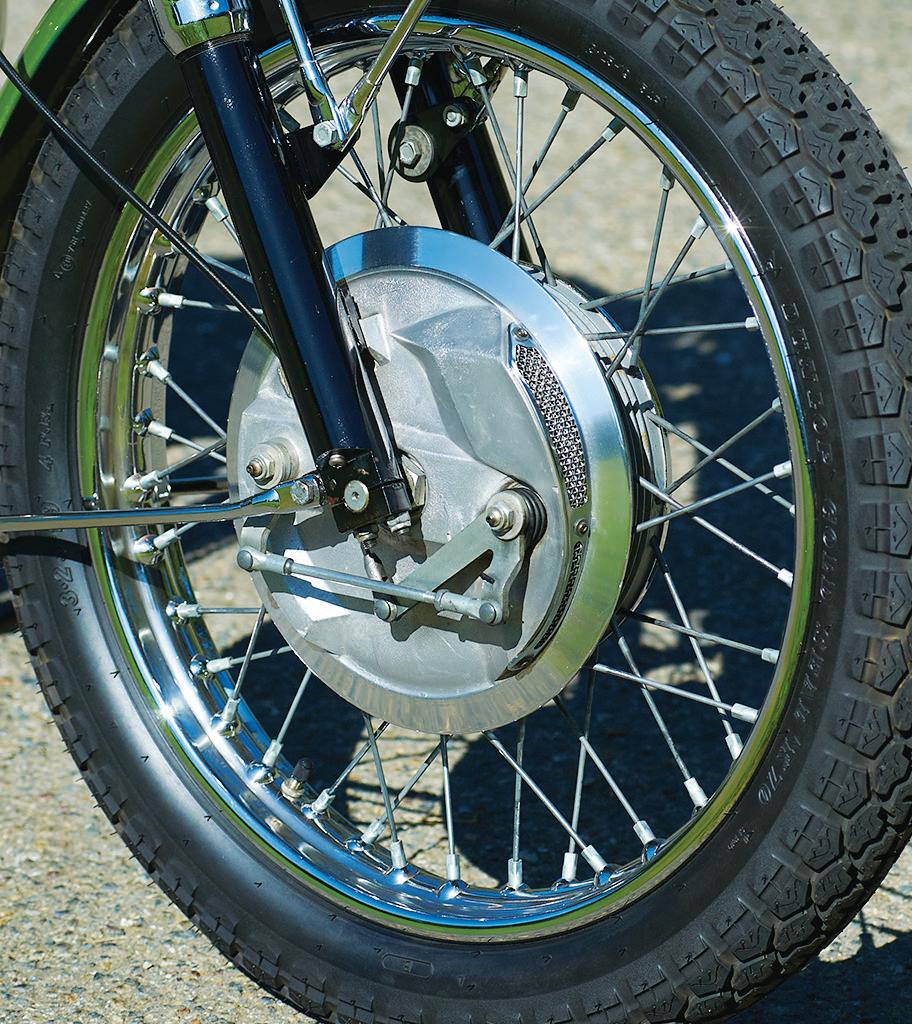
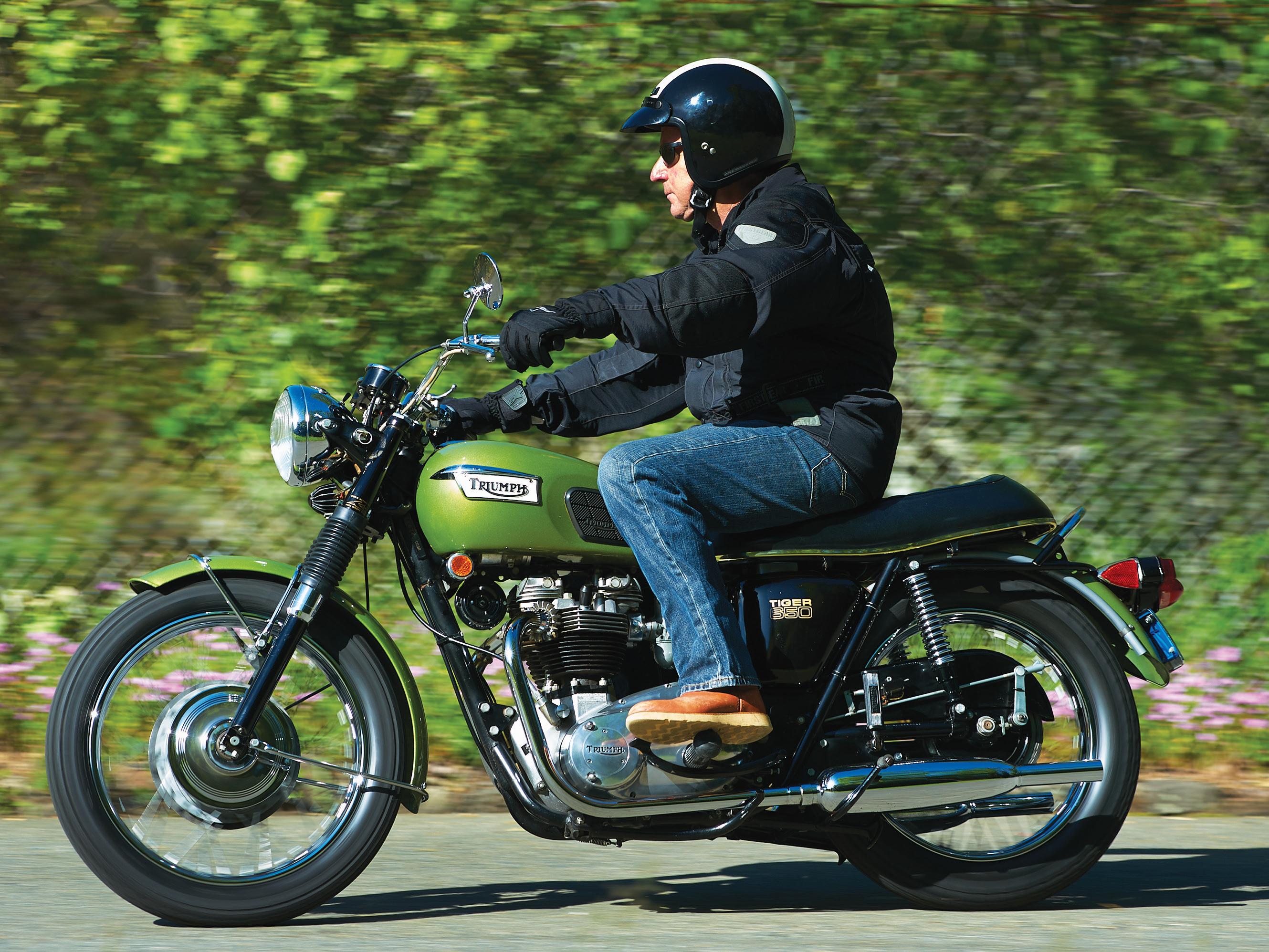
offerings to concentrate on what it thought would sell in its overseas markets, the largest of which was the U.S. However, it did not upgrade its machine tooling, which limited what could be produced. Over the decade, management began to change from people who knew and understood motorcycles to people who knew nothing of either bikes or the people who rode them. Management and labor became increasingly antagonistic.
Cycle World arranged a test of a TR6SC in 1965. The magazine was enthusiastic about the power generated by the bike (45hp @ 6,500rpm). The bike came without a headlight, but with stiff suspension and long travel forks. Muffler-free pipes exited above the rear axles. In 1963, Triumph had gone to unit construction of engine and gearbox, which Cycle World liked because there were fewer joints to leak, and its report noted the fact that the test bike stayed leak free in 600 miles of hard desert riding. Testers praised the
www.MotorcycleClassics.com 17
Big drum brakes effectively stop the bike.
A well-tuned Triumph is a joy to ride.
TR6SC’s ease of starting and ease of shifting. “But what we liked most about the Triumph special is that it is such fantastic fun to ride.”
Three years later, Cycle reported on the road going version of the TR6, the TR6R. Although the single-carburetor machine was not the beast to beat in drag races, testers stated that it was the most manageable and the most durable of the Triumph twins. Testers did not like the new Concentric carburetor and suggested it be replaced by either a Monobloc (the previous edition of the Amal) or a 30mm Japanese instrument. They did like the strong but light frame, the good handling and the double-leading-shoe 8-inch drum front brake with an air scoop.
1969 marked the debut of both the Honda 750, a powerful but well-mannered machine with a front disc brake and an electric starter, and the Kawasaki H1, a screaming 500cc 2-stroke, nicknamed “The Widowmaker.” Triumph had a triple-cylinder design ready to go in late 1963, but dallied around with styling changes and corporate inertia. Triumph was selling more bikes than ever — about 28,700 in 1967 — but failed to pay attention to quality control. Tooling was run until completely worn out. Warranty claims mounted.
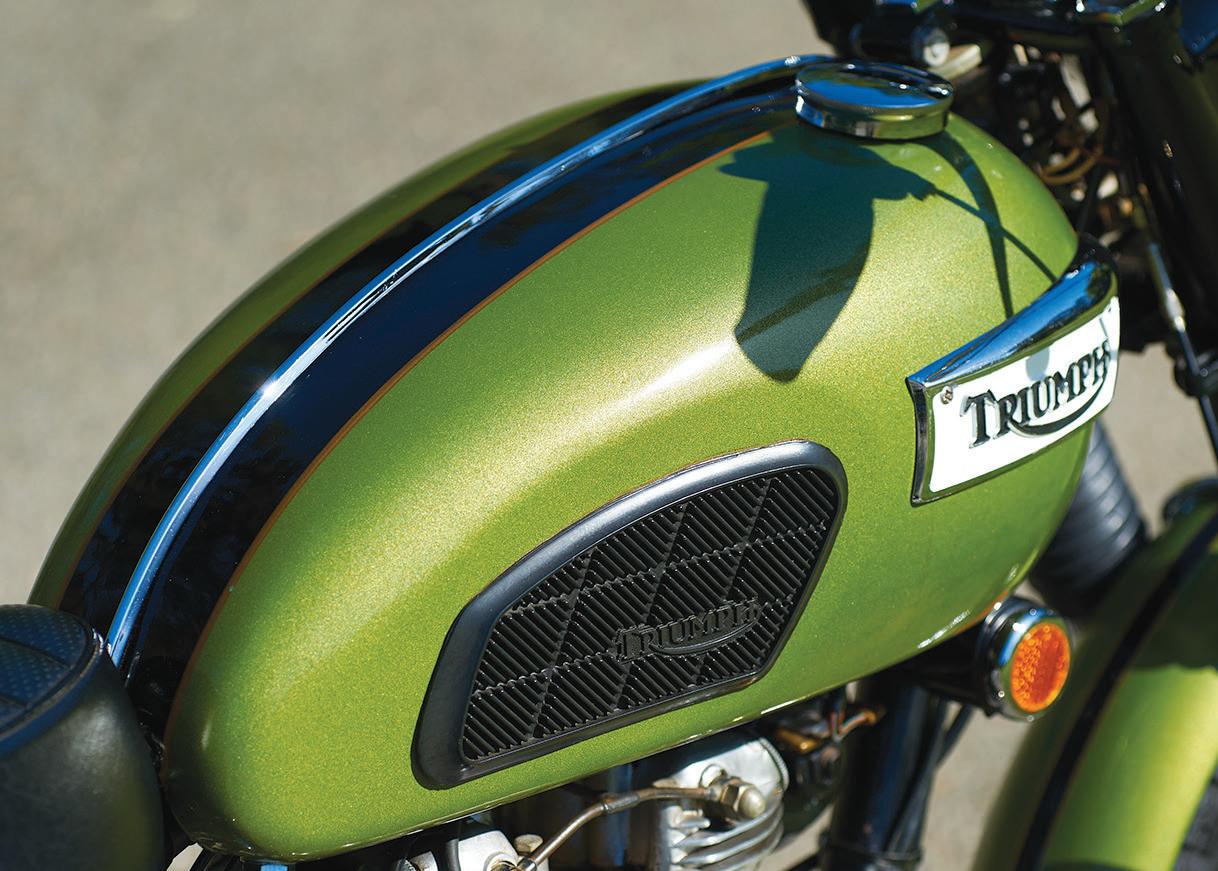
Cycle revisited the TR6R in 1970. Its report on the 1970 TR6R was, in the main, positive. The starting was as easy as it had been in 1965, and the bike stood up to side winds, had almost no noticeable vibration up to 70mph, and was a pleasure to ride on twisty roads and around town. Over 70mph, the engine transmitted vibration through the seat, although rubber mountings on the bars quelled the tingle to the fingers. The tester commented that the taillight stopped working during the ride and there was a small leak. The color was Spring Gold, “a translucent avocado green.”
Last
year before big changes
1970 was the last year for the desert-racing-proven frame. The parent company in England had spent millions of dollars on an R&D center staffed by non-motorcyclists, who
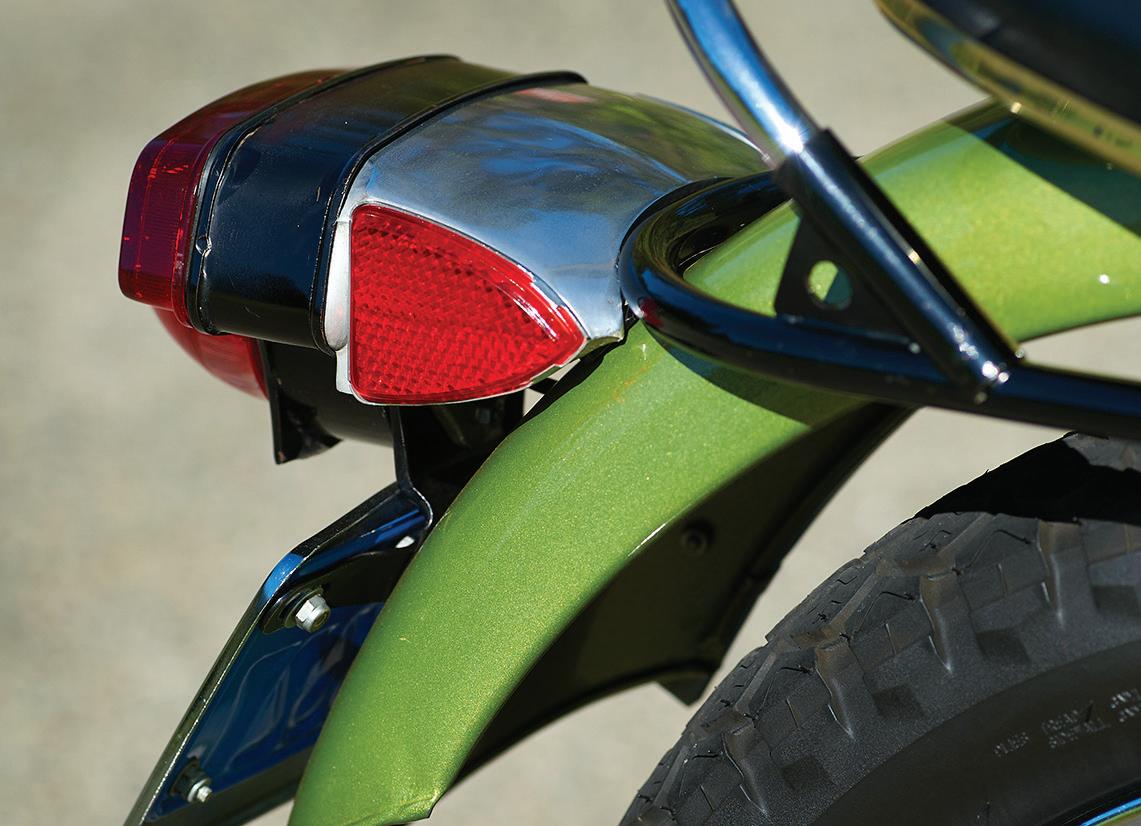

The official name for this color is Spring Gold, but everyone refers to it as Avocado.
designed a new, and very tall frame and changed the look of the Triumph twins. Customers did not like the look of the 1971 Triumphs, and objected to the excessively high frame. No one had checked to make sure that the engine components would fit in the frame, resulting in a hasty redesign and delays in getting bikes to dealers.
The 1970 Triumph TR6R is therefore of interest to people who want to actually ride their vintage machines, like Dennis, which is why he followed up on the ad. There was only an answering machine on the other end when Dennis called. A day passed with no return call. Dennis mentioned the Avocado, as he began to think of the bike, to his friend Scott, who runs a motorcycle dealership by day and also collects Triumphs by night. Scott called, also got the answering machine, and left a message with the shop number.
The person whose phone was listed as the callback number called the shop, and got Scott’s wife, Juliana. “Oh s@#$, another Triumph!” (She is actually a good sport about Scott’s Triumph habit.) Juliana passed the phone over and Scott and Dennis made plans to see the bike, although the person on the other end sounded more than a little weird. The address was not in the best part of town.
The adventure begins
Scott and Dennis showed up to find the bike in a damp garage. They were glad they had decided to go together. The hairy and greasy person showing the bike (who turned out to not be the owner) was the sort of person who, if there is more than one in a bar, any thinking person backs out slowly. The actual owner was the mother of the girlfriend of the person showing the bike. Mr. Greasy was trying to ingratiate himself with Girlfriend’s family, who was not too thrilled about Girlfriend being seen with this guy, and was going to be a hero by selling the bike for the family. Problem was, he didn’t know the first thing about Triumphs, and couldn’t even start it.
The bike itself, however, made up for the seriously weird person who was trying to sell it. It was absolutely 100% original. The
18 MOTORCYCLE CLASSICS September/October 2023
paint and bodywork looked strangely dull, which on investigation turned out to be due to a quarter-inch-thick coat of paste wax all over the chrome and paintwork. The paint and chrome under the wax was absolutely perfect. There was no rust anywhere. Dennis was able to start the Triumph on the third kick. It sounded wonderful. It had the original license plates from 1970.
One special item on the 1970 Triumphs was the taillight extension. The U.S. Department of Transportation decreed in late 1969 or early 1970 that motorcycle taillights had to extend beyond the end of the fender. Honda spent millions to reengineer the taillight assembly and fender. Triumph simply designed an extension
1970 Triumph Bonneville
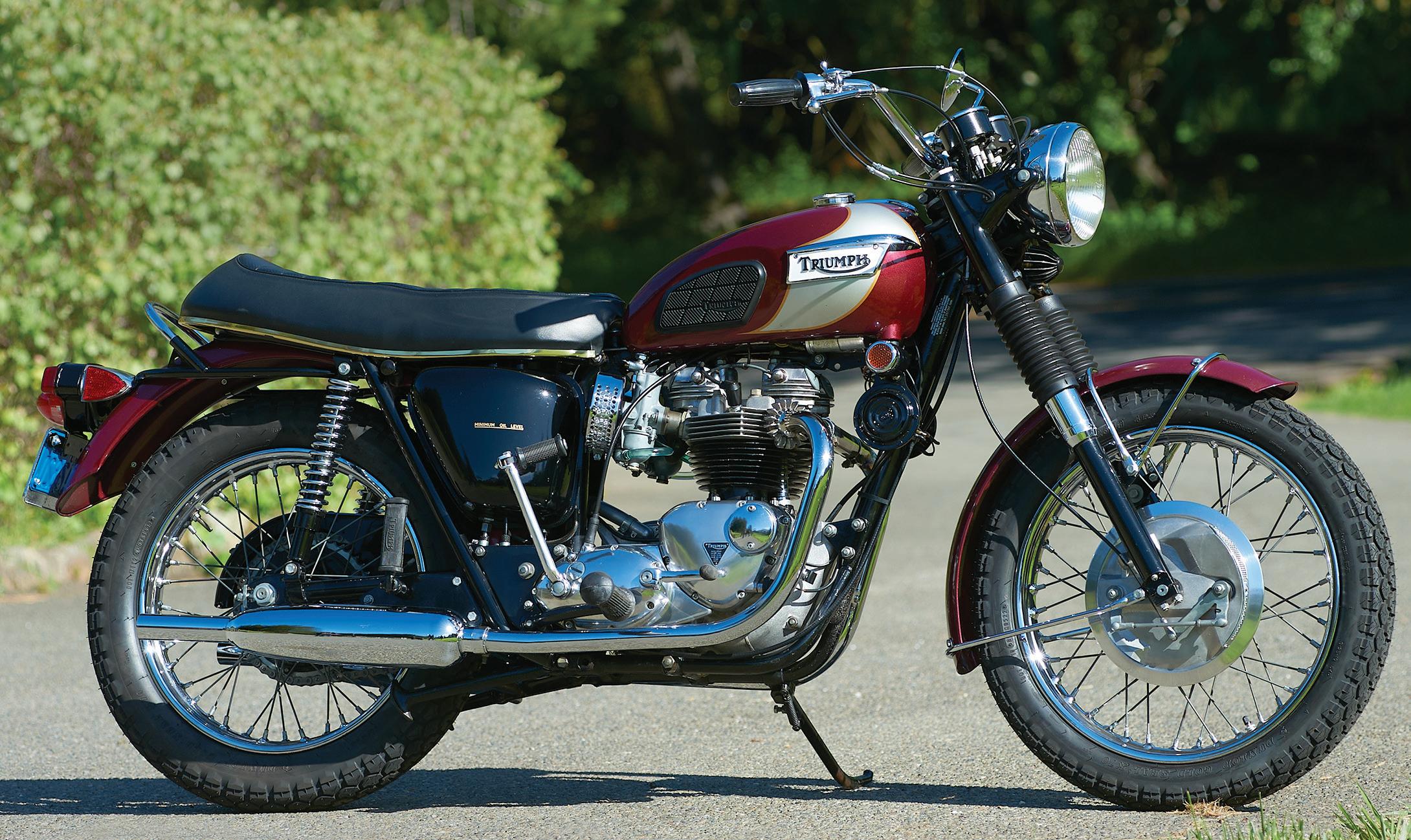
In 1970, if you were the typical Triumph fanatic eyeing the latest and greatest from the Meriden factory, you would probably have walked right past the TR6R featured here and gone for the Bonnevilles. The twin-carb setup was originally an accessory offering, but when the splayed port head kits sold out, Triumph decided to incorporate the new head in a new model. The first T120 Bonnevilles appeared in 1959 and quickly became wildly popular Stateside. The 1970 model
for the taillight. This TR6R has the original (and rare) taillight extension, increasing the value of the bike.
Scott and Dennis opened negotiations. The sketchy seller seemed uncertain if he even wanted to sell the bike at all. The conversation went back and forth for a while. Finally, Scott lost patience. “Look,” he said. “We have a ramp, tie-downs, a truck and CASH. And we are not coming back.”
At this point, Mr. Greasy realized that Girlfriend’s family would be furious if he botched the deal, took the cash and handed the bike and its pink slip over. Dennis and Scott loaded the Triumph as fast as possible, jumped in the truck and ran.
Bonneville was good for more ponies (46 horsepower vs. 43 horsepower) and more top speed (108mph vs. 103mph) than the single-carb machine, and those with a need for speed overlooked the extra maintenance. “When I was a kid,” says Dennis Etcheverry, “Everyone wanted a Bonneville.” Bonneville lust has not gone away with the years, and the market for a classic Bonnie in good shape continues to be strong.
Shortly after he acquired the Avocado,




Dennis’ friend Scott found this unrestored and very original 1970 Bonneville in Oregon. The prior owner had used the bike as a template for a restoration, then decided to sell both the unrestored and restored machines. Another friend wanted the restored bike, and Dennis ended up with the Bonneville.
Dennis has been taking the two bikes to shows, enjoying the reactions of admirers. “No one can believe that both bikes are unrestored! — Margie Siegal
www.MotorcycleClassics.com 19
“We have a ramp, tie-downs, a truck and CASH. And we are not coming back.”
The twin-carb version of the 1970 Triumph.
Even better news



A couple of days later, Girlfriend’s mother called. She ranted for a couple of minutes about how she disliked Sketchy Boyfriend, and stated she was happy that the Triumph had gone to someone who would care for it. The bike had belonged to her father, now passed, who kept the bike in his living room and waxed it when he had nothing else to do. As he got older, his eyesight got worse, which explains why the bike was covered with paste wax. Girlfriend’s mother had the complete service records and was happy to send them over.
Meanwhile, Dennis went over his new prize. It took two days to get all the wax off. The bike needed tires, fuel lines and a change of oil. Under the wax, the bike was perfect. The service records arrived, with the original bill of sale. Per
the sales records, in 1970, the cost to finance a motorcycle was 16-18%. (Think about that when you complain about financing charges!) The last service on the bike was 40 miles before it was parked.
“It’s a very simple bike,” says Dennis. “Once you get the drill down, you can start the TR6R on the first or second kick. It needs premium gas. You turn on the gas, free the clutch, give it half choke and kick. The carb does not go out of tune. Change the oil every thousand miles. Parts availability is better than it was 20 years ago — Bloor (owner of the modern Triumph factory) sold the tooling to the right people.”

“The Avocado gets ridden a little bit — I have a lot of bikes — but what I mostly do with it is take it to shows. It has won at a lot of shows. No one believes it is that original.” MC
A Book No Triumph Fan Should Be Without
The ultimate reference for Triumph lovers and fans of British motorcycles, The Complete Book of Classic and Modern Triumph Motorcycles, 1937-Today collects all of the motorcycles from this iconic brand in a single illustrated volume. In this revised and updated edition, you’ll find the all-new Bonneville lineup introduced for the 2016 model year and other Triumphs through 2019. Written by respected Triumph expert Ian Falloon, this luxurious reference covers all of the major and minor models, with an emphasis on the most exemplary, era-defining motorcycles, but also features important non-production models. Detailed technical specifications are offered alongside compelling photography, much of it sourced from Triumph’s archives. This title is available at store.MotorcycleClassics.com or by calling 800-880-7567.
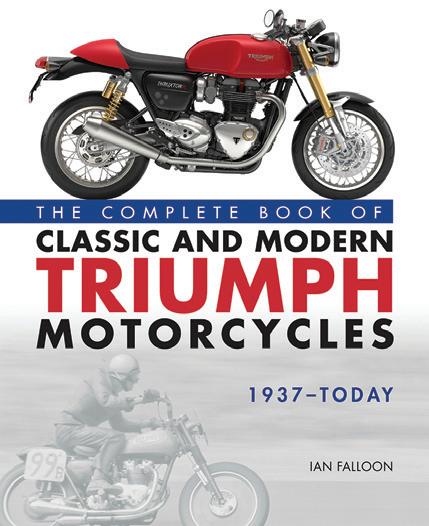
Mention promo code: MMCPANZ5. Item #10260.

20 MOTORCYCLE CLASSICS September/October 2023

BIRMINGHAM, AL | OCTOBER 6-8, 2023 18th ANNUAL BARBER VINTAGE FESTIVAL JOIN US FOR THE 100th YEAR CELEBRATION OF BMW MOTORRAD AND BMW MOTORRAD DAYS AMERICAS! • Barber Vintage Motorsports Museum • Swap Meet with 500+ vendors • Bike Shows • Demo Rides • Free Motorcycle Parking • AHRMA Vintage Motorcycle Racing, Flat Track Racing and Off-Road Trials BARBERMUSEUM.ORG | @BARBERMOTORPARK | 877.332.7804
READY TO RIDE


1975 Kawasaki S3A
Story by Greg Williams
Photos by Jeff Barger
RRiding to high school aboard his brother’s 1974 Kawasaki H1 500 triple ensured Steve Baugrud was one of the coolest kids in class. By the time he was in 10th grade, Steve had been riding since he was 5 or 6 years old and he’d already earned plenty of motorcycle memories. But the 2-stroke H1 he rode to school was the first real street machine he’d spent much time on, and he wouldn’t soon forget the experiences.
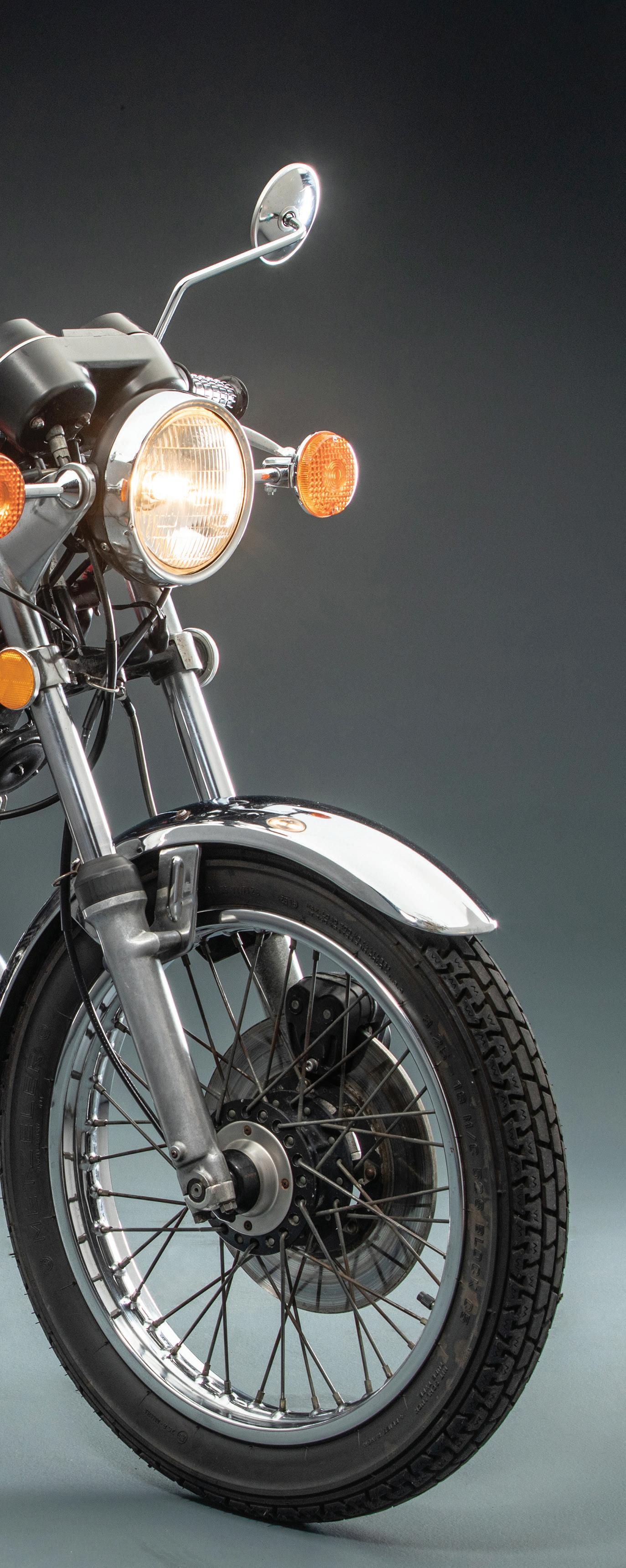
Decades after last riding the H1 to classes, in 2021 Steve was actively in the market for a Kawasaki triple he could call his own. So, when an ad without any photos appeared on Cycletrader.com for a reasonably priced 1974 Kawasaki KZ400, he didn’t initially think anything of it — as the KZ is a 4-stroke twin-cylinder model. Inquisitively, though, he clicked and read the listing.
He was glad he did. “It said something like the bike had low miles and was from an original owner,” Steve recalls. “And then, it said something to the effect that ‘this is a beautiful 3-cylinder bike.’ And I was thinking, wait a minute, is this really a KZ400 twin?” Apparently, a dealership in Pennsylvania had taken the Kawasaki in on trade and posted the ad, and Steve called them up. “I asked if it was a triple, and he said, ‘Oh yeah, it’s a triple.’ Long story short, he texted me photos, and it was definitely an S3 400cc triple.” With that visual confirmation and with the bike still reasonably priced, Steve sealed the deal, hired a shipper, and had the Kawasaki delivered to his home in Waukesha, Wisconsin.
While not the larger 500cc triple like his brother Jeff’s machine, the S3 400 is in some respects a better motorcycle. A January 1974 Cycle World test of the then-new S3 said, “In our mind, the 400 is Kawasaki’s best three-cylinder buy. It handles much better than the 750 — in fact there is no comparison. It’s more economical than the 500 by a wide margin and still has enough performance to get you excited in the mountains.”
Looking back
Kawasaki’s line of triple-cylinder machines can trace their history back to 1969 and the powerful 500cc H1 Mach III. At that time, the H1 became a best seller thanks to the fact it could hit 60mph in just 4 seconds and offered a blistering top speed of 120mph. Based on that success, Kawasaki followed up with more triple-cylinder machines in 1971 with the 750cc H2, 350cc S2 and 250cc S1.
By 1974, the 350cc S2 became the 400cc S3 when Kawasaki enlarged the engine by taking the bore from 53mm to 57mm. A pressed together crankshaft in horizontally split cases turns on six bearings. Connecting rods mate to the throws via roller bearings, while the piston gudgeon pins are in needle bearings. “Oil for lubricating the engine’s internals is supplied by a plunger-type pump whose delivery rate is controlled by the amount of throttle opening and the engine rpm,” the Cycle World test notes. “This oil under pressure from the pump is delivered through check valves into the cylinder intake ports
www.MotorcycleClassics.com 23
1975 KAWASAKI S3A

Engine: 400cc air-cooled 2-stroke triplecylinder, 57mm x 52.3mm bore x stroke, 6.5:1 compression ratio, 42hp @ 7,000rpm

Top speed: 97mph (period test)
Carburetion: Three 26mm Mikuni VM
Transmission: 5-speed, wet multi-disc clutch, chain final drive
Electrics: 12v, battery and coil ignition (stock); Accent solid-state electronic ignition (upgraded)
Frame/wheelbase: Mild steel double front downtube/53.7in (1,365mm)
Suspension: Telescopic front fork, swingarm rear
Brakes: 8.9in (226mm) single disc front, 7.1in (180.3mm) drum rear
Tires: 3.25 x 18in front, 3.50 x 18in rear
Weight (dry): 339lb (155kg)
Seat height: 31in (780.7mm)
Fuel capacity: 3.7gal (14ltr)
Price then/now: $935/$4,000-$11,000
where it mixes with the incoming fuel/air mixture to lubricate the connecting rods and piston pin bearings.”
Handling intake chores is a bank of three Mikuni VM 26mm carburetors. Given substantial amounts of throttle, Cycle World’s tester said there was a significant amount of “intake roar,” something they felt could be handled with “better baffling at the air cleaner intake.” Ensuring sparks arrive at the correct moment, the S3 400 Kawasaki uses battery and coil technology with three sets of ignition points. Straight cut gears, meanwhile, transfer power from the crank to the 5-speed transmission. Cycle World’s tester claimed the gears were closely spaced and allowed “the engine to be kept in its power band while accelerating or blasting down a curvy road.”
Rubber mounting debuts
Kawasaki chose to rubber mount the revised 400cc triplecylinder engine in the double cradle frame in an overall package that weighed 339 pounds dry. Prior to 1974, all Kawasaki triple powerplants were solidly mounted in the chassis, causing significant amounts of vibration. The rubber mounting arrangement in the new S3 virtually quelled the vibes. “At low rpm, as when sitting at a stop light, you can see the engine moving around a little,” the Cycle World story continues, “but practically no vibration is felt through the footpegs at any speed.” When riding down the highway, the tester explained, there was a slight “tingle” in the rubber mounted handlebars. The stock handgrips exacerbated the
tingle, they said, and that would have been an easy fix with a pair of aftermarket grips.
The front brake was a single disc while a drum followed at the rear. These were laced into 18-inch rims front and rear and the machine was suspended by a hydraulic front fork and twin rear shocks. A 3.7 gallon gas tank sits atop the well-triangulated frame and 1.6 quarts of injection oil is carried in a tank on the right side of the bike. Produced for just two years, the 1974 S3 and 1975 S3A, 400 triples became the KH400s in 1976 and lasted until 1977 in the United States.
Our feature S3A
Steve knew from looking at the pictures prior to buying his 400cc triple that the 3-into-3 exhaust pipes and mufflers weren’t in great condition, and the paint, in a lime green color, was incorrect. A side panel was missing, and rather uniquely, pinstriped across the top of the tail section was the sentiment “Happy 50th Dad.” As delivered to Steve, though, the 400 appeared to be an honest low-milage machine; one that he could simply clean up and ride. He performed a compression

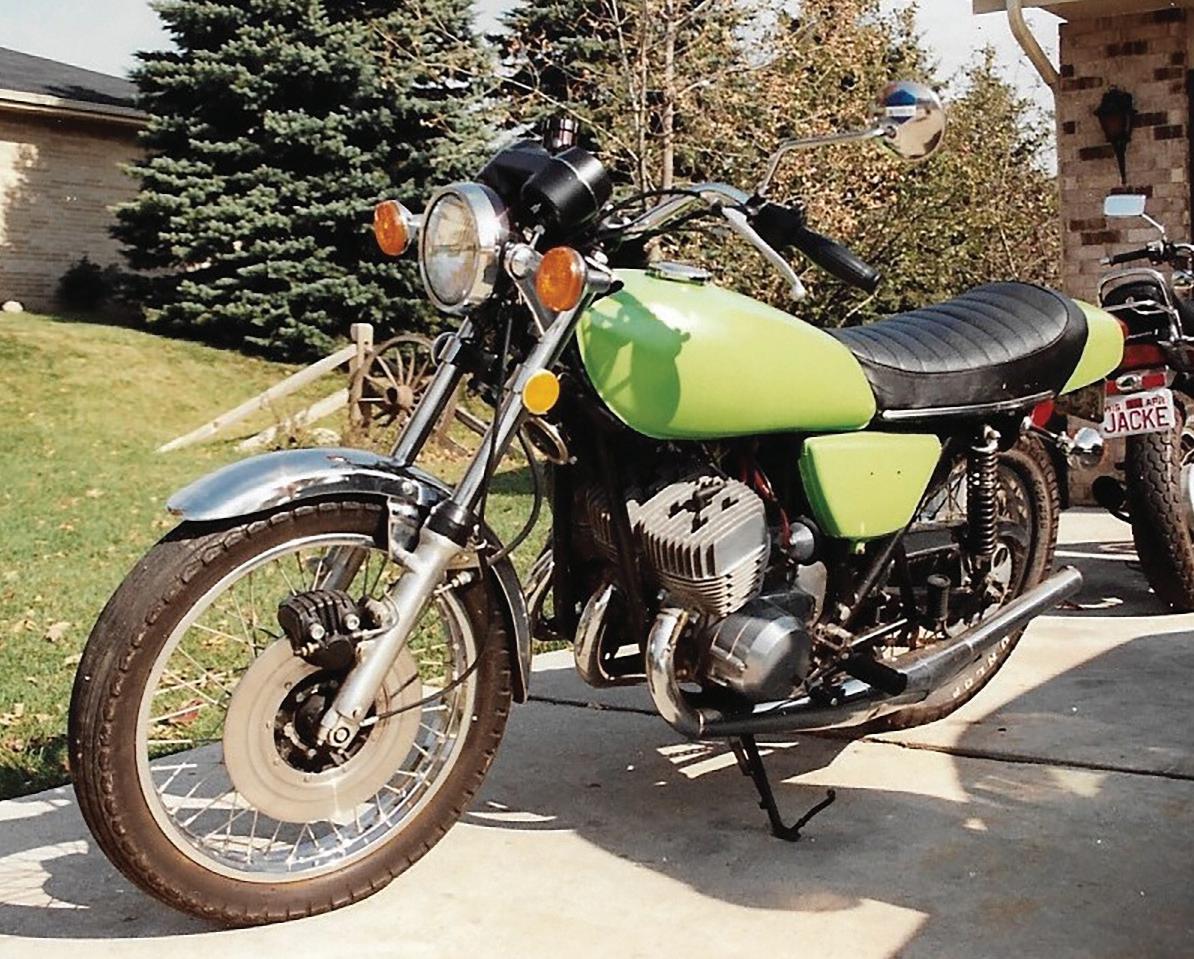
test, went through all of the systems, got the Kawasaki running, and rode it the summer of 2021.
“I got a reproduction side panel and my painter did a 98-percent job matching the green paint,” Steve says. “I had a running bike that looked decent, but at the back of my mind, the pipes didn’t look great and it wasn’t the right color.”
Another thing he learned was the Kawasaki was incorrectly identified on the title by the Pennsylvania DMV as a 1974 S3. His research showed it was in fact a 1975 S3A, and Steve petitioned the Wisconsin DMV to change it. He says, “I had to fight with them about that and they required all sorts of documents and a letter from Kawasaki USA.” He won, however, and the machine is now correctly titled as a 1975 Kawasaki S3A.
Also noteworthy is that the engine and frame numbers match, which isn’t very common on Kawasaki triples. “Rick Brett [Kawasaki triples guru] has a registry of triples from around the world, and he says that’s a one in one thousand chance that the engine and frame numbers will match — and mine do,” Steve explains.
www.MotorcycleClassics.com 25
Circa 1987, Steve rode his brother’s Kawasaki H1 to high school.
Recapturing some of his youth, Steve found and sympathetically restored a more rider-friendly 1975 Kawasaki S3A triple.



Movin’ on up
To take his S3A to the next level, Steve spent the late winter of 2021 and early 2022 sourcing parts. He located two NOS exhaust pipes, and a third one in really good condition that he had re-chromed. Instead of working with the gas tank — which had a scratch and a tiny dent — sidecover and rear tail section of the Kawasaki, Steve removed them, sold them, and acquired a tank and tail section that were in better shape. The side covers are reproduction, and Steve notes, “purists might not agree, but I think the reproductions are probably a little more durable. I’ve had so many old side panels with broken mounting tabs.”
Shiny bits
Of the paint, Steve says, “I think it had been painted a later model Kawasaki green. It definitely wasn’t the stock color.
In 1975, the stock colors were Candy Green and Candy Super Red. I liked the red the best and went with that.” Working with painter Nicholas Brouillard at HeavenlyCustoms in West Allis, Wisconsin, the replacement tank, tail section and aftermarket side covers were sprayed the correct Candy Super Red. Nicholas also laid down a decal set that Steve ordered from Rick Brett.
During this time, Steve stripped the Kawasaki completely down. He needed to repair a bracket on the right side of the frame that carries the mount for the footpeg. “Notoriously, on the 400s, those would bend and mine was bent in at about a 30-degree angle,” Steve says. With the engine out, Steve cleaned and touched up a few areas of the frame with black paint, but for the most part, the chassis still wears its original finish.
While the forks were off, Steve cleaned and serviced the components and rebuilt the sliders with new seals. The front
26 MOTORCYCLE CLASSICS September/October 2023











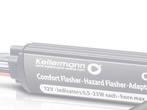


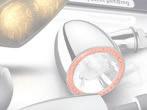




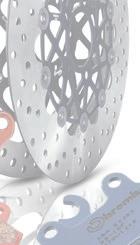

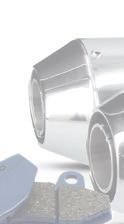
















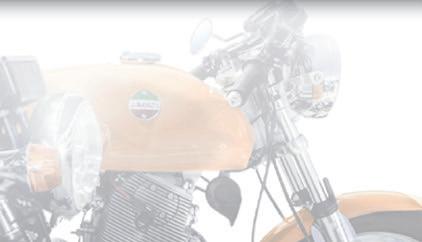

















































Your source for Excel, Borrani and Sun Rims Azusa, CA Your contact: Silas Uhlmannsiek Stein-Dinse GmbH • Waller See 11 • 38179 Schwuelper, Germany + 49 (0)5 31 12 33 00 - 0 info@stein-dinse.com www.stein-dinse.com ORIGINAL SPARE PARTS... ... AND A HUGE RANGE OF ACCESSORIES! 608-862-2300 • info@mgcycle.com Our local partner: Fuel in the blood . Italy in your heart. DUCATI
fender was a 9 out of 10, Steve says, but it had some road rash at the front corner. He found a NOS replacement, and it was in near perfect condition. At the back of the machine, new shocks were added. The engine was never taken apart, as the compression was within spec and it had not been losing or burning any crankcase oil.
“The other thing about this bike is I wanted to ride it,” Steve says of his resurrection effort. “I wasn’t after a concours restoration, I just wanted to make it look as stock as possible and make it so it could be ridden reliably.” To that end, Steve updated all of the electronics, replacing the regulator and rectifier. He dispensed with the mechanical points and installed an Accent solid state electronic ignition system. Also replaced were the coils, plugs, high tension leads and caps. On the intake side of the equation, the carburetors were stripped, cleaned and fully serviced.
As far as Steve can tell, the seat is original Kawasaki vinyl and foam on the pan. When he bought it, the S3A showed just over 4,000 miles on the odometer and he believes that it is likely genuine. After his restoration, the Kawasaki now shows more than 4,800 miles.

It’s a fairly simple machine to bring to life. “Just flick the gas on, click half choke, and one or two kicks and it fires right up,” Steve says of the kickstart-only Kawasaki. “It’s got a thumb choke lever, and I’ll usually hold it at half for 20 seconds, let the choke out and let it warm up a minute longer and then go. With all of the new electronics it fires up and runs really well.”




He continues, “The ride is great, and it’s really quick. It’s super smooth, goes through all the gears well and it handles nicely and pulls well. It likes to rev, and it really wakes up at mid to upper throttle, pulling strongly from 5,000rpm to 9,000rpm.”
Taking Steve’s triple-cylinder Kawasaki story full circle, his brother Jeff still owns the H1 500, and Steve got to ride the bike he rode to high school again last summer. “It’s still a little bit scarier to ride, mostly in terms of handling. The 400 seems more refined and it’s a very nice triple to own. I’ll get out for short rides during the week, or slightly longer rides on the weekend,” he says, and concludes, “It’s great fun, and makes me feel like I’m back riding to high school again, just without any lectures or exams.” MC
How To Rebuild and Restore Classic Japanese Motorcycles
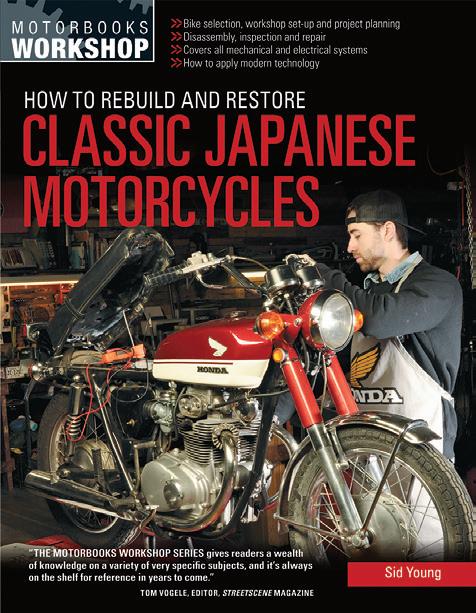
Everything you need to know to restore or customize your classic Japanese motorcycle. Whether you want to correctly restore a classic Japanese motorcycle or create a modified, custom build, you need the correct information about performing the mechanical and cosmetic tasks required to get an old, frequently neglected, and often long-unridden machine back in working order. How to Rebuild and Restore Classic Japanese Motorcycles is your complete, hands-on manual, covering all the mechanical subsystems that make up a motorcycle. From finding a bike to planning your project to dealing with each mechanical system, How to Rebuild and Restore Classic Japanese Motorcycles includes everything you need to know to get your classic back on the road. Japanese motorcycles have been the best-selling bikes globally since the mid-1960s, driven by the “big four,” Honda, Yamaha, Suzuki and Kawasaki. This is the perfect book for anyone interested in classic Japanese motorcycles and prepping a bike to build a café racer, street tracker or other custom build. This title is available at store.MotorcycleClassics.com or by calling 800-880-7567. Item #10936.

28 MOTORCYCLE CLASSICS September/October 2023
the history of one of the oldest motorcycle clubs in America



Get an inside look at the real beginning of outlaw biker culture with this “raucous and heartfelt recounting of the early days of biker clubs” (Roadbike). The story starts one weekend in 1947 at a motorcycle race in Hollister, California. A few members of one club, the no-holds-barred ‘Boozefighters,’ got a little juiced up and took their racing to the street. Word of the fracas spread, and soon enough, Life magazine was on hand to tell the world with sensational (albeit posed) pictures of the outlaws. And then the ‘Hollister riot’ made its way into the movies, immortalized in Marlon Brando’s “The Wild One.”
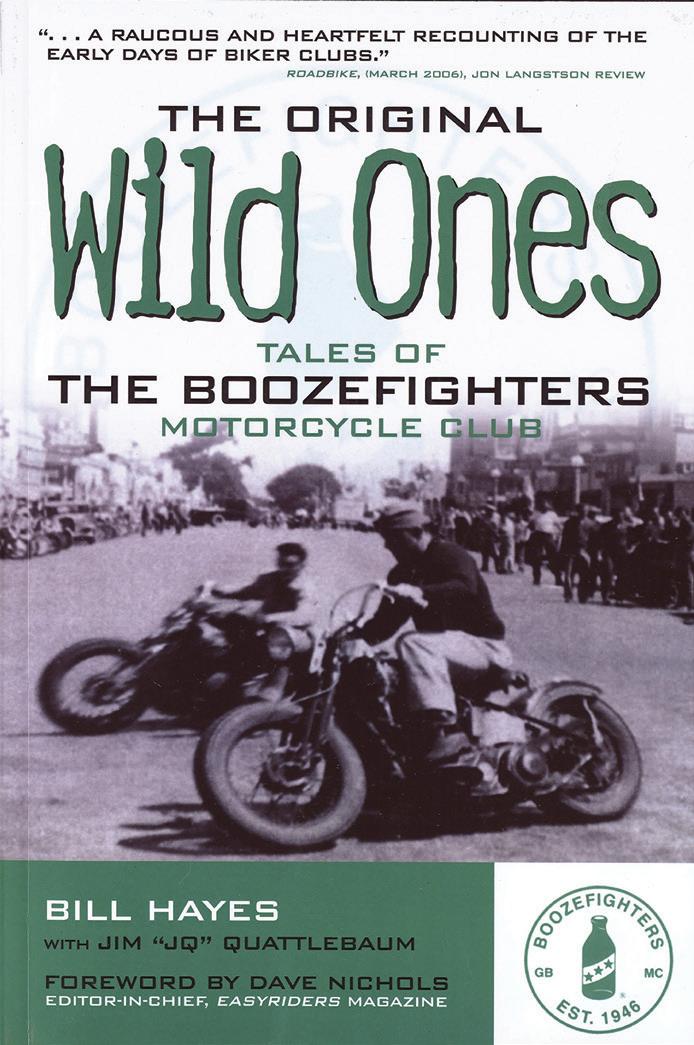
What was the reality behind the myth? Through interviews with the surviving members of the Boozefighters, current member Bill Hayes and club historian Jim “JQ” Quattlebaum take readers right into the fray for a firsthand account of what happened in Hollister and the formation of the Boozefighters, where the outlaw biker culture truly began.



Call 800-880-7567, or visit Store.MotorcycleClassics.com to order!

Item #11839





$24.99
Members: $22.99


Mention promo code MMCPANZ2.
FC TheWildOne 1/2Horizontal.indd 1 7/11/23 2:04 PM
See what we have to o er at heidenautires.com
Quality tires, made in Germany
THE 2023 MOTOGIRO D’ITALIA
Roaming Tuscan Roads on Classic Motorcycles
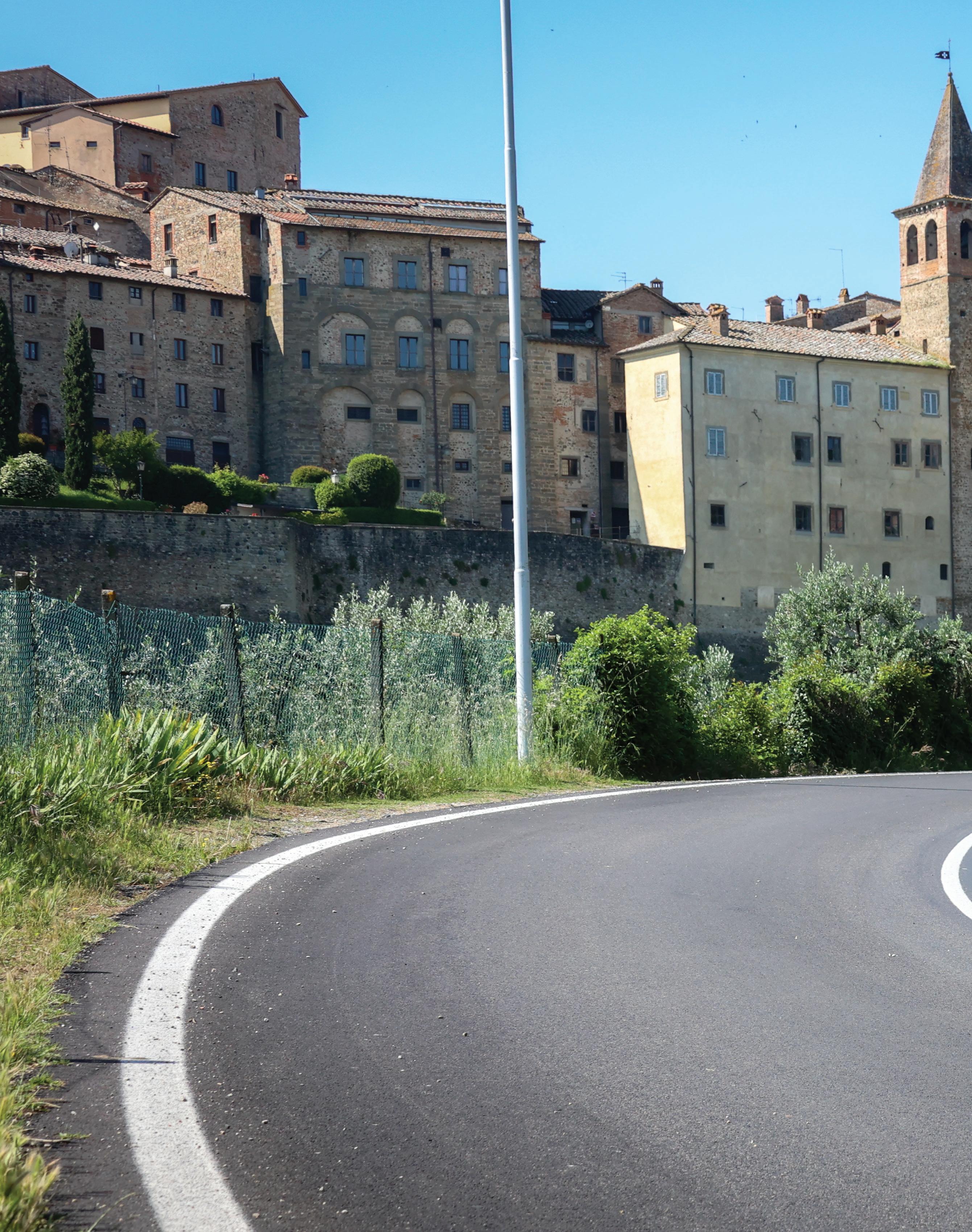
The Motogiro was a prestigious event and competition was fierce with all the major Italian manufacturers competing in classes ranging from 75cc-175cc. In the final 1957 edition, the various classes were won by riders on bikes made by Benelli, Ducati, Laverda and MV Agusta.
Friends who have experienced it raved about the incredible time they had. Riding around Italy for a week on classic motorcycles sounded like pure bliss. However, obstacles like the logistics of traveling from the U.S. and finding a suitable ride kept my dream on the back burner.


But then, towards the end of summer 2022, my good friend Mateo (despite not being Italian) made me an offer I couldn’t refuse. He had purchased a charming home in Montefegatesi, a small ancient town near Pisa, and generously offered me a place to stay and use of a classic bike if I registered for the Motogiro and flew to Italy. It was as if the stars had finally aligned, and I started planning my long-awaited adventure.
Origins of the Motogiro d’Italia
The original Motogiro d’Italia road race ran from 1914 until 1957. The peak years were 1953-1957 when the event started and finished in Bologna with races averaging 3,000km over six days. The Motogiro was the first big event on the annual calendar for Italian road racing. It was held in March/April followed by the Mille Miglia in May and, finally, the Milan-Taranto race in July.
As a result of a tragic accident in that year’s Mille Miglia when a Ferrari went off the road killing the driver, navigator and ten spectators, the Italian government outlawed all racing on public roads and the Motogiro went dormant for over thirty years.
Resurrection of the (Modern) Motogiro d’Italia
In 1989, a local motorcycling organization, Moto Club Terni, relaunched the Motogiro d’Italia with sanctioning from the Fédération Internationale de Motocyclisme (FIM) and the Federazione Motociclistica Italiana (IMF).
It was initially run as a historical re-enactment with entries restricted to bikes made no later than 1957 and no larger than 175cc, but the current version of the event has categories to accommodate all bikes. There’s a wide variety of bike classifications allowing for entry of pretty much any motorcycle. This year’s groups were: “Heritage” bikes made from 1914-1949, “Historical Re-enactment” bikes of 75, 100, 125 and 175cc, “Vintage” bikes made from 1967-1969, “Classic” bikes made from 1970-1980, “Motogiro” bikes made from 1980, Scooter, and Tourist (any year, any make — not timed).
30 MOTORCYCLE CLASSICS September/October 2023
TThe Motogiro d’Italia, a legendary event, has been a decades-long dream for me.
Story and photos by Corey Levenson
Just another day tooling around Tuscany on a classic BMW.
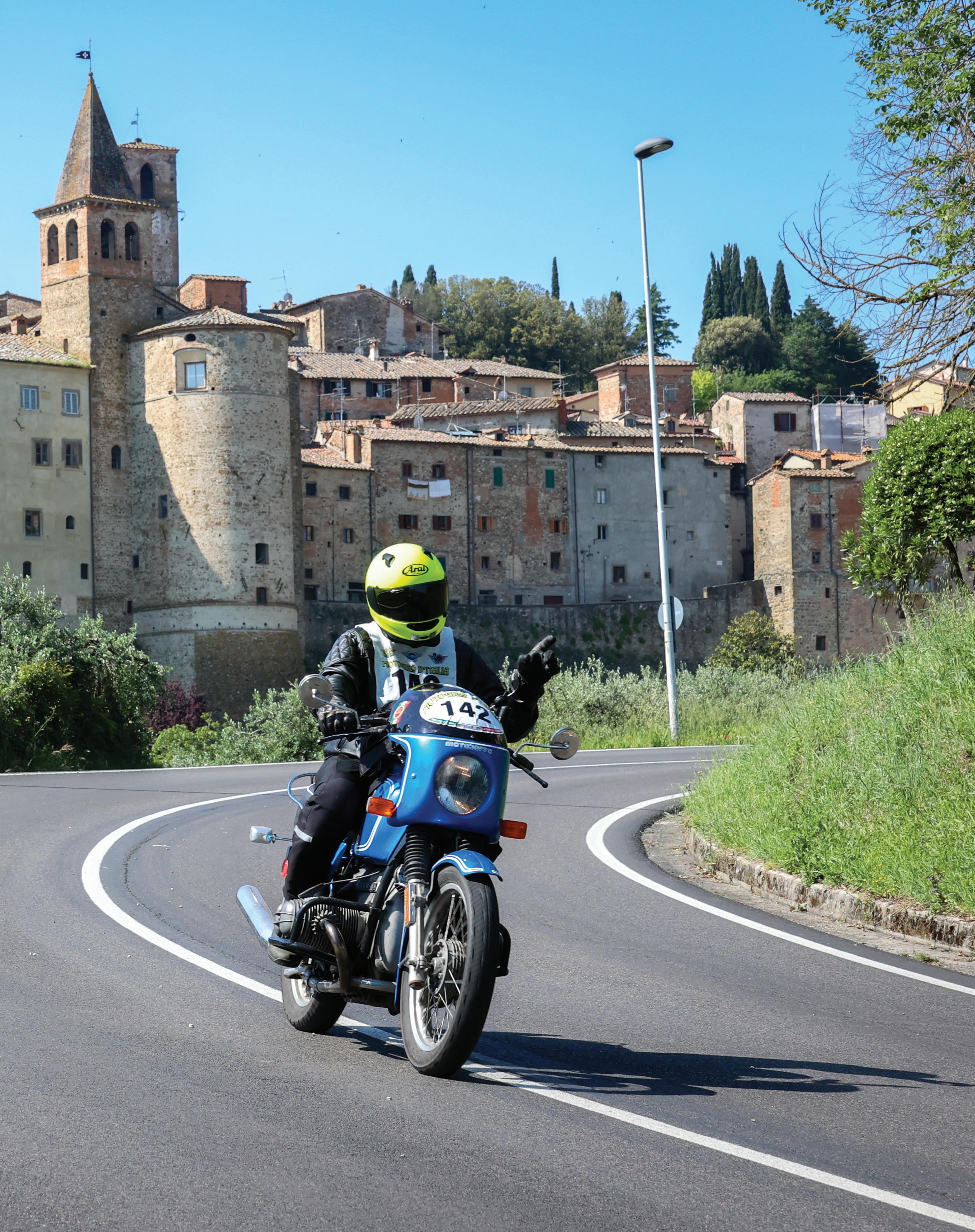
COPYRIGHT 2023DOMENICO VALLORINI
Is it a Race or a Ride?
Although the original Motogiro was a full-on race, the modern version can be ridden in one of two ways: as a timed competitor, where punctuality is more important than speed, or as a tourist in which case there’s no need to watch the clock — you just enjoy the ride.

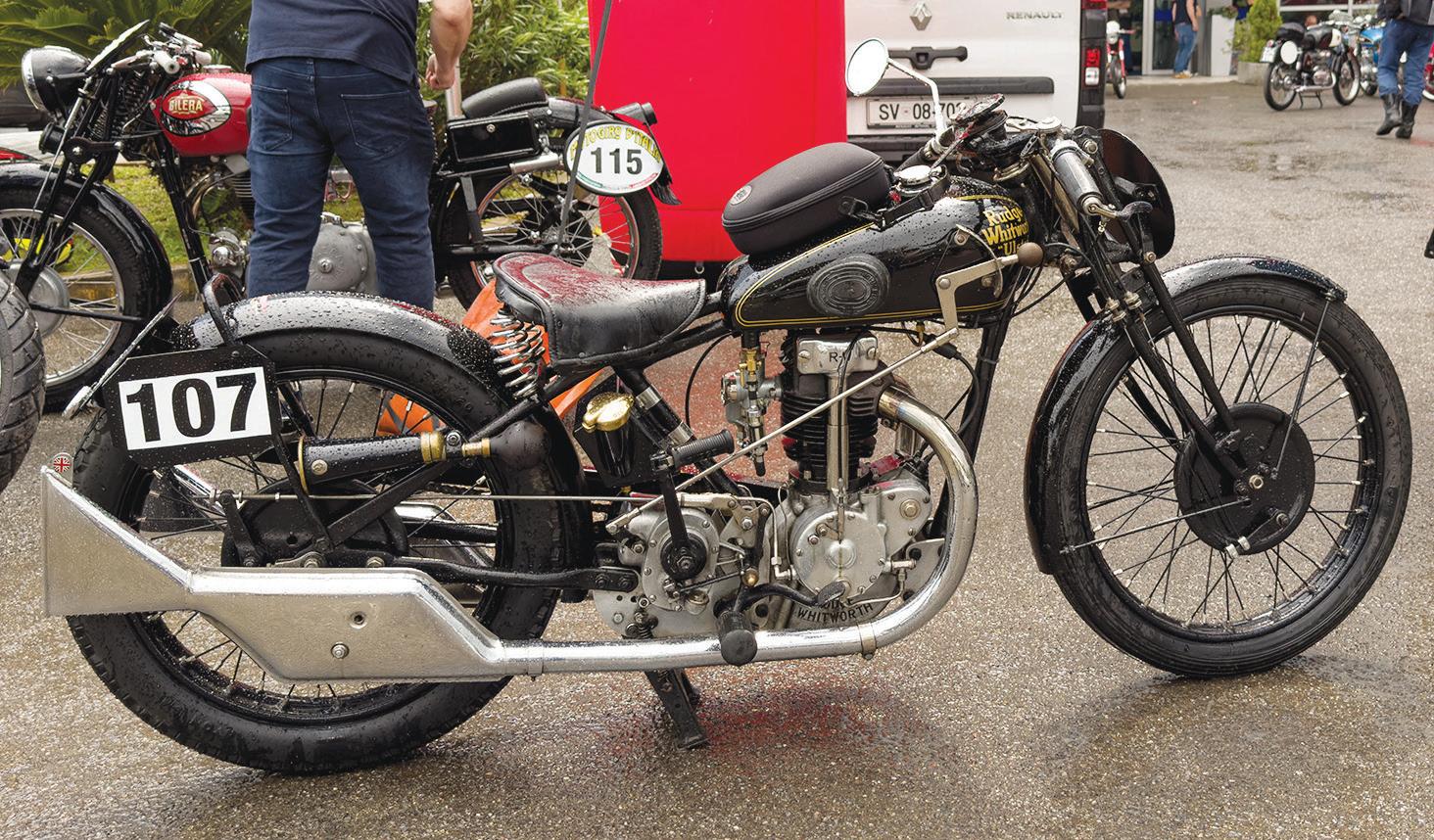
If ridden as a competition, it’s a regularity rally with a few low-speed agility tests thrown in. Each rider is issued a timecard every morning with their race number on it. The goal is to start the ride at your designated time, arrive at all the control checkpoints at specific times, and finish at your designated time. At the end of the day, you hand in your card with all the time stamps. The standings are tallied each night and the leaders in each category are announced. Typically, the Italian riders go home with all the awards. They know the roads and they are damn fine riders. Their advice to us newbies was: “No brake!” And it’s true: I followed a few of them through the twisties and rarely saw a brake light come on.
The Course
The route changes each year. Last year it was in southern Italy, this year was Tuscany, and next year’s route will be announced this Fall — it’s rumored that it will be at the end of May 2024, and might be in the Northwest. For updates, keep an eye on the event’s website: motogiroitalia.it
Navigating the route depended on spotting what seemed like a thousand red arrows on yellow cards zip tied to posts along the roadside and at the entrance to each of the dozens of roundabouts we went through. If I arrived at
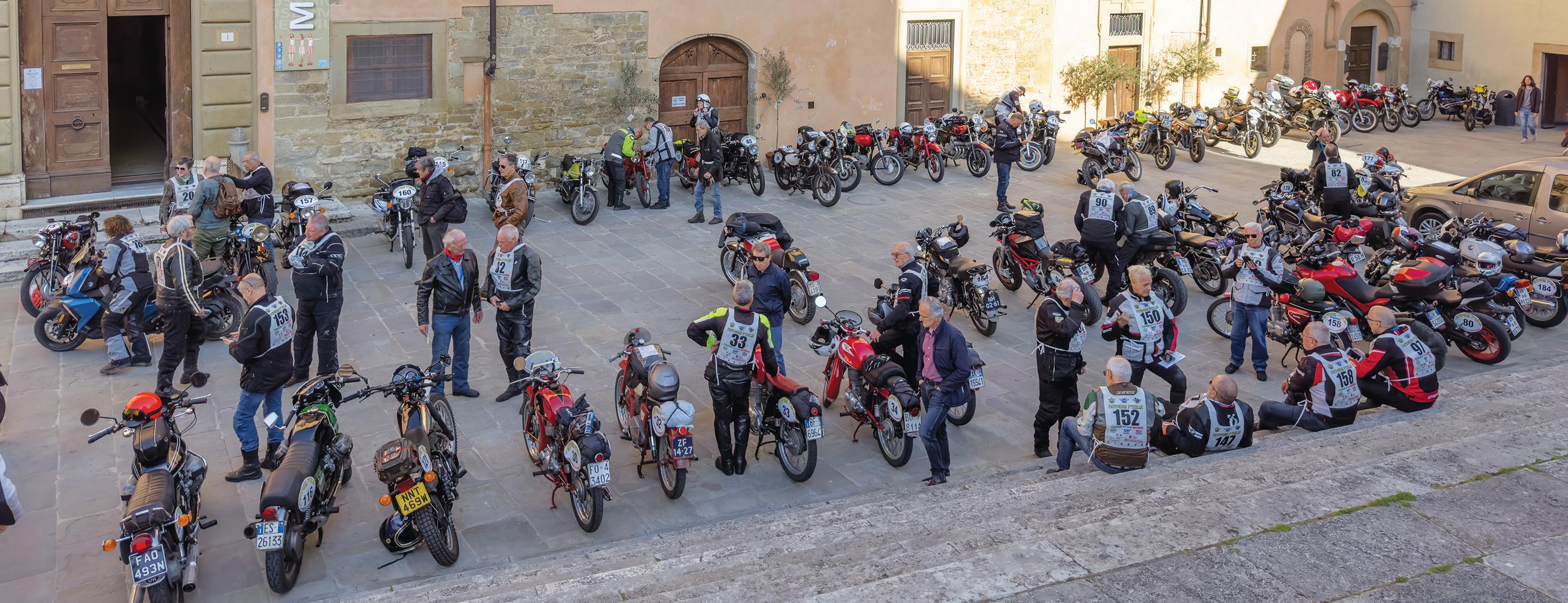
32 MOTORCYCLE CLASSICS September/October 2023
A 1955 Moto Guzzi Airone 250 waiting to be inspected before the ride.
1929 Rudge Ulster with hand shift and Brooklands silencer — a rare sight!
Getting ready to start the ride in the shadow of the cathedral.
a roundabout and there was no arrow, it meant I’d missed a turn and had to backtrack.
We had an escort of a half dozen carabinieris on Ducatis and Yamahas. They were awesomely skillful riders and, between their presence and our numbered race bibs, we were somewhat immune to many of the traffic laws. Obviously, no one did anything downright dangerous, but things that are normally illegal like lane-splitting, passing in no-passing zones and treating the KPH speed limits as MPH limits were shrugged off. Mechanics swept the course, so it was important to stay on the planned route or they wouldn’t find you if you broke down.
This year’s course went through almost 1,000 miles of Tuscany. We started and finished in Pisa and spent six days riding, spending nights in Arezzo, Chiancano Terme and San Vincenzo along the way.

Sunday, May 21, was the first official day of the event and was spent scrutineering the bikes, applying numbers, picking
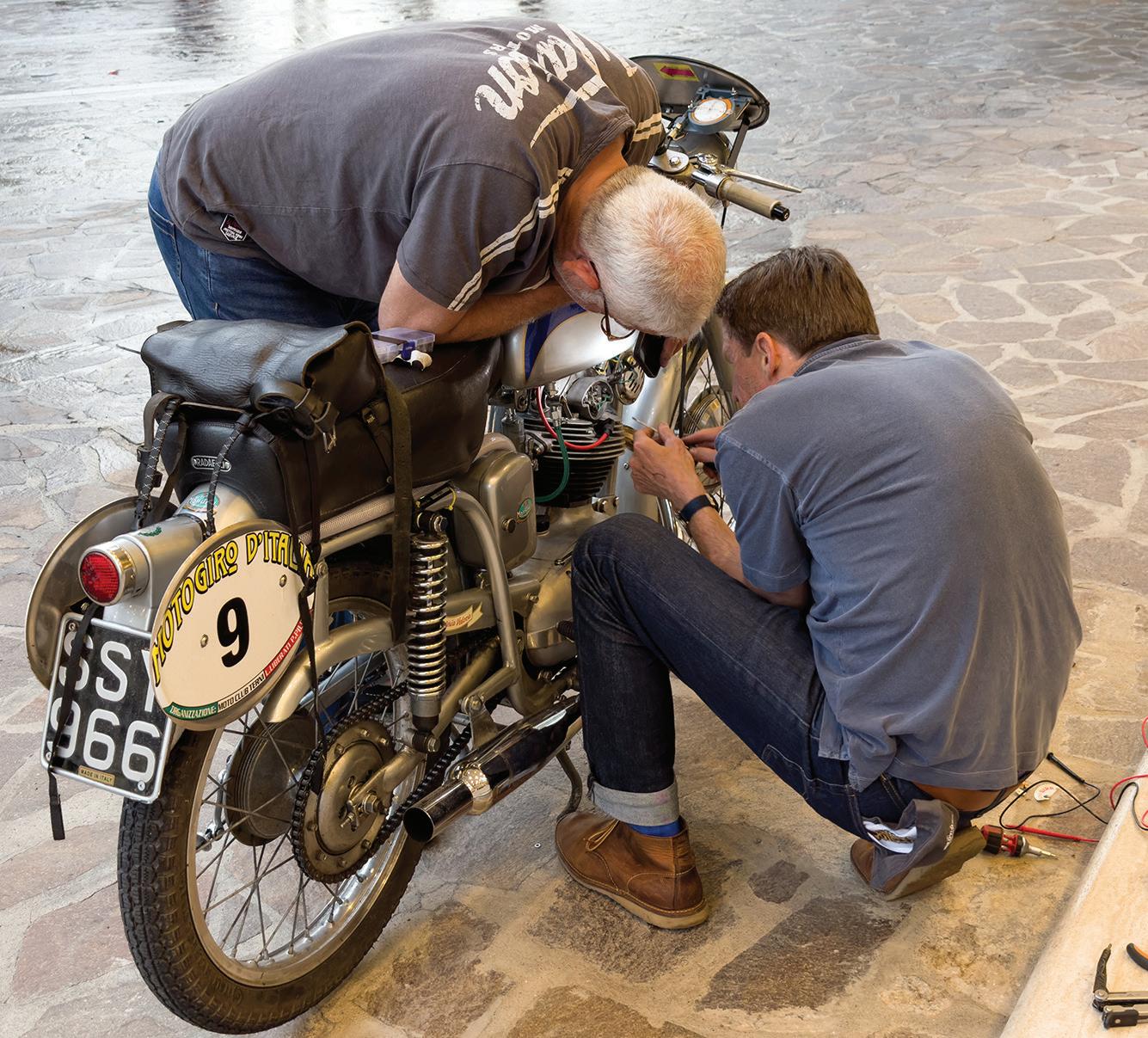

up credentials/schwag and attending a riders meeting. The riding started at 9 a.m. on May 22 with the first Stage going from Pisa to Arezzo (145 miles). Tuesday was a 143-mile loop starting and finishing in Arezzo. Stage Three took us from Arezzo to Chianciano Terme (139 miles) with a loop starting and finishing in Chianciano on Stage Four (170 miles).
On the Fifth Stage we rode to San Vincenzo on the coast (166 miles) and stayed at a hotel on the beach that night. You could see the islands of Elba and Corsica from the shore. The final day of riding, on Saturday, May 27, we rode back to Pisa the long way via Mateo’s tiny town of Montefegatesi (184 miles).
The finish, at the foot of the Leaning Tower of Pisa, was accompanied by lots of hugging and congratulations. With any experience where the levels of risk and reward are elevated, there’s a feeling when it ends of both sadness that it’s over and fulfillment that the venture was successfully completed. The closing event was a nice final gala dinner at the hotel that night.
www.MotorcycleClassics.com 33
Left: The dachshund riding pillion on this 1931 Gilera 150 was extremely brave! Right: A 1955 Mondial Turismo Veloce having its points checked.
The rest stop at the Piaggio museum featured scooters as well as rare Gileras and Moto Guzzis.
A Rolling Museum
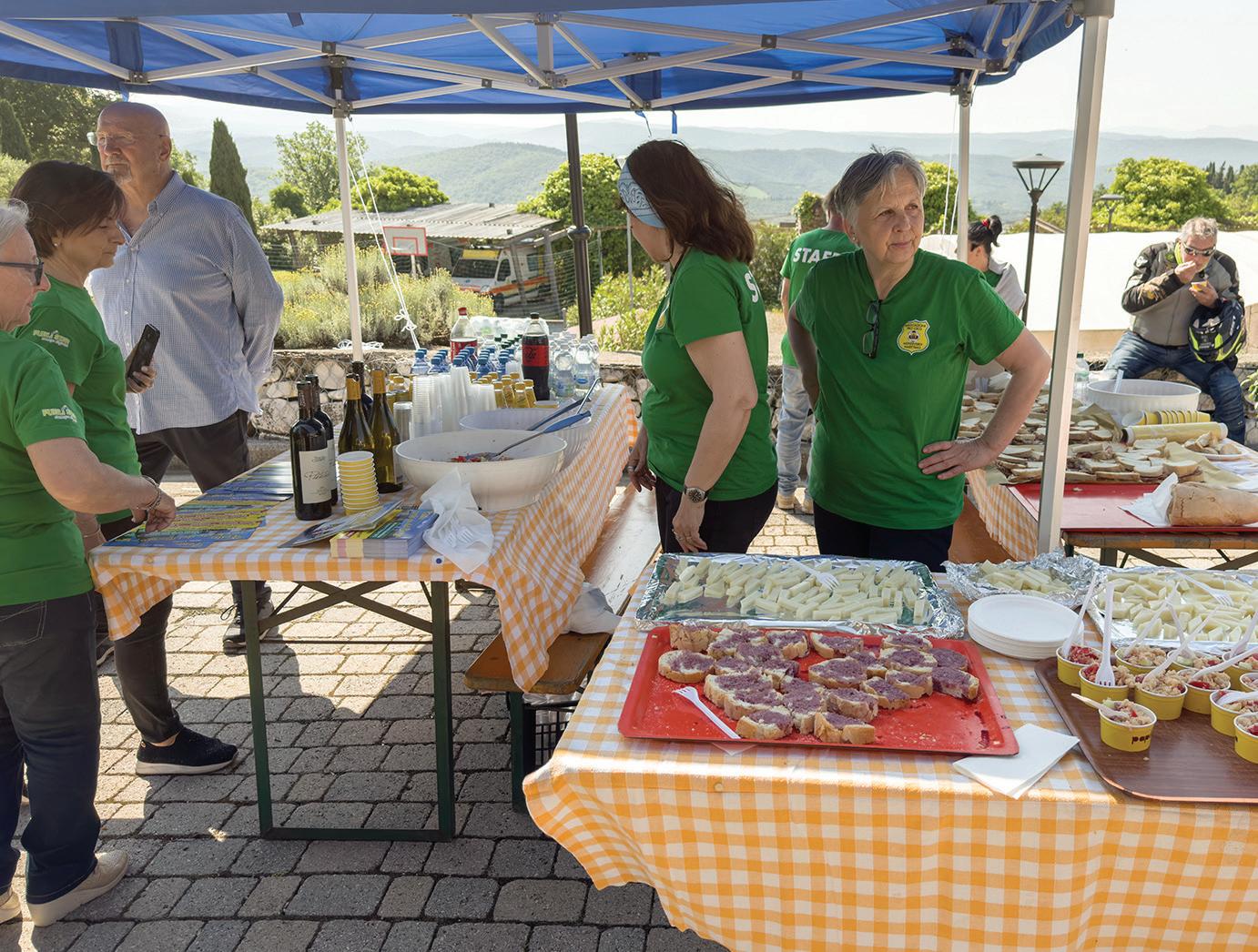
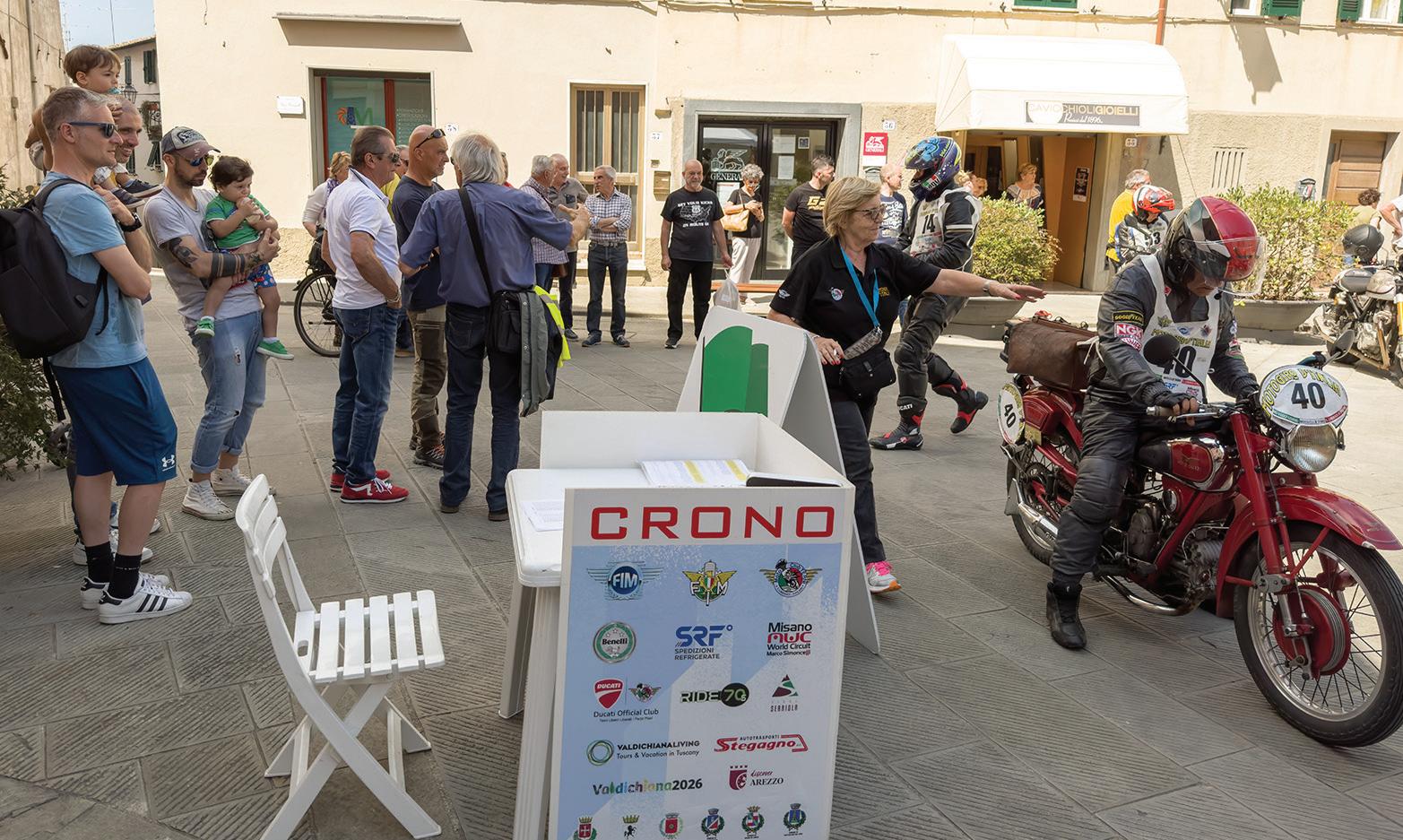
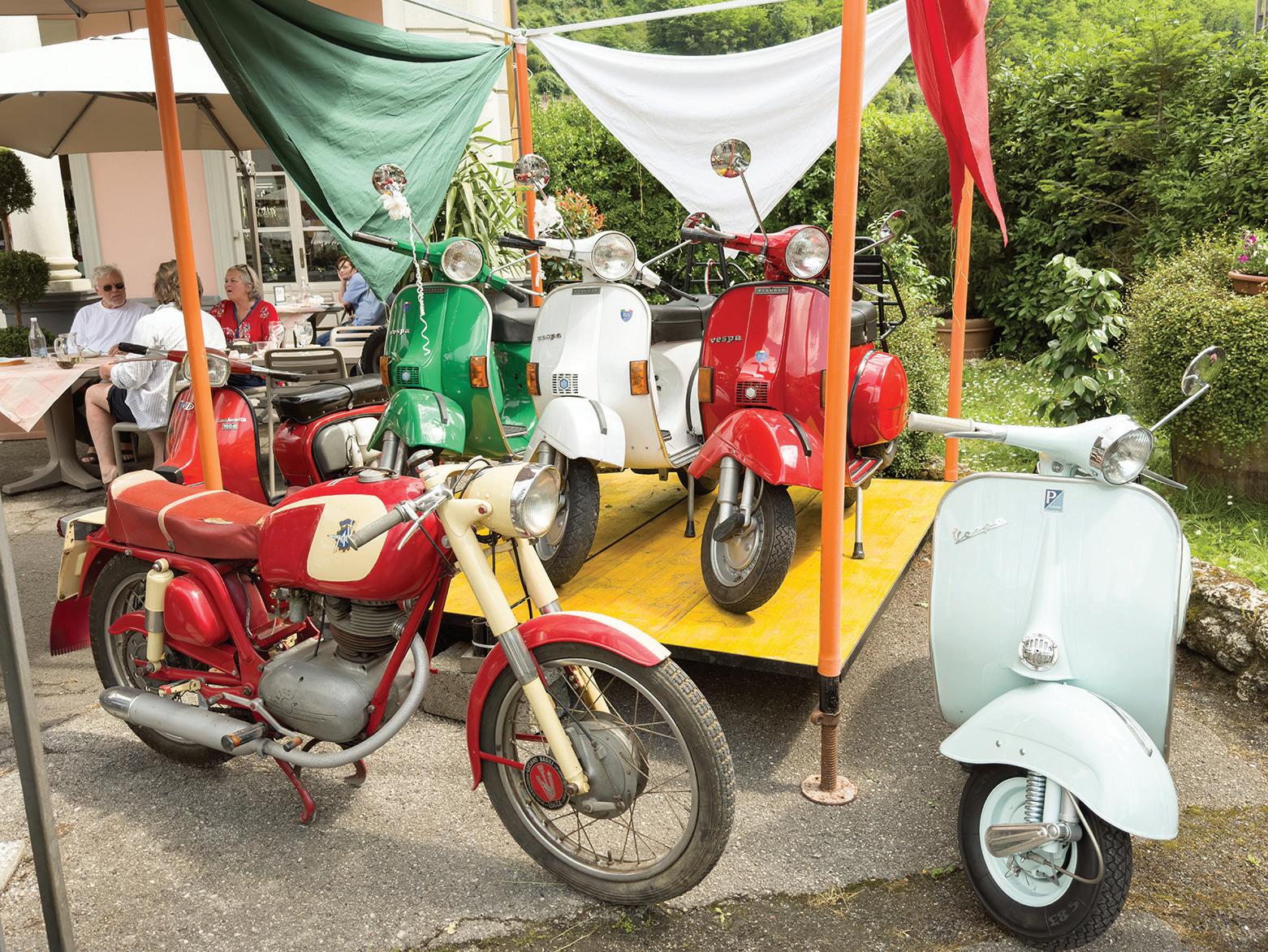
There was an incredible mix of mostly classic and vintage machines on the ride. Everything from Rudges, Nortons and Vincents to Motobis, Benellis, MV Agustas, Moto Guzzis, Ducatis and Mondials. It was pretty cool to be riding in the middle of bunch of such loud, smokey and beautiful machines. In addition to the historic and classic machines, there were a handful of modern Ducatis, Husqvarnas, Benellis and others. There were several two-up teams in the tourist as well as timed classes. In addition, a modern Norton 961 was pulling a sidecar and passenger.

You can ship your own bike from the U.S. or, if you live in Europe, you can transport (or ride) your bike from wherever you live. One chap from the U.K. rode his ‘69 Triumph Bonneville all the way from England, did the rally, and then rode back home. Another popular option is to rent something. An outfit called Ride 70s (ride70s.com) supplied a few machines to people on the ride. You can also rent


34 MOTORCYCLE CLASSICS September/October 2023
Left: A patriotic tricolor scooter rest stop display put on by one of the local clubs. Right: Look closely and you can see one of the thousands of arrows we followed all week.
Left: One of the time controls at a rest stop — don’t be early and don’t be late! Right: A typical rest stop spread complete with local bread, cheese, pasta and wine.
COPYRIGHT
-
Left: Narrow, steep cobblestone streets were common in the old towns. Right: A lovely mountain road in the Tuscan hills.
2023
DOMENICO VALLORINI
something new like a Vespa or a modern Ducati.
The Riders

The Motogiro draws an international crowd. About a third of riders were Italian, a quarter were from the U.K., 12% were from Germany and 10% from the U.S. The rest are Dutch, Spanish, Swedish, Norwegian, Australian, Polish, Belgian and Swiss.



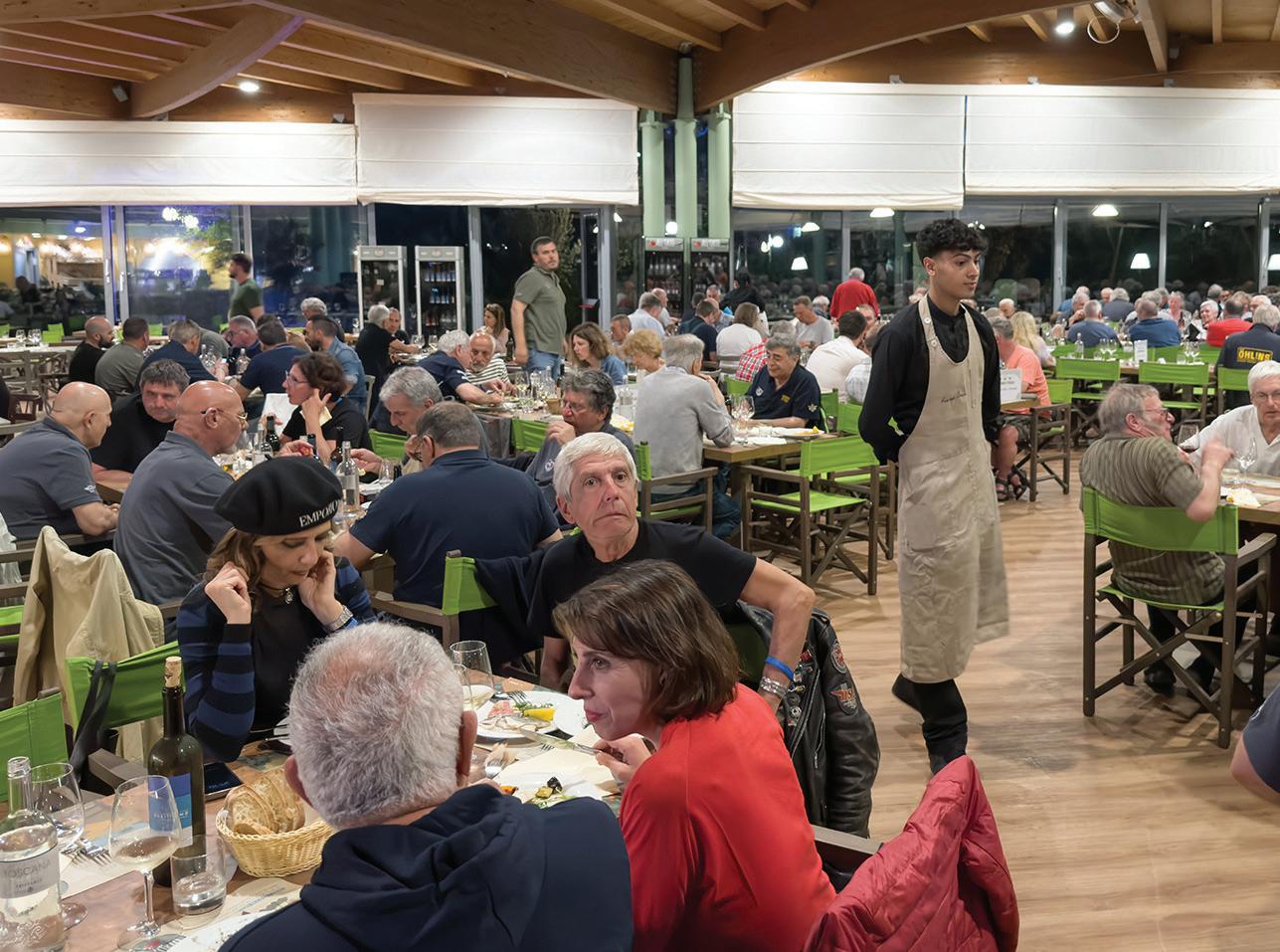
Many of the riders had been doing the Motogiro for years, including one Italian fellow who hadn’t missed one in 30 years. There were also many folks for whom, like me, this was their first Motogiro. Out of the 190 or so riders, I’d estimate that a dozen were women. As in the classic motorcycling world in general, I’d guess the average rider was a 65-year-old guy.
My Motogiro
Mateo is a member of an eclectic group known as the “Lucky Bastards.” They’re a bunch of about a dozen rabid motorcycle enthusiasts spread around the world (mostly the U.S.) who get together for social events like the Motogiro. Most of them were present at this year’s Motogiro. I spent a lot of time hanging out with them and learning the ropes. Most of them own bikes which they keep in Italy for such occasions. Mateo arranged for me to ride a low-mileage blue 1974 BMW R90/6 that belonged to a fellow Lucky Bastard who couldn’t participate this year.
My relationship with the Beemer was like an arranged marriage. She and I had never seen each other before the first day of riding but, over the course of a few days, Brunhilda let me know how she liked me to shift gears, and I learned what to expect in response to throttle inputs and squeezing the brakes. We got along fine. I made sure her oil level stayed topped up and she got me through some sketchy situations and provided a confidenceinspiring ride.
The Motogiro Demands Respect
This is not a ride for novices. The Motogiro website describes it as “most beautiful and treacherous.” Believe it. Very little of
www.MotorcycleClassics.com 35
Left: One of the group dinners. The food was outstanding! Right: A couple of the British riders at the stage finish in San Vincenzo on the coast.
Tony’s been a Lambretta man since the days of Mods and Rockers.
Left: Checking the class standings each evening. Right: Cheering school kids greeted us as we rode through their town. It really made you feel like a hero!
Tuscany is flat — most of the time we were either ascending or descending the sides of steep hills, negotiating thousands of blind hairpins connected by short sections of straight-ish road with limited line of sight. There was a lot of shifting, braking and accelerating on roads with very few center lines and no guard rails.

The road surfaces could be shady, sunny, wet or dry and varied from billiard table-smooth to broken and potholed to unpaved.
As lovely and distracting as the scenery was, the roads demanded near total focus. We encountered sun, rain and even a little hail during the week.
The Motogiro is an endurance event that tests both riders and motorcycles. Of the 200 riders who registered this year, 189 showed up for the event and 144 finished. Mechanical problems were not uncommon and, unfortunately, several folks left the ride in ambulances.

Thinking About Doing It?
The registration cost depends on the exchange rate (Dollars to Euros) and whether you ride as a tourist or in a timed class but figure $1,600-$1,800. A single room will cost an extra $250 or so. The fee includes hotels every night, breakfasts, a group dinner each evening, luggage transfers and a nice, embroidered polo shirt, hat and a pair of Domino grips (they’re one of the sponsors).

Pisa is seven time zones from where I live in Texas. I had planned to get there two days before the event to get over my jet lag but, thanks to a threatened strike by Italian airport workers, my flight was delayed two days and I got there just in time to start riding. If you go, leave yourself enough time to get used to the new time zone.
The right bike will enhance your riding experience. With an average speed of about 30 miles per hour, a nimble bike with good braking, acceleration, and handling is ideal. Many riders opted for singles up to 500cc displacement, including beautiful Italian brands like Moto Guzzi, Mondial, Parilla, Benelli, MV Agusta, Motobi and Ducati. If you prefer a heavier bike, ensure it has decent suspension and reliable brakes. Of course, next year’s route may be less twisty, and a bigger bike might be fine.
Riding started each day at 9 a.m. and was usually over by 4 p.m. Dinner typically started at 9 p.m. and ended at 10:30. This is later than most Americans like to eat, especially since we were up early to get breakfast, check out of the hotel, gear up and get riding. As they say: “When in Rome …”
If you ride in the tourist class, you can dawdle a bit and spend some time exploring the towns along the way. There were

36 MOTORCYCLE CLASSICS September/October 2023
Left: Perhaps the perfect Motogiro bike — A 1949 Moto Guzzi Airone Sport 250 horizontal single. Right: Dining al fresco in the middle of the Motogiro. What could be more Italian?
We saw a lot scenes like this. Narrow roads, no traffic and stunning vistas.
Entering Bagni di Lucca, popular for centuries thanks to its hot springs.
also two stages that started and finished at the same hotel so those were good days to take some time off the bike and do some shopping and sightseeing if you wanted a break from riding.
Carry some cash for gas. Attendants take a lunch break between about noon and three. None of my credit cards worked in the automated self-serve gas stations. They did take Euro notes, however, so make sure you have some of those on hand.
Enjoyment of the event depends on having the right attitude. Things are a bit loosey goosey and occasionally go wonky. You just have to roll with the punches and tell yourself it will be lovely, whatever happens. Because it will.
Reasons To Go

The camaraderie and opportunity to make new friends is one of the best reasons to participate in such events. There were plenty of English-speaking folks to chat with and, between the Lucky Bastards, other Americans and the Brits, I made at least a dozen new friends.
The scenery during the ride was absolutely stunning. From olive groves and vineyards to waterfalls, fields of vibrant wildflowers and jasmine, and charming medieval villages, my senses were treated to a feast. The food offerings such as coffee, pastries, cheeses, cold cuts, pasta, tiramisu, pizza, and gelatos were excellent and surprisingly affordable.
The riding experience itself was incredible. Regardless of your skill level, you’ll probably be a better rider by the end of the ride compared to when you started. The hundreds of hairpin turns and diverse road conditions pushed me to improve my bike handling skills.
Most of the roads were small with very little traffic. The variety of landscapes was amazing. One day we were riding through crisp mountain air up to an Italian ski resort and the next day we were riding along the coast with the sun glinting off the water. There were forests of chestnut trees and lush rolling hills topped by ancient stone settlements. We enjoyed rest stops in piazzas shaded by centuries-old cathedrals while eating local salamis, breads and cheese and sampling the local wine while the carabinieri stood nearby chatting with each other.
The Spirit of the Motogiro d’Italia
Massimo Mansueti is President of Moto Club Terni and Organizer of the Motogiro. When I asked him what made the Motogiro such a special event, his reply was: “The emotion we feel and share with others is the reason we’ve been organizing
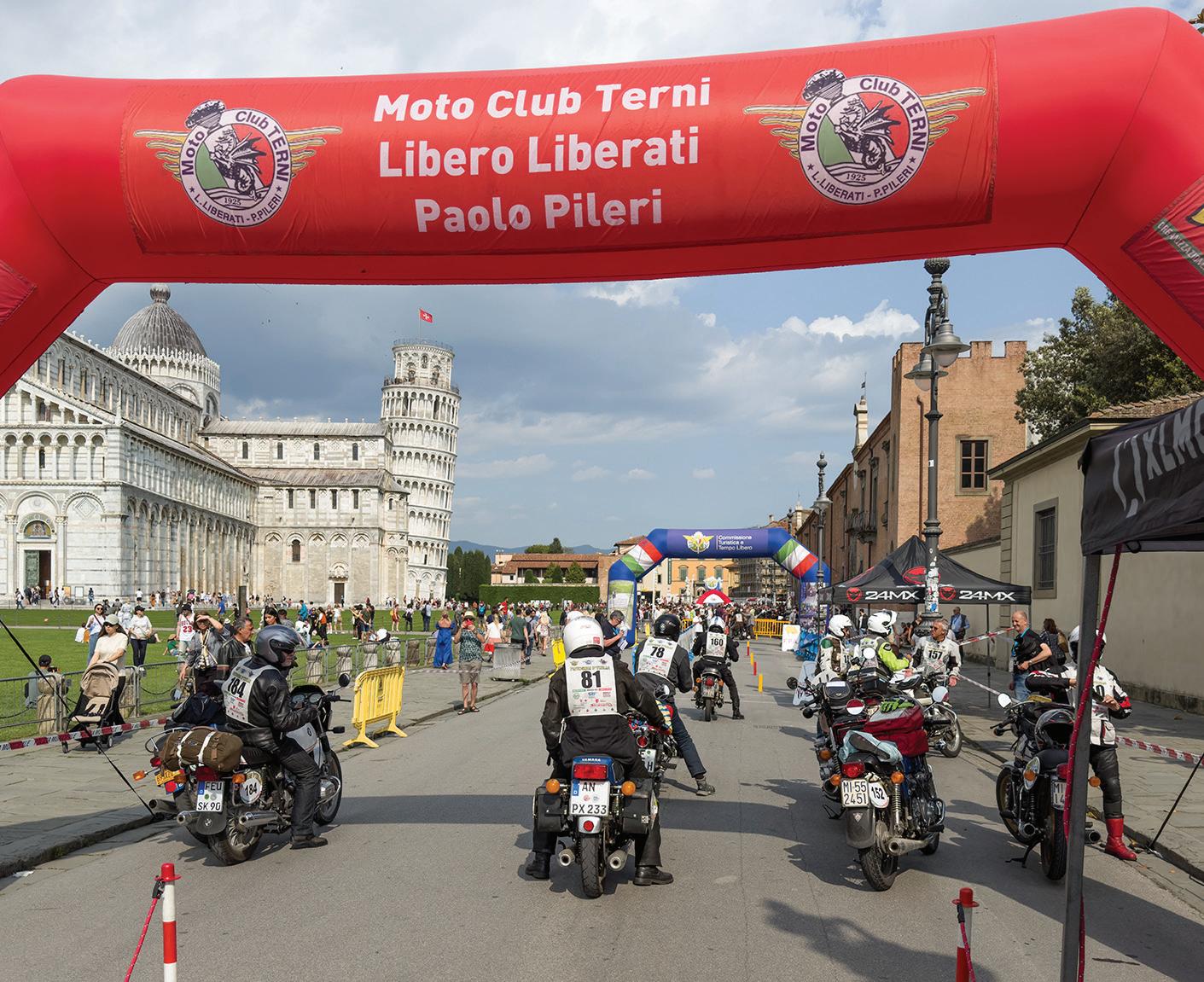

this event since 1989. Getting to know new enthusiasts and forging new friendships is our reward for the huge organizational effort we make. The tearful embraces at the finish line give us the strength to continue.”
He also felt it’s about carrying on with tradition: “The knowledge that we’re organizing a historical re-enactment of the oldest and best-known of Italian motorbike races, which was the driving force behind the Italian motorbike industry for so many years, and which is now known all over the world, leads us every year to always try to improve.”
Massimo stressed the fundamental attraction of travel and adventure: “Even in the digital age, the connection between people and the land endures. New destinations evoke powerful emotions, sensations and a yearning for exploration. Travelers cherish the memories of their journeys forever. The Motogiro d’Italia offers enthusiasts a chance to embark on timeless adventures, riding their cherished motorcycles through historic roads and captivating places.”
I thoroughly enjoyed the Motogiro d’Italia and my ride in this year’s event motivated me to try to repeat the experience. When I got home and my friends asked me what it was like, I told them If heaven exists and I manage to sneak in, I hope to spend eternity rolling through Tuscany on a vintage bike. Who needs wings when you have two wheels and endless Italian landscapes? MC
Discover the Complete Italian Heritage
A-Z of Italian Motorcycle Manufacturers is the most complete directory of Italian motorcycles available today. In addition to covering the most famous Italian factories, this is a definitive guide to the marques that have had little or no coverage. Some might be familiar, while others are remembered for their racing achievements, and many will never have been heard of by most readers. Topics covered include the history of the once great factories; marques that build motorcycles exclusively for racing; details of the most important motorcycles each manufacturer built, and each marque’s greatest achievement. This title is available at store.MotorcycleClassics.com or by calling 800-880-7567. Mention promo code: MMCPANZ5. Item #10838.

www.MotorcycleClassics.com 37
Left: Downtown 1,000-year-old Montefegatesi as the Motogiro comes to town. Right: Crossing the finish line in Pisa — feeling a bit sad but very satisfied.
NOT STOCK
The Medaza Wasp
Story and photos by Phillip Tooth

HHand-crafted in Ireland, Don Cronin’s latest creation looks like the sort of bike that Captain America would ride, not a Royal Danish postman.
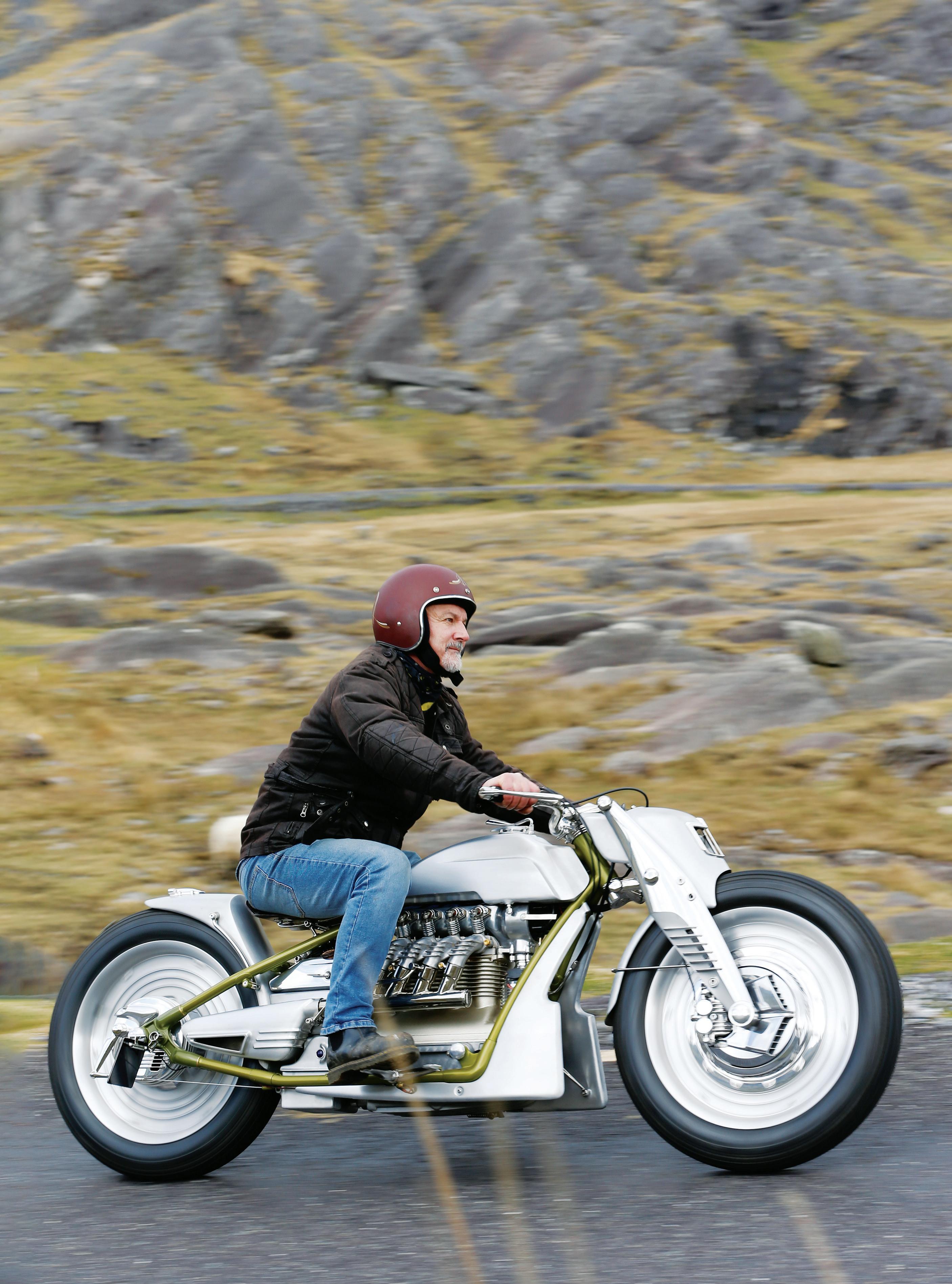
When it comes to choosing an engine for his Medaza motorcycles, Don Cronin has form. Forget about a big Harley mill from The Motor Company or the latest big-bore Triumph twins and triples. He’s used a 500 single with a “bacon slicer” external flywheel that once powered a Guzzi Nuovo Falcone, a V-twin liberated from a Morini Camel enduro, and even a utilitarian 2-stroke lifted from an MZ 300ETZ. So when he wanted an inline four for his latest project, you know he was going to come up with some-
thing different. And in a world of high-revving, huge horsepower fours, there’s nothing quite like a Nimbus.
The engine
Vacuum cleaner manufacturer Nilfisk branched out into making motorcycles way back in 1919, but the Nimbus we are interested in was launched in 1934. The unit construction 750cc engine featured an overhead camshaft. Just like the original MG sports car, the vertical camshaft drive to the bevel gears doubled as the armature spindle for the dynamo, which was mounted in front of the cylinder block. The lower half of the crankcase was cast in aluminum and carried a couple of liters of oil, but the upper half of the crankcase and the finned cylinder block were a single piece of cast iron. The detachable one-piece cylinder head with its hemispherical combustion chambers was also cast iron and incorporated the inlet manifold. An aluminum camshaft housing was bolted to the head, with the rockers supported in ball and socket bearings operating on the vintage-style exposed valves.
Hand-formed headlamp cowl is styled after Milwaukee locomotive. Medaza Wasp is so slim it’s almost like sitting on a razor blade.
The one-piece drop-forged crankshaft runs in two large diameter ball bearing journals, with the flywheel incorporating a large single plate clutch fixed at the rear. A 3-speed gearbox was bolted to the clutch housing, with shaft drive to the rear wheel.
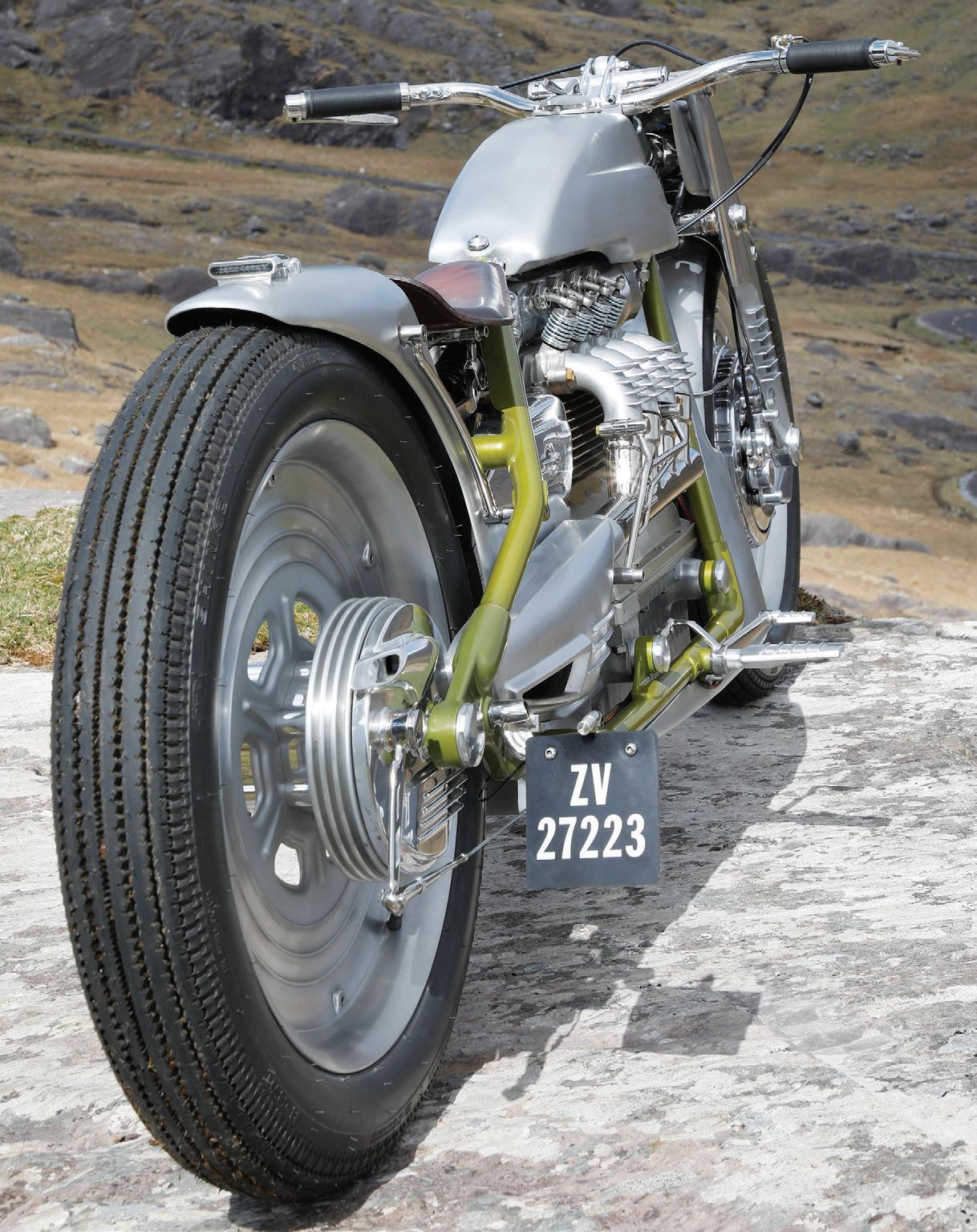
The frame
The cradle frame was made from lengths of 40mm x 8mm flat steel, riveted to the steering head and the unsprung rear end. It might not have been sophisticated, but it was cheap, easy to make and practical. Up front was the first modern telescopic fork, patented in 1933. That was two years before BMW introduced their tele fork, but the Germans pioneered oil damping. Hold on to your hair, Nimbus lovers. The standard 1934 model managed with 18 horsepower, but a sports version introduced for 1937 had the compression ratio raised to 5.7:1 and delivered a thrilling 22 horsepower. When the four was revved towards the 4,500rpm limit the straight-through exhaust with its little fishtail really buzzed, which is why Danish enthusiasts nicknamed the Nimbus the Humlebien, or Bumblebee.

But the Nimbus was never meant to be a sports motorcycle. It was a workhorse and the biggest buyers of Denmark’s homemade motorcycle were the Army and the Royal Danish Post Office, which finally pensioned off its fleet of sidecar outfits in 1976. Numerous upgrades were made to the engine and cycle parts before production officially ended in 1959, by which time more than 12,000 had been built, but factory policy meant that earlier models could easily be updated to the latest specification.
Size matters
If Don wanted a 1,265cc Indian or a 1,301cc Henderson Four for his donor bike he would have had to pay north of $100,000. “And those are big engines,” he says. “A late Henderson measures 360mm [14.1 inches] across the front of the crankcase. The Nimbus is tiny, only 200mm [7.9 inches] wide.” You can pick up a fully restored Nimbus motorcycle for about 10,000 euro (roughly $10,700) while a project bike costs less than half that. And that’s what Don shipped from Denmark to his home in Ireland.
Confirmed as a 1946 model, there was rust under the frame paint and a Japanese fork was a non-Nimbus upgrade, but at least the engine turned over. “Denmark’s Nimbus Touring club is brilliant. They are so proud of their national motorcycle and everyone is so supportive,” he says. “They have all the spare parts that you can possibly need including new crankshafts, cast iron cylinder heads and the combined cylinder block/crankcase top, all beautiful quality and they don’t cost silly money.”
But Don had no intention of building a stock engine.
“The engine was designed for long-term reliability, not performance,” he says. “The ports of the integral inlet manifold are square-section with right-angle bends, which is never great for gas flow. It is impossible to clean them up. And besides, the single Nimbus carburetor has a tiny 22mm choke. You could barely pass a man’s wedding ring
www.MotorcycleClassics.com 39
through it!” His solution? Design a new cylinder head with detachable inlet manifolds that carry twin carbs.
Off to the races
Contacts count when you are designing and building a special. Don was at a party in the Californian home of one of the members of Eagles of Death Metal when he met Mark Atkinson. “He is Speed of Cheese Racing,” laughs Don. “What a name! But after talking for only a few minutes I realised that he’s the real deal. Mark broke world speed records at Bonneville on his RD400 and runs his own machining and design service in Salt Lake City [Utah].” Don used Solidworks to create the drawings that were zipped over to Mark for machining from a billet of 6082 grade alloy.
New carburetors, valve guides, valves and springs were supplied by Jesper Jensen of Nimbus-Shop.com. Don did think about making the cylinder block/crankcase top in alloy, but soon changed his mind. “It would have been insanely expensive. There’s only a couple of millimetres between the bores so there’s not enough room to fit cast iron liners unless I used smaller pistons. And I didn’t want a 600cc Nimbus!”
Don is a sculptor whose work is on display in art galleries, museums and public spaces around the world. In a review of one exhibition, The Irish Times newspaper reported: “Don Cronin’s sculptures exude an air of technical elegance … of moving at speed through space.” If only they knew about his passion for
motorcycles and getting grease under his fingernails. Don has his own foundry, where he casts huge bronze and aluminum pieces, so using the ancient lost wax process to cast a pair of detachable inlet manifolds, each with ports in a V formation, was easy for this master craftsman. The same process was used to make the ribbed exhaust manifold, but the carburetor shields were sand cast. “The Americans call those bird catchers,” says Don. “Only a bumblebee could get sucked into one of these tiny carbs.”
Instead of shells, the Nimbus has vintage-style big-end bearings made by pouring molten white (babbit) metal into the eye of the connecting rods and machining to size. Continuing the vintage theme, instead of force-fed oil the bearings are lubricated by splash so Don was expecting them to be knackered. But when the crankshaft was stripped they were well within specified tolerances, and that tells you something about the legendary long-term reliability of these engines. The crankshaft was carefully balanced, new ball bearings were fitted to the camshaft housing and the oil pump was rebuilt.
Frame and suspension
Danish riders might think that the riveted steel strip frame is an iconic part of the Nimbus, but it had to go. Don crafted a new one from tubular steel. “In the old days, frames were made by brazing steel tubes into malleable cast iron lugs,” he


40 MOTORCYCLE CLASSICS September/October 2023
Frame is handmade, tank was shaped on an English wheel.
3D printing and lost wax casting were used to make parts in Ireland. The cylinder head was machined in Utah. The donor bike was cheap.



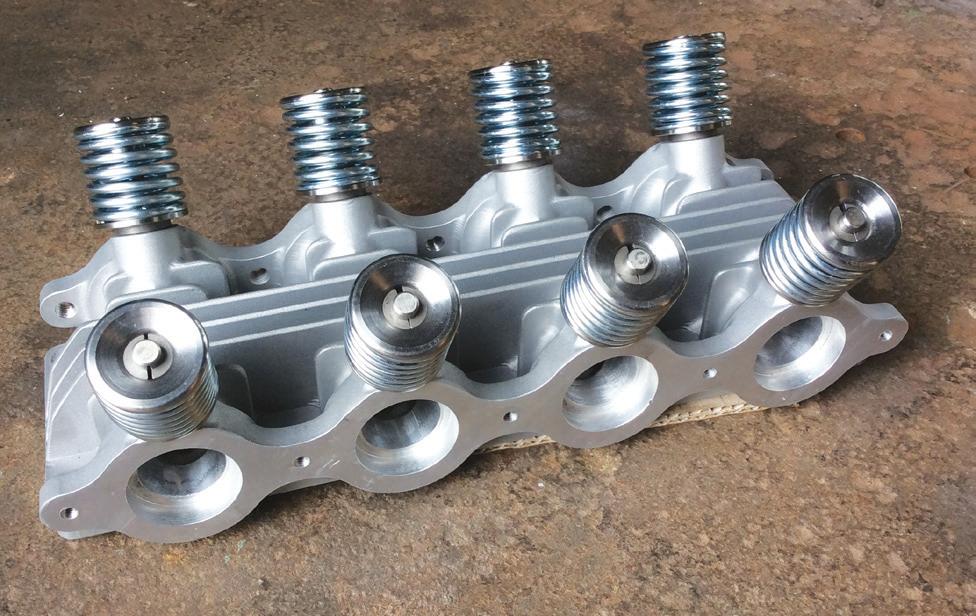

explains. “I wanted that vintage look but couldn’t afford to make the castings so I fabricated my “lugs” by TIG welding sections of steel before cutting them in half along the length and welded them over the tubes.” You could have fooled me …
Nimbus might have pioneered telescopic forks, but Don went vintage again with girders and asked the lads at Cork CNC to machine the legs to his design. Strong but light, excess metal has been machined away from the inside faces. The contrast between the polished and satin alloy is often seen in Don’s sculptures, and his artist’s eye has repeated the horizontal cooling vents in the front brake drum as fins on
the fork legs. While the triple clamps are machined from billet, to avoid distortion both top and bottom fork links were machined in one piece from stainless steel. Don bent his own handlebar, and fabricated the inverted levers and open twistgrip for that vintage look. “There’s no point in making it look like a superbike if there’s less than 30 horsepower to play with,” he adds.
Styling cues came from the streamlined Milwaukee Road Class A, the largest and most powerful steam locomotives to thunder across the United States in the 1930s. Check out the hand-formed alloy headlamp cowl with its stainless steel visor and you’ll see what we mean, but don’t forget to take a peek at the Fournales air shock hidden behind it.
And while you’re paying attention, take a closer look at the
front stopper. Recognize it? That’s an enclosed, ventilated twin disc brake with inverted twin-pot calipers from a 1982 Honda CBX550F. Don’s daily ride is a modified (surprise!) Mk3 Le Mans. “Guzzi big twins have linked brakes, so I realized that the foot pedal master cylinder is just what I needed to operate the Honda set-up,” he says. The rear brake started life as a Nimbus unit, but you wouldn’t know it. Now the steel drum has three alloy ribs shrunk on while the new brake plate, fabricated from alloy plate, is a work of art in itself. Check out the brake lever. Is that a propeller blade?
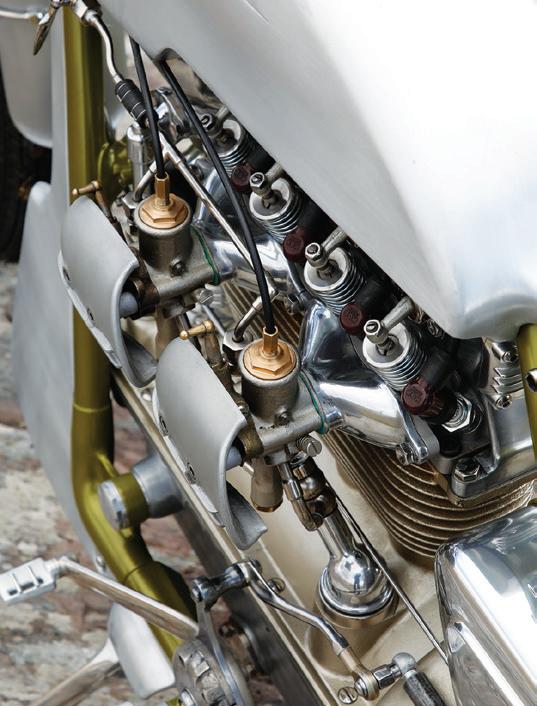
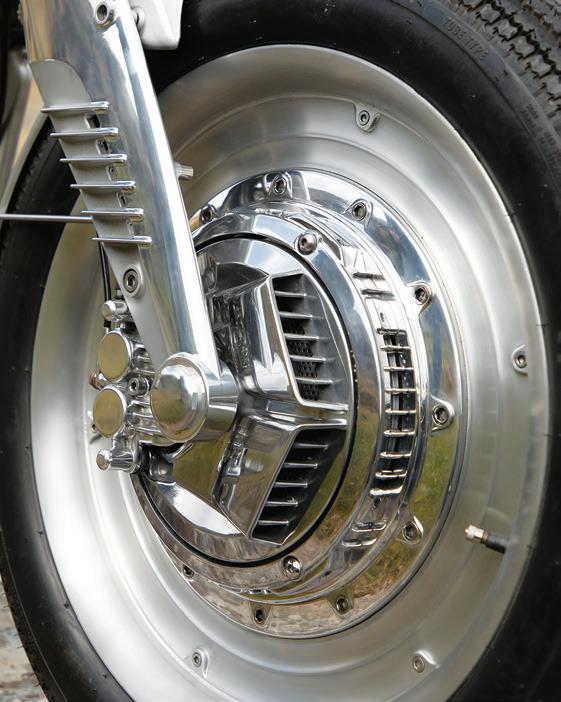
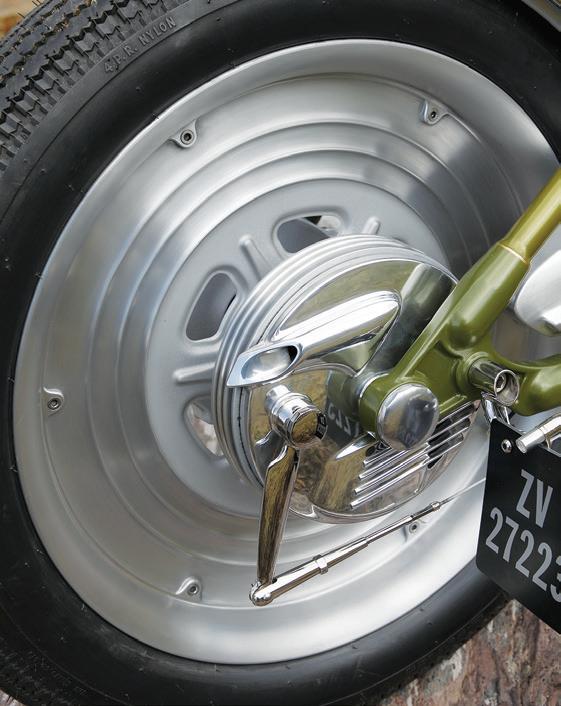
Don ordered alloy wheel blanks from Californian company MSI. These have the rim and bead pre-formed, with a 3/4 width solid slab in the middle. Don was limited by the 19-inch tire size, matched to the new solo gearing in the final drive crown and pinion, but he had a free hand in the design file that he sent to Mark at Speed of Cheese Racing. There’s a hint of Honda Comstar in the way the brakes appear to be bolted to the wheel rims, and of course more of that sublime satin and shine contrast.
Covid creation
Just about everything on this motorcycle has been designed or made by Don. He continued to work with Cork CNC, sending more files for machining components like the muffler box with

its internal baffles, toolbox, fuel cap and neat little taillight. But he hand-formed the 1.8 U.S. gallon (7 liter) fuel tank, fenders and frame side skirts. Although much of the build was done during Covid lockdowns, it wasn’t until the spring of 2023 that he was ready to ride. And we were there to see the action.
Don wasn’t interested in checking the power on a rolling road dyno before our test ride. “The twin-carb cylinder head has probably made bugger all difference to the performance,” he laughs. “For me, it’s all about the challenge. Can I make one?”
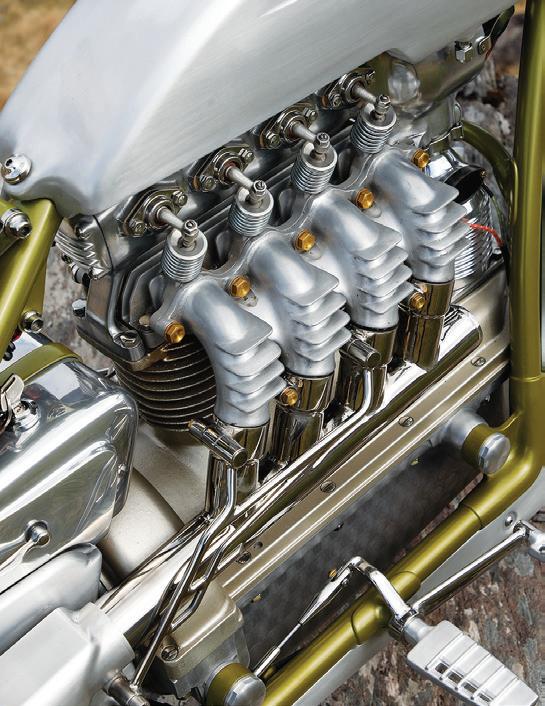
Starting is effortless — a gentle swing on the kickstart pedal and the four immediately purrs into life, the external valves rustling in the breeze. But after Don snicks into first and opens the taps the revs rise rapidly to frenzied buzz as he charges up Healy Pass, moving smoothly through second and into top and sweeping through curves with effortless grace. This looks like the sort of bike that Captain America would ride, not a Royal Danish postman.
“Sounds more like a wasp than a bumblebee!” Don says with a satisfied grin. Medaza Wasp? Sounds good to me! MC
Cheers, Lads! Special thanks to old friends Chris Harte for wiring the bike, Mick O’Shea for invaluable help and advice and Jim Cuddihy for generous time and effort on the engine build. Check out other creations at medaza.com — Don Cronin
Back brake is modified Nimbus, front is ex-Honda. Exposed valve gear looks vintage, but twin carbs are a major update.





























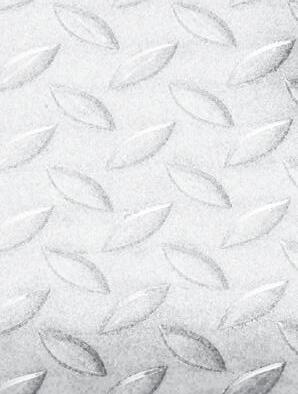

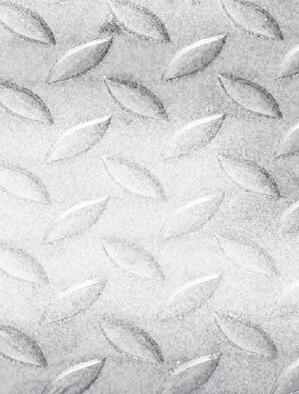
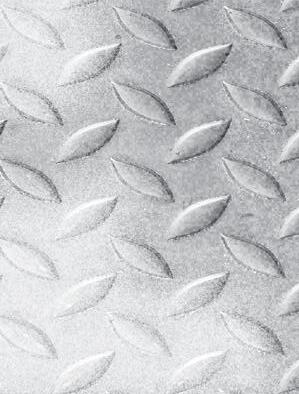




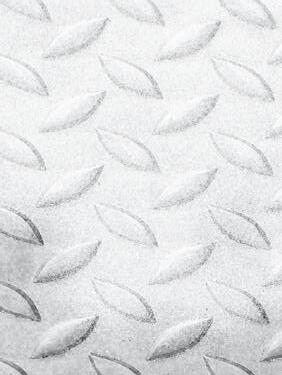

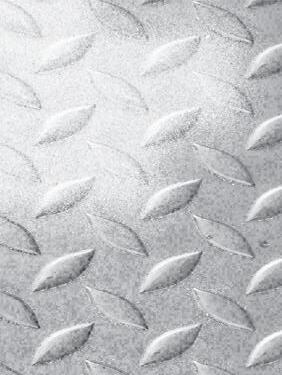


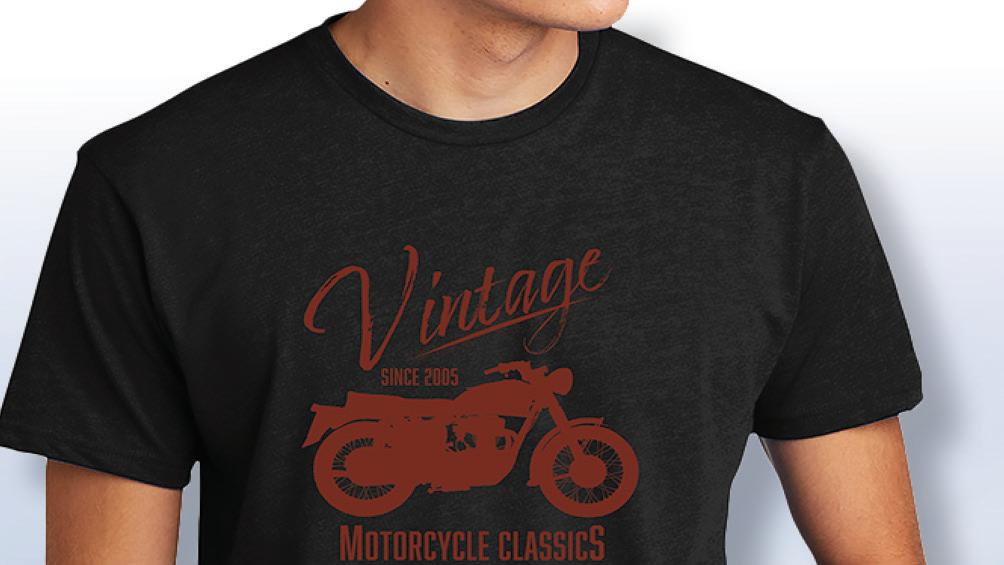






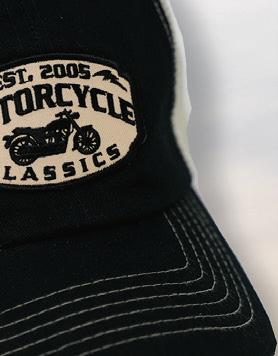


























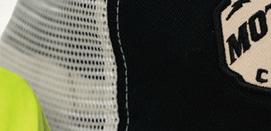








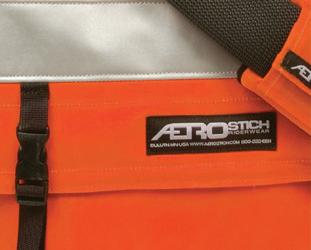


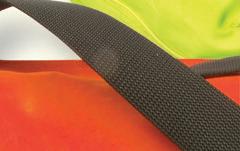
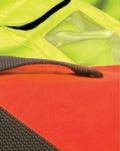

















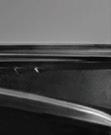

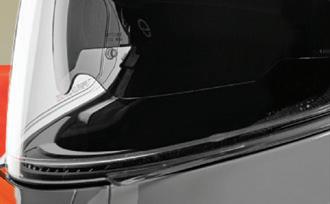




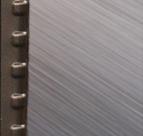

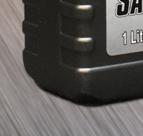






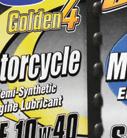

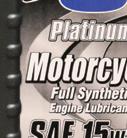
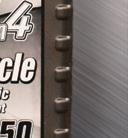

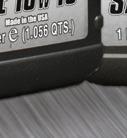

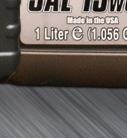
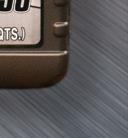










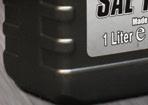


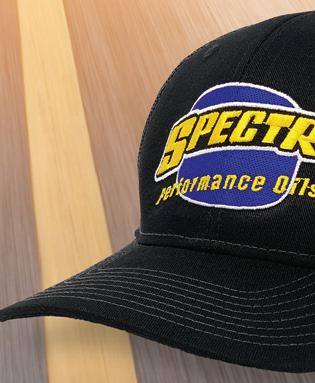







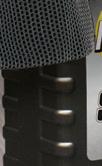










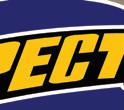













GIVEAWAY No purchase necessary. A purchase will not increase your chances of winning. Open to legal residents of the contiguous United States (excluding Alaska and Hawaii). Entrants must be 18 years of age or older. Sweepstakes begins 02/23/2023 and ends 10/19/2023. See o cial rules online at www.motorcycleclassics.com/sweepstakes/ready-to-ride I Sponsor: Motorcycle Classics, 1503 SW 42nd St., Topeka, KS 66609. ENTER FOR YOUR CHANCE TO WIN ONLINE AT WWW. MOTORCYCLECLASSICS.COM/SWEEPSTAKES/READY-TO-RIDE MOTORCYCLE CLASSICS READY TO RIDE GIVEAWAY • Riding Jacket • Dispatch Bag • Helmet • Other apparel • $300 in gift cards • Engine Oil • Shock Absorbers • Miscellaneous items ENTER FOR YOUR CHANCE TO WIN A PRIZE PACKAGE VALUED AT $2,400!
KANEMOTO DRAGON

1974 Kawasaki H2R Flat Tracker
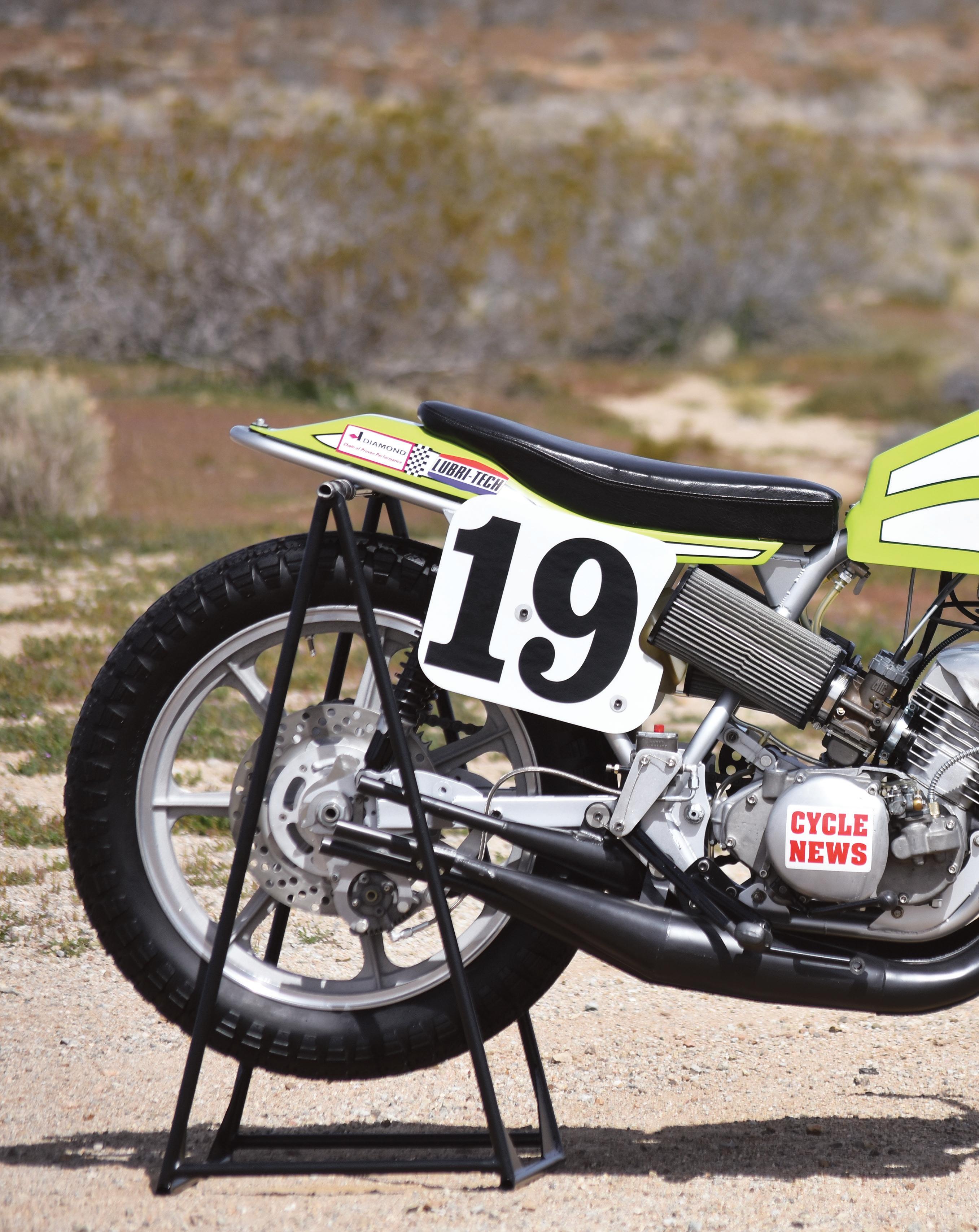
Story and photos by Dain Gingerelli
KKenny Roberts’ 1975 Indianapolis Mile win remains a race of historic proportion.
During the evening of Aug. 23, 1975, KR wrestled to victory circle one of the most unorthodox dirt track race bikes ever, a flat tracker powered by a 120-horsepower Yamaha TZ750 inline 4-cylinder, liquid-cooled, 2-stroke engine originally developed for road racing. But for 24 and nine-tenths laps the race appeared futile for Roberts. After starting from the back row he ultimately overtook race leaders Corky Keener and Jay Springsteen on the final go-round, nipping them by inches at the finish line. It was the only time KR led the race that otherwise seemed a lost cause for the defending two-time Grand National Champion. Readers unfamiliar with that race are encouraged to set this issue of Motorcycle Classics magazine down right now so you can search YouTube to view the historic video footage. At the video’s conclusion report back ASAP because, boy oh boy, do we have another tall tale to tell you.
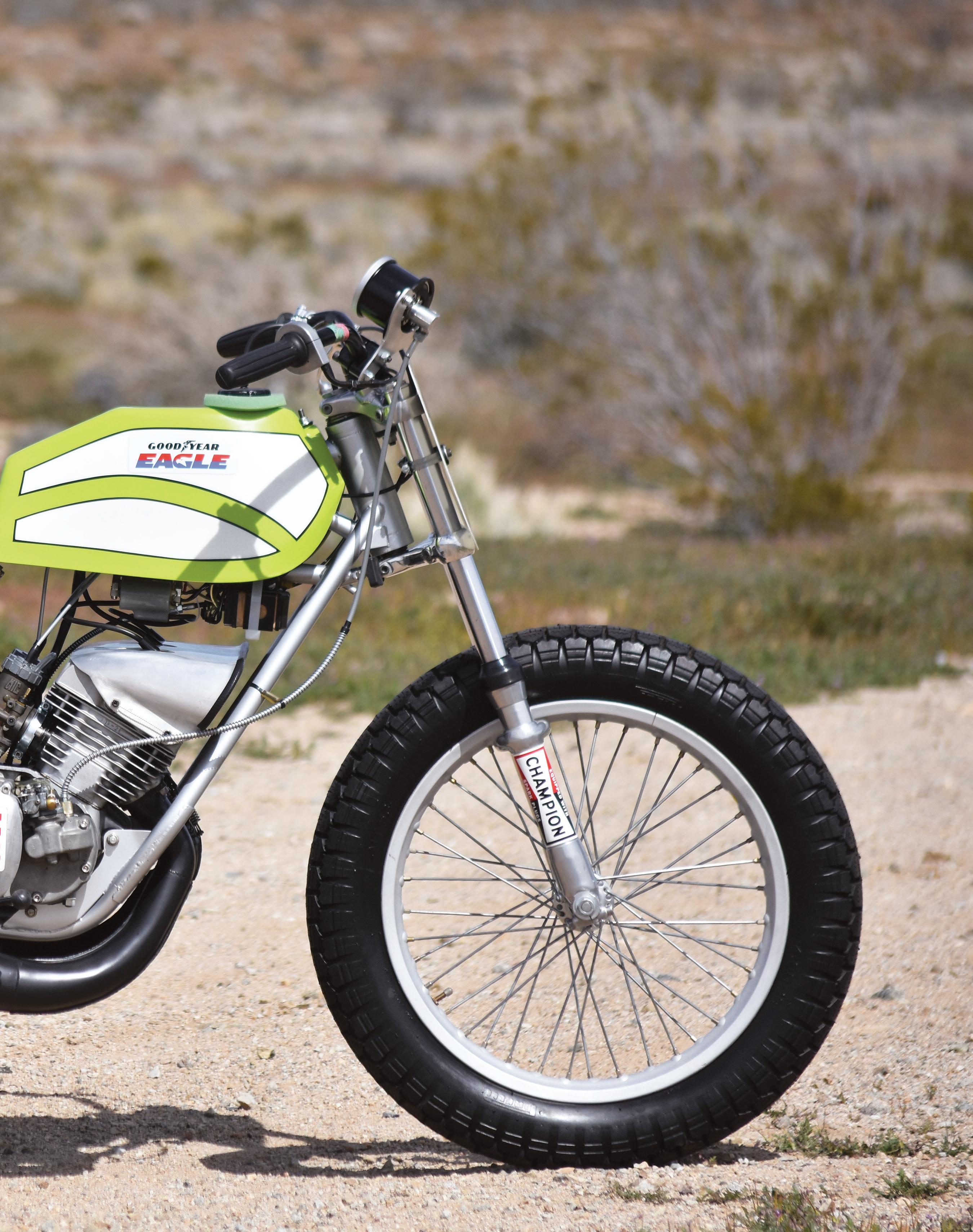
Amid the Indy Mile’s post-race celebration, AMA historians quickly noted that this was the first time a 2-stroke engine with more than two cylinders had powered its way to win an AMA Grand National Championship dirt track race, in this case the much ballyhooed Indy Mile. That night history was made ... sorta.
Sorta because a month and a half prior, July 6 to be precise, another multi-cylinder 2-stroker had already won an AMA Regional flat track race, the Stockton Mile in
www.MotorcycleClassics.com 45
California. The winner of that non-National event was 21-year-old Scott Brelsford, riding the No. 19 green monster featured here. The bike, built by still-aspiring tuner Erv Kanemoto and powered by a Kawasaki H2R 750cc 3-cylinder air-cooled 2-stroke engine, now belongs to collector Mike Iannuccilli. It remains the first multi-cylinder 2-stroke to win a major AMA flat track race. Ever.
Even though the Stockton Mile wasn’t a National points race, its Regional Championship status made it significant on the race calendar, attracting many of the top Expert-ranked AMA stars of the time, including Rex Beauchamp, Jim Rice, and former GN Champions Mert Lawwill and Gene Romero, among others. They were there to compete for Regional points and, more importantly, for cash. The AMA promoted Regional races throughout the country, and those isolated races often served as potential feeding grounds for pro riders to earn extra money during the long racing season.
In the beginning …
Unlike KR’s success with his TZ750powered beast (Roberts had not ridden the bike until Indy), Brelsford’s win didn’t happen overnight. Indeed, up to the Stockton Mile this type of flat track racer was unproven and equally untested by its creator and owner Kanemoto, among the most talented and innovative race-bike tuners of his time. Moreover, Kanemoto’s entry wasn’t factorybacked, as was Roberts’ TZ-powered racer. Interestingly, though,
as we shall see, both bikes shared similar frames, differing mainly in the placement of their motor-mounts and other proprietary fixture locations … and, of course, their engines.
Like Yamaha’s TZ750, the Kawasaki H2R displaced 750cc. Unlike the TZ750, which Yamaha developed specifically for road racing, the H2R engine was a modified version of Kawasaki’s road-going H2 engine (Mach IV). Even so, the H2R was no slouch, and had powered two-time AMA Grand National Champion Gary Nixon to three AMA National road race wins in 1973, the most by any rider that year, qualifying him as AMA’s 1973 Road Race Champion. Even so, Kawasaki opted not to support Nixon and Kanemoto for 1974, prompting the tuner and rider to sign contracts with Suzuki for the 1974 season. They would use Suzuki’s GT-based liquid-cooled 750cc triple for their 1974 AMA road race endeavors. What to do with the pair of proven Kawi engines that now belonged to Kanemoto?
Nixon came up with a plan, suggesting that his wizard tuner shoehorn an engine into a flat tracker frame so the duo could also compete in AMA’s Grand National dirt track circuit as well (read: racing for more cash). One daunting question remained: where to find a frame for the wide 3-cylinder engine and its trio of bulbous expansion chambers?
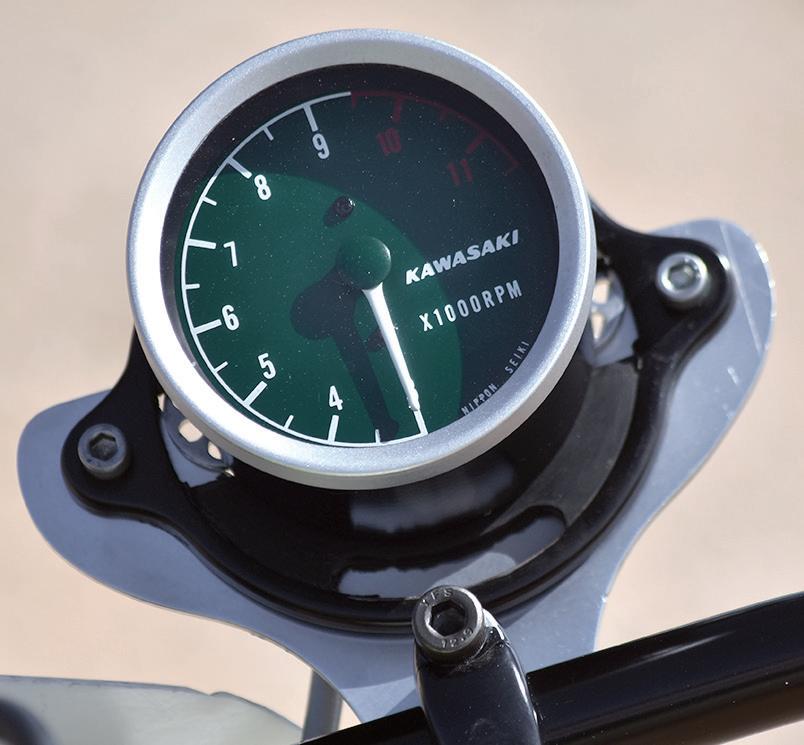
Kanemoto gave a devilish smile; he had a friend who he had worked with in the service department at East Bay Yamaha

46 MOTORCYCLE CLASSICS September/October 2023
The tach sits on the right of the handlebar for easy viewing down the straights.
Widely spaced buckhorn handlebars offered plenty of steering leverage through the turns.

years before. That friend, Doug Schwerma, now had his own race-frame business, Champion Frames. And it just so happened that Schwerma had recently put together a frame for a similar project, shoehorning a massive Honda CB-750 Four engine into a frame of his own making. According to sources of the time the Honda project had been commissioned by American Honda, with hopes of joining the AMA’s annual flat track feeding frenzy known as the Grand National Championship. Even though the Honda connection was quickly terminated, Champion Frames eventually built frames to cradle the Kawasaki and Yamaha 2-strokes. Most insiders consider those frames’ basic geometry and related dimensions were based on existing race frames that Schwerma’s company built to cradle small-bore 2-stroke engines for short track racing, and to cradle Yamaha’s 4-stroke 650/750 twin. Those frames had proper rake and trail specifications that, along with proper wheelbase and engine placement, created a balanced formula for sliding around hardpack dirt ovals.
After listening to Kanemoto’s proposal-cum-request, Schwerma took delivery of the H2R engine cases, using them to relocate the frame jig’s motor mount points to suit the Kawasaki engine’s footprint. He also altered a few other dimensions here
and there, and presto — the racing world was treated to a 2-stroke triple for America’s flat tracks. In the process Nixon, who had been absent on hard-pack ovals after Triumph downsized its U.S. race program in 1972, regained the itch to “do it in the dirt.”
As it turned out, Nixon’s first experience with the new Kawasaki “framer” at the September 1974 San Jose Mile, plus an injury suffered while testing the Suzuki in Japan, prompted him to rethink matters. Brelsford (1973’s AMA Rookie of the Year who had recently ended his tumultuous and short-lived relationship with Harley-Davidson’s factory team) would replace Nixon as rider for the new Kawasaki slider. The combination of Kanemoto’s tuning talent, a powerful engine that benefitted from such talent, and a youthful and aggressive rider, spelled potential trouble for the horde of Harley riders and their XR750 motorcycles that dominated flat track racing at the time.
Moooove over, here comes the Kaw
By summer of 1974 Schwerma delivered a frame and swingarm, plus peripheral parts such as a seat, gas tank and such to Kanemoto, who immediately began piecing his new puzzle together. The completed project included typical mainstay wares
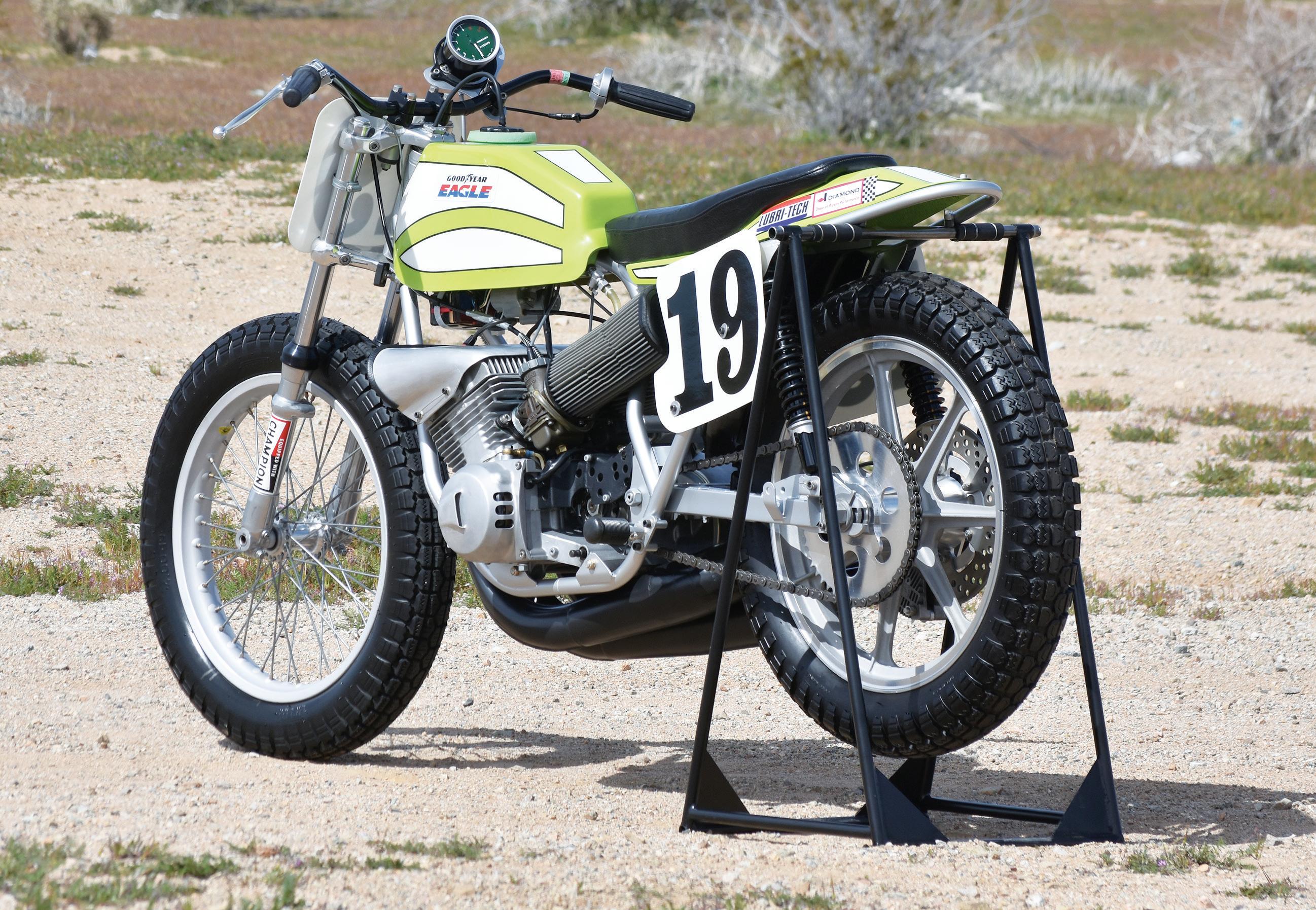
as a Ceriani fork up front and a pair of Boge rear shock absorbers. Also, Kanemoto modified a set of the factory H2R road race exhaust chambers so that all three gathered along the bike’s right side; oval track sliders only turn left so cornering clearance on that side of the bike is paramount, thus all exhaust pipes merged to the right side.
Howard Barnes laced the brakeless front hub to a 19-inch rim, and he fitted the 19-inch Morris magnesium rear wheel with a disc brake and Airheart caliper that, in Kanemoto’s words, was “similar to the small units on the go-karts I used to race and tune.” (Time out for additional background on tuning wizard Erv Kanemoto: His father had raced speed boats powered by 2-stroke engines, and that’s where the now-famous motorcycle tuner cut his tuning teeth; he later took his talents and tools to the go-karting arena where he furthered his skills with oil-burning engines that he later applied to road race motorcycles. Okay, end of time out, and all featured players in this story, back to your positions so that we can complete this historic saga!)
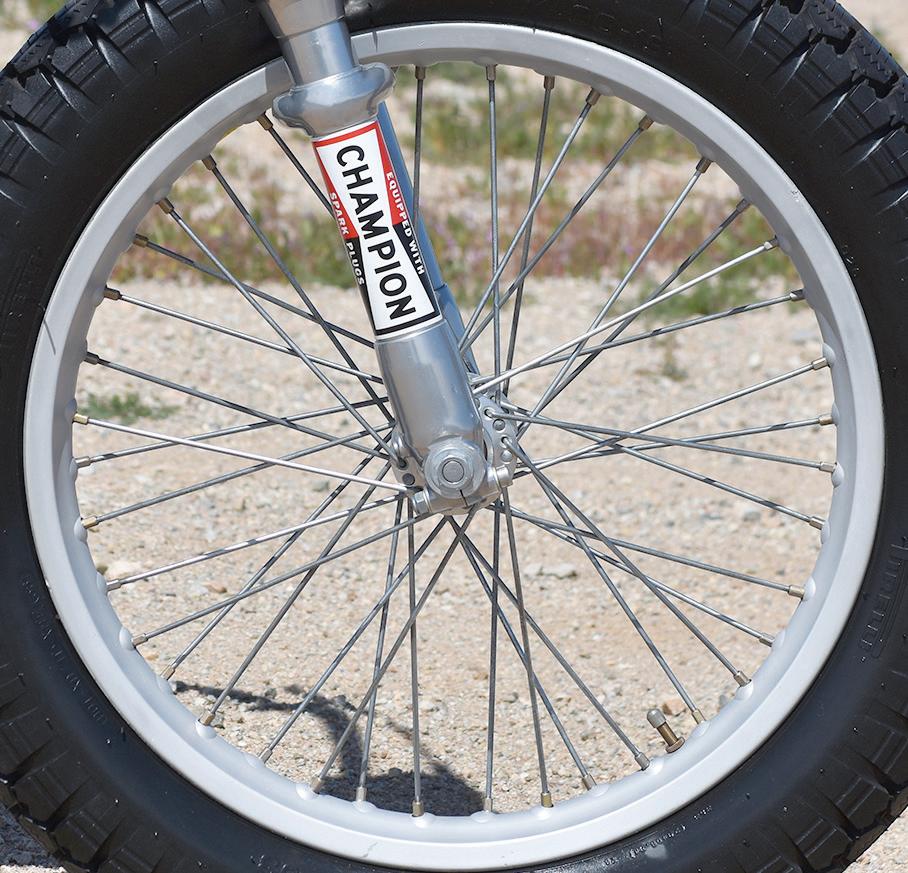
In his usual manner the crafty tuner wasted no time sorting through the parts for assembly, finishing shortly before the San Jose Mile in September 1974. With Nixon still the designated rider, the pair set out for practice and qualifying at the fabled Mile track. Various teething problems prevented Nixon from transferring to the Main, but based on what was learned that day, he deemed the bike needed a longer wheelbase so the big Kaw would be easier and more predictable to turn and slide,
important traits when competing on a mile-long oval track where speed is measured in the 120mph range. According to Cycle magazine, during the winter Kanemoto extended the swing arm and moved the rear shocks’ mounting points about 3 inches forward, plus Schwerma and crew fabricated a new saddle-type engine mount to further secure the engine’s front portion to counter vibration. In the interest of rider comfort, Kanemoto also rubber mounted the handlebars.


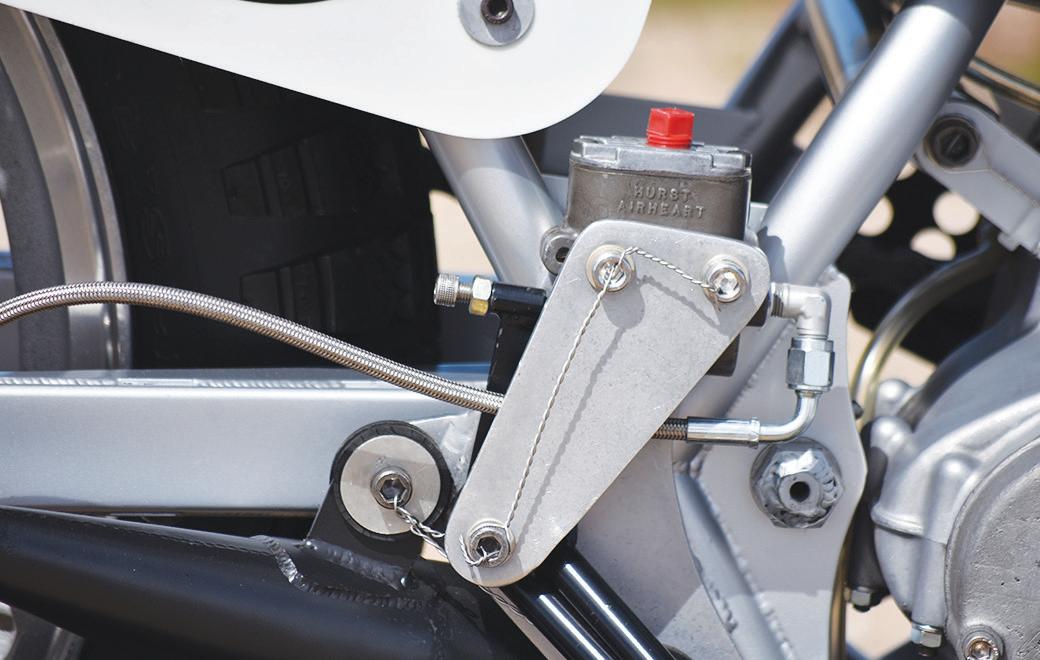

Nixon’s prognosis was confirmed a short time later when Kanemoto, now with Brelsford in the saddle, headed to another local flat track race, this one across the bay at Golden Gate Fields near Albany, California. Years later, Brelsford reflected on his first track session with the bike, recalling, “You had to spin it [the engine’s revs].” And when you did? “You went fast.” How fast?
“It could spin the rear tire the entire length of the straights,” answered Brelsford, as calmly as if describing how he rolled the bike into the garage for the night. Eventually projected top speed was about 140mph, give or take. By comparison, HarleyDavidson XR750s peaked at about 120mph on a Mile oval. Ironically, at one point Brelsford and Kanemoto thought that the engine’s clutch was slipping (it always showed signs of “creep” at the starting line), but after further examination both men determined that between excess power and unsophisticated tire technology of the time, the rear tire was breaking loose when maximum horsepower kicked in!
The brash Brelsford gave additional insight about riding the monster: “You also had to downshift for the turns.” Huh? On a Mile track, downshift? He explained that, doing so, “the rear tire could spin [slide] through the turn” as it should on any flat tracker to maintain the mysterious gyro effect needed for sliding a motorcycle at those speeds. And because the 3-cylinder
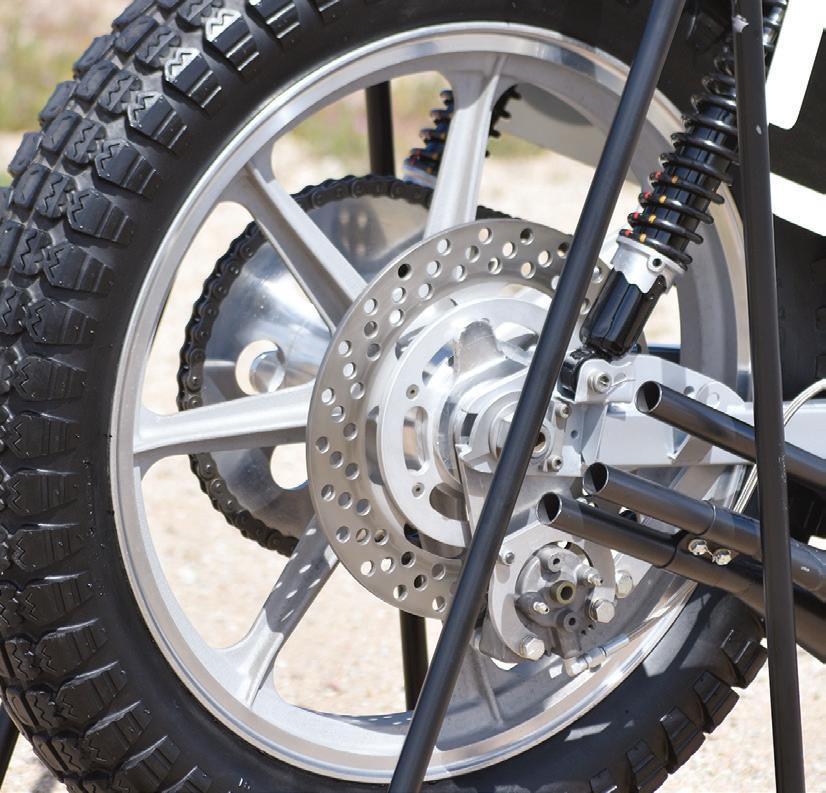
48 MOTORCYCLE CLASSICS September/October 2023
Howard Barnes prepared the wheels and rear disc brake. Kanemoto fabricated the rear brake controls; K&N supplied air filters. Three exhaust chambers were neatly routed along the right side. Several tire brands were tried; Carlisle proved best for traction.
engine didn’t produce much torque, you had to initiate rear wheel spin before entering the turn by downshifting to a lower gear. Otherwise, the 2-stroke engine’s explosive power wanted to send the rear wheel into a tizzy, prompting it to wildly loop around until it became the bike’s front wheel. And when that happens you don’t need to be Albert Einstein to figure out that you had just violated a major law of physics.
And so Mr. Brelsford mastered the art of downshifting his new ride, and in the process he laid down some rather impressive lap times on Golden Gate Fields’ rather loose surface … until the carburetor slides began to stick. Result: DNF, and back to the shop for some additional Kanemoto magic in preparation for the May 1975 San Jose Mile. Furthermore, during the subsequent mild California winter, Schwerma’s second chassis arrived at the Kanemoto residence for another bike that Kanemoto wanted to put on the track. Local racer Donnie Castro, who had recently been released by Team Yamaha, was assigned the second bike. Kanemoto’s logic suggested that two bikes would gather twice as much track data as could a single bike. The team was growing in size and gaining strength on the track.
They know the way to San Jose
To say that Brelsford was fired up for the upcoming San Jose race is an understatement. He was on a mission, and rather quickly it became apparent that he was, indeed, a force to be reckoned with. Every Expert-class rider, including Mert Lawwill, who had perhaps the fastest XR750 in the field, took notice. Brelsford and Kanemoto were about to show who wielded the real horsepower. Matched against Lawwill in the second transfer heat race, Brelsford caught fire after the field spread out, giving him a clear path to use his bike’s top speed.
As Art Friedman reported for Cycle Guide magazine, Brelsford “overtook bikes on the straights in clumps of two or three.” The H2R 2-stroke’s banshee-like howl was equally matched by its rear tire spin on San Jose’s long and inviting straights. Amazing, and after a poor start Brelsford closed on Lawwill to finish second in their transfer heat. Brelsford was fired up for the Main, and Cycle
Kanemoto fashioned the top air scoop for additional cooling. Viewed from the front, the 3-cylinder engine looks surprisingly narrow.

magazine’s race report made it clear: “Brelsford was flared-nostril enthusiastic, having qualified the bike a fine tenth-fastest.” Brelsford’s Kawasaki was equally as fast as the Harleys, but, as Cycle’s report stated, “the only capable threat to the H-Ds sputtered out of the race and into the pits with one of its air cleaners adrift, a cylinder full of dirt, and a connecting rod trying to create a new alloy with the crankpin.”
Even so, the San Jose crowd watched in wide-eyed disbelief as Brelsford leap frogged from eighth to fourth, then to third before engine trouble sidelined him. There’s always the next race, and in reality the “next race” was to become The Race for the feisty privateer team. Next stop, Stockton.
Go for the California gold
By that time Kanemoto was able to “upgrade” the Kawi’s tires, replacing the narrow Dunlops with a Pirelli 19-incher up front and a Carlisle 4.50 x 19-inch hoop on the rear. Even so, sliding traction remained elusive, so Brelsford did all he could to keep the bike upright when corner sliding. He also had gained more confidence since riding it at San Jose, years later stating that “it was fun to race the thing, but it was a challenge.” It turned out, too, that he was up to the challenge, and the young, brash Brelsford pretty much owned the race at Stockton, becoming the first rider to ever win a Mile race aboard a multi-cylinder 2-stroke framer. But had the race gone another lap, Brelsford would have DNFed; the bike’s chain came off during the cool-off lap!
Even so, history had been made, and then it was on to Indianapolis where Brelsford qualified high enough to earn a front-row starting position for the Main. Roberts dutifully lined up on the back row. When the green flag fell to start the race, Brelsford got a worthy start, but by the end of the first lap something snapped in the engine, terminating his ride. His teammate Castro had failed to qualify for the Main, but the team decided to continue racing through the remainder of the 1975 season.
Brelsford seemed to adapt better to the H2R’s brute power, but neither rider met with any noticeable success after the Stockton win. They competed at Syracuse but both failed to transfer to
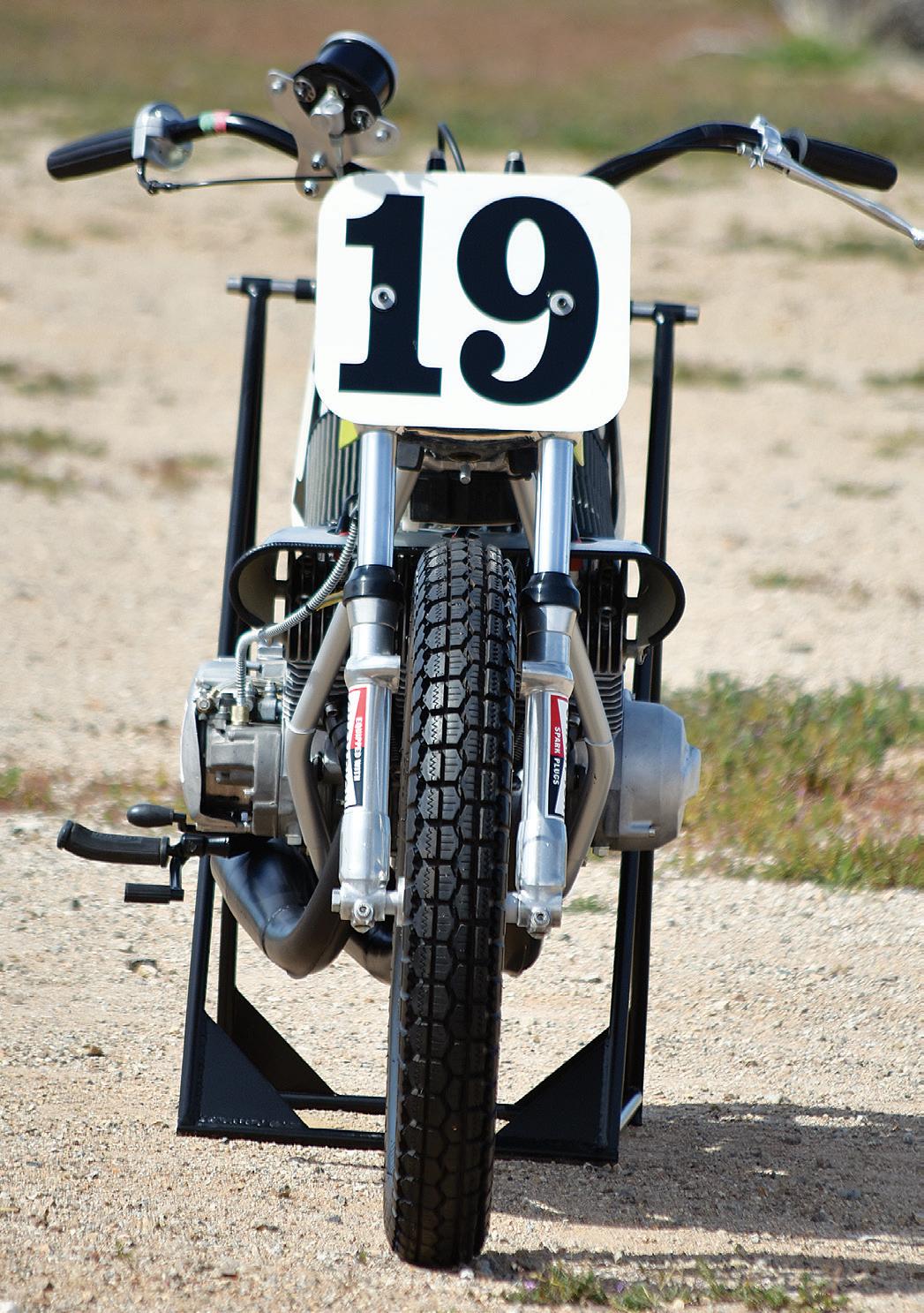
www.MotorcycleClassics.com 49
the Main before heading back to the West Coast for the season’s second San Jose Mile.
As the weekend progressed Brelsford was feeling chipper until a wayward countershaft sprocket during practice prompted the bike to stand up and veer toward the outer fence — at about 100mph. “That one got to me. I was trying all I could not to hit the fence!” He avoided that catastrophe, but that pretty much ended the saga of the feisty team.
Recalls Kanemoto, “Looking back at the bike that Donnie [Castro] rode, I set it up hoping to reduce wheel spin for better traction exiting the corners. In reality that set-up probably made it harder for Donnie to complete the corner under heavy throttle, which resulted in less wheel spin, making it harder for him to complete the corner. That probably forced him to not open the throttle as early or hard as he preferred. With that setup, he more than likely would have ended up chasing the front (wheel). It’s one more thing I think about over the years, that I wish I could go back to that time to correct it for him.”
Banned bikes
But none of that was to be. A decision by the AMA rules committee following the 1975 racing season secured that fate of the big Kawasaki and Yamaha. Before the winter meetings adjourned, the AMA banned multi-cylinder 2-strokes from flat track National competition. Perhaps Roberts’ famous quote concerning his TZ750 monster, “They don’t pay me enough to ride that thing,” sealed the fate. Or maybe, as insiders suggest, banning the 2-strokes was part of a compromise that also led to the formation of a separate AMA road race championship (where purists said the 2-stroke multis belonged!). In any case, and racing politics aside, the summer of 1975 witnessed two motorcycles powered by multi-cylinder 2-stroke engines etch their respective marks in motorcycle racing lore.
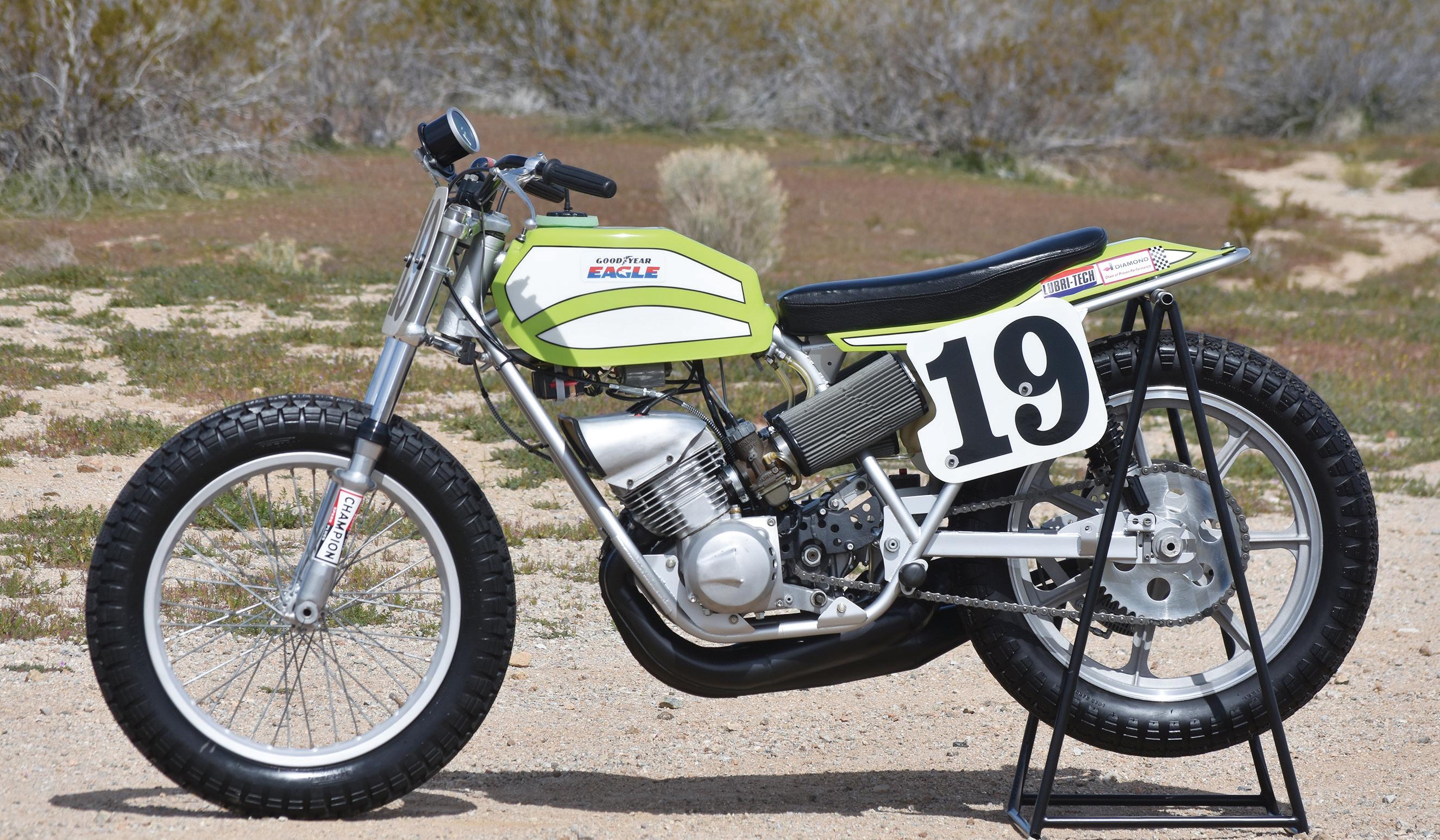
And what became of those milestone milers? Fortunately — even surprisingly — most of them survived, and the Brelsford bike even found its way into other racing arenas, thanks in part to Dennis Zickrick of Fort Collins, Colorado. A few years later Zickrick had acquired the Brelsford bike, giving it new life. Eventually
Zickrick entered it in the annual Pike’s Peak Hillclimb where he and the old Kawi set a new path towards making even more history! Their historic path led to the top of Pike’s Peak when Zickrick and his bike became, possibly, the first multi-cylinder 2-stroke framer to reach the clouds.
“I finished in the top 10,” Zickrick recalls with certain pride. “A Honda rider crashed and blocked one of the turns, so that forced me to slow down enough to be ninth.” Still, a credible finish. And that raises another interesting sidebar to this tale: In 1980 Zickrick became a member of American Honda’s Superbike team, and was responsible for maintaining future world champion Freddie Spencer’s Honda CB750-based Superbike. A couple years later Kanemoto’s tuning talents were pressed into service to help Spencer win his three Grand Prix World Championships for Honda. Yeah, small world.
Zickrick continued racing the old Kawi, occasionally competing at local outlaw half-mile tracks until the Pike’s Peak Museum invited him to display the legendary bike as one of the events’ more interesting entries. Zickrick figures that he owned the bike for about 30 years before selling it. “But I don’t remember to who,” he adds. Eventually Dan Masachini acquired it, but he soon sold the Brelsford bike to Kawasaki Triple collector Jergen Weiss in Germany. As a member of the European-based H2 Club, Weiss tinkered with it, occasionally revealing the framer at motorcycle events before selling it to collector Mike Iannuccilli who, as he patiently does with the historic racers in his collection, set about returning the bike to its former glory.
“I like to restore my bikes to look exactly the way they raced years ago,” says Mike. “These are historic pieces,” he adds, and by “exactly” he means a mirror image of the bike’s original livery, right down to paint scheme, decal placement, you name it. And that’s what he did with the Brelsford bike and the Castro bike that he later acquired. Historic moments happen only once — that is why they’re historic. And historic best describes these two Kawasakis, built nearly 50 years ago by a historic tuner, to be raced by three of the many historic men to have populated the starting grids of America’s historic flat tracks. MC
50 MOTORCYCLE CLASSICS September/October 2023









































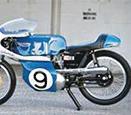










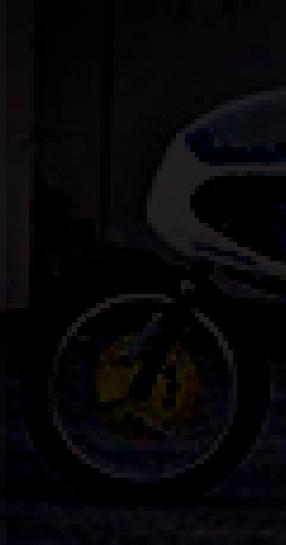
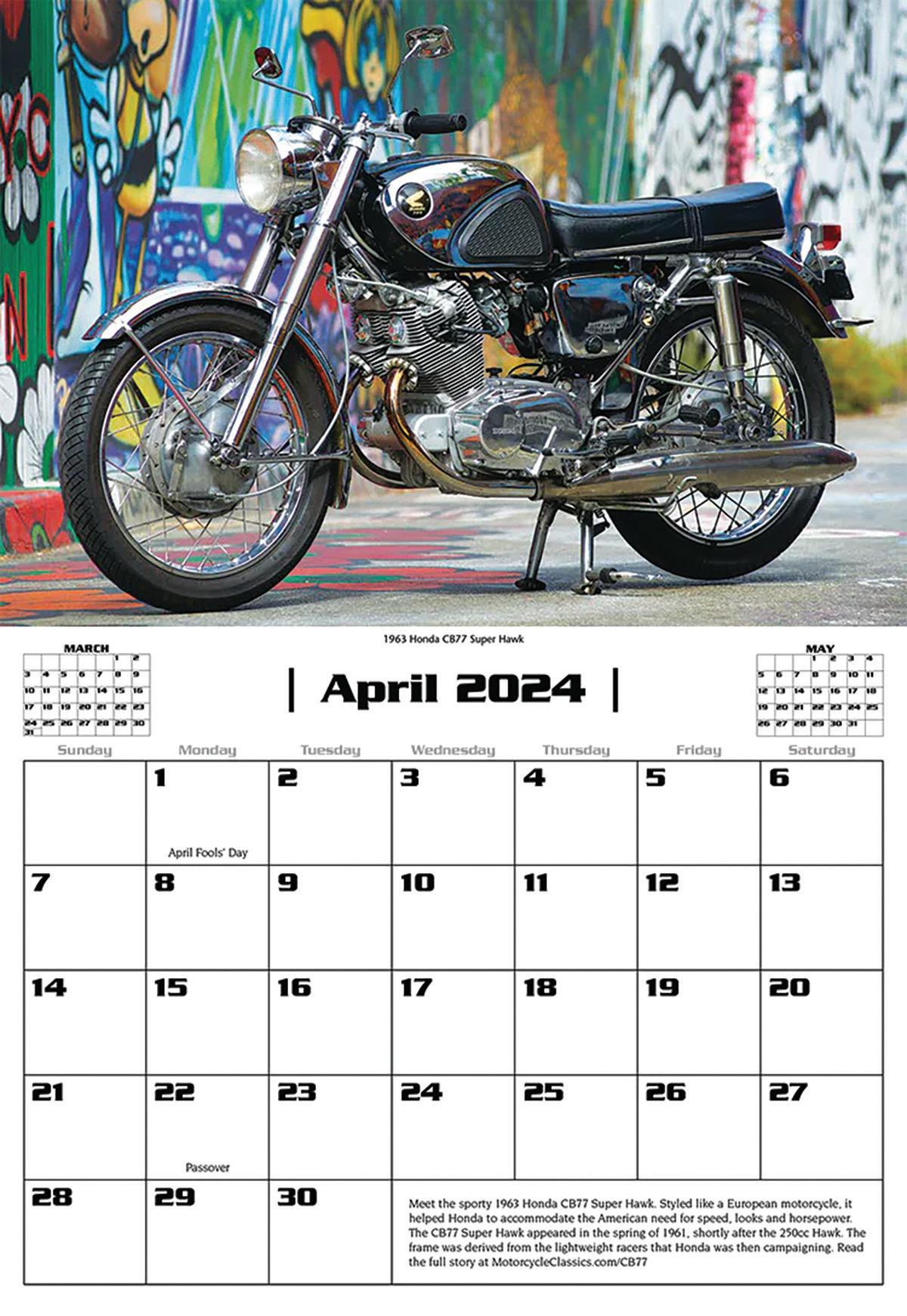

Enjoy stunning, classic motorcycles year round with the Motorcycle Classics 2024 calendar! This calendar features glossy photographs of your favorite classic bikes from Ducati to Suzuki, BMW to BSA and more. This calendar will look perfect in any office, garage, or man cave. Its the ideal gift for any classic motorcycle enthusiast! CALENDAR 202 4 Call 800-880-7567 or visit Store.MotorcycleClassics.com to order. Item #12100 | Promo Code MMCPANZ2 Classics man cave. Its motorcycle enthusiast! MEMBER PRICE: $17. 99 REGULAR PRICE: $19 . 99
TWO-STROKE TEMPLATE
1955 Adler MB250 Road Test
TThe parallel-twin 2-stroke engine, both air-cooled and liquidcooled, has arguably delivered more thrilling performance to more people at an affordable cost than any other two-wheeled 20th century engine format.
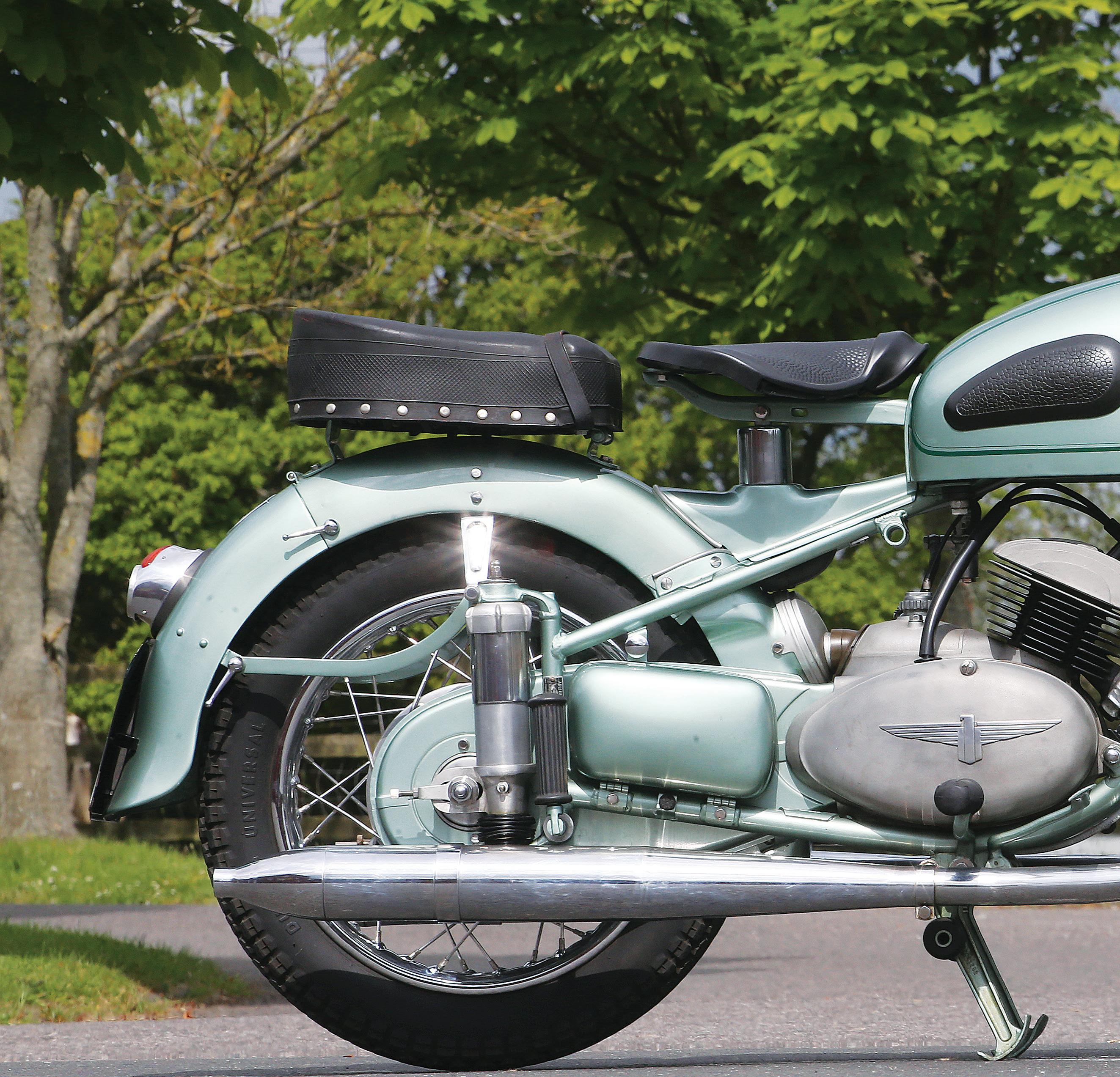
But contrary to popular belief it wasn’t dreamed up in the Hamamatsu factories of Japanese manufacturers Yamaha, Suzuki and Kawasaki, even if they were the ones who ultimately exploited it the most.
Over the years between them they’ve produced more than one million such devices, which their Honda rival’s patriarch Soichiro Honda always disdained as so-called “stink wheels.” They were crude and dirty devices which had no place in his company’s lineup — except, that is, for powering the first-ever Honda

52 MOTORCYCLE CLASSICS September/October 2023
Story by Alan Cathcart
Photos by Kel Edge
Dream motorcycle he built in 1949!

Instead, credit for initially developing this engine layout belongs to West German manufacturer Adler, 11,000 examples of whose air-cooled MB250 model were built and sold between 1953 and 1957, when this old-established company ceased manufacturing motorcycles. Adler — German for “Eagle” — was founded in 1886 in Frankfurt by the far-sighted Heinrich Kleyer, originally as a manufacturer of bicycles, of which it had built more than 100,000 examples by 1898. In 1895 Adler also began producing typewriters, before in 1900 diversifying into motor cars, and then in 1902 into motorcycles. But these lasted only until 1908, when manufacture ceased in order to
Adler grows
Adler expanded greatly as a car manufacturer both before World War I and after. By the start of the 1930s it had become Germany’s third largest such company, after Opel and AutoUnion. As such, Adler’s factory was inevitably a target for Allied bombing during World War II, but in the postwar era the company had the good fortune to find itself placed under the control of the American occupying forces, meaning that it and its fellow West German neighbors enjoyed freedom
www.MotorcycleClassics.com 53
allow the company to concentrate its resources on building motor cars.
to regenerate in the Allied sector, safe from the economic depression and political oppression of the Russian Zone. Nevertheless, thanks to the cost of rebuilding and re-equipping the ruined factory it was decided Adler would cease making cars, and instead focus on producing typewriters, calculators — and motorcycles, for which there was a buoyant market in a country struggling to rebuild itself from the ravages of war, partly with the help of U.S. Marshall Aid money.
So Adler motorcycle production resumed in 1949 after a 40-year hiatus with the M100, a 98cc air-cooled 2-stroke single designed by the company’s CEO and Chief Engineer, Hermann
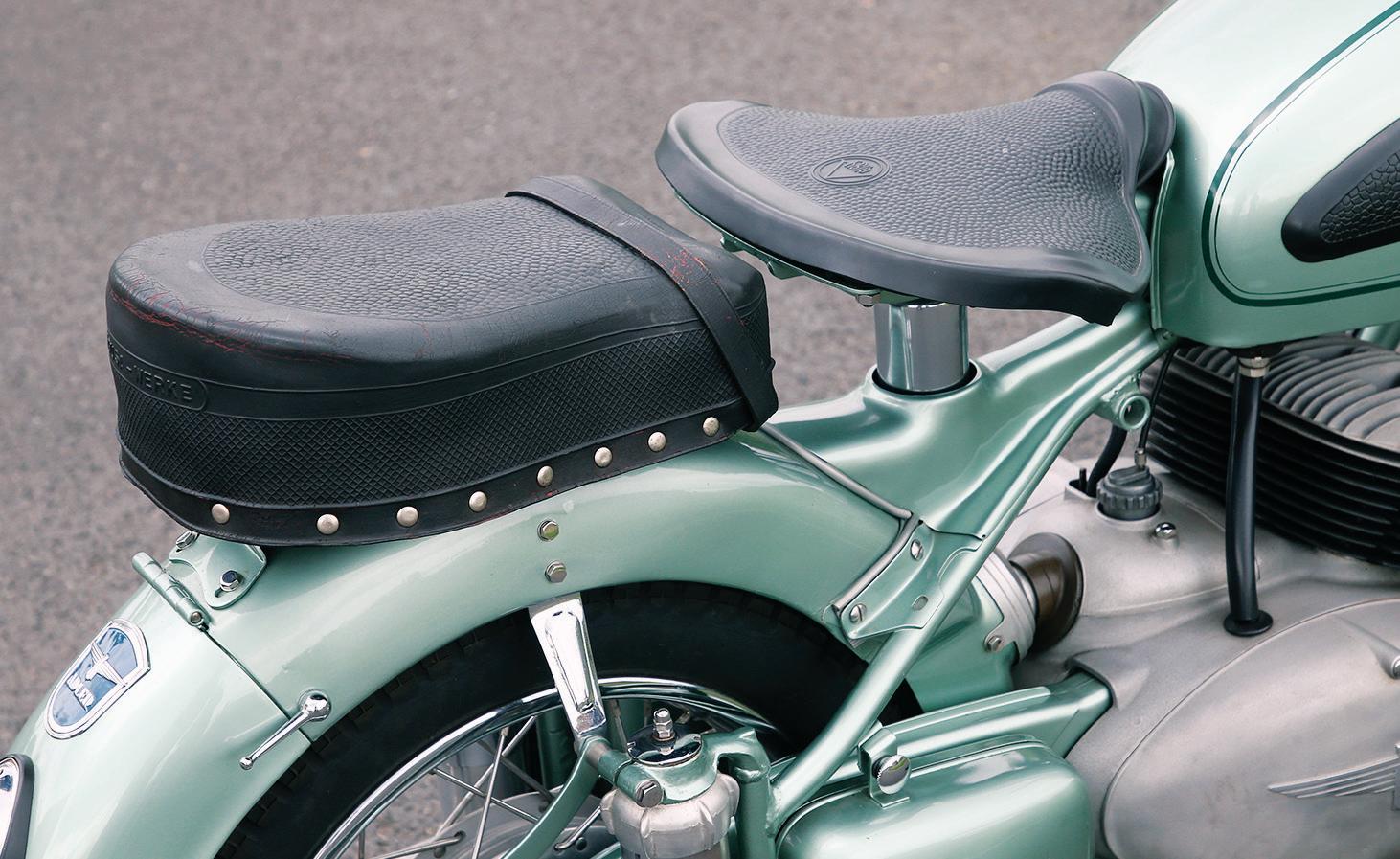

1955 ADLER MB250
Engine: 247cc air-cooled 2-stroke parallel twin, 54mm x 54mm bore and stroke, 5.75:1 compression ratio, 16hp @ 5,600rpm
Top speed: 73mph (117kmh)
Carburetion: Single 22mm Bing
Electrics: 6v battery and coil with 90W dynamo
Gearbox: 4-speed with gear primary drive
Clutch: Multiplate oil-bath
Frame/wheelbase: Tubular steel duplex cradle frame/49.6in (1,260mm)
Suspension: Leading-axle telescopic fork with torsion bar springing front, hydraulically-damped dual plungers rear, adjustable for preload
Weight (dry): 320lb (145kg)
Brakes: 7.1in (180mm) single-leading-shoe drums front and rear
Tires: 3.25 x 16in front and rear
Seat height: 29.5in (750mm)
Fuel capacity: 4gal (15ltr)
Friedrich. This was followed two years later by bored-out 123cc M125 and 147cc M150 variants. In 1952 a new 195cc MB200 parallel-twin model measuring 48mm x 54mm was launched, leading one year later to the MB250 version, whose air-cooled 247cc piston-port engine with 180-degree crankshaft (so, one up/one down) measured a “square” 54mm x 54mm. Its immediate success meant this was the engine openly copied by Yamaha in developing its YD1A weighing a mere 220 pounds, production of which began in February 1957 — the year it defeated Honda’s hitherto dominant (but crucially 44 pound heavier) RC71 to win the second running of the Asama
Highlands Race with first, second and third places in this crucially important contest for the fast-growing Japanese home motorcycle market, with more than 200 different manufacturers fighting for market share.
Yamaha Motor founder and president Genichi Kawakami had specifically instructed his engineers to copy the Adler MB250, with consequent commercial success, and while no such direct mandate is known to exist in this case, it’s widely recognized that eminent British designer Val Page drew significant inspiration from the Adler for the creation of his 250cc parallel-twin 2-stroke Ariel Arrow and Leader models, a combined total of 35,500 examples of which were manufactured between their 1958 launch and the end of Ariel motorcycle production in 1967.
Success of the 250
The Adler MB250 quickly became known as the Kanonenkugel or Cannonball, thanks to the excellent performance of its piston-port 2-stroke engine which developed 16 horsepower at 5,600rpm. This was sufficient to propel what was a substantial and well-made but thus relatively heavy model weighing 320 pounds dry to a measured top speed of 73mph. Its quite broadly-splayed twin-loop
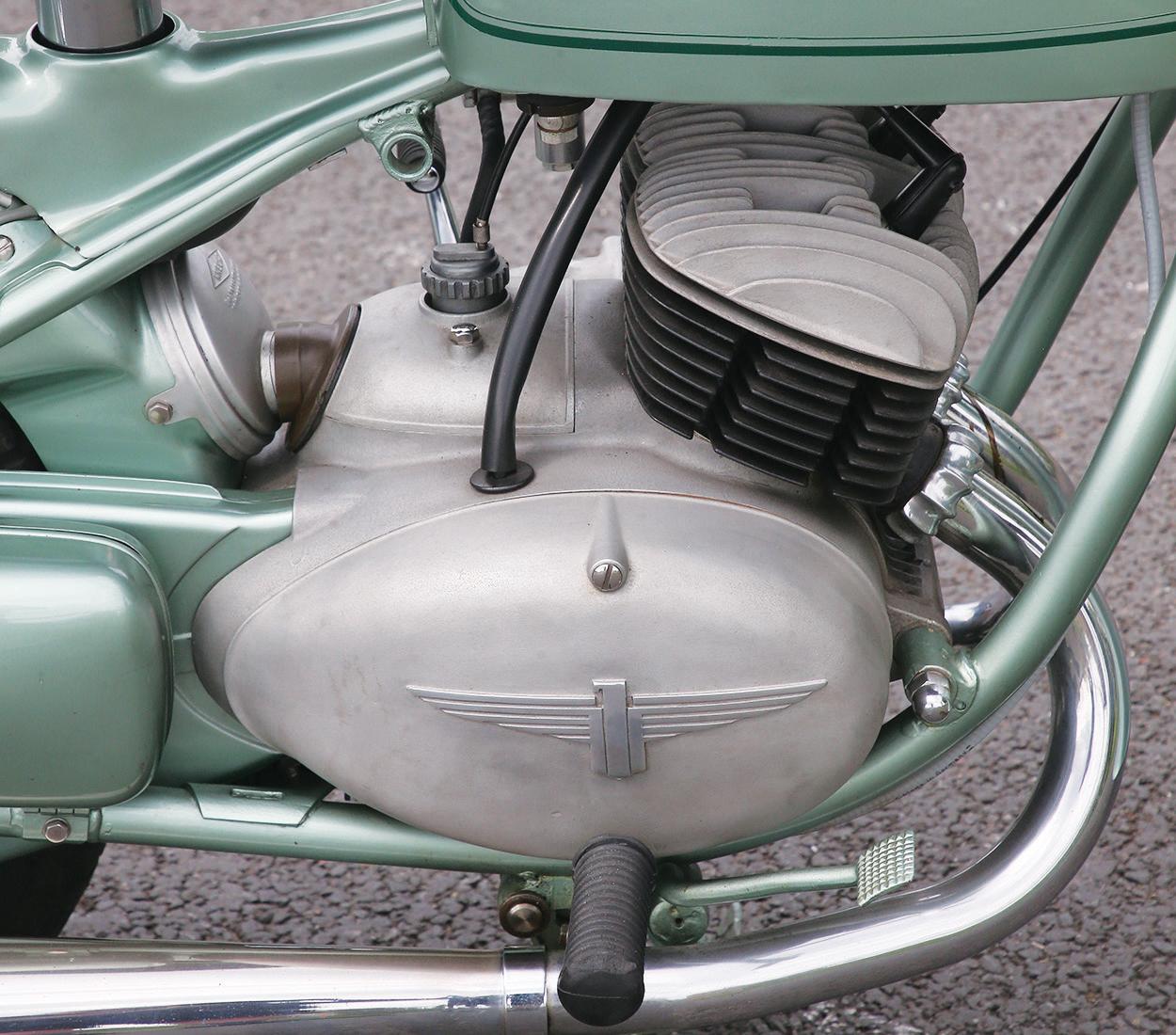
tubular steel cradle frame carried a telescopic fork suspended from a fork crown pivoting bicycle-like at a 27-degree rake in the steering head — a similar layout to that later adopted by Page on his 250cc 2-stroke Ariel models, thus providing further ammunition to those who believe that these were heavily inspired by the earlier Adler. On that, the hydraulically damped fork legs each carried an aluminum housing at their lower ends containing clock-type coil springs operated via a cam by the leading links in which the axle was mounted (the Ariels had trailing links). At the rear, the plunger suspension was much more sophisticated than anything similar from a British manufacturer, with hydraulic damping and a provision for load adjustment via radially-finned cap nuts on top of the plunger housings.
Available either in black or a distinctive and classy-looking polychromatic green, the standard touring version of Adler’s range-topping motorcycle was soon joined by the black MB250S sports model, with an improved 18 horsepower at 5,800rpm engine performance thanks to modified twin highrise exhausts and altered cylinder porting, which was good for a top speed of 78mph. Both these models used a single 22mm Bing carburetor feeding both cylinders, but in 1954 the
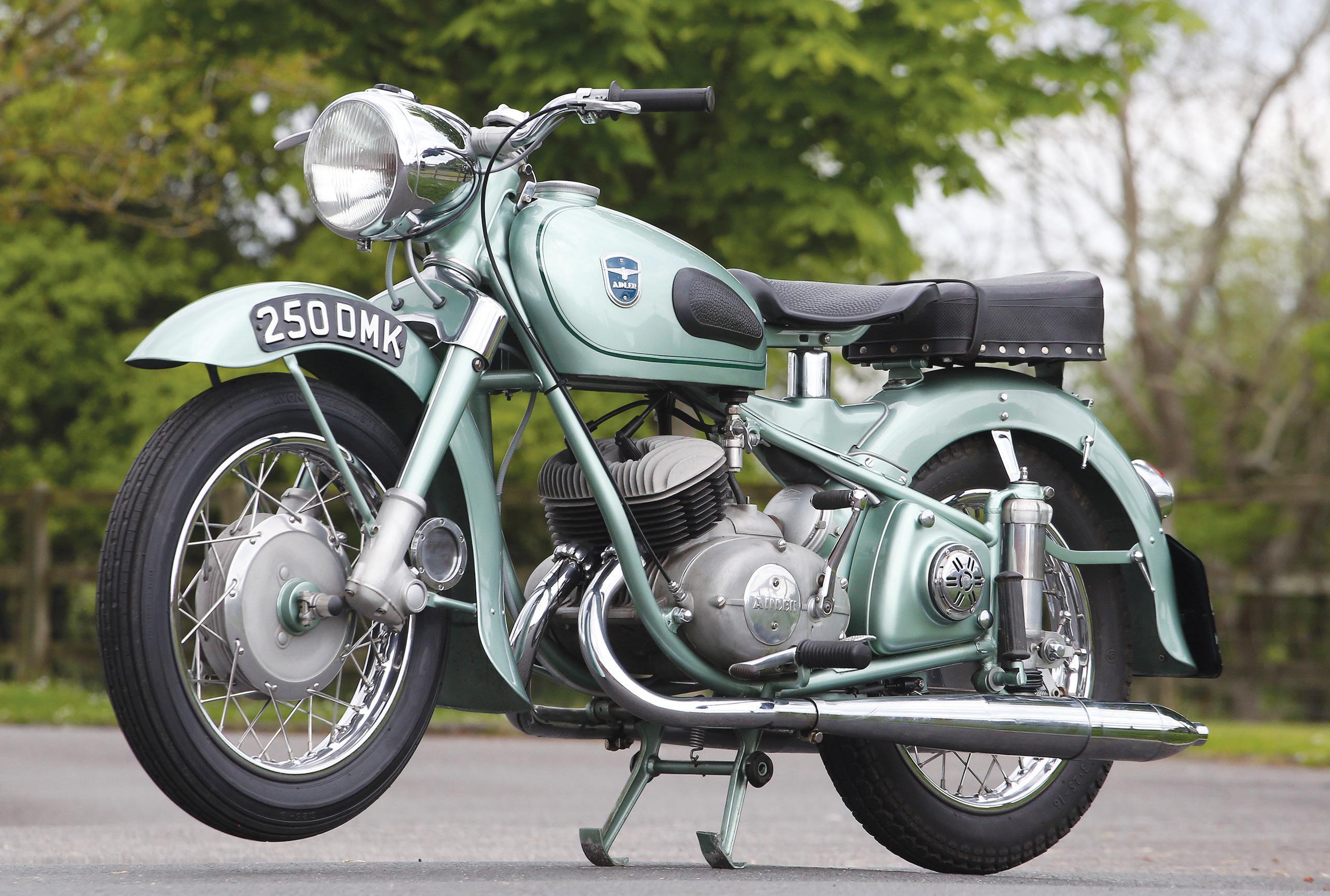
www.MotorcycleClassics.com 55
Unit construction Adler engine is compact and refined.
Adler RS250 racing version appeared, fitted with twin 24mm Amal TT carburetors and a lighter frame, with swinging arm rear suspension incorporating twin shocks rather than plungers. Still air-cooled, this weighed just 216 pounds and developed 26 horsepower at 7,500rpm, so it was capable of a top speed of 106mph in bringing success to the privateer owners of the ten examples built and sold by the Adler factory. A liquid-cooled version of this was later produced, initially by the factory racing department. But after the company stopped making bikes in 1957, development was continued by privateers like Dieter Falk, who finished fifth in the 1958 250cc World Championship on a home-tuned RS250 twin, with two third place rostrum finishes in the Dutch TT at Assen and his home German GP at the Nürburgring, as well as a magnificent fifth place in the Isle of Man Lightweight TT.
Also successful as an Adler RS250 racer was ski instructor Günter Beer, who in a summer-long break from his winter job ended up 7th in that same 1958 250cc World Championship with two fourth-place finishes in the Swedish GP at Hedemora and the Italian GP at Monza. Beer also won the German 250cc Road Racing Championship five times in succession from 1962-1966. By this time a claimed 39 horsepower at 10,000rpm had been extracted from the 247cc Adler engine using technology filtering through the Iron Curtain from MZ in East Germany, raising the bike’s top speed to 125mph. Motocross
and Enduro offroad versions were also developed, and raced successfully up to and including at MX GP and ISDT level internationally.
Production of the Adler MB250 road version continued only until 1956, when it was replaced by the Favorit and the MB250S by the Sprinter, both models carrying the same parallel-twin 2-stroke engine, but now fitted in new frames with the swinging-arm rear suspension that had been developed in competition. That year, Adler merged with fellow motorcycle — and typewriter — manufacturer TWN/Triumph-Werke Nürnberg AG, a distant relative of the British Triumph brand. But just one year later in 1957 the combined company was purchased by West Germany’s largest manufacturer of televisions and radios, Max Grundig, also a pioneer in developing tape recorders that were the world’s first home audio recording devices. Grundig wanted Triumph-Adler as his business machine division, and therefore shut down motorcycle manufacture immediately on acquiring the company. The Eagle had landed — but in the office, rather than the open road.
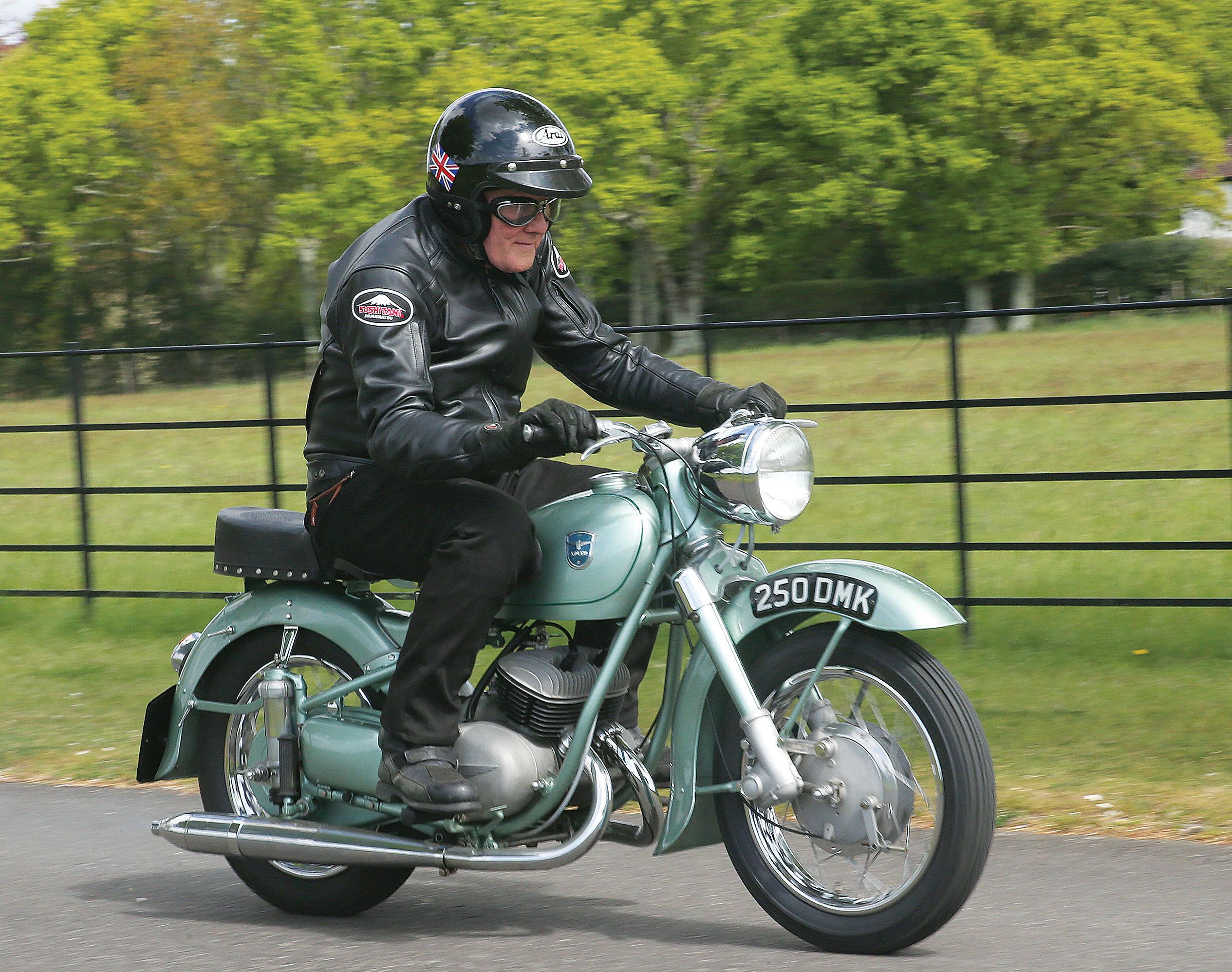
Our feature bike
Adlers are rare birds in Britain because very few were imported here before production ended in 1957, and those that were cost as much as locally-made 500cc 4-stroke OHV twins — the 2-stroke revolution had been slow to catch on
56 MOTORCYCLE CLASSICS September/October 2023
Cruising at 50mph was relaxing and smooth, with no vibration from a well-balanced engine.
before the debut of the Ariel Leader later that same year. But just such a rarity is inevitably to be found in the Sammy Miller Museum (sammymiller.co.uk) on England’s South Coast — though there’s a personal reason for Sammy to have acquired an Adler MB250 for the Museum Trust, other than the significance of the bike’s design in the history of motorcycle development.
“When I joined the Ariel factory’s Competition Department in September 1957, it was the week after I’d finished riding for the Mondial factory in Grand Prix road racing,” he says, too modest to mention that he finished third in that year’s 250cc World Championship on the Italian team’s DOHC single. “Often that year in different races there’d be a 2-stroke Adler running fifth or sixth behind the MVs and Mondials, and because I was interested in new technical aspects I’d go and have a close look at them. So when I got to Ariel’s just as they were launching the Arrow and the Leader, I knew what I was looking at when I saw an Adler engine in the development shop! Although I was there to develop the Trials model, they asked me to race an Arrow 250 in the Thruxton 500-Miler, and the engine was superb, fast and reliable. So when I established the Museum I wanted to have an Adler in the display, and a local friend Ian Munro had bought one and restored it, which we were able to put on display before later acquiring it from him. It’s a very fine design, which was well ahead of its time — too bad Mr. Grundig didn’t realize what he’d purchased when he bought Adler, and chucked their motorcycles in the rubbish bin, as of course the Japanese then took the same identical format, and went on to make millions of them. What a terrible missed opportunity that was!”
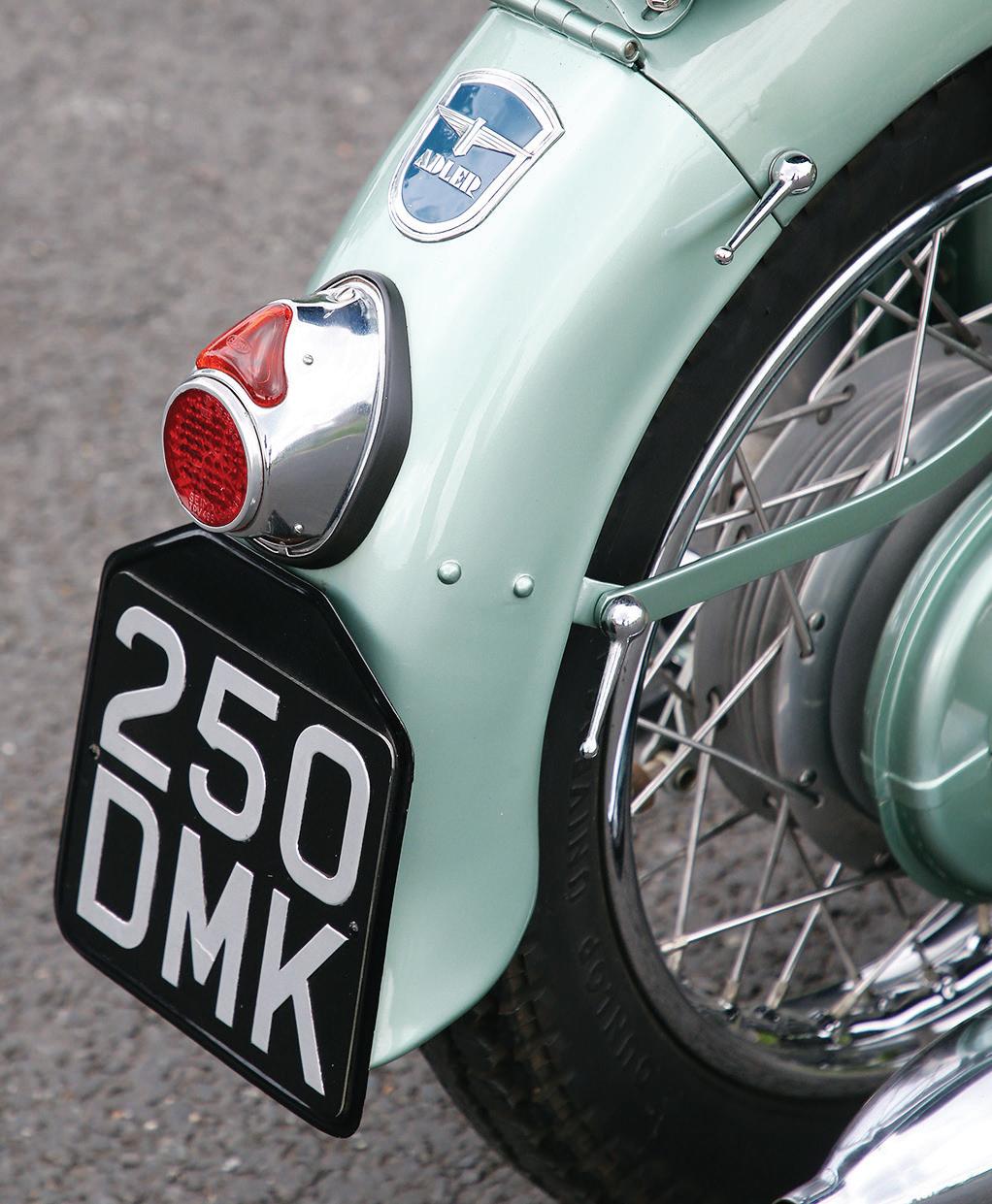
In the metal
The clean-looking unit construction Adler power unit incorporating the engine internals, clutch, 4-speed gearbox, carburetor and twin ignition coils all in one housing is both compact and refined in appearance. The separate cast-iron cylinders have twin transfer ports and a single exhaust, while behind the outer covers of its high-quality one-piece crank-
Valanced rear fender lifts to permit wheel removal. The 7.1-inch (180mm) SLS front drum brake lacked bite, but the same size rear drum was quite the opposite.
case casting lies sufficient space for the twin separate cranks to be inserted, then joined together via a coupling patented by their manufacturer, Hirth. This followed the same format as the Hirth coupling on the NSU Rennmax parallel-twin on which Werner Haas won the 1953-1954 World 250cc road racing titles, which sees the serrated joints in each crank drawn together by means of a differentially-threaded through-bolt whose likewise serrated head is tightened via a special splined tool inserted through a hole in the right hand flywheel. This forms an extremely rigid three-bearing crank assembly, at the expense of a higher manufacturing cost, and being time-consuming to strip down — although this can be done with the engine still mounted in the frame. A roller main bearing and two sealing rings are located in the center web of the crankcase, with the complete crank assembly supported at each end in main bearing housings incorporated in the crankcase sidewalls. The 22mm Bing carburetor sits centrally behind the cylinders and is mostly hidden, bar its tickler primer, fed by fresh air drawn in via a grille in the rear fender, while the Bosch ignition with both its coils and its 90W dynamo are fully enclosed. The multiplate oil-bath clutch sits on the end of the crank, outside the helical gear primary drive. It thus operates at engine speed, with a gearshift format which sees neutral at the bottom of the foot pedal stroke, rather than between first and second gears. The Adler’s many attractive detail touches include a fully enclosed chain; a central steering head damper whose large knurled knob incorporates a steering lock; interchangeable front and rear 16-inch wheels; a horn mounted in the outer cover of the battery box mounted low down behind the rider’s left foot; and a lockable toolbox on the opposite side whose sturdy lid folds out to act as a tray for the extensive toolkit. These all set the Adler above its contemporaries in the marketplace, and there’s even a switch on the headlight which alters the angle of the reflector to compensate for the load differential when a passenger is carried. This is a very well thought out, typically rational Teutonic motorcycle, with a sense of substance and high build quality.

www.MotorcycleClassics.com 57
Let’s get moving
Climbing aboard the Sammy Miller Museum’s MB250 carrying frame No. 30C424, which the chassis plate denotes as being a 1955 model, revealed a right petite bike that’s quite low slung, partly thanks to the 16-inch wheels. Despite this and the compact 49.6-inch (1,260mm) wheelbase, the Adler’s riding stance wasn’t cramped for my 5-foot 10-inch stature, since the well-sprung rubber composite Brunighause saddle is mounted on a sturdy pillar which is easily adjustable for height. There’s a separate Pagusa-Werke passenger seat pad behind the rider’s saddle with a strap across the front, but no handgrips or anything else for him or her to hold on to.
The gracefully valanced fenders convey a sense of style worthy of a 1940s Indian Chief, with the rear one hinged just behind the pillion pad to allow removal of the wheel, when necessary. The interchangeable wire-spoked wheels’ chromed steel rims each carry a 3.25 x 16-inch tire, and a 180mm diameter single-leading-shoe drum brake incorporated in each fairly sizeable (in terms of breadth) cast aluminum hub. Although seemingly identical, these had quite different responses. The front brake was poor, with a lack of bite even when I squeezed the lever hard, while the rear one was quite the opposite, with a very fierce response to the right-foot pedal which I reckon would have locked the wheel on damp tarmac. But at least it
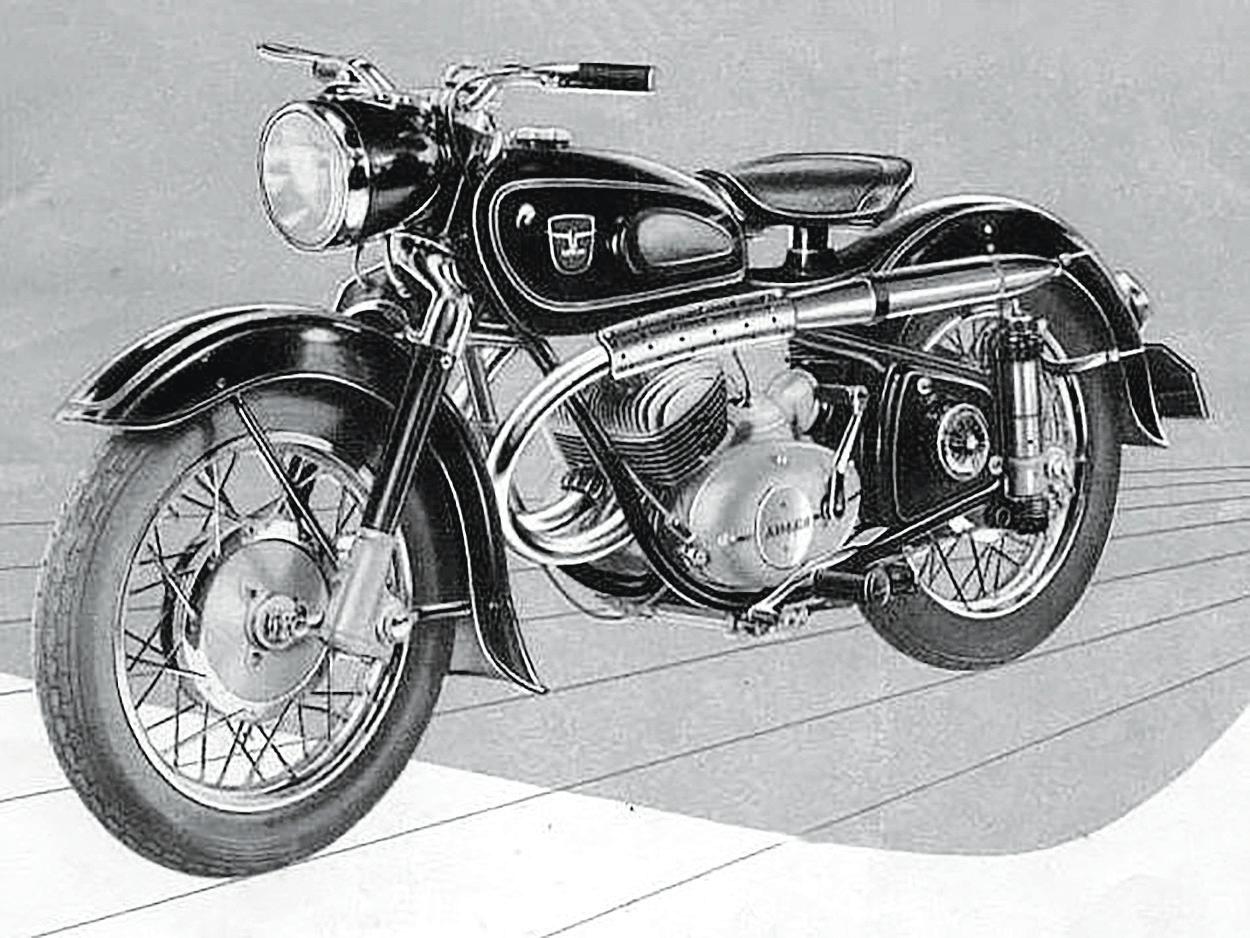
worked — an important requirement at the best of times, but especially so aboard a 2-stroke with zero engine braking!


This came about once I’d inserted the ignition key in the lock mounted in the handsome chromed headlamp shell, twisted it to the right and watched the red ignition light illuminate in the top left of the 90mph VDO speedo. The fact this was calibrated in miles shows this bike was one of Adler’s rare U.K. imports when new back in 1955, and the 52,440 miles shown on the odometer is probably a genuine figure before restoration. I tickled the Bing carb and then prodded the 2-stroke twin into life via the slightly awkward inwardfolding left-foot kickstarter — it was actually more convenient to stand alongside the Adler to do this rather than standing astride the bike, owing to the rather high rearwards location of the lever. The muted ring-dring burble emanating from the twin exhaust silencers sounded like countless Yamahas and Suzuki twins I’ve ridden down the years — except the Adler was first, so they all sounded like it!
I then took off on my afternoon ride along the leafy New Forest lanes surrounding Sammy’s Museum by pulling the fairly light-action clutch lever and lifting the Adler’s gear lever with my left toe to insert bottom gear, with three more awaiting a similar upwards movement by kicking said lever with my heel. Considering the Japanese manufacturers all used German bikes like the Adler as paradigms to copy in developing their new models — Pa Honda bought an NSU Max when he visited the German factory in 1954, and the DKW RT125 single was the first motorcycle which Yamaha’s president Genichi Kawakami had instructed his engineers to copy, in creating its first-ever motorcycle in 1954, the 125cc YA-1 — it’s strange they didn’t copy this more rational format for gear selection, with up for up and neutral at the bottom, but instead put neutral in between first and second gear, like on Italian and British motorcycles. Once I’d programmed my mind properly to stop hunting for bottom gear in the wrong place, I really liked the Adler’s gearchange pattern.
Also pleasing was the smooth pick up from low revs via the light-action
58 MOTORCYCLE CLASSICS September/October 2023
RS250 racer uses twin 24mm Amal TT carbs, a lighter frame, with swinging arm rear.
Sportier 18hp MB250S topped out at 78mph. Air-cooled 250cc parallel-twin was the benchmark for later Japanese copies.
throttle, with surprisingly little need to wind the throttle up on the clutch to obtain forward motion. But I didn’t care for the Adler’s rocking pedal gearshift, because my ankle kept rubbing against the kickstarter crank when I shifted upwards, probably because the lever’s heel pad is either too small or too tucked in. First to second gear is quite a slow change, anyway, probably because there’s quite a big gap in the ratios, maybe because of a low bottom gear to take account of getting off the mark with a passenger aboard. But the upper three ratios are all more accessible and closer together, and it was easy to flick between them to optimize the Adler twin’s performance. The engine was pretty willing once I’d got into second gear, with everything smoothing out once I’d got up to 35mph in top gear. Cruising at just over 50mph in top according to the speedo was both relaxing and smooth, with no real discernible vibration from what is obviously a very well balanced engine.
In keeping with this the Adler’s ride quality was excellent, the plunger rear end coping adequately well with bumps and ripples in the tarmac, despite what I presume is a limited wheel travel commensurate with the design — I can’t find the actual figure anywhere, but unlike most other such plunger designs which were barely better than a rigid rear end, I could honestly feel the Adler’s rear suspension actually
The Sammy Miller Museum


The Sammy Miller Museum (sammymiller.co.uk) in New Milton, Hampshire, U.K., is crammed full of interesting machines — including factory prototypes and numerous ingenious designs from all over the world. It also counts one of the world’s largest collections of exotic racing bikes, all of them in running order and including the legendary Moto Guzzi 500 V8, the supercharged AJS 500 V4 and post-war Porcupine, and innumerable famous bikes from Triumph, Norton, AJS, Velocette and many more. There are also offroad enduro, motocross and trials icons. The museum is open to visitors daily from 10 a.m. year-round.

working. The front suspension was also pretty compliant, if a bit bouncy, as if there wasn’t much damping being brought to bear on those coil springs in the fork housings. Moreover, the low center of gravity delivered by the small wheels and the Adler’s low build helped it shrug off any early traces of instability if I hit a bump in the road surface when leaned over. This is a forgiving little bike which punches above its cubic capacity, and after riding it I can see why it was so successful in German dealer showrooms against pretty stiff competition. Too bad Herr Grundig didn’t maximize his profit from acquiring Adler by selling its motorcycle division on — although his purchase of the company coincided with a steep decline in motorcycle sales in the German home market owing to the concurrent boom in small cars, a decline which saw the country’s formerly largest bike manufacturer Horex go to the wall in 1958. Adler might have done the same, if not for the Grundig acquisition.
Timing is everything, so they say — and the Adler MB250 was the right bike at the right time in 1953, but four years later its time had been and gone. It was Yamaha’s turn, followed by Suzuki and Kawasaki, to fly the twin-cylinder 2-stroke banner, and make billions of Yen out of doing so both in Japan and in export markets all over the world. MC

www.MotorcycleClassics.com 59
DESPITE BEING ONE OF THE MOST successful motorcycles of all time, the Royal Enfield Bullet has had a very chequered history. Its story begins in the 1930s, and by the 1950s, it was at the height of its popularity in post-War Britain. Then it became a stalwart of the Indian Army, and manufacture transitioned from Britain to India. The near-collapse of the Royal Enfield marque in the 1990s almost meant the end of this classic motorbike, but with the involvement of the Eicher Group from 2001 onwards, the updated Bullet generated new interest and renewed its original commercial success, just like a phoenix rising from the ashes.
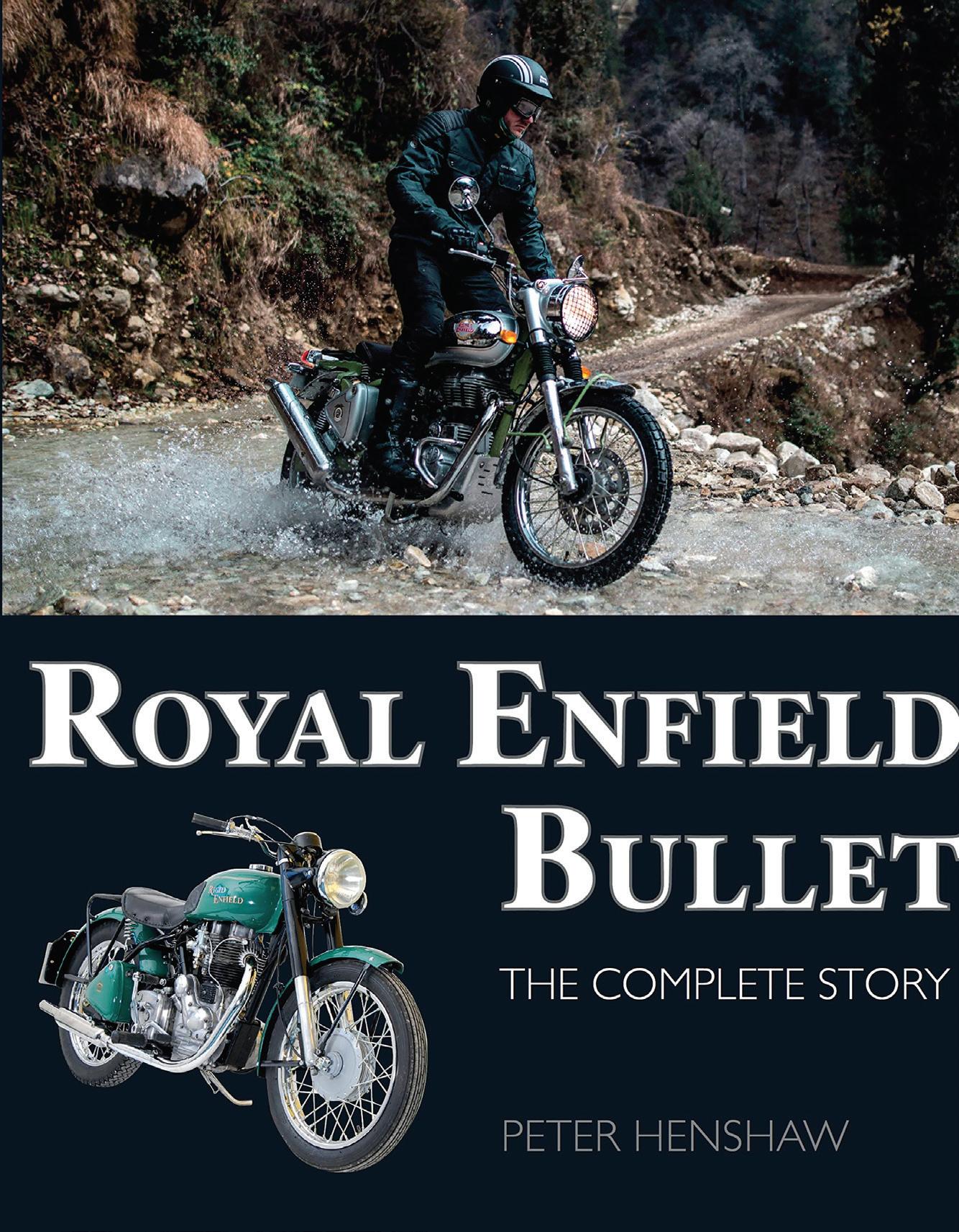






With more than 200 photographs, this book describes the origins of the Royal Enfield company and the pre-war Bullets from 1932 and the relaunch of the Bullet in 1949 with its radical swinging-arm frame. Derivative models such as the 350 and 500 and those for competition and road are covered as well as specials such as diesels, V-twins, Egli, and big-bore Bullets. The development story behind the lean-burn, electric-start, and 5-speed updates is discussed, the UCE - the all-new Bullet from 2008 and the Classic and its design story. Finally, the evolution beyond the Bullet is covered, which includes the Continental GT and Himalayan 650 twins.


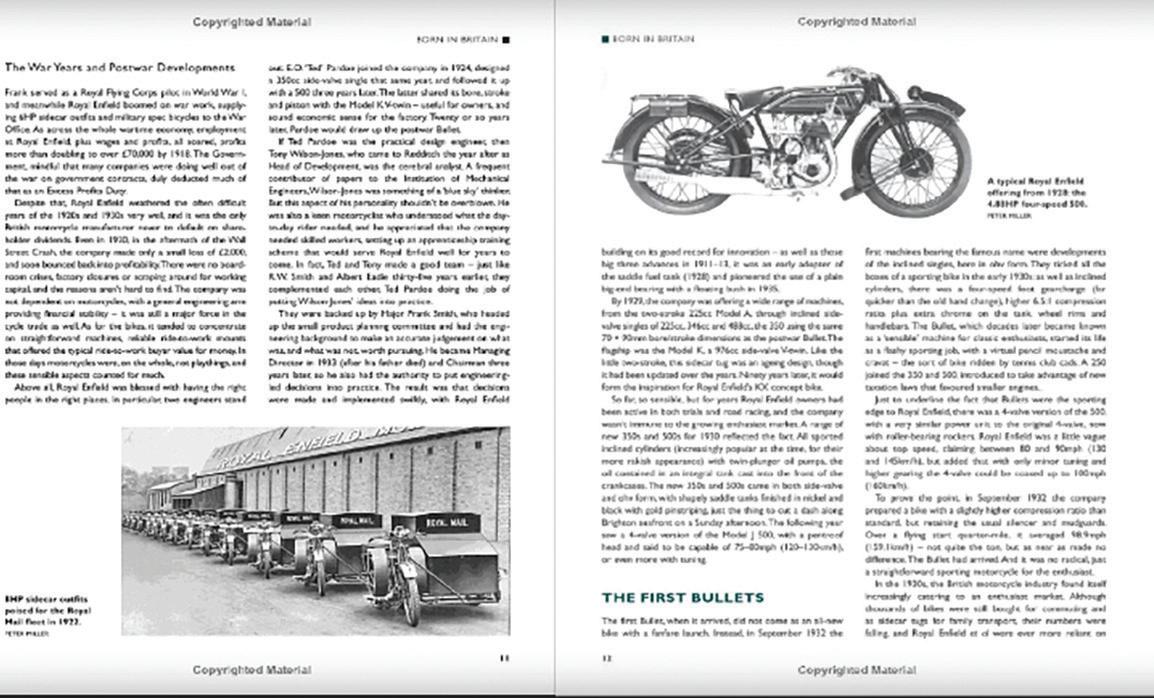

Includes over 200 photographs! To order, call 800-880-7567 or visit Store.MotorcycleClassics.com Mention promo code MMCPANZ2 Hardcover, Item
$36.99, Members: $31.44
#11902
JERRY AND THE JERSEY DEVIL

A Half Century on a 1966 Honda 305 Scrambler
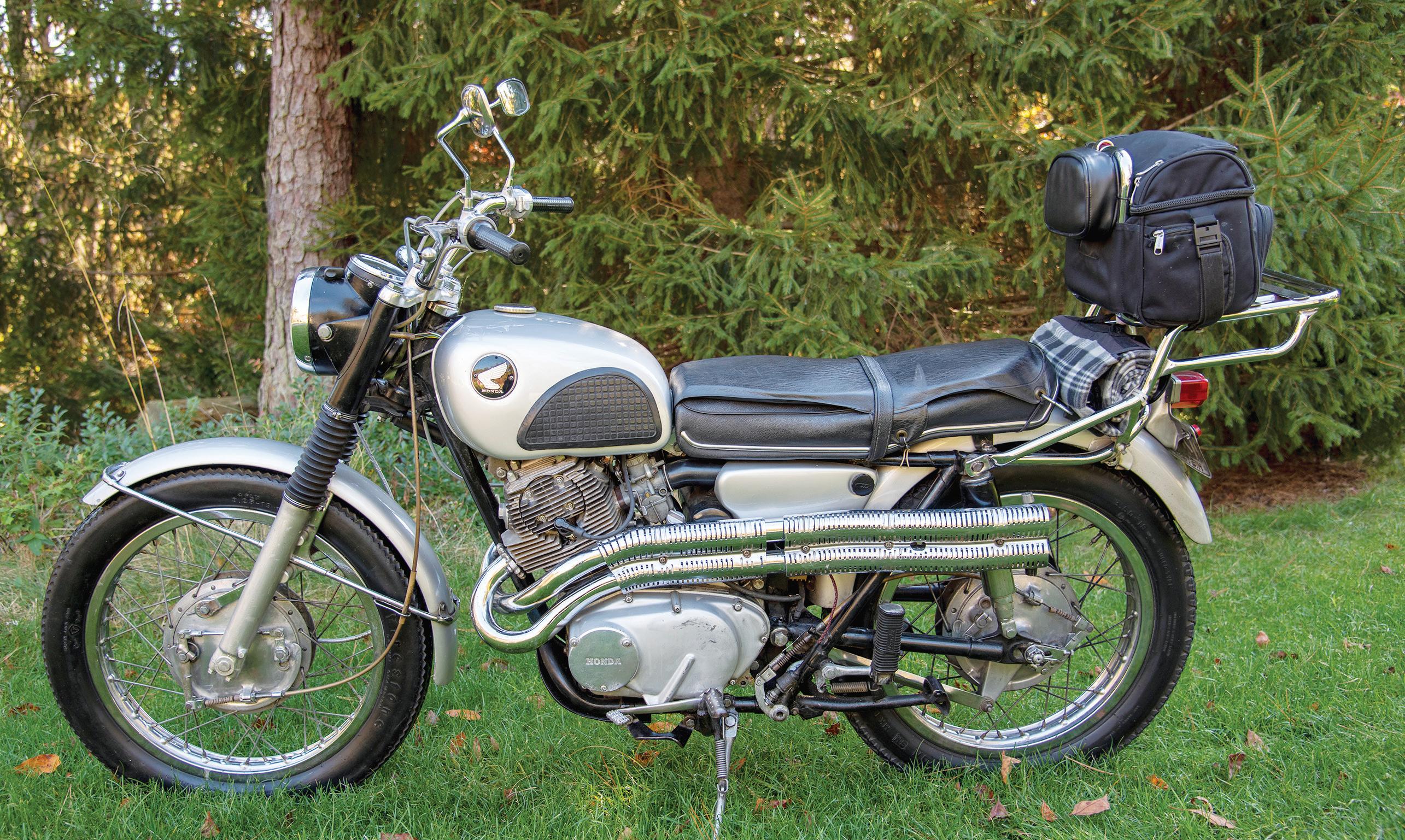 Story
Story
OOur story here is about a special 1966 Honda 305 Scrambler, a motorcycle owned for a cool half century by my friend Jerry Dowgin, but the story needs background to provide context.
To riders of a certain age, the words “Honda” and “305” hold special meaning. Anyone with even a passing interest in vintage motorcycles knows the Honda story and how it changed the world. Triumph’s Edward Turner saw it coming when he visited the Honda factory in Japan in the 1960s and urged Triumph to prepare. Turner’s words fell on deaf ears while Triumph, the rest of the British motorcycle industry, and Harley-Davidson soldiered on, oblivious to the emerging giant that was the Japanese motorcycle industry. Small bikes, a well-marketed succession of moves up to larger bikes, the Honda CB750, Japanese motorcycle dominance: It was a brilliant marketing strategy complemented by design and manufacturing excellence, and it resulted in one of the most successful companies the world has ever known.
Honda’s strategic triad
Much of Honda’s success was due to the technical excellence and success of the Honda 305s. There were three: The Dream, the Super Hawk, and the Scrambler. At the time, they were the biggest motorcycles Honda made.
The CA77 Honda Dream was not an offroad-styled motorcycle (that was the CL77 Scrambler’s domain) or a performance motorcycle (that call was answered by the CB77 Super Hawk). The Scrambler and the Super Hawk appealed to more serious motorcycle enthusiasts; the Dream was a much less intimidating ticket into the motorcycle world. The typical Dream buyer was either someone stepping up from a smaller Honda or someone who had not previously owned a motorcycle. Honda first used the name “Dream” on its 1949 Model D (a single-cylinder, 98cc 2-stroke) and no one knows where the Dream moniker came from (legend has it that someone at Honda upon first seeing the Model D, proclaimed it to “look like a dream”). Some say Honda based its forward leaning parallel 250/305cc engine design on an earlier NSU engine, but Honda unquestionably carried the engineering across the finish line (when was the last time you saw an NSU?). The Dream’s 305cc 360-degree engine had a single 23mm Keihin
www.MotorcycleClassics.com 61
and photos by Joe Berk
carb and it produced 23 horsepower at 7,500rpm. According to magazines of the era, the Dream was good for between 80 and 100mph (the disparity in reported top end was presumably due to motojournalist weight and perhaps prevailing headwinds). The Dream averaged 50 miles per gallon, although in those blissful days of $0.28/gallon gasoline nobody really cared. Honda built the Dream until 1969. The Dream retailed for $595 back in those days, but a shrewd negotiator could do a little better.
The second motorcycle in Honda’s 305cc strategic triad was the Super Hawk. Honda initially offered the 250cc Hawk in 1961, but it quickly evolved into the 305cc Super Hawk. The Super Hawk used a 180-degree firing order parallel twin (Honda’s Type I engine) and it was good for 28 horsepower at 9,200rpm (an unheard of engine speed back in the early 1960s). Like the Dream, the Super Hawk had an electric starter and a kickstarter that oddly rotated forward. The instrumentation was cool, too: Instead of the more conventional (i.e., British) separate cans for tach and speedo, both were contained in a single panel atop the headlight. The Super Hawk had a tubular steel frame and front forks, but no front frame downtube (the engine was a stressed frame member; the starter occupied the space where a front downtube would be). A Cycle World road test pegged the top speed at 104.6mph and the Super Hawk ran a respectable 16.8-second quarter mile with an 83mph trap speed. Super Hawks had twin-leading-shoe front brakes (something special in those pre-disk-brake days). The motorcycle weighed 335 pounds.
The Super Hawk was available in the same blue, black, white, or red color choices as the Honda Dream, but unlike the Dream, all the Super Hawks had silver frames, silver side covers, and silver fenders. I remember that most Super Hawks were black.
The Super Hawk had good media presence, long before product placement became the mega-industry it is today. There were pop songs about little Hondas, Elvis rode a red Super Hawk in the 1964 movie Roustabout, and a fellow named Robert Pirsig rode across America on a Super Hawk and wrote Zen and the Art of Motorcycle Maintenance. Pirsig’s Zen was a best seller, it became something of a bible in the motorcycle travelogue genre, and it was considered high literature even outside motorcycle circles. Pirsig’s Super Hawk currently resides in the Smithsonian Institution.
The 305 Scrambler
The Honda CL 77 Scrambler rounded out Honda’s 305cc motorcycle lineup. Honda’s Scrambler model started life as the 250cc CL 72, and then in 1965, Honda upped the displacement to 305cc. The Scrambler was a kickstart-only proposition (the frame downtube needed the real estate in front of the crankcase occupied by the Super Hawk and Dream electric starters). The Scrambler had twin carbs and redlined at 9,000rpm, where it produced 27.4 horsepower. It had slightly less compression than the Super Hawk but made more torque with its different cam profiles. Like the Dream and the Super Hawk, the Scrambler had a single overhead cam, two valves per cylinder, a 4-speed transmission and a wet clutch. The


62 MOTORCYCLE CLASSICS September/October 2023
The Scrambler’s speedo and headlight switch.
Scrambler had the Super Hawk’s Type I 180-degree firing order. With a curb weight of 337 pounds and a 52.4-inch wheelbase, the Scrambler was only slightly smaller and approximately 25 pounds lighter than a 650 Triumph. In a nod to its off road character, the Scrambler was geared a bit lower than either the Dream or the Super Hawk. The Scrambler’s suspension only had 4 inches of travel (laughable for an offroad motorcycle today), but it was more than either the Super Hawk or the Dream and motorcycle design was evolving rapidly in those days.
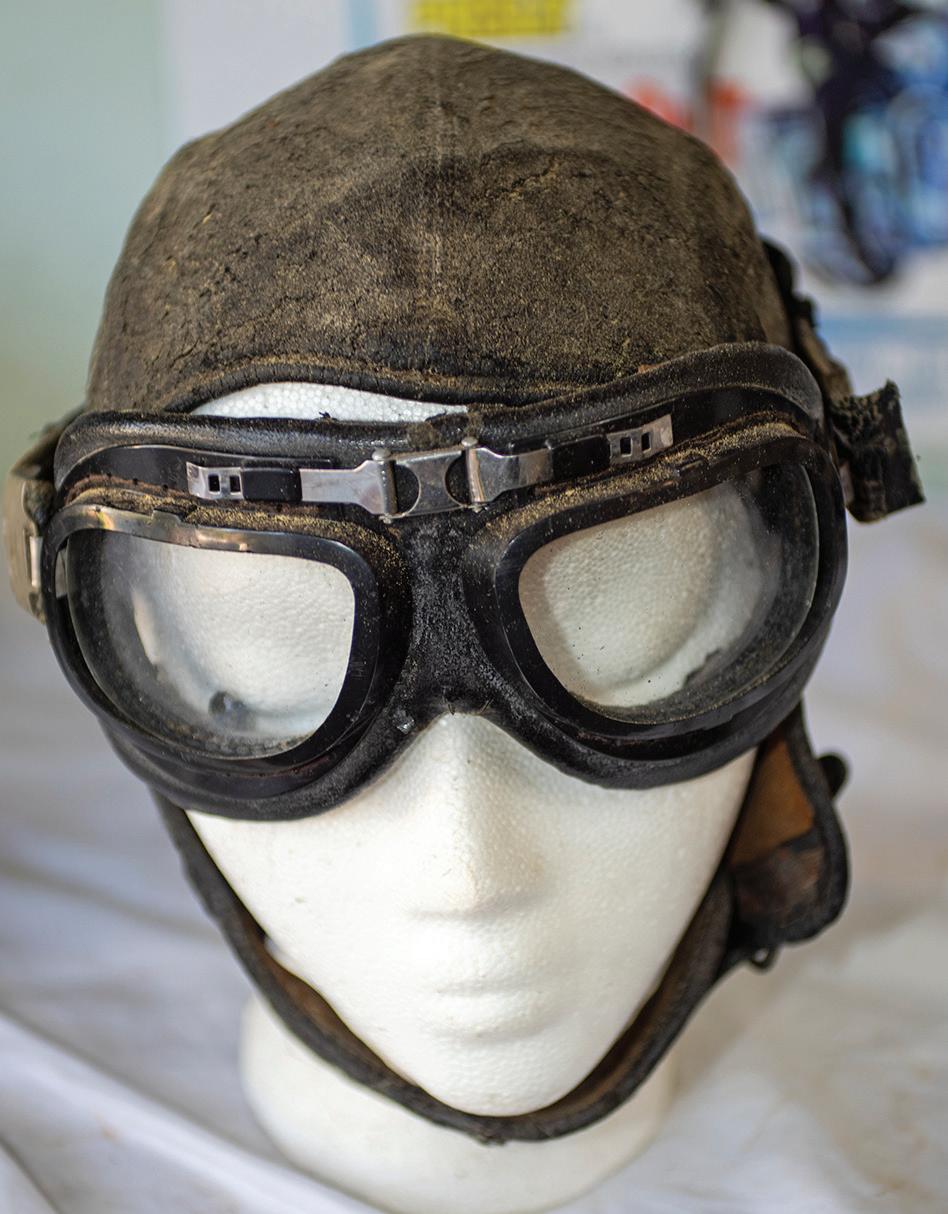

Honda, with its marketing genius, capitalized on a 1962 Dave Ekins and Bill Robertson 250cc Honda Scrambler run from Tijuana to La Paz (well before paved roads ran that far south in Baja), a ride that ultimately morphed into the Baja 1000. The Ekins/Robertson Scrambler Baja ride cemented Honda’s reputation as a manufacturer of high performance, reliable, and serious motorcycles. In 1966, a new Scrambler retailed for just north of $700, slightly below the price of a new Super Hawk, slightly more than the more sedate Dream, and about half what a new
Triumph 650 cost. Honda sold approximately 90,000 Scramblers in America.

Many felt and still feel the Scrambler was the coolest of the Honda 305s, probably because the Scrambler looked more like a Triumph than a Honda. The Scrambler had a teardrop-shaped fuel tank (with rubber knee pads!), 19-inch wheels, universal tread tires, rubber fork gaiters, a single downtube frame, and high, wide handlebars. The Scrambler’s appearance was further defined by a jaunty upswept twin exhaust pipe arrangement that ran along the bike’s left side. Both exhaust pipes merged into a single asymmetric delta-shaped muffler, which most Scrambler owners promptly ditched. Most owners replaced their Scramblers’ mufflers with aftermarket “Snuff-R-Nots” that went into the ends of both exhaust pipes (you could flip them 90 degrees to run either open pipes or a slightly less open exhaust flow). When the Scrambler’s exhaust pipes were “snuffed,” the Scrambler had a raspier, sharper, and even more offensive exhaust note. Ah, the 1960s!
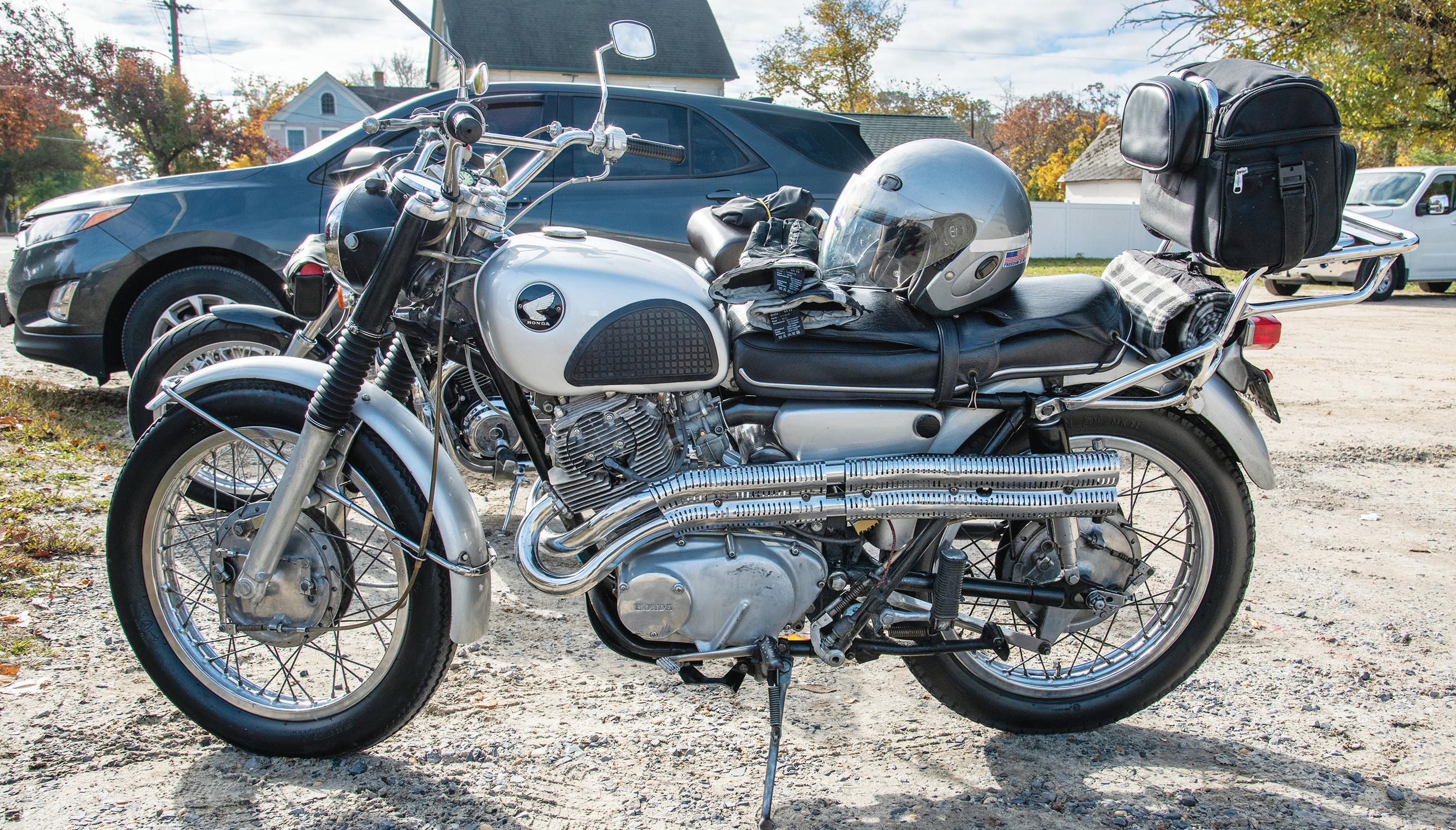 Cool kids removed the 2-into-1 muffler and added Snuff-R-Nots. Trooper Dowgin’s original leather motorcycle helmet.
Cool kids removed the 2-into-1 muffler and added Snuff-R-Nots. Trooper Dowgin’s original leather motorcycle helmet.
All three Honda 305s used a wet sump oil system, and on all three bikes, the engine and transmission shared oil. The Honda engines used horizontally split cases, a design approach that (along with vastly superior manufacturing processes and component dimensional controls) essentially eliminated oil leaks. All three Honda 250/305cc motorcycles represented radical change. Overhead cams, high rpm, electric starters (for two of the three models), 12-volt electrical systems, relatively low cost, and other features put the Japanese machines well ahead of their British and American competition. Honda’s marketing was legendary and appealed to a much wider market than any competitors. Honda’s “You meet the nicest people on a motorcycle” marketing slogan, vastly superior quality, good performance, and affordable pricing clicked with the public. Honda introduced a lot of people to motorcycling.

Meet the Dowgins
During the 1960s (in the middle of the above Honda engineering and marketing revolution), Jerry Dowgin was a football star at South Brunswick High School in New Jersey. Jerry was four years ahead of me (he was Class of ’64) and I didn’t know him at the time, but like many people in central Jersey, I knew the Dowgin name. Jerry’s father, Captain Ralph Dowgin, was a New Jersey State Trooper who rose to command Troop D, the unit
that patrolled the New Jersey Turnpike (one of the most heavily traveled roads in America). My father knew Captain Dowgin and spoke of him in near-reverential terms. Captain Dowgin was a “local boy makes good” story and our paths were destined to indirectly intersect. A couple of decades after leaving New Jersey, I wrote The Complete Book of Police and Military Motorcycles. Thanks to lifelong friend and former classmate Mike Beltranena (retired Director of the New Brunswick Police Department and South Brunswick High alum), a vintage photograph of Trooper Dowgin on his 1934 Harley-Davidson police motorcycle graces the cover of that book. I knew the Dowgin name, but I only learned of Jerry and his Scrambler from a recent Facebook post. I contacted Jerry, he invited me to New Jersey for a ride in the Pine Barrens on the Scrambler, and once the pandemic wound down and people started traveling again, it was game on.
A barn find
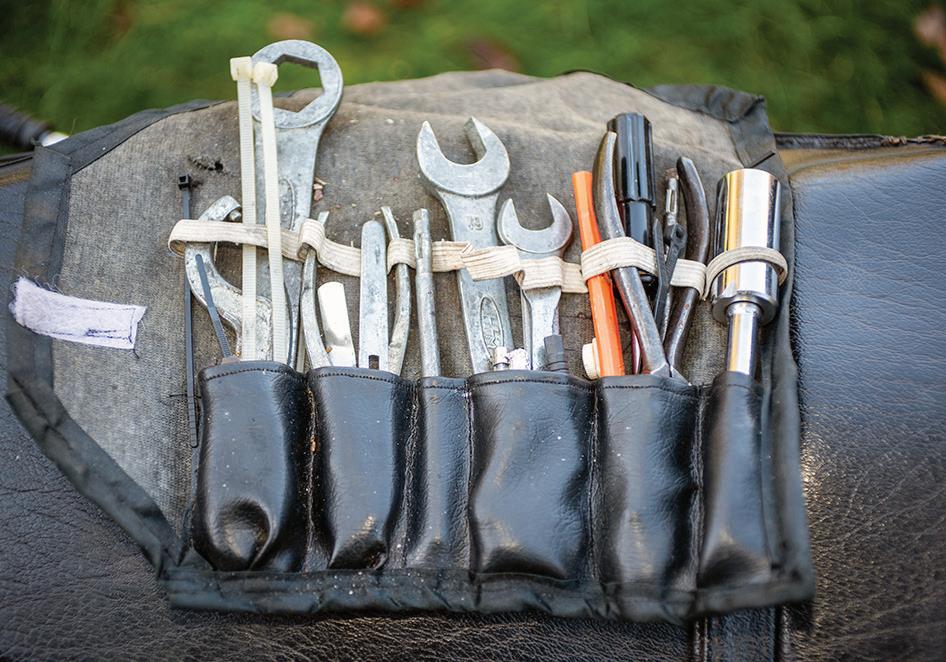
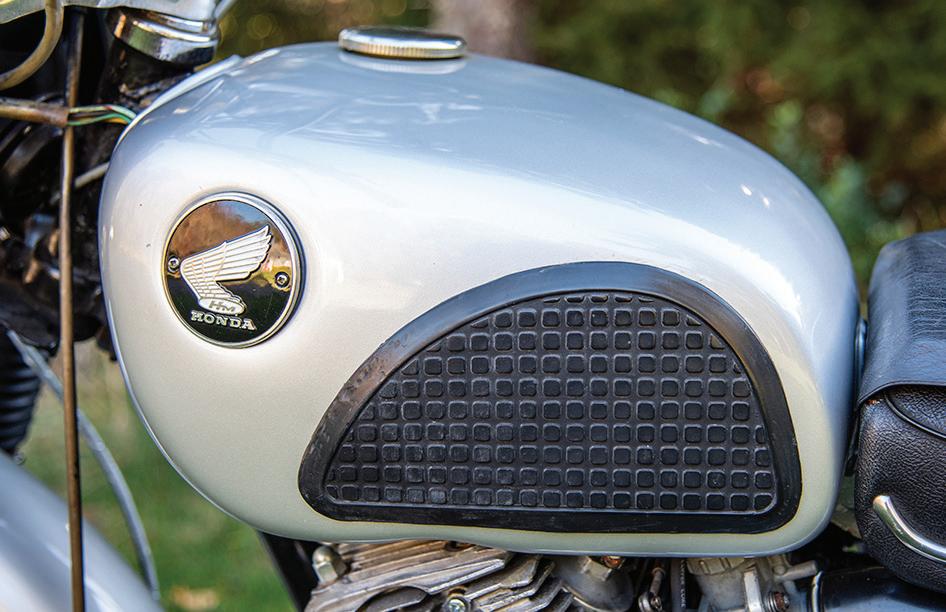
Back in 1972 Jerry and his older brother Ed were helping brother-in-law Bob install a new heating system in Bob’s farm house. During a mid-morning coffee break on a freezing New Jersey morning (the boys put a little whiskey in their coffee to ward off the cold), Jerry noticed an abandoned 1966 Honda Scrambler parked below a window just outside Bob’s farm house. (Had the Scrambler actually been in the barn it would have been

64 MOTORCYCLE CLASSICS September/October 2023
Jerry’s Scrambler outside Lucille’s. Jerry’s wife, Karin, made the toolkit pouch, which holds the original tools and a few extras.
a true barn find, but Jerry found the bike on Bob’s farm and that was close enough to allow some literary license.)
Jerry bought it on the spot from Bob for the princely sum of $10. The Scrambler had been neglected for several years; Jerry’s brother-inlaw had removed the spark plugs years earlier and it rains a lot in the Garden State, so the engine was frozen. The deal Jerry made with brother Ed was that Jerry would do the work if Ed would pay for the parts, and the parts bill came to $125 from Cooper’s Cycle Ranch (one of the early and best-known East Coast Honda and Triumph dealers). Thus began a journey that has spanned a half century.
Armed only with the tools in the Scrambler’s tool kit, a Glenn’s Repair Manual, and a fierce determination to get the bike running again, Jerry tore into the task. Getting the Scrambler sorted took some doing, as the engine would not turn over, the top end needed an overhaul, there were compression issues, and getting the timing, valves, carbs and other adjustable things right was a challenge. There was no Internet back in the early 1970s and in this initial resurrection period, information was difficult to come by. One of the first things Jerry did was pull the cylinder head and bring it to Cooper’s Cycle Ranch for a rebuild (that cost another $125). Studs broke; Jerry replaced them. Timing drifted; Jerry became an expert on setting the points and adjusting the timing, all through trial and error and advice from other Honda enthusiasts. Jerry succeeded. The Honda was back on the road.
Jerry retired from a finance position in the New Jersey state government in 2001, and he and his wife Karin started putting more time and miles on the Scrambler. The Dowgin family had moved to the New Jersey Pine Barrens, prime motorcycle country (see this issue’s Destinations on Page 72). When I recently visited Jerry, we rode the Pine Barrens and it was great. We stopped at a couple of roadside motorcycle spots (including one with a statue of the legendary Jersey Devil, New Jersey’s own Chupacabra), chatted with other motorcyclists, and had a great time. I rode Jerry’s Scrambler and everywhere we stopped, the vintage Honda was a conversation starter.
I greatly enjoyed my visit and conversations with Jerry. I asked Jerry if he inherited his interest in motorcycles from his motor officer father and the answer was a firm no. “Pop wasn’t interested in motorcycles,” Jerry told me. “He saw too many young Troopers get killed on motorcycles when he was a State Trooper.” The New
Jerry’s father, Trooper Ralph Dowgin of the New Jersey State Police. This photo was taken in 1936 (far left). Jerry and his Scrambler (left).
Jersey State Police website shows New Jersey State Police motor officer fatalities in those early days was indeed high. Things were different then; there was little protective gear and New Jersey State Troopers rode all year. I remember when I was a kid that snow meant little to our State Troopers; they simply put chains on their tires and continued to patrol.

Jerry’s Scrambler needed another rebuild in 2018 when the compression and top speed dropped significantly. Jerry had the cylinders rebored and he installed oversize pistons. Over the years, other repair requirements emerged, as might be expected on a motorcycle with five decades under its wheels. Jerry keeps the Scrambler running, relying on internet forum advice, his old Glenn Repair Manual, a Harbor freight compression tester, a more extensive collection of specialized tools, and his decades-long relationship with the Honda.
Jerry’s never intended a concours restoration; his objective was a resurrection. Other than a repainted fuel tank, the Honda’s finish and most of its parts are original. Fifty years ago Jerry simply wanted to get the old Scrambler road and trail worthy so he could explore the Pine Barrens, neighboring Pennsylvania, and other parts of the mid-Atlantic states. As the photos here show, Jerry hit a home run, and his Scrambler has been a New Jersey Pine Barrens staple for 50 years. Jerry rides every chance he gets and he told me he plans to leave his Honda Scrambler to his son and grandson. That is a magnificent plan. MC
Honda Motorcycles 1959-1985: Enthusiasts Guide

Honda Enthusiasts Guide is designed to aid non-professional motorcycle collectors to decide whether to buy and restore Honda motorcycles produced between 1959 and 1985.

Author Doug Mitchel provides four to six paragraphs describing bikes in general terms, including, but not limited to, the differences and similarities between models discussed and other similar models. A general section at the back of the book will offer the reader help deciding where to buy classic bikes, where to get parts, who to call for help, and which parts of the restoration should be farmed out to experts with specific skills. This title is available at store. MotorcycleClassics.com or by calling 800-880-7567. Item #6973.
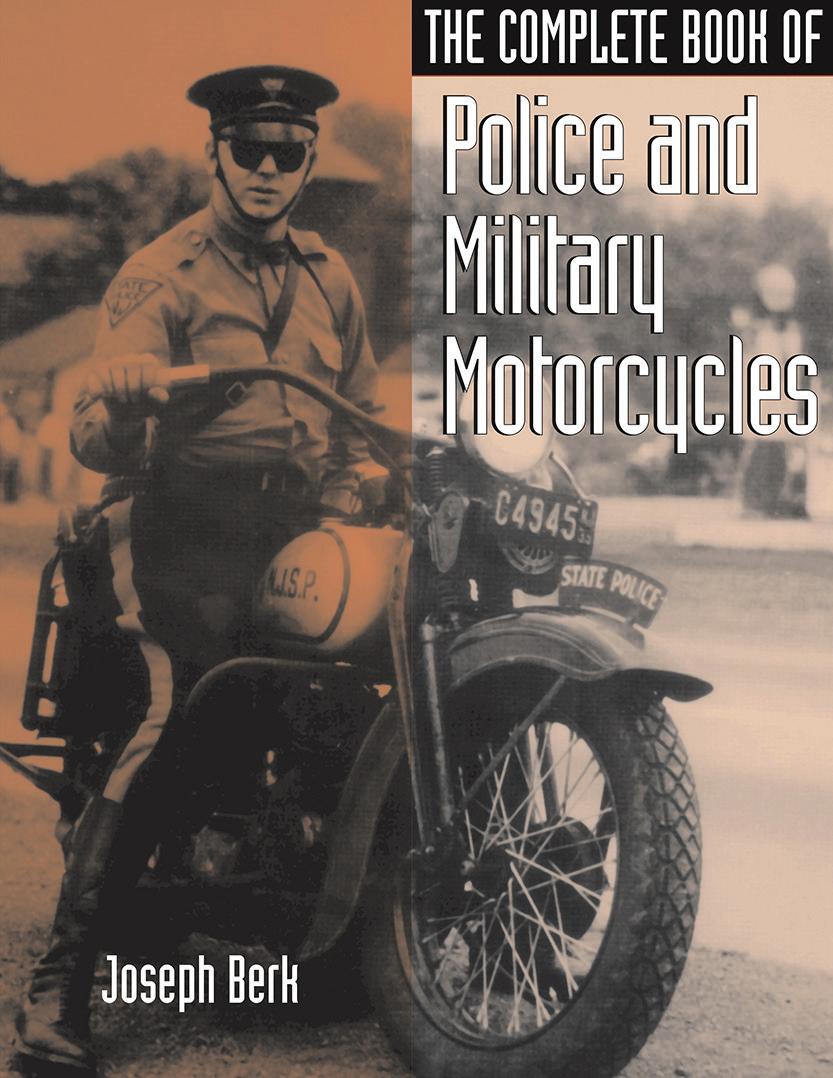
www.MotorcycleClassics.com 65
Ultimate Collector Motorcycles

Today’s world is full of superlatives, but occasionally something comes along which truly deserves being extolled as the biggest and best. And that’s indeed very much so with the 940-page large format (11.1 x 14.2-inch) English-language Ultimate Collector Motorcycles masterwork just released by Taschen Books, a luxury art book publisher based in Cologne, Germany, which until now had never dealt with anything to do with two wheels and an engine. For there’s little doubt that this massive two-volume 220,000-word title weighing 20.68 pounds in total is the finest book about motorcycles yet published in any language, both in terms of content and presentation. Anyone who spends $250 will not be disappointed with their purchase. And, for full disclosure, I say that as someone asked to read the title through for

accuracy before publication, but who otherwise played no part in its creation — so I have read every word in both volumes!
That satisfaction will follow because what may at first glance appear to be a massive coffee table picture book, with an array of magnificent studio photos of each of the 100 featured motorcycles, when you start reading through it swiftly turns out to be a motorcycle history textbook, with a detailed account including the genesis and technical makeup, plus any competition history, of each of the models included. Ignore the misleading “Born to be Wild” strapline of the book’s promotional blurb, which might make you think you were about to open a picturebook of Custom Streetfighters. This is a concise, wellwritten, well-researched, and above all well-balanced journal of record of those hundred bikes, the majority (though not
TEST RIDE
The cover of the box/sleeve that holds the two volumes.
The 1957 Moto Guzzi V8 Grand Prix racer, one of six produced.
ROBERTO CARRER (COURTESY MUSEO PIAGGIO)
all) of which are iconic landmarks in motorcycling’s evolution, spread over the 125 years interspaced between the 1894 Hilbebrand & Wolfmuller which heads the list of featured models, and the 2020 Aston Martin AMB 001 which ends it.
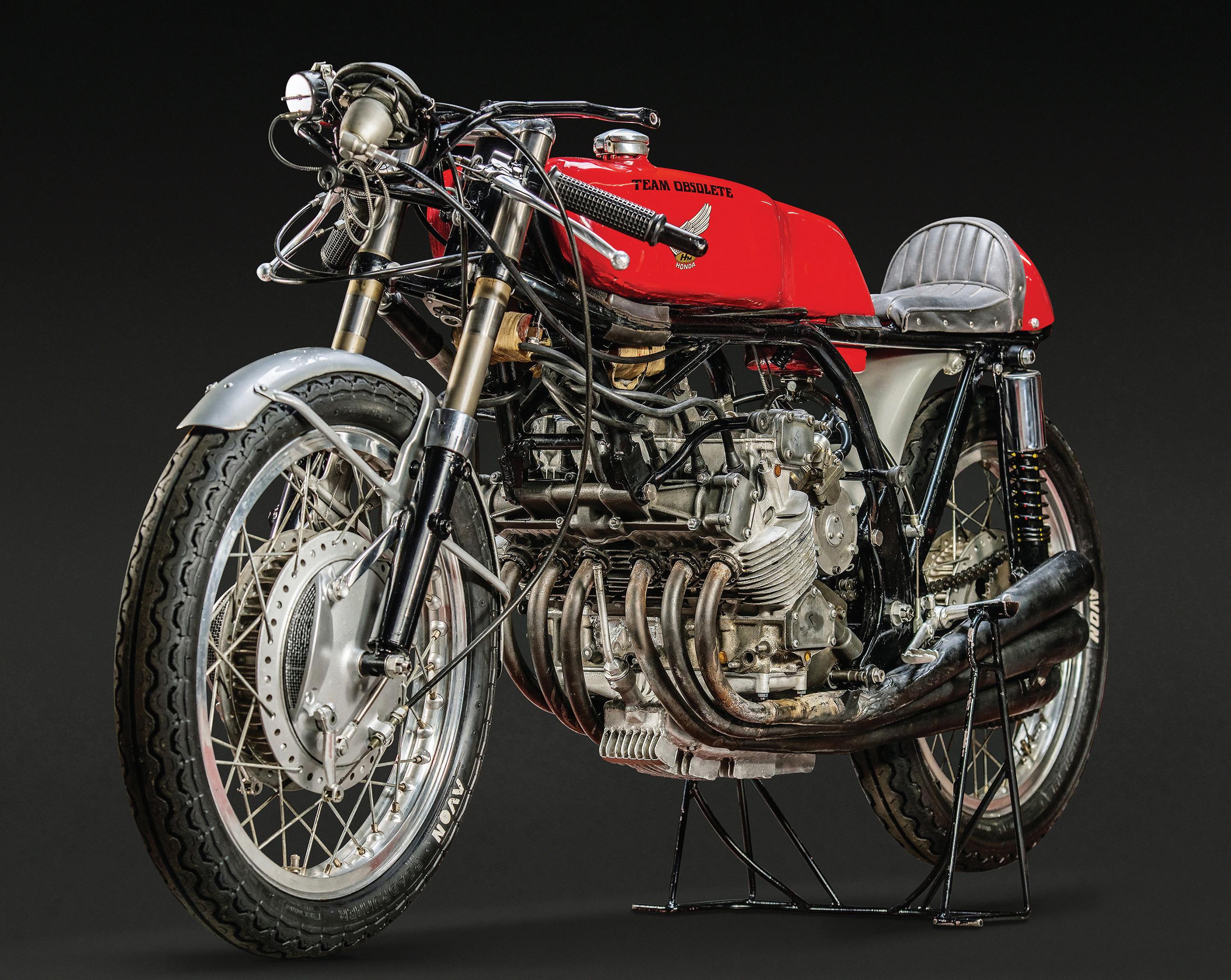
The title is a slight misnomer, though, for don’t infer that this book’s purpose is about exploring two-wheeled stamp collections, or even those owned by men who’ve assembled a significant array of bikes and opened them to public view, like George Barber and Sammy Miller, who are featured in interviews in the work. Instead, it’s a detailed look at many of the most significant motorcycles yet built, irrespective of their present location, as chosen by the authors, Charlotte and Peter Fiell. They did so with help from the likes of Jay Leno, who wrote the foreword and knows a thing or two about acquiring desirable bikes of all eras, and Ben Walker, Director of Motorcycles at Bonhams auctioneers. Paul d’Orléans, founder of The Vintagent blog and Gordon McCall, co-founder of California’s annual Quail Motorcycle Gathering concours, add further North American viewpoints.
The Fiells have written many previous Taschen books, more than 60 in all, but principally about various aspects of transportation and interior design and furniture, and while they did recently author the likewise two-volume Ultimate Collector Cars
title, they have never previously dealt with motorcycles, don’t ride them and came cold to the topic.
All I can say after they spent the best part of two years producing this book is that they’re fast learners, for the huge amount of research needed to write such accurate and detailed yet concise descriptions of such a vast array of motorcycles is a genuine achievement worthy of the greatest praise. Add in the numerous period photos, posters and other images, and each chapter is a detailed portrait of the creation and subsequent existence of each different model, as well as of its life and times.
From pioneering record-breakers, luxury tourers, and legendary Grand Prix-winning road racers — sorry, very few offroaders, perhaps the only fair criticism of the title — to iconic Superbikes and exotic Customs, this beautifully produced book is a record of the evolution of motorcycle design at its highest level over the past 125 years. There’s an appropriate balance in terms of the space taken to tell each story, too, with the Moto Guzzi V8 500cc GP racer getting 3,000 words of detailed coverage, while the Aston Martin AMB 001 which finishes the book has just 1,400 words to it — each of them the necessary space to tell their full story.
Until someone examines and handles these books for
www.MotorcycleClassics.com 67
The 1964 Honda RC165 250cc works Grand Prix racer, ridden by Jim Redman, Mike Hailwood and Stuart Graham.
DOUGLAS MACRAE (COURTESY TEAM OBSOLETE)
themselves, it’s difficult to convey the massive sense of quality in terms of the title’s design and substance, just how superbly produced and HUGE a publication it is, and the excellence of its content in both words and pictures. There has never been anything remotely like this published before in the motorcycle world, and I very much doubt there will be again.
Taschen terms the volumes as “A cornucopia of motorcycle


treasures, and an absolute must-have for all bike enthusiasts.” That sums it up well, for this is quite simply the best motorcycle book ever published — no contest. —
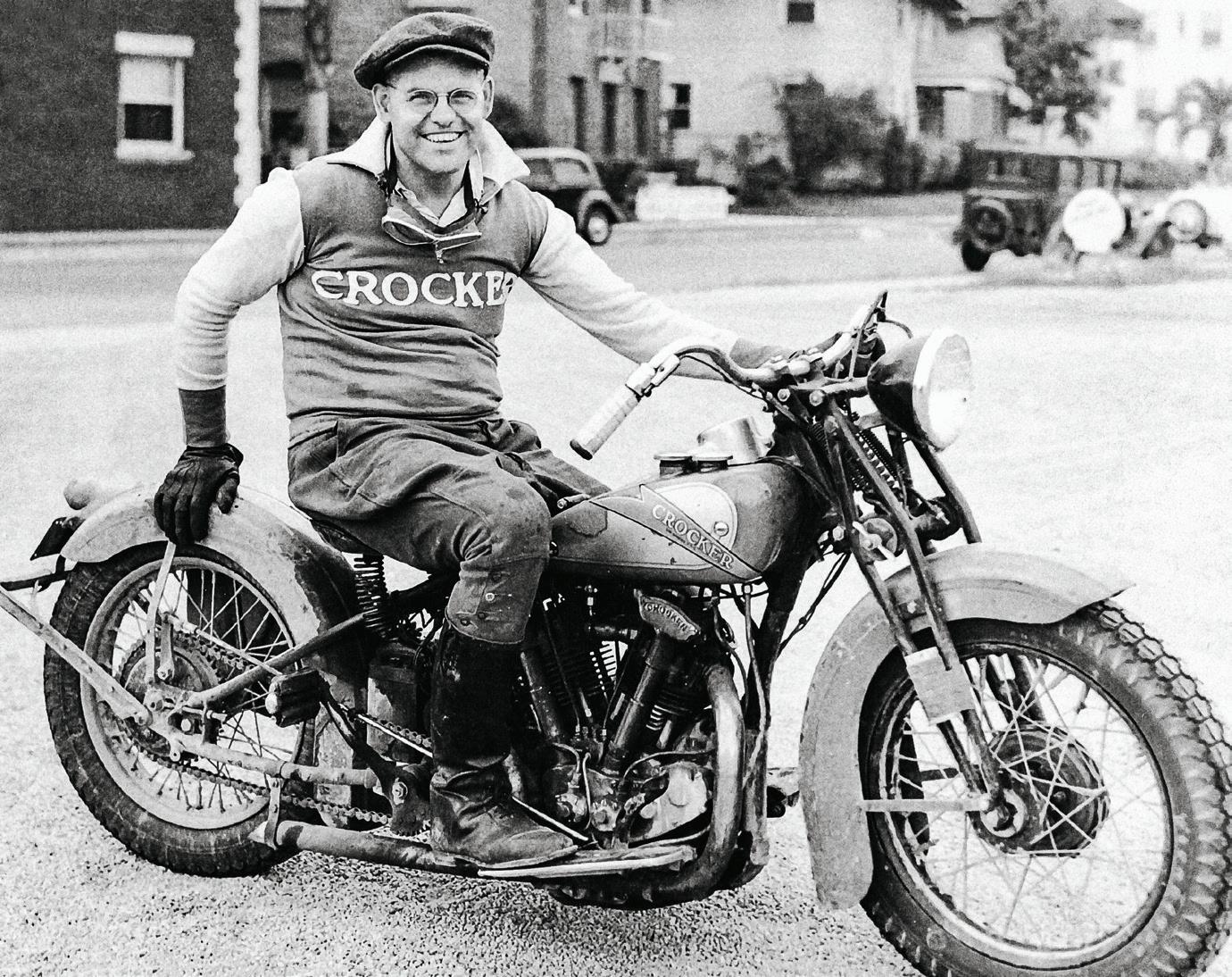 Alan Cathcart
Alan Cathcart
Ultimate Collector Motorcycles by Taschen Books is available at store.MotorcycleClassics.com or by calling 800-880-7567.
Item #12064
TEST RIDE
Crocker’s designer-cum-machinist Paul Bigsby astride an early 61ci hemihead Crocker, ca. 1936. A Moto Guzzi test rider inside the MG wind tunnel.
The 1912 Henderson Four, one of just 25 produced.
ARCHIVIO STORICO PIAGGIO, PONTEDERA
BRANDON O’NEAL (COURTESY
FRED W. GRETSCH ENTERPRISES ARCHIVES/MARY BIGSBY
SINLESS CYCLES)
1903 to the Present Day



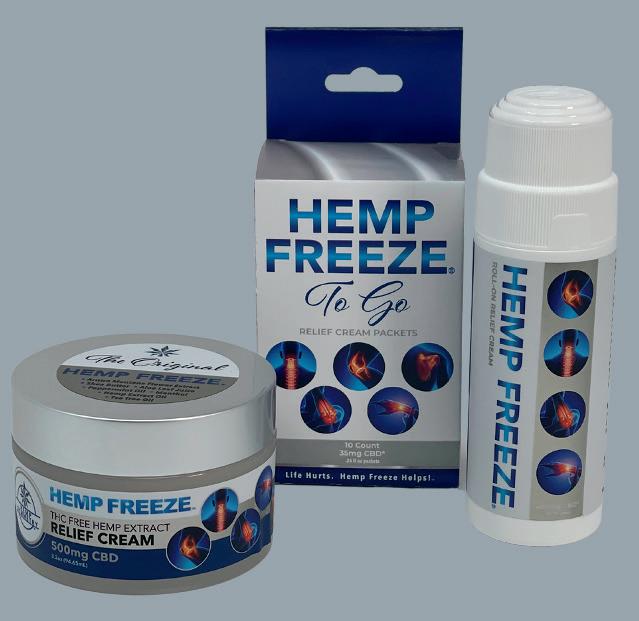
































CLASSICS HARLEY-DAVIDSON








Noother motorcycle matches the style or sound of a Harley-Davidson, with its rumbling V-twin engines. Harley-Davidson Classics zooms in on more than 50 of the company’s greatest creations, giving a close-up portrait of each machine. Superb double-page photos and closeup shots highlight every aspect of each motorcycle. Comprehensive specification boxes accompany each model, covering all the technical aspects, including engine type and size, frame, transmission, suspension, and brakes. An in-depth description explores the bike’s development and manufacturing history. This unique and highly illustrated volume provides insight into the fascinating world of this legendary marque and is essential reading for all Harley-Davidson fans.
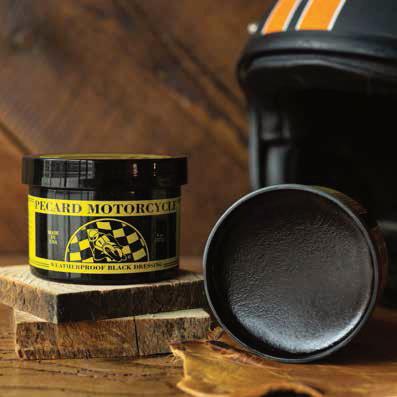


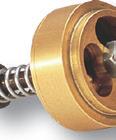


























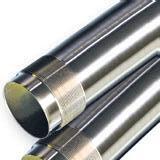


MODERN TECHNOLOGY FOR VINTAGE MACHINES ENGINE SERVICES NOWAVAILABLE ARCINGBRAKE Fork Gold Valve Emulators® G-3S Custom Series Shocks • Custom Built to Order • Made to Any Length • Choice of Features • Color Options Gold Valve Cartridge Emulators offer Adjustable Damping! Made in U.S.A. VINTAGE SUSPENSION Made in Italy. Call or go to the website for your application. TNK Fork Tubes Race Tech Hi-Performance Fork Springs • Springs available in a variety of Spring Rates. racetech.com | 951.279.6655 For Most Forks & Shocks Shop Services Improve Drum Brake Stopping Power! 21RaceTech_1.6HorzPg-Ad_MCclassics.indd 1 12/17/20 4:47 PM The Original g “Our people love it! Best topical by far!” -Curtis Illig | White Oak Pharmacy, Garner NC For Wholesale Orders and Retail Purchases, Visit Us At GetHempFreeze.com Hemp Freeze® Helps! Life Hurts. Use Code for 15% off your order! "HFMC2023" © 2023, Founders Wellness, LLC WWW.PECARD.COM Made in the USA Since 1902 “We Protect Your Hide” Leather Care Co. Call 800-880-7567 or order online at Store.MotorcycleClassics.com Mention promo code MMCPANZ2.
ITEM #9879
$29.95 $25. 46 MEMBER PRICE LIST PRICE MCC_Harley_Davidson_Classics1/3Square.indd 1 7/11/23 9:18 AM
CALENDAR SEPTEMBER/OCTOBER
Don’t miss these upcoming events!


All events subject to change. Please check event websites for updated information.
Motorcycle Classics wants to know about classic motorcycle shows, swap meets, road runs and more. Send details of upcoming events at least three months in advance to lhall@motorcycleclassics.com
9/10
Visit the annual Battle of the Brits Motorcycle & Car Show and Swap Meet at Camp Dearborn in Milford, Michigan. This event regularly draws more than 200 bikes and some tasty British cars. Classic British, European and pre-1984 American bikes are invited to be a part of the show. Food and beverages will be available, along with on-site camping. On the web at metrotriumphriders.com
Sept. 8-10 — AHRMA Roadracing at Talladega Gran Prix Raceway, Munford, AL. ahrma.org
9/10

Attend the 38th Annual Italian Motorcycle Owners Club Rally in Sturbridge, Massachusetts, with Ducati bevel bikes as the featured models. The show runs from 10 a.m. to 2 p.m. All Italian bikes and scooters are invited. Check out America’s biggest Italian motorcycle event. On the web at imoc.website/calendar2
The Ride for Kids is an annual event that raises funds for children battling the deadliest form of pediatric cancer — brain tumors. This will be the ride’s 39th year and every ride around the nation will take place on Sept. 17. To learn more or donate visit rideforkids.org
Join all the good folks and classic bikes at The Modern Classics Ride-in on Saturday, Sept. 23, in Boyertown, Pennsylvania. More than 100 vintage and custom bikes are expected. No judging, no classes and no awards, just a fun day of checking out bikes with friends, food and more. On the web at martinmoto.com

One of The Larz Anderson Auto Museum’s most popular shows, Classic European Motorcycle Day showcases the best on two wheels from the Old World. Join us as hundreds of classic superbikes, choppers, racers and cruisers are on display on the Great Lawn. Bring and show your German, Italian and British bikes. The museum is located in Brookline, Massachusetts. On the web at larzanderson.org/2023lawnevents
Visit the 18th Annual Barber Vintage Festival at Barber Motorsports Park outside Birmingham, Alabama. The show runs through Oct. 8 and will feature AHRMA road racing, the American Motor Drome Wall of Death, the swap meet and more. Bike restoration extraordinaire, motocross pioneer and Fujio Yoshimu will be the Grand Marshall for 2023. Fujio was an integral part of the Yoshimura racing effort throughout the 1960s. On the web at barbervintagefestival.org
Enjoy beautiful downtown Vicksburg, Mississippi, at the Vicksburg Vintage Motorcycle Show. The Antique cycle show and swap runs from 9 a.m. to 3 p.m. and promises live entertainment, over 20 awards and door prizes. Entry is free and open to pre-1990 motorcycles. For more information: visitvicksburg.com/event/vicksburg-vintagemotorcycle-show-2023
Sept. 8-10 — 33rd Annual Classic British Motorcycle Club of Cincinnati Vintage Motorcycle Rally. Burlington, KY. cincybritishbikes.com
Sept. 10 — Rice-ORama Vintage & Custom Japanese Motorcycle Show and Swap Meet. Spencer, MA. rice-o-rama.com
Sept. 16 — Vintage Motorcycle Festival at the Owls Head Transportation Museum, Owls Head, ME. owlshead.org
Sept. 23 — Night Ride to Chilao School, La Canada Flintridge, CA. Departs at 6:30 p.m. socalnorton.com
Sept. 21-25 — 22nd Annual Vintage Yamaha Rally. Iron Horse Motorcycle Lodge, Stecoah, NC. vintageyamaharally.com
Sept. 30 — 13th Annual Central Coast Classic Motorcycle Show. San Luis Obispo, CA. centralcoastclassicmc.com
Sept. 30 — El Camino Vintage Motorcycle Show and Swap Meet. elcaminoshow.com
Oct. 5-8 — AHRMA Roadracing at Barber Motorsports Park, Birmingham, AL. ahrma.org
Nov. 5 — 44th Annual Hansen Dam All Brit Ride. Near Glendale, CA. socalnorton.com
70 MOTORCYCLE CLASSICS September/October 2023
9/23 9/17
9/24 10/6 11/4
Head to San Luis Obispo, California, for the 13th Annual Central Coast Classic Motorcycle Show, Sept. 30.























©2022 New Gear, Downloadable Catalog + more specials online! aerostich.com/mcc aero mcclassic 2022a.indd 1 4/26/22 4:15 PM • Complete rebuilding of all Vintage British, Japanese & American motorcycle engines & transmissions. • Valve jobs, cylinder boring and sleeving. • Welding, custom machining, chroming, powder coating • High performance and racing modifications. • Complete wheel rebuilding VintAge SerViCeS BritiSH PArtS SINCE 1978 Daily Shipping Worldwide Daily Shipping Worldwide Worldwide 86 BOStOn tUrnPiKe, (rOUte 44) WiLLingtOn, Ct 06279 860-848-0607 FAX 860-487-9916 ViSit OUr WeBSite: www.jobcycle.com eMAiL: info@jobcycle.com "WHen YOU WAnt it DOne rigHt tHe FirSt tiMe" CUStOM reMAnUFACtUring AnD MACHining • Precision parts fabrication. • One-off and reproduction parts. • Professional Welding Services. • nOS • reproduction • Large used parts inventory Complete repair service Fuel in the blood. TO FIND YOUR LOCAL DEALER VISIT: JOE R O CK ET MENS TEXTILE JACKET MSRP@$249.99 SIZES:SMTHRU3XL BLACK/BLACK BLACK/GRAY BLACK/RED BLACK/HI-VIZ
Photo of Dave Roper by Bill Burke
RIDES AND DESTINATIONS
The Pinelands National Reserve in southern New Jersey is an interesting place for many reasons. The Pine Barrens (as the area is commonly known) covers nearly a quarter of New Jersey, the most densely populated state in America, but very few people live here. There’s a lot of empty land and forest in the Pine Barrens (the area was a featured spot for dumping bodies on The Sopranos, and that probably wasn’t just a figment of some screenwriter’s imagination). Pine Barrens’ folklore, including the Jersey Devil, which we’ll get to in a minute, makes the area interesting. The Pine Barrens is a great destination for riding, motorcycle camaraderie and good food.
The area has a rich history. America’s eastern seaboard formed about 200 million years ago; the Atlantic Ocean deposited sand along this coastline and 65 million years ago the Pine Barrens began to emerge. When the Ice Age ended 12,000 years ago plants and trees appeared. Lenape Native Americans settled here 10,000 years ago. Swedish and Dutch settlers arrived and focused on fishing and whaling. England claimed the area in 1606 and shipbuilding (using the region’s ready supply of pine, cedar and oak) emerged as the dominant industry. Cranberry bog farming followed in the mid-1800s. The area remains the third largest source of cranberries in the U.S. Blueberries were first cultivated here and blueberry farming remains a dominant industry. Over time, most manufacturing industries left and the Pine Barrens reverted to an isolated and heavily forested region. The Pine Barrens has ghost towns, including Batsto Village. Wildlife is plentiful, including river otters, deer, black bear, bobcat, bald eagles, many species of reptiles and more. Congress designated the
Pine Barrens as the Pinelands National Reserve in 1978, and a decade later the United Nations designated the area an International Biosphere Reserve.

When I was a youngster, the Pine Barrens had a reputation as a backward area. I can tell you firsthand, though, that’s not the case. The area is reputed to be haunted by the Jersey Devil (a version of the chupacabra; a devilish creature with the head of a goat and large bat-like wings), the Black Doctor (the ghost of Captain Kidd), and other assorted supernatural beings. These make for interesting stories, but I wouldn’t let any of them influence plans to ride in the Pine Barrens.
My recent ride in the Pine Barrens on a vintage 1966 Honda Scrambler (see Page 61 of this issue) was most enjoyable. Our first stop was in Chatsworth, an old Pine Barrens wide spot in the road with only a few buildings and a roadside

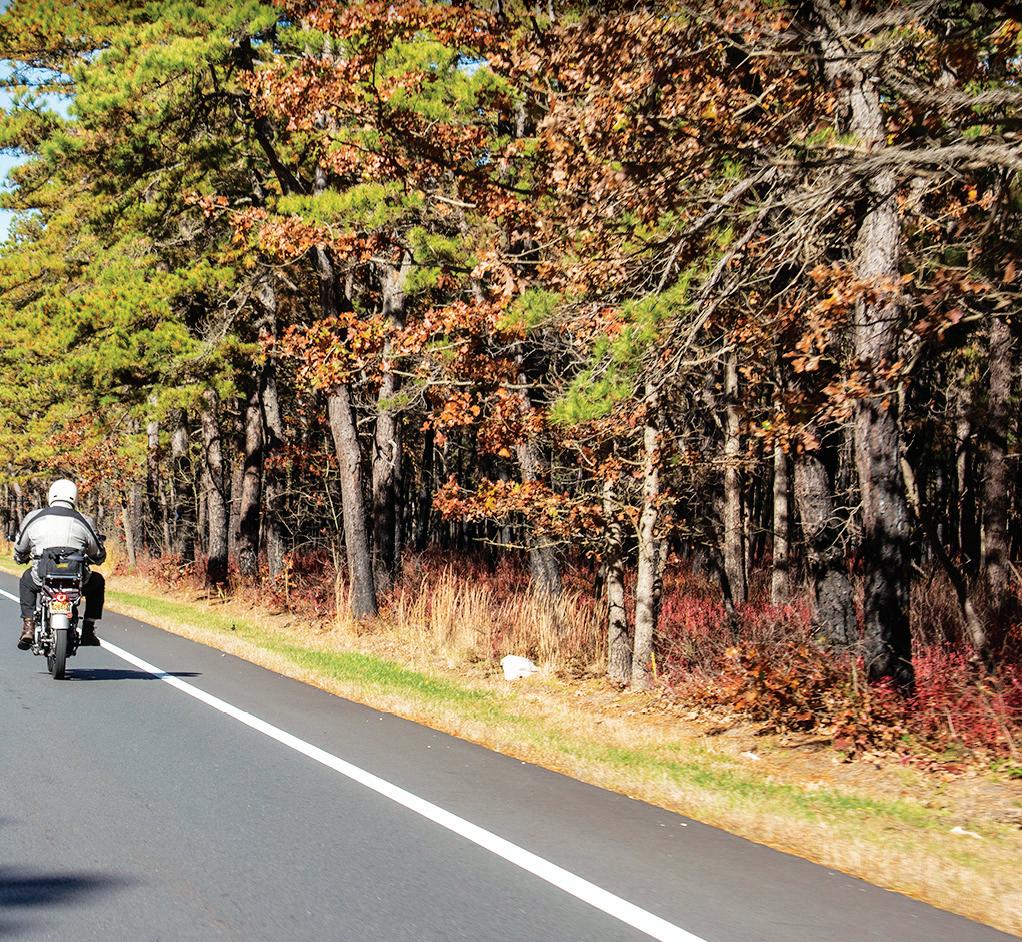
eatery. We bought sodas and hot dogs at the Hot Diggidy Dog, sat on a roadside bench, and chatted with other riders. From Chatsworth, it was on to Lucille’s Luncheonette in Warren’s Grove on County Route 539, one of the main roads through the Pine Barrens. Lucille’s (featured on Anthony Bourdain’s Food Trail, visitnj.org/anthony-bourdain) is known for its pies. We parked under a carved, life-sized Jersey Devil statue in Lucille’s parking lot. Other than that statue, we didn’t see the Jersey Devil on our ride, but who knows? Maybe he saw us. Anything is possible in the Garden State. I was born and grew up in New Jersey, but I had never ridden the Pine Barrens until recently. The Pine Barrens is a different kind of destination, and the riding is much more fun than what I remembered New Jersey riding to be. The locals told me it’s always been like this. — Joe Berk
THE SKINNY
What: The Pine Barrens in southern New Jersey, a sparsely populated, heavily forested area offering great riding.



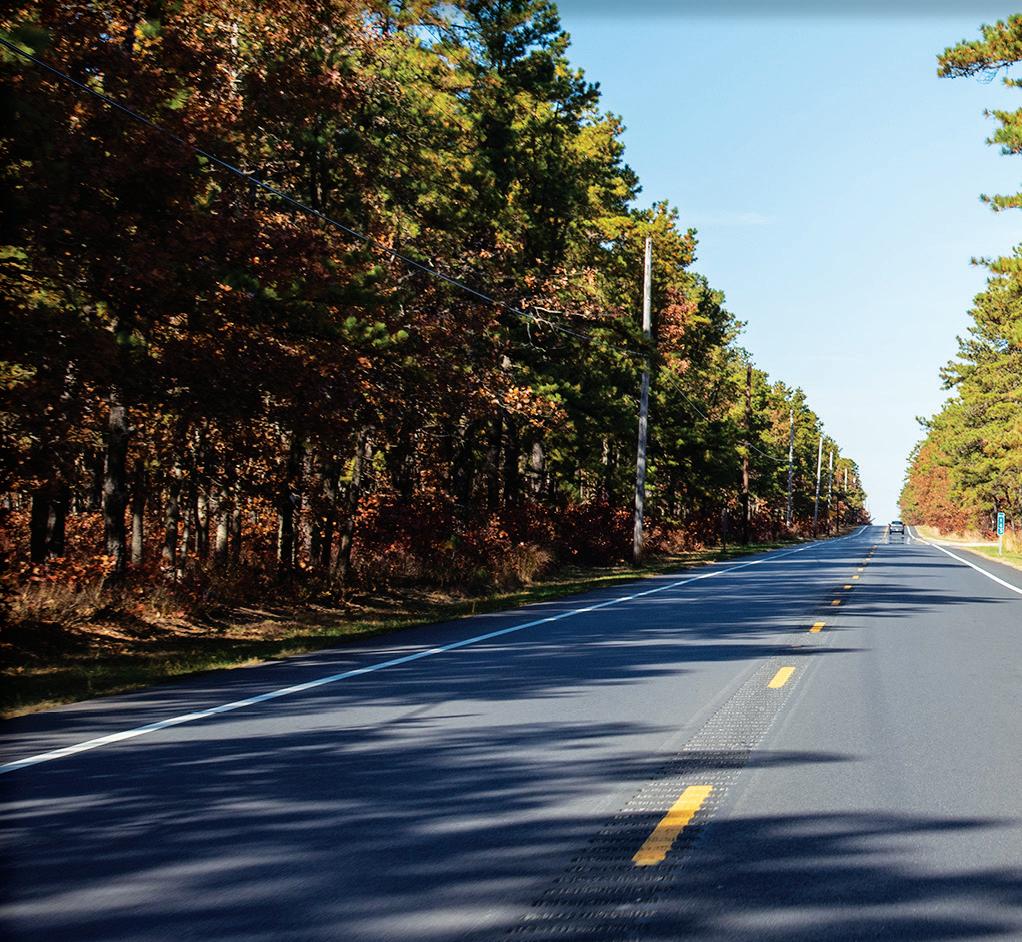
How to Get There: From the north, take the N.J. Turnpike (I-95) south to I-195 east, exit on County Route 539 South. From the south, take the Garden State Parkway north and exit County Route 539 North.
Best Kept Secret: The Jersey Devil is real (I’ve seen him; he rides a ’66 Honda Scrambler).
Don’t Miss: Chatsworth’s Hot Diggidy Dog, and Lucille’s (in Warren Grove) for pie and ice cream.
Avoid: Dismissing New Jersey as a destination, as it has a lot to offer.



More Info: New Jersey Pine Barrens — Your Guide to Things to Do and Events, new-jersey-leisure-guide.com/pinebarrens.html
More Photos: Jerry and the Jersey Devil, bit.ly/45wvpQr
 THE NEW JERSEY PINE BARRENS
THE NEW JERSEY PINE BARRENS
72 MOTORCYCLE CLASSICS September/October 2023
“
The














12v Generators for your Classic Bike!


Upgrade your Vincent, BSA, today with products by Alton-France.


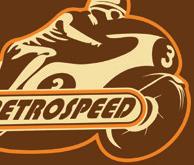
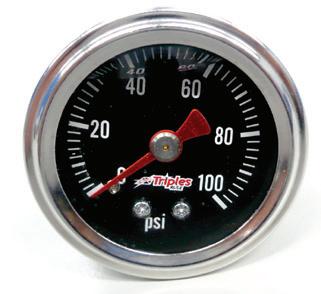



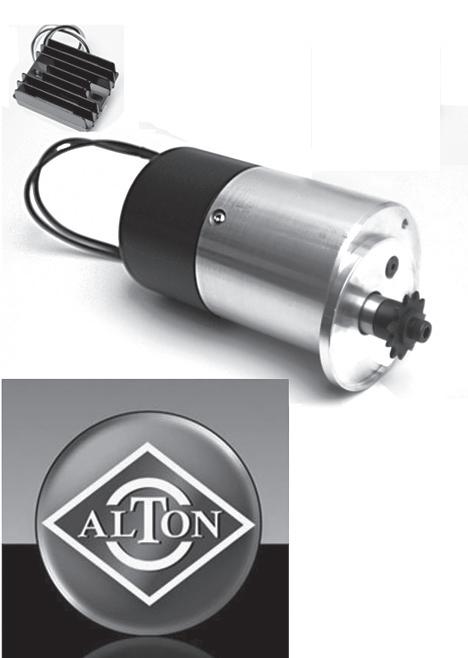





















TRIUMPH MOTORCYCLE PARTS NOS, New, Used Genuine AMAL, Lucas and more. Name brand UK made parts We have a special emphasis on Triumph 650/750 Twins. 785-925-2042 kmjonesmotorsports.com

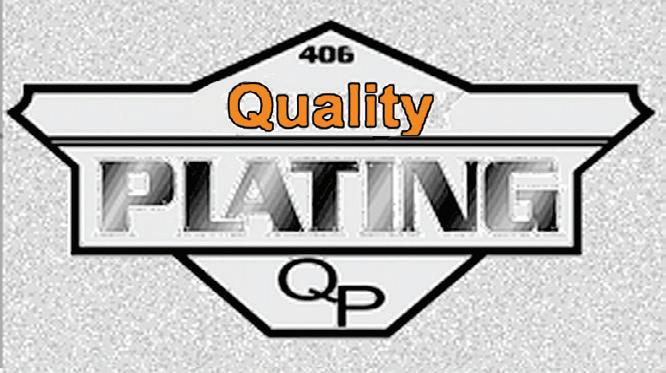



US Distributor: The Classic Bike Experience www.classicbikeexperience.com www.alton-france.com Call 802-878-5383
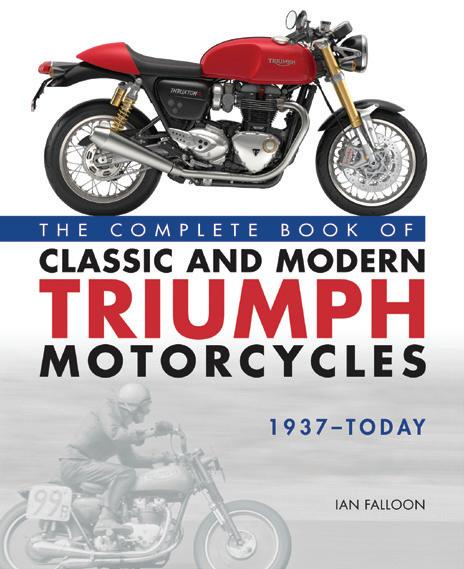





















KICKSTAND www.MotorcycleClassics.com 73
We bought 4 full truckloads of new original parts
the closed warehouse in
CA.
from Bantam to
III ” - Car l St. Charles Rock Road, St. Ann, MO 63074
427-1204
from
Duarte
Everything
Rocket
(314)
Motorcycle People -
. 2nd Oldest Yamaha Dealer in USA ALSO: New and Classic Parts for
DONELSON CYCLES INC MCC0_0820_ADS.indd 73 5/13/20 4:06 PM KICKSTAND Increase the performance and life of your vintage engine with the latest in performance beehive valve springs. Take advantage of the light weight of a single valve spring with the performance and control of a dual valve spring. Call or email for applications. R/D Spring Corp., Email: info@rdvalvespring.com Call (760) 948-4698 or Web: www.rdvalvespring.com TRIUMPH Genuine Name We “Oil-In-Frame” kmjonesmotorsports.com RETROTOURS.COM RIDE A PIECE MCC0_0820_ADS.indd 74 including motorcycle restoration parts! Adaptive_Mount_MCC_12th_Kickstd_REV3KLM.indd 1 1/13/15 8:32 AM PARTS Twins. HISTORY. CALL/TEXT 603-479-2538 KICKSTAND Established in 1976 We do Aluminum Polishing, Zinc Plating, Show Chrome finishes and much more, including motorcycle restoration parts! Call us now at 815-626-5223 or fax 815-626-5244. Visit: www.qualitychromeplating.com Adaptive_Mount_MCC_12th_Kickstd_REV3KLM.indd 1 daptive_Mount_MCC_12th_Kickstd_REV3KLM.indd 1/13/15 8:32 AM
Since 1962 DON E L SON C YCLE S, I NC
ORIGINAL ‘OEM’ PARTS BRAND NEW
MAKE YOUR OWN HISTORY. KICKSTAND
Belgium, WI 262-483-5399 www.retrospeed.net Motorcycle Restoration Services Established in 1976 We do Aluminum Polishing, Zinc Plating, Show Chrome finishes and much more, including motorcycle restoration parts! Call us now at 815-626-5223 or fax 815-626-5244. Visit: www.qualitychromeplating.com 100 psi liquid-filled oil pressure gauge 1/8 NPT male inlet 1-5/8 diameter body with generic fittings and heavy nylon oil line $39 + shipping. Custom brackets for Meriden Triumphs in stock www.triplesrule.com t150v@aol.com 224-321-4912 Increase the the latest in of the light and control R/D Spring Call (760) QUALITY 100 psi liquid-filled oil pressure gauge 1/8 NPT male inlet 1-5/8 diameter body with generic fittings and heavy nylon oil line $39 + shipping. Custom brackets for Meriden Triumphs in stock www.triplesrule.com t150v@aol.com 224-321-4912 TRACKSIDE CYCLES ross@tracksidecycles.com www.tracksidecycles.com Belgium, WI 262-483-5399 www.retrospeed.net Motorcycle Restoration Services ITEM #9106 $6.99 MEMBER PRICE: $5.59 TALES FROM THE ROAD! To order, call 800-880-7567, or visit www.MotorcycleClassics.com/Store Mention promo code MMCPAKZ3 WORLD CLASS SUSPENSION FOR EXCELLENT ROAD HOLDING & COMFORT C302 T E302 T G362 TRCL Z362 TRL 732.786.9777 • www.epmperf.com SIDECARS! Trans-Moto HOURS (740) www.warkshop.com MOTORCYCLE CLASSICS UNION GARAGE GIVEAWAY Meet the Robinson: a classic waxed-cotton motorcycle jacket designed for everyday use on or off the bike. Produced in close collaboration with Vanson Leathers, this American-made jacket is packed with an arsenal of hidden features that collectively make it more comfortable, more practical, and more protective than any other jacket in its class. It comes with leather reinforcement at the shoulders and elbows, a removable five-piece D3O armor kit, and a whopping seven pockets—including a pass-through rabbit pocket at the back. Enter for your chance to sport this American-made, classic leather jacket on the open road. ENTER FOR YOUR CHANCE TO WIN THIS PRIZE PACKAGE VALUED AT $740! No purchase necessary. A purchase will not increase your chances of winning. Open to legal residents of the contiguous must be 18 years of age or older. Sweepstakes begins 06/19/2020 and ends 09/25/2020. See o cial www.MotorcycleClassics.com/Sweeps/Union-Garage. | Sponsor: Motorcycle Classics, 1503 SW 42nd ENTER FOR YOUR CHANCE TO WIN ONLINE WWW.MOTORCYCLECLASSICS.COM/SWEEPS/UNION-GARAGE SIDECARS! Velorex HOURS: 8 a.m. - 8 p.m. EST (740 ) 53 8 - 4 7 4 6 www.warkshop.com bobwarkshop2016@gmail.com To order, call 800-880-7567 or visit Store.MotorcycleClassics.com Mention promo code MMCPANZ2 THE ULTIMATE REFERENCE FOR TRIUMPH LOVERS Written by respected Triumph expert Ian Falloon, this luxurious reference covers all of the major and minor models, with an emphasis on the most exemplary, era-defining motorcycles such as the Thunderbird, Tiger, Trophy, Bonneville, and new machines such as the Speed Triple, Thruxton, and Daytona 675. This is a book no Triumph fan should be without! Hardcover Item #10260 $50.00 Members: $45.00
80% of bikes are misaligned by using swing arm marks, sprocket aligners or string. Use ProAligner to align your wheels directly with CMM-certi ed accuracy for precise handling.


















$19.95 US plus S&H.













80% of bikes are misaligned by using swing arm marks, sprocket aligners or string. Use ProAligner to align your wheels directly with CMM-certified accuracy for precise handling.

80% of bikes are misaligned by using swing arm marks, sprocket aligners or string. Use ProAligner to align your wheels directly with CMM-certified accuracy for precise handling. www.ProAligner.com











US plus S&H.
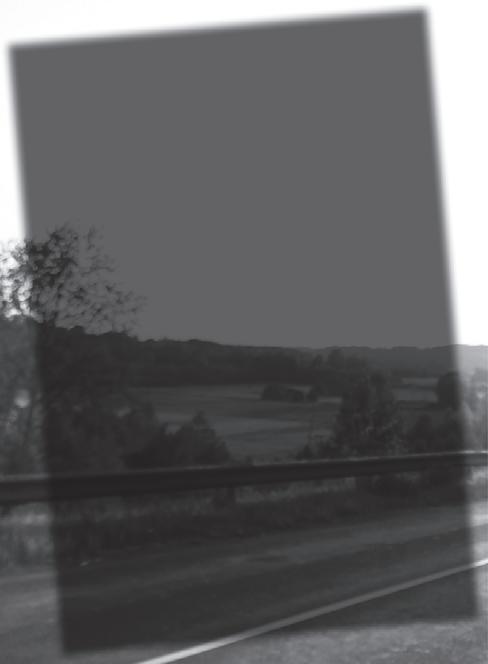

























KICKSTAND 74 MOTORCYCLE CLASSICS September/October 2023 the latest in performance beehive valve springs. Take advantage of the light weight of a single valve spring with the performance TRIUMPH Genuine “Oil-In-Frame” MCC0_0820_ADS.indd 74
www.ProAligner.com • New & Used Parts • • Expert Repair • David Bossert South Carolina (864) 850-3057
“ We parts Duarte St. Charles Rock (314) 427-1204 The Motorcycle DON E L SON C YCLE S, I NC . ORIGINAL BRAND NEW RESTORATION AND REPAIR TO SMITHS MOTORCYCLE INSTRUMENTS Over 1,000 cores in stock Instruments restored to as new sales@vintagebritishcables.com www.vintagebritishcables.com engine with advantage performance applications. info@rdvalvespring.com www.rdvalvespring.com Established in 1976 We do Aluminum Polishing, Zinc Plating, Show Chrome finishes and much more, including motorcycle restoration parts! Call us now at 815-626-5223 or fax 815-626-5244. Visit: www.qualitychromeplating.com 1/13/15 8:32 AM TRIUMPH MOTORCYCLE PARTS NOS, New, Used Genuine AMAL, Lucas and more. Name brand UK made parts We have a special emphasis on “Oil-In-Frame” Triumph 650/750 Twins. 785-925-2042 kmjonesmotorsports.com RETROTOURS.COM MAKE YOUR OWN HISTORY. BOOK YOUR CUSTOM TOUR NOW. JUST SHOW UP AND RIDE! RIDE 20+ CLASSIC BIKES RESTORATION AND REPAIR TO SMITHS MOTORCYCLE INSTRUMENTS Over 1,000 cores in stock Instruments restored to as new condition and function. sales@vintagebritishcables.com www.vintagebritishcables.com IkonSuspensionUSA.com Sales Ikon Flattrackers NATIONAL MOTORCYCLE MUSEUM INSPECTION AND BIDDING SERVICES 262-483-5399 www retrospeed net www.retrospeed.net motorcycles dive into classic HONDA To order, call 800-880-7567 or visit Store.MotorcycleClassics.com Mention promo code MMCPANZ2 Item #6428 $40.00 Members: $35.00 Classic Honda Motorcycles 1/6 Horizontal.indd 1 7/11/23 9:35 AM
$19.95
bsadb@hotmail.com
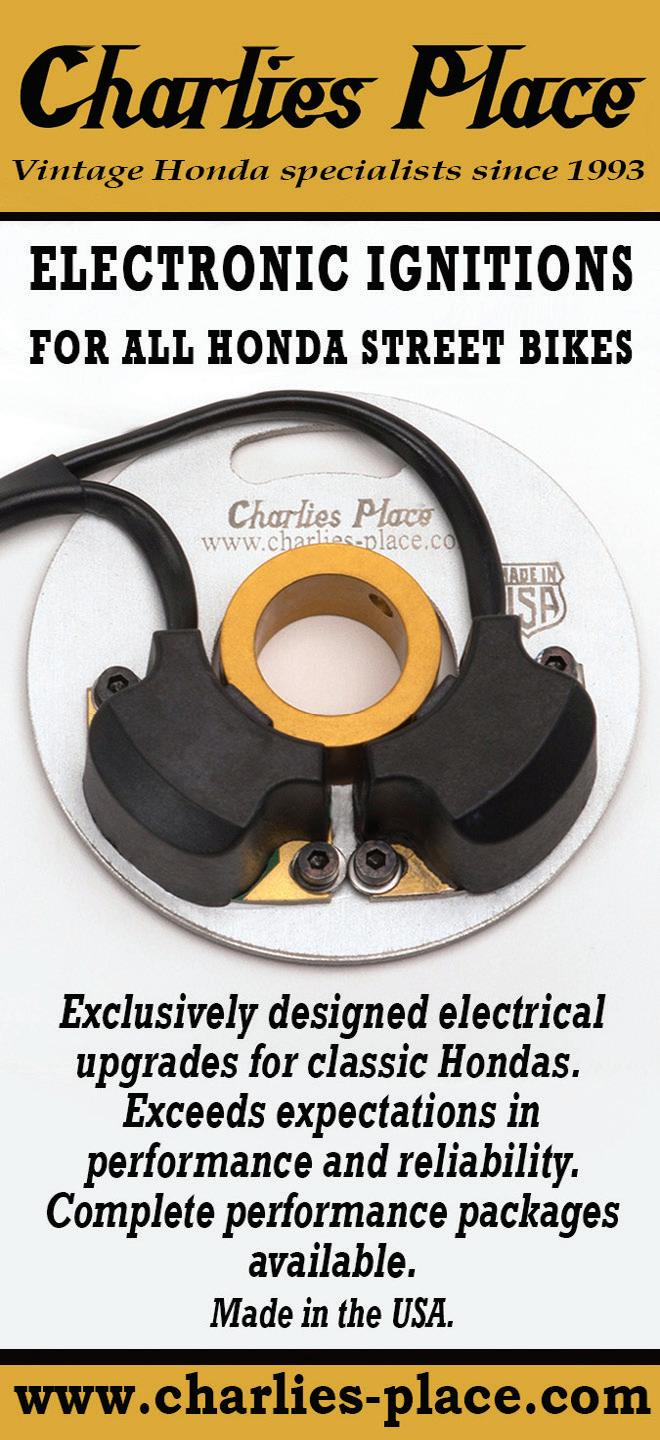

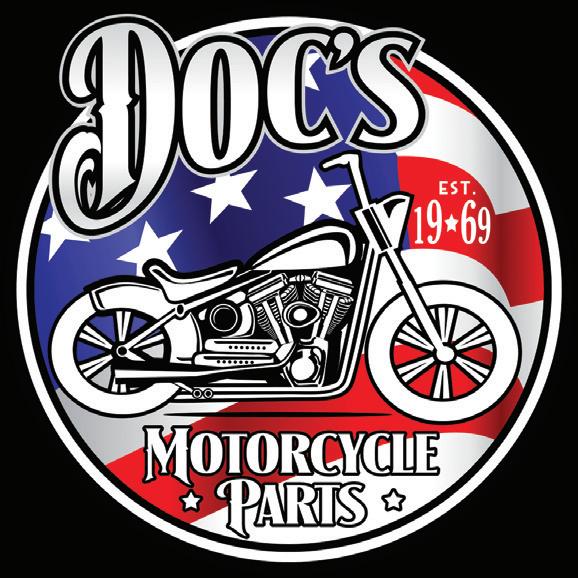



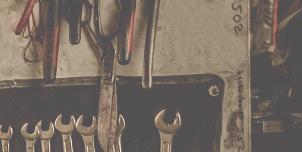




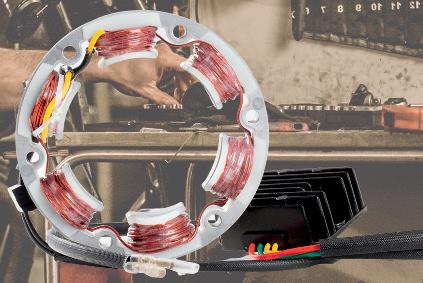



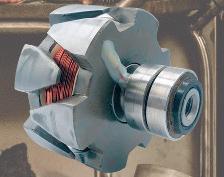








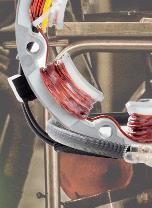









































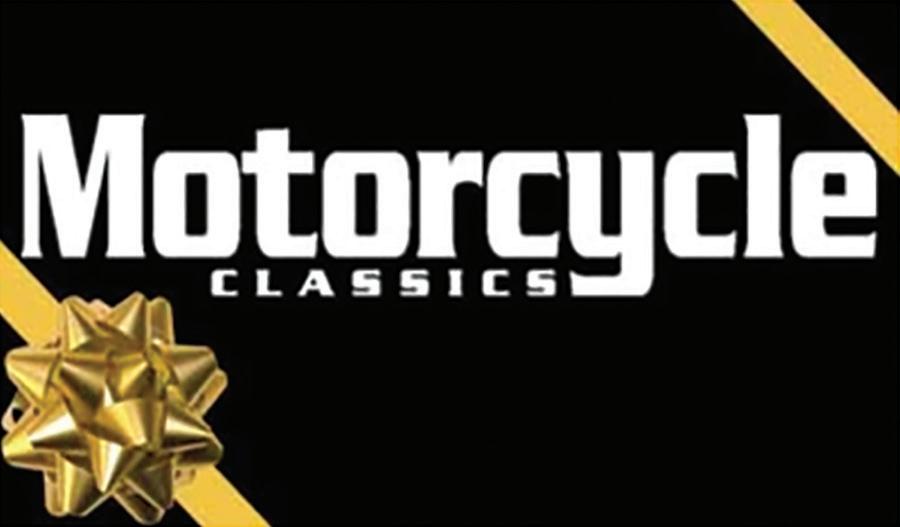









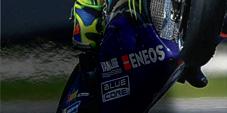



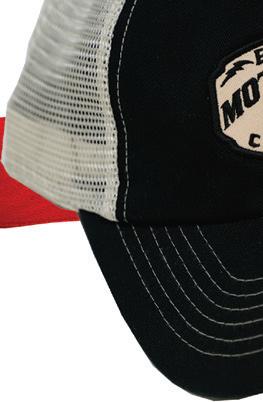



KICKSTAND www.MotorcycleClassics.com 75 Established in 1976 We do Aluminum Polishing, Zinc Plating, Show Chrome finishes and much more, including motorcycle restoration parts! Call us now at 815-626-5223 or fax 815-626-5244. Visit: www.qualitychromeplating.com TRIUMPH MOTORCYCLE PARTS Genuine AMAL, Lucas and more. Name brand UK made parts We have a special emphasis on “Oil-In-Frame” kmjonesmotorsports.com We bought 4 full truckloads of new original CA. Everything from Bantam to Rocket III ” - Car l The Motorcycle People - Since 1962 2nd Oldest Yamaha Dealer in USA ALSO: New and Classic Parts for ORIGINAL ‘OEM’ PARTS MCC0_0820_ADS.indd 73 5/13/20 4:06 PM www.youtube.com/user/ DocsMotorcycleParts We bought 4 full truckloads of new original parts from Duarte Rocket III Rock Road, St. Ann, MO 63074 427-1204 Motorcycle People - Since 1962 ORIGINAL ‘OEM’ PARTS YAMAHA RD350, RD400 & RZ350 View our available stock at economycycle.com YOUR GO-TO SPECIALIST For Parts, Service & Restoration OUTSTANDING CUSTOMER SERVICE Limited Tech Support $12.95 U.S. SHIPPING Some exclusions may apply NO-HASSLE RETURNS WIDE SELECTION OF PARTS NEW CUSTOMER DISCOUNT ECON2020 KICKSTAND RESTORATION MOTORCYCLE INSTRUMENTS sales@vintagebritishcables.com Vintage & Modern Classics IkonSuspensionUSA.com Sales & Tech (814) 592-7003 Ikon Flattrackers @rickselectrics Modern Electronics for your vintage motorcycles Modern Electronics for your vintage motorcycles Starting & Charging Components Custom Rebuilding 1 Year Replacement Warranty Call/Text: 603-329-9901 YOUR GO-TO KICKSTAND Vintage & Modern Classics IkonSuspensionUSA.com Sales & Tech (814) 592-7003 A gift card to the Motorcycle Classics Store is the ideal gi� for the individual who has a passion for vintage bikes! You will receive a gi� card code by email that your recipient can use at checkout. Print it out to wrap and share or present however you choose! $10 · $25 · $50 · $100 · Order today by calling 800-880-7567 or visiting Store.MotorcycleClassics.com/products/motorcycle-classics-gift-card Take the Guesswork Out of Gift-Giving! Your Friends and Family Will Love Choosing Exactly What They Want with a Gi� Card – Plus, There’s No Expiration Date! MCC GIFT CARD.indd 1 7/10/2023 8:44:45 AM
THE COMPREHENSIVE VINTAGE MOTORCYCLE PRICE GUIDE 2023/2024 EDITION
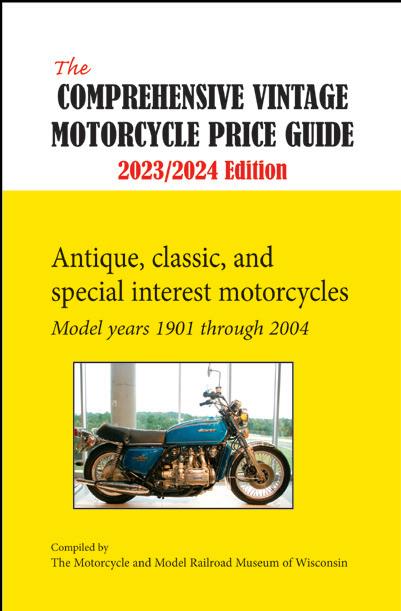
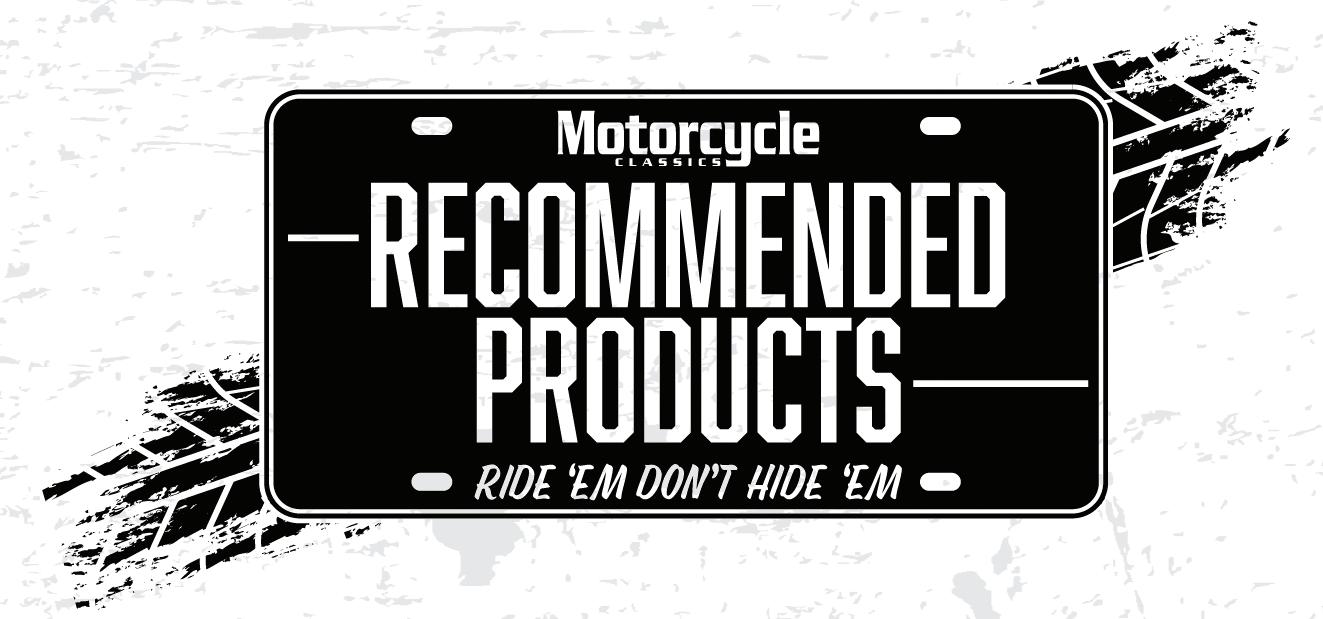
The 19th edition of the Comprehensive Vintage Motorcycle Price Guide contains over 160,000 prices for over 105 different motorcycle marques in six different conditions. Through hundreds of hours of research and data entry, formed by the opinions and data gathered by more than 450 worldwide dealers, auctioneers, collectors, and experts in the vintage field, this is the most accurate price guide available. It also contains more data than any other, as all major marques (and many lesser-known marques) are included.
#11828 $20.95 Members: $18.86
BACKROADS OF ROUTE 66
ULTIMATE COLLECTOR MOTORCYCLES
ULTIMATE COLLECTOR MOTORCYCLES
This double-volume book highlights 100 of the most iconic and coveted motorcycles in history, from early pioneers to cutting-edge speed machines. With breathtaking imagery captured by top motorcycle photographers and expertly told stories behind each bike, including rare archival gems and interviews with industry experts, this XL-sized volume is sure to captivate enthusiasts. Many of the motorcycles featured have been sourced from private collections and motorcycle museums and have been ridden by legendary racers such as Mike Hailwood, Giacomo Agostini, and Kenny Roberts. Ultimate Collector Motorcycles is a musthave book that celebrates the highest levels of motorcycle design and engineering, making it an essential addition to any bike lover’s collection. #12064 $250.00 Members: $224.99
This double-volume book highlights 100 of the most iconic and coveted motorcycles in history, from early pioneers to cutting-edge speed machines. With breathtaking imagery captured by top motorcycle photographers and expertly told stories behind each bike, including rare archival gems and interviews with industry experts, this XL-sized volume is sure to captivate enthusiasts. Many of the motorcycles featured have been sourced from private collections and motorcycle museums and have been ridden by legendary racers such as Mike Hailwood, Giacomo Agostini, and Kenny Roberts. Ultimate Collector Motorcycles is a musthave book that celebrates the highest levels of motorcycle design and engineering, making it an essential addition to any bike lover’s collection. #12064 $250.00 Members: $224.99

This wonderfully illustrated, up-to-date guide to the natural, cultural, and historical gems hidden just off the legendary Route 66 outlines 30 trips for curious travelers. In this completely revised and updated version of The Backroads of Route 66, author and Route 66 expert Jim Hinckley is your guide from the lowlands of the American Plains to the high plateaus of New Mexico and Arizona, from the Great Lakes to the mighty Pacific Ocean, and through major metropolises and remote country towns.

#11787 $34.99 Members: $31.49
AJS AND MATCHLESS: POST-WAR SINGLES AND TWINS

Illustrated with over 200 photographs of AJS and Matchless bikes, this book looks at the history and development of the single and twincylinder ranges, racing bikes, technical details of all major models, and owning and riding AJS and Matchless bikes today.
#10836 $44.95 Members: $40.95
BMW MOTORCYCLES: 100 YEARS
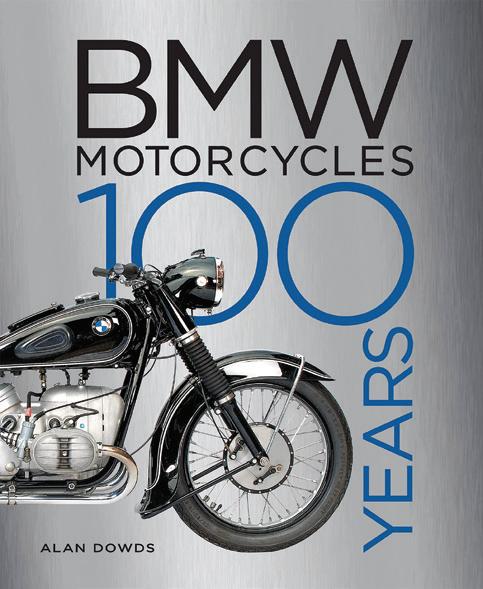
BMW Motorcycles: 100 Years celebrates the legendary machines built by Germany’s leading motorcycle manufacturer. From the first R32 that launched BMW’s motorcycle dynasty to the latest S1000RR superbike and R18 mega-cruiser, BMW Motorcycles captures a century of motorcycling excellence in a combination of historic and contemporary photos sourced from BMW’s archive. The stories behind all the classic and modern BMWs are here, captured in one beautiful book that is sure to be enjoyed by any BMW fan.
#11798 $60.00 Members: $52.99




THE HARLEY-DAVIDSON MOTOR CO. ARCHIVE COLLECTION
THE HARLEY-DAVIDSON MOTOR CO. ARCHIVE COLLECTION
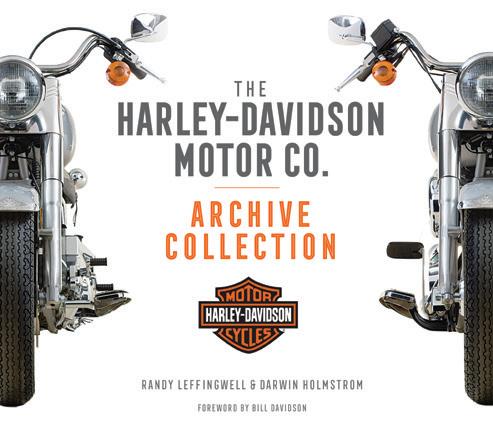
The Harley-Davidson Motor Co. Archive Collection, showcases more than 100 years of bikes that helped shape motorcycle history, bringing the history of Harley-Davidson to gleaming life page after page of motorcycles beyond compare. Created in cooperation with the official Harley-Davidson Museum in Milwaukee, detailed photographs and histories of more than 200 motorcycles from Harley’s collection, from serial number one built in 1903 to pre-World War II racers to the latest Street Glide, the book captures the excitement of the bestknown motorcycles in the world.
The Harley-Davidson Motor Co. Archive Collection, showcases more than 100 years of bik shape motorcycle history, bringing the history of Harley-Davidson to gleaming life page after page of motorcycles beyond compare. Created in cooperation with the official Harley-Davidson Museum in Milwaukee, detailed photographs and histories of more than 200 motorcycles fr Harley’s collection, from ser 1903 to pre-World War II racers to the latest Street Glide, the book captures the excit known motorcycles in the world.
#10927 $40.00 Members: $36.00
#10927 $40.00 Members: $36.00
TRIUMPH TRIDENT: THE BEST PRODUCTION RACER EVER
TRIUMPH TRIDENT: THEBEST PRODUCTION RACER EVER
In this thoroughly researched and comprehensive book, Roy Maddo takes the reader through the full range of Triumph models the BSA Rocket 3, the Mer the A75 Hurricane, as well as the technical changes that took place and the range of specials and oneoffs. The book also includes a buy guide with owners’ feedback and modifications as well as details of owners’ clubs and events.
In this thoroughly researched and comprehensive book, Roy Maddox takes the reader through the full range of Triumph models, including the BSA Rocket 3, the Meridien and the A75 Hurricane, as well as the technical changes that took place and the range of specials and oneoffs. The book also includes a buyer’s guide with owners’ feedback and modifications as well as details of owners’ clubs and events.

#10910 $24.95 Members: $22.95
#10910 $24.95 M

















76 MOTORCYCLE CLASSICS September/October 2023
SOUL RIDER


This is the story of a woman who went on an incredible journey.





Carolyn Fox was a single mother and lawyer haunted by grief and secrets and facing her fiftieth birthday. So, she decided to change her life by facing her fears: she bought a Harley, packed it with a sleeping bag and tent, and set out to ride through all fifty states alone! Soul Rider is her gripping travel/journey memoir where she takes you along on her 14,000-mile adventure.
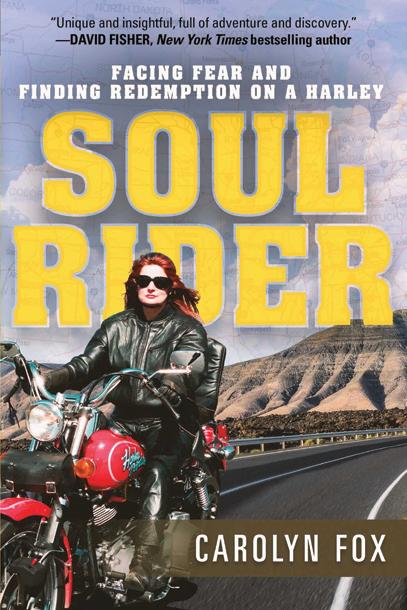
#12047 $16.99 Members: $14.99

A-Z OF ITALIAN MOTORCYCLE MANUFACTURERS



A-Z of Italian Motorcycle Manufacturers is the leading directory of Italian motorcycles available today. In addition to covering the most famous Italian factories, this is the definitive guide to the marques that have often been forgotten. Some might be familiar classics remembered for their racing pedigree, while others will be introduced for the first time. Topics include the history of the once great factories; marques that build motorcycles exclusively for racing; details of the top motorcycles each manufacturer built, and each marques’ greatest achievement.

#10838 $54.95 Members: $48.95
HOW TO RESTORE NORTON COMMANDO










This How to Restore Norton Commando manual is aimed at owners and enthusiasts of the legendary Norton Commando, and covers all areas of restoration from the sourcing of the bike, to its completion as a fully restored machine. Starting with advice on the different models, spares availability, and where best to source a bike to restore, this book then covers the complete dismantling and restoration of the bike. Plus, the text is illustrated with hundreds of clear color photos.
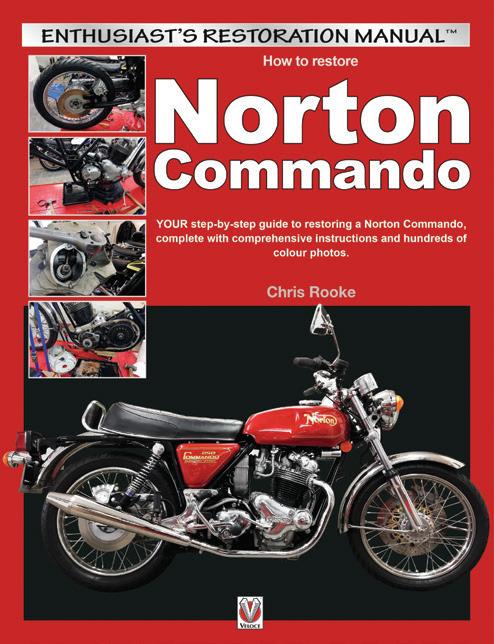
#10286 $50.00 Members: $45.00
DUCATI: A PHOTOGRAPHIC TRIBUTE, VOLUME 2

Phil Aynsley has been a fan of Ducati since he bought his first motorbike, a 250 Desmo, in 1972. Aynsley’s love for Ducati’s is matched only by his passion for photography. “Ever since buying my first in 1972 I’ve been taking photos of them. How could you not?” After 30 years he hasn’t tired of his beloved Ducati’s and is revered by the motorcycle industry as one of the best photographers in the business. Ducati lovers will relish Volume 2 with its expanded section on Road and Race bikes and a raft of new photos not previously released. It’s a must-have for any Ducatisti!
#11380 $55.00 Members: $44.99

HOW TO RESTORE CLASSIC OFF-ROAD MOTORCYCLES
TRIUMPH BONNEVILLE & TR6 MOTORCYCLE RESTORATION GUIDE 1956-1983

Triumph’s Bonneville and its single-carbed sibling, the TR6, are two of the most revered models in all of motorcycling. Distinguished by their handsome lines and pace-setting performance, the Bonneville and Tiger ruled the streets and race tracks from their introduction in the late 1950s through Triumph’s golden age in the 1960s. Devotion to the marque remained strong even as the sun slowly set on the company’s fortunes in the late 1970s and early 1980s. The original Triumph’s demise in 1983 simply served to cement the legendary status of its long-lived top guns, the Bonneville and TR6.
#11102 $29.95 Members: $26.95
This book gives enthusiasts of classic off-road competition motorcycles a step-by-step guide to a full restoration. Covering dismantling the motorcycle and its components, restoring and sourcing parts, paint spraying, decals and polishing. With chapters covering engine, frame, forks, fuel, exhaust, seat, brakes and tires, you’ll see how to take a bike from scratch to a full rebuild; then on to safe set-up and general maintenance. Includes chapters focusing specifically on pre-65 and twin shock models.
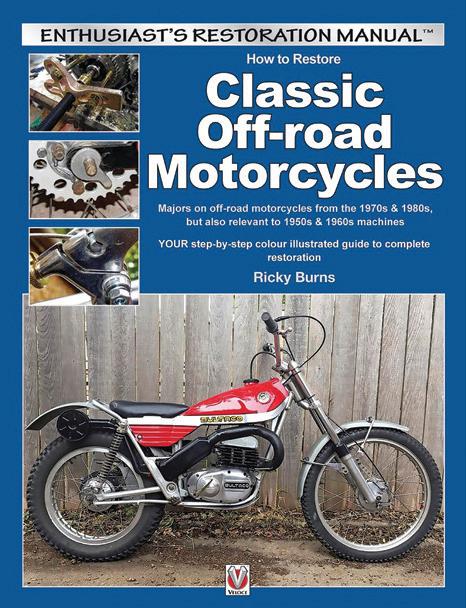
#10932 $60.00 Members: $54.00

HOW TO REBUILD AND RESTORE CLASSIC JAPANESE MOTORCYCLES

Whether you want to restore a classic Japanese motorcycle or create a modified, custom build, you need the right information to perform the necessary mechanical and cosmetic tasks required to get the bike back on the road. How to Rebuild and Restore Classic Japanese Motorcycles is your thorough, hands-on manual, covering all the mechanical subsystems that make up a motorcycle. From finding a bike to planning your project to dealing with each mechanical system, this book includes everything you need to know to get your classic back on the road.
#10936 $39.99 Members: $35.99





To order, call toll-free 800-880-7567 (outside the United States and for customer service, call 785-274-4360) or go to Store.MotorcycleClassics.com • Mention promo code: MMCPANZD • Sale ends: 10/23/23
THE KAWASAKI Z1 STORY

In never before published interviews, Dave Sheehan relates the story behind the Z1’s development; the secret US testing program in which a team including Imola-race winner Paul Smart rode pre-production bikes disguised as Hondas coast-to-coast across America. Sheehan also examines the myth, truth, and legend surrounding the Z1’s first race win and covers the full story of the epic, record-breaking three days at Florida’s legendary Daytona Speedway.
#12039 $25.00 Members: $22.99
REBUILDING THE BRAND: HOW HARLEYDAVIDSON BECAME KING OF THE ROAD
Rebuilding the Brand: How Harley-Davidson

Became King of the Road is the story of how a core group led a team to rebuild the Harley-Davidson image. Told through the perspective of Clyde Fessler, this book provides dynamic branding information couched in an entertaining story. Fessler describes the methods used to create the iconic image Harley-Davidson enjoys today, and explores the topics of brand experience, personality, extension, association, consistency, and welfare.

#12046 $14.95 Members: $12.95
KAWASAKI W, H & Z



Kawasaki W, H & Z is the story of the air-cooled “big” Kawasaki bikes in definitive detail, researched and written in Japan with the full cooperation of the factory. This series of models put the Kawasaki company on the map during the 1960s and 1970s, helping it survive a difficult era that saw hundreds of Japanese motorcycle makers reduced to just four. Successful immediately, these models defended Kawasaki’s honor on the track as well as in the showroom, handing the company numerous world championship victories.
#9594 $50.00 Members: $41.99

MOTOCROSS: THE GOLDEN ERA

Motocross: The Golden Era is a heartfelt tribute to a magical time. It’s a look back at a moment in history between 1970 and 1986 when motocross came of age. Old four-strokes were suddenly overshadowed by a new breed of specialized two-strokes that would change the sport forever. The sport suddenly exploded in America, and a massive new market was born. It was also a time of experimentation, with radical new ideas being tried daily.
#11892 $199.99 Members: $149.99






CLASSIC MOTORCYCLES: THE ART OF SPEED
CLASSIC MOTORCYCLES:THE ART OF SPEED

Written by noted motorcycle author Patrick Hahn, Classic Motorcycles presents the history of motorcycling as told through the most significant, iconic, classic motorcycles of all time, with both period photography and modern portrait photography. You’ll drool over the 1933 Matchless Silver Hawk, and you’ll want to tear out the page displaying the 1956 Triumph Thunderbird and frame it. Prepare to be in awe of the undeniable classic motorcycles in this collection.
Written by noted motorcycle author Patrick Hahn, Classic Motorcycles presents the history of motorcycling as told through the most significant, iconic, classic motorcycles of all time, with both period photography and modern portrait photography. You’ll drool over the 1933 Matchless Silver Hawk, and you’ll want to tear out the page displaying the 1956 Triumph Thunderbird and frame it. Prepare to be in awe of the undeniable classic motorcycles in this collection.
#8185 $60.00 Members: $49.99
#8185 $60.00 Members: $49.99


NORTON COMMANDO BIBLE: ALL MODELS 1968 TO 1978

Featuring great color photos, including original advertising material, and comprehensive appendices of facts, figures, contacts, technical specifications, engine/frame numbers, and road test performance figures, this is the definitive Norton Commando book. Also included is the turbulent story of the company that built it and expert advice on owning and maintaining your own classic.
#11802 $50.00 Members: $42.50
HOW TO TROUBLESHOOT, REPAIR AND MODIFY MOTORCYCLE ELECTRICAL SYSTEMS
HOW TO TROUBLESHOOT,REPAIR AND MODIFY MOTORCYCLE ELECTRICAL SYSTEMS


Motorcycle expert Tracy Martin provides crystal-clear, fully illustrated, step-by-step instructions for every electrical repair imaginable on a bike: from the nuts-and-bolts basics to fuel-injection systems, onboard computers, repair and installation of factory and aftermarket accessories, and everything else in between.
Motorcycle expert Tracy Martin provides crystal-clear, fully illustrat step-by-step instructions for every electrical repair imaginable on a bike: from the nuts-and-bolts basics to fuel-injection systems, onboard computers, repair and installation of factory and aftermarket accessories, and everything else in between.
#7707 $39.99 Members: $33.99
#7707 $39.99 Members: $33.99















78 MOTORCYCLE CLASSICS September/October 2023
HONDA 70 ENTHUSIAST’S GUIDE
This book covers the third-best-selling Honda in American Honda history, the long-running Mini Trail CT-70, along with the CL, SL, and XL 72-cc motorcycles manufactured from 1969 to 1994. Beginning with a brief introduction of the models that led to the first CL-70, then jumping into a thorough analysis of the many models and iterations that Honda offered through the years, this is the perfect book for any Honda enthusiast.
#8777 $32.95 Members: $25.99

MCQUEEN’S MACHINES: THE CARS AND BIKES OF A HOLLYWOOD ICON
McQueen’s Machines gives readers a close-up look at the cars and motorcycles Steve McQueen drove in movies, those he owned, and others he raced. With a foreword by his son, Chad McQueen, and a wealth of details about the star’s racing career, stunt work, and car and motorcycle collecting, McQueen’s Machines draws a fascinating picture of one outsized man’s driving passion. Revised and updated from its original hardcover edition.

#11837 $27.99 Members: $23.99






ELSPETH BEARD: LONE RIDER
Lone Rider details the story of Elspeth Beard, who in 1982, at the age of 23, left her family and friends in London and set off on a 35,000-mile solo adventure around the world on her 1974 BMW R60/6. With some savings from her pub job, a tent, a few clothes, and some tools, all packed on the bike, she was determined to prove herself and to get over a recent heartbreak. Told with honesty and wit, this is the extraordinary and moving story of a unique and life-changing adventure.

#9115 $19.95 Members: $16.95
MOTORCYCLE CLASSICS
STREET BIKES OF THE ‘70S
Many great and classic motorcycles were designed and built in the ’70s, and Motorcycle Classics has put together another 96-page special edition featuring articles that explore the decade and what it brought to the motorcycle world. The Honda CB550K, Ducati 750 Sport, Yamaha RD400, and many others are all covered in this glossy-page, full-color guide.

#9840 $6.99 Members: $5.99



THE ESSENTIAL GUIDE TO MOTORCYCLE MAINTENANCE

HOW TO RESTORE











HONDA CX500 & CX650
You don’t need expert knowledge or a fully fitted workshop for a restoration project with How to Restore Honda CX500 & CX650. Packed with photographs and detailed instructions, this book is your perfect guide from start to finish.
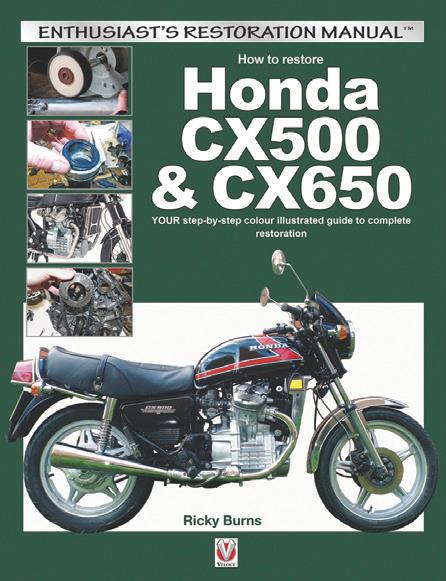
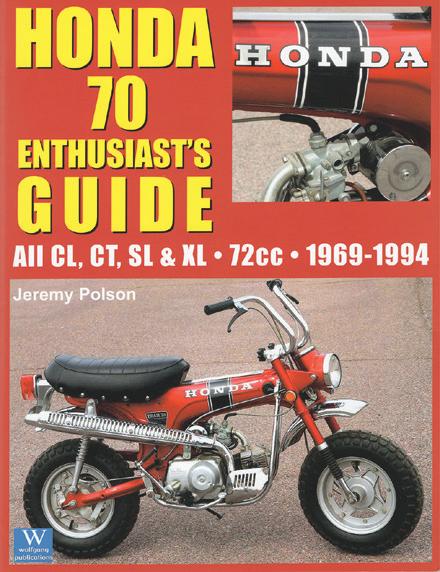
#7759 $59.95 Members: $54.95
HOW TO SET UP YOUR MOTORCYCLE WORKSHOP, 3RD EDITION
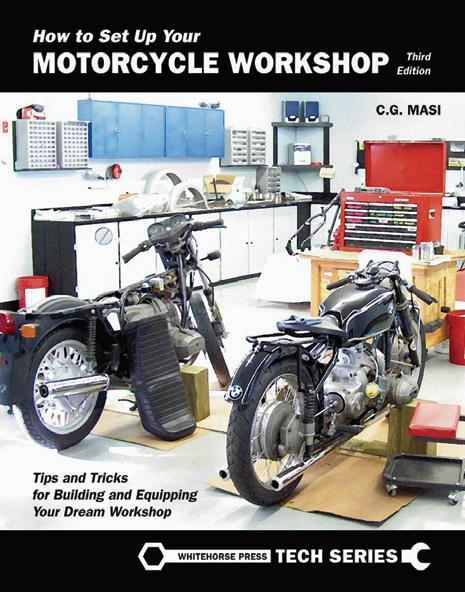
From a corner of the garage set up for routine maintenance to a dream shop housing classic machines, this book helps motorcyclists make the most of their available space. Packed with practical advice, author C.G. Masi walks you through designing, building, and equipping the workshop you need, whether you plan to restore, repair, and maintain your own bikes or hope to open a small commercial facility.
#9985 $27.99 Members: $23.99


Popular motorcycle journalist and author Mark Zimmerman brings a comfortable, conversational tone to his easy-to-understand explanations of how motorcycles work, how to maintain them, and how to fix them when they don’t. This practical tutorial covers all brands and styles of bikes making it a perfect companion to the owner’s service manual. With over 500 color photographs and a thorough index, this user-friendly book is right for all levels of motorcycle owners.
#10937 $38.99 Members: $34.99
THE VINCENT IN THE BARN
The Vincent in the Barn shares 40 tales of motorcycle hunting dreams come true. From Ducatis in basements to Vincents abandoned in sheds, Harleys in barns to Brit bikes moldering behind urban garages, these are the stories that fuel every motorcyclist’s fantasies. The only difference? They’re true.

#11838 $24.99 Members: $21.99
To order, call toll-free 800-880-7567 (outside the United States and for customer service, call 785-274-4360) or go to Store.MotorcycleClassics.com • Mention promo code: MMCPANZD • Sale ends: 10/23/23
www.MotorcycleClassics.com 79
PARTING SHOTS
San Jose — THE Mile
From 1946 through 1953 a single race, the Springfield Mile, decided who would be crowned the AMA’s seasonal champion. Winning Springfield also determined who wore the coveted Number One plate the following year.
Then, in 1954, the AMA changed the National Championship format into a season-long series of pointspaying races. Competition took place on dirt tracks including Shorttrack, Half-Mile and Mile ovals, plus TT (dirt steeple chase) and Road Races on pavement. Each event paid points toward the seasonal championship.
The first series champion was Joe Leonard who topped the field with seven race wins (of 18 events) for 1954. Ironically, the Springfield Mile was among his wins.
Regardless of who won what and where, the racing remained as exciting as before, but it was the Mile races in particular that offered the most thrills and chills, and for good reason. Mile racetracks’ two long straightaways, connected at both ends by seemingly endless sweeping lefthand turns, translated to close racing, a reality that remains to this day.
Among the Mile races that enthusiasts favored most was the San Jose Mile, run at the Santa Clara Fairgrounds in San Jose, California, from 1957 through 1993 (some years the Mile was joined by a companion points-paying race at one of the fairground’s two smaller tracks, the Half-Mile and Shorttrack ovals).
The San Jose Mile was known for its freight train formations created by racers drafting one another to gain better track position.
But it was the San Jose Mile that truly captured enthusiasts’ hearts. In his 1975 race report for Cycle magazine, technical editor Jess Thomas referred to this stop on the AMA’s championship circuit as “The Mile.” For good reason, too. In terms of close racing, the San Jose Mile offered excitement that was unmatched, even at other Mile venues.
How The was the San Jose Mile? Here’s what 1970 AMA Grand National Champion, the late, great Gene Romero, once said: “If you haven’t seen a San Jose Mile, you haven’t seen a motorcycle race.” And Romero was a San Jose expert — in 1973 he won perhaps the closest race on the fabled track, beating future AMA Grand National Champion Gary Scott by “an eyelash,” as one source put it. Addendum to that piece of history, the two previous years Romero had won on the fairground’s Half-Mile oval, while Scott scored his deserved San Jose Mile win in 1977.
Clearly, though, San Jose’s biggest draw was the racing itself. Long hard-packed straights allowed for easy drafting, resulting in close racing that often developed into a freight train of thundering Harleys, Triumphs, Yamahas, Hondas and Nortons battling for 25 vicious laps. The tight racing always captured everybody’s attention, even that of seasoned tuners such as Ron Wood whose Nortons were among the fastest on the track. Once, while viewing from his infield perch, the renowned bike builder uttered, to no one in particular, “I love this kind of racing.” ‘Nuff said. — Dain Gingerelli
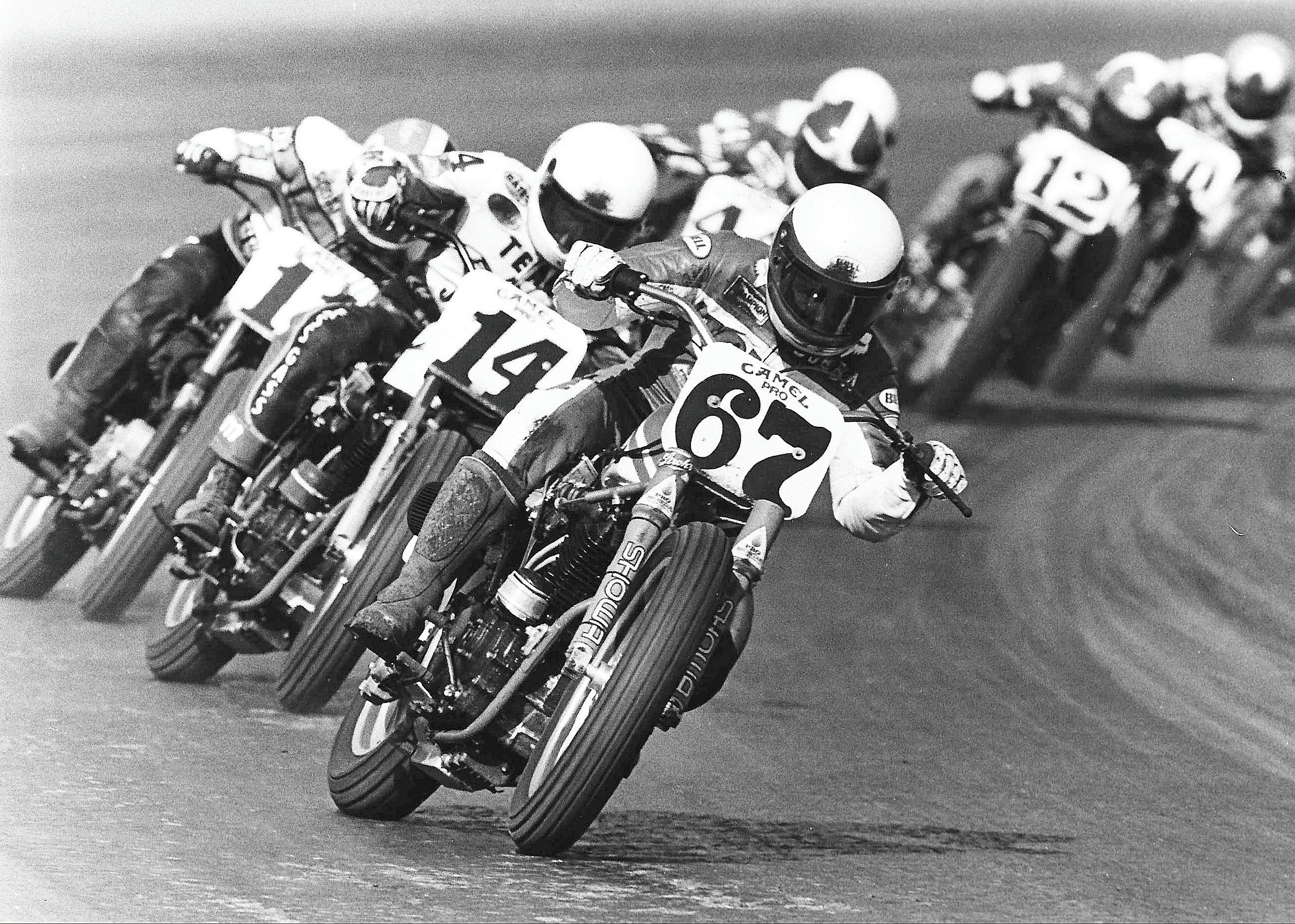
80 MOTORCYCLE CLASSICS September/October 2023 DAIN GINGERELLI COLLECTION
ENDLESS EVOLUTION C5
Discover more • COMFORTABLE: Seamless and customizable linings. OEKO-TEX 100 certified.
• SMART: Pre-wired for plug-and-play comm system featuring MESH 2.0
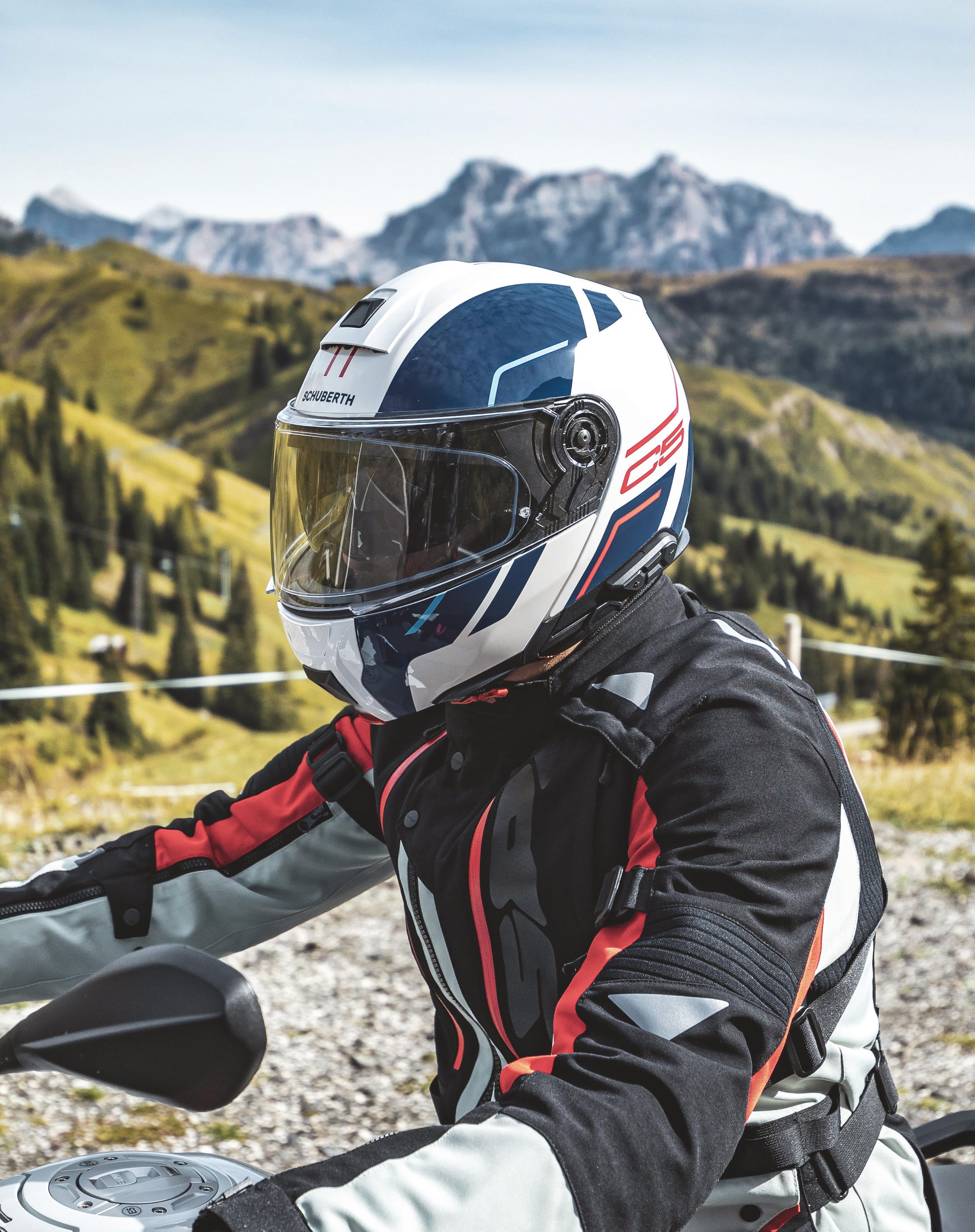



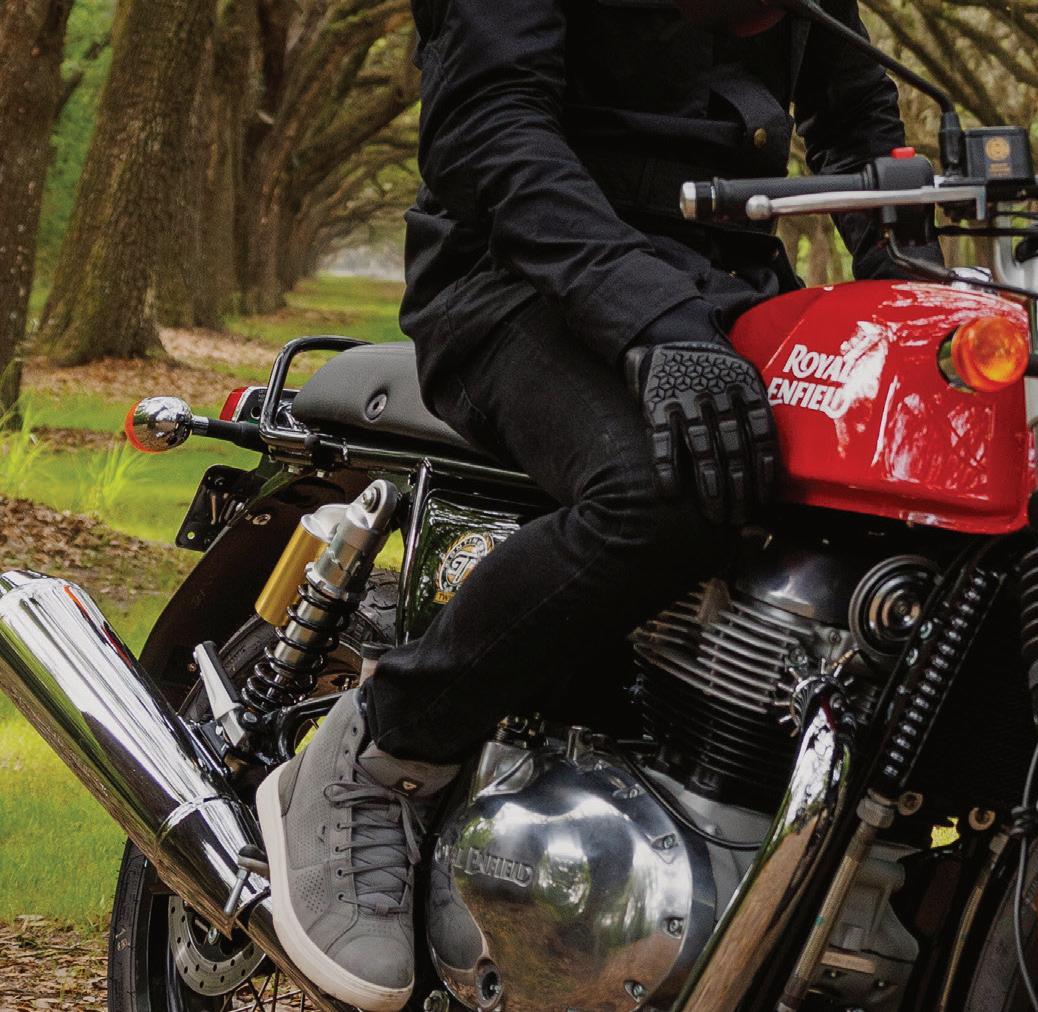
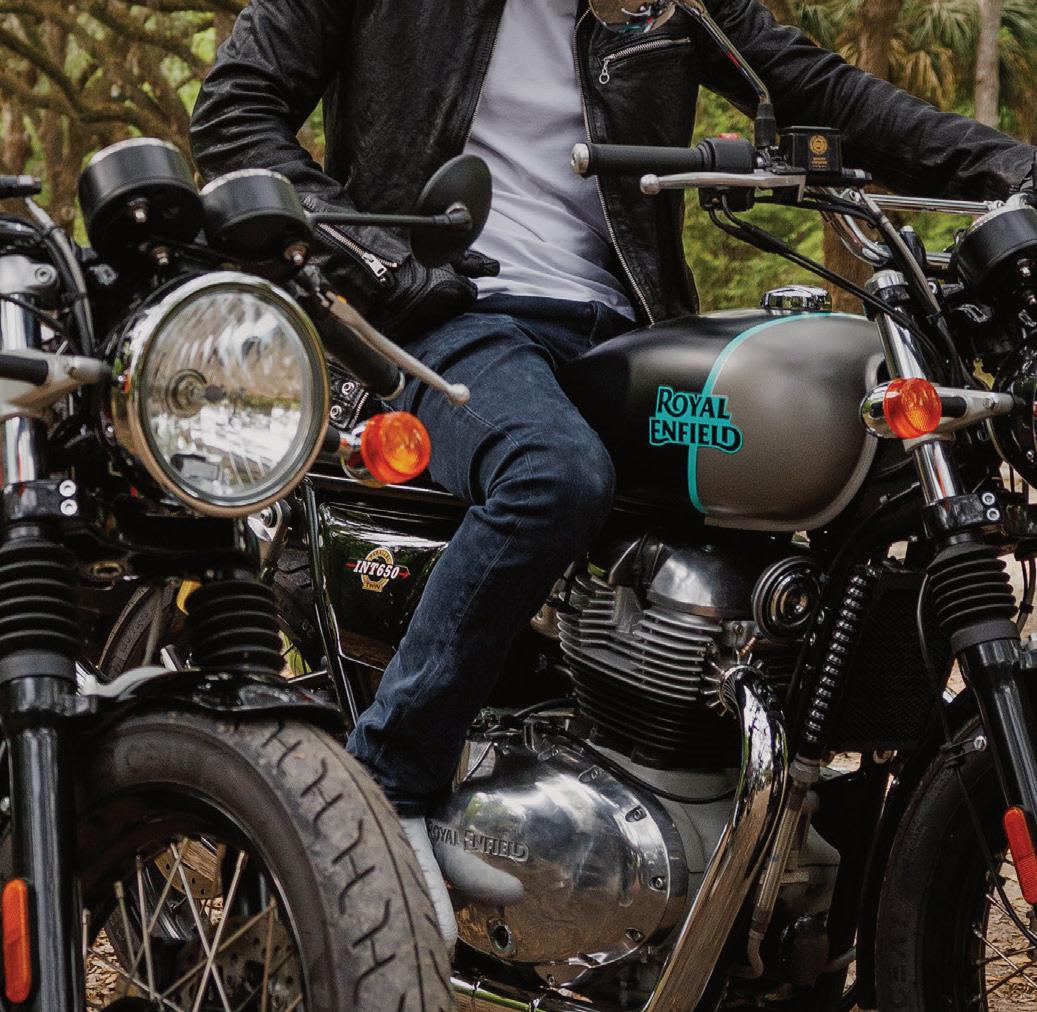





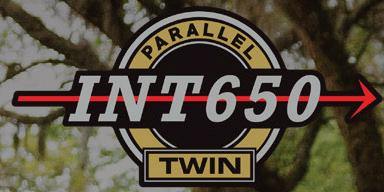
LEARN MORE ABOUT THE ICONIC, CONTINENTAL GT & INT650 TWINS AT ROYALENFIELD.COM





































































































































































































































































































































































































































































































































 Story
Story





 Cool kids removed the 2-into-1 muffler and added Snuff-R-Nots. Trooper Dowgin’s original leather motorcycle helmet.
Cool kids removed the 2-into-1 muffler and added Snuff-R-Nots. Trooper Dowgin’s original leather motorcycle helmet.













 Alan Cathcart
Alan Cathcart




















































































 THE NEW JERSEY PINE BARRENS
THE NEW JERSEY PINE BARRENS














































































































































































































